Exalt Wireless 105P25T Radio Module 5GHz User Manual
Exalt Communications Inc. Radio Module 5GHz
Contents
- 1. user manual
- 2. revised manual
- 3. User manual
- 4. User Manual
User manual
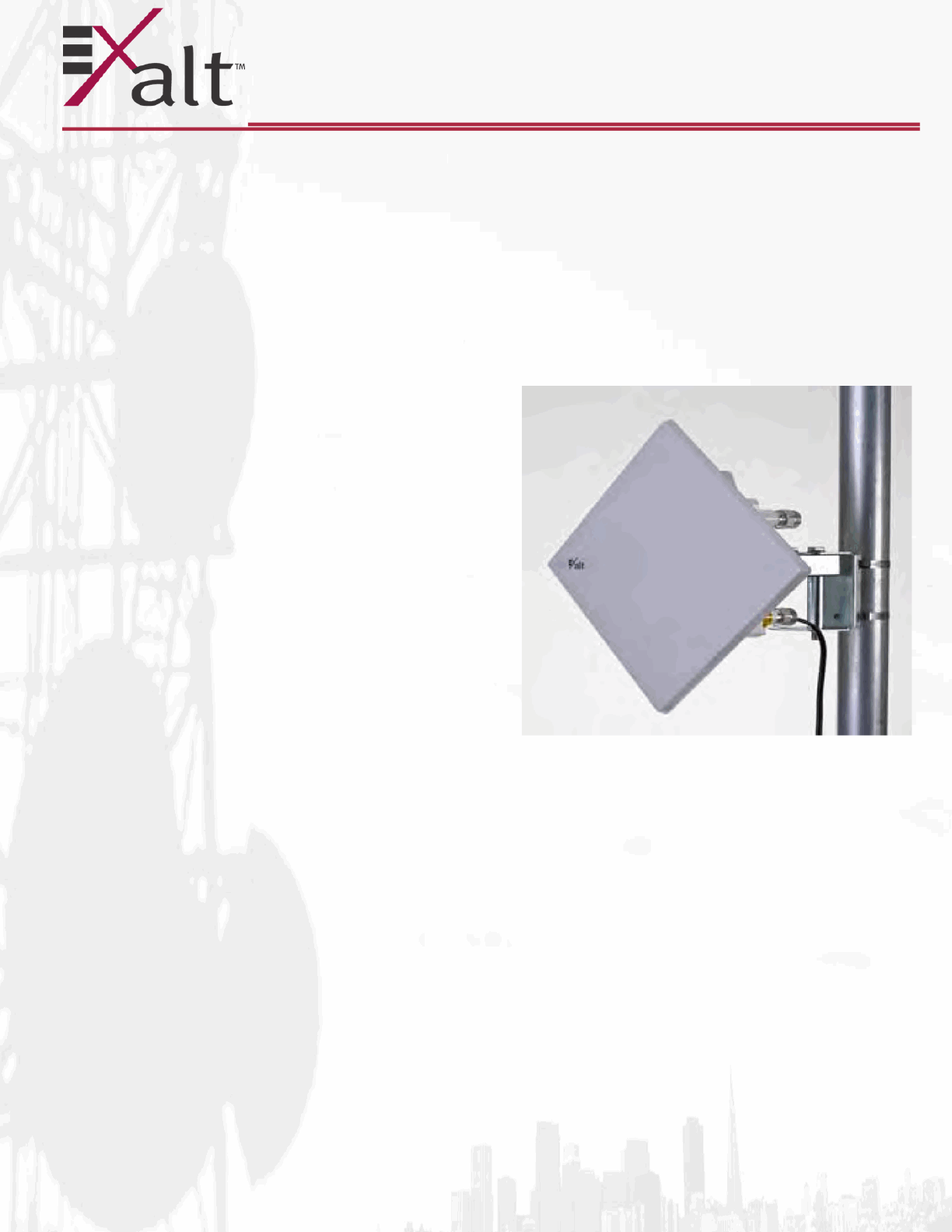
203591-011
2013-02-22
ExtendAir® (TDD) Series
Digital Microwave Radios
Installation and Management Guide
Models:
r40xx & rc40xx Series
r49xx & rc49xx Series
r50xx & rc50xx Series

Exalt Installation and Management Guide
ExtendAir (TDD) Series Digital Microwave Radios
ii 203591-011
2013-02-22
Legal Notice
The information contained herein is the property of Exalt Communications, Inc. (“Exalt”) and is
supplied without liability for errors or omissions. No part of this document may be reproduced, in any
form, except as authorized by contract or other written permission from the owner.
Any brand names and product names included in this manual are trademarks, registered trademarks, or
trade names of their respective holders.
The contents of this document are current as of the date of publication. Exalt reserves the right to
change the contents without prior notice.
The publication of information in this document does not imply freedom from patent or other rights of
Exalt or others.
© 2013 Exalt Communications Inc. All rights reserved. The Exalt logo is a trademark of Exalt
Communications, Inc. ExtendAir is a registered trademark of Exalt Communications Inc.
Open-Source License Information
Per the terms of your Exalt Limited Hardware Warranty, Software License, and RMA Procedures
Agreement with Exalt Communications, Inc. and/or its subsidiaries, certain Third Party Software may
be provided with and as part of the Exalt products provided to you, and any such Third Party Software
files provided are governed by the terms of their separate Third Party Licenses, which licenses give
you at least the license rights licensed to you in the Exalt End User Agreement and may give you
additional license rights as to the Third Party Software, but only with respect to the particular Third
Party Software to which the Third Party License applies.
The Exalt Products may include or be bundled with some or all of the following third party software.
Copies of the copyright notices and license agreements for any or all of these may be requested by
contacting Exalt support at email: support@exaltcom.com.
Open Source Code License Agreement Website
Embedded Linux - OS
U-Boot Boot Code. Both licensed under GPL Version 3 www.gnu.org
www.sourceforge.net
Busy Box Linux Commands. Licensed under GPL Version 2 www.gnu.org and
www.busybox.net
Scew Expat Wrapper. Licensed under LGPL Version 3 www.gnu.org
OpenSSL SSL Web Access. Licensed under dual license www.openssl.org
Net-SNMP SNMP Agent. Licensed under NetSNMP (see
Copyright Notices)
Dropbear SSH 2 Server; Expat - XML Parser; BarelyFitz –
Java Script Tabifier; jQuery; and Flotr – Java Script
Plotting Library. All of which are licensed under
MIT License
www.opensource.org/
licenses/mit-license.php
GoAhead Webserver Licensed under GoAhead License Agreement www.goahead.com

Exalt Installation and Management Guide
ExtendAir (TDD) Series Digital Microwave Radios
203591-011 iii
2013-02-22
Table of Contents
Legal Notice . . . . . . . . . . . . . . . . . . . . . . . . . . . . . . . . . . . . . . . . . . . . . . . . . . . . . . . . . . . . . . . ii
Open-Source License Information . . . . . . . . . . . . . . . . . . . . . . . . . . . . . . . . . . . . . . . . . . . . . . ii
List of Figures . . . . . . . . . . . . . . . . . . . . . . . . . . . . . . . . . . . . . . . . . . . . . . . . . . . . . . . . . . . . vi
List of Tables . . . . . . . . . . . . . . . . . . . . . . . . . . . . . . . . . . . . . . . . . . . . . . . . . . . . . . . . . . . . viii
Notes for Customers of the Cisco Configuration ExtendAir r5005 . . . . . . . . . . . . . . . . . . . . ix
About this Document . . . . . . . . . . . . . . . . . . . . . . . . . . . . . . . . . . . . . . . . . . . . . . . . . . . . . . . . x
Revision History . . . . . . . . . . . . . . . . . . . . . . . . . . . . . . . . . . . . . . . . . . . . . . . . . . . . . . . . x
Icons . . . . . . . . . . . . . . . . . . . . . . . . . . . . . . . . . . . . . . . . . . . . . . . . . . . . . . . . . . . . . . . . . . x
Introduction . . . . . . . . . . . . . . . . . . . . . . . . . . . . . . . . . . . . . . . . . . . . . . . . . . . . . . . . . . . . . . . 1
Related Documentation and Software . . . . . . . . . . . . . . . . . . . . . . . . . . . . . . . . . . . . . . . 1
The ExtendAir (TDD) Series Digital Microwave Radios . . . . . . . . . . . . . . . . . . . . . . . . 1
Basic Features . . . . . . . . . . . . . . . . . . . . . . . . . . . . . . . . . . . . . . . . . . . . . . . . . . . . . . . . . . 4
Pre-installation Tasks . . . . . . . . . . . . . . . . . . . . . . . . . . . . . . . . . . . . . . . . . . . . . . . . . . . . . . . . 6
Link Engineering and Site Planning . . . . . . . . . . . . . . . . . . . . . . . . . . . . . . . . . . . . . . . . . 6
Familiarization with the ExtendAir (TDD) Series Radios . . . . . . . . . . . . . . . . . . . . . . . . . 6
Initial Configuration and Back-to-Back Bench Test . . . . . . . . . . . . . . . . . . . . . . . . . . . . . 8
Time Division Duplex (TDD) Factors . . . . . . . . . . . . . . . . . . . . . . . . . . . . . . . . . . . . . . . . 9
Link Orientation and Synchronization . . . . . . . . . . . . . . . . . . . . . . . . . . . . . . . . . . . . . . . 10
Radio Synchronization . . . . . . . . . . . . . . . . . . . . . . . . . . . . . . . . . . . . . . . . . . . . . . . . . . . 12
Offset Timing . . . . . . . . . . . . . . . . . . . . . . . . . . . . . . . . . . . . . . . . . . . . . . . . . . . . . . . . . . 15
Virtual Local Area Network (VLAN) . . . . . . . . . . . . . . . . . . . . . . . . . . . . . . . . . . . . . . . 16
Simple Network Management Protocol (SNMP) . . . . . . . . . . . . . . . . . . . . . . . . . . . . . . 17
System Installation and Initiation Process . . . . . . . . . . . . . . . . . . . . . . . . . . . . . . . . . . . . . . . 19
Record Keeping . . . . . . . . . . . . . . . . . . . . . . . . . . . . . . . . . . . . . . . . . . . . . . . . . . . . . . . . 20
Installation . . . . . . . . . . . . . . . . . . . . . . . . . . . . . . . . . . . . . . . . . . . . . . . . . . . . . . . . . . . . . . . 21
Mechanical Configuration and Mounting . . . . . . . . . . . . . . . . . . . . . . . . . . . . . . . . . . . . 21
Radio Ports and Indicators . . . . . . . . . . . . . . . . . . . . . . . . . . . . . . . . . . . . . . . . . . . . . . . . 22
Power . . . . . . . . . . . . . . . . . . . . . . . . . . . . . . . . . . . . . . . . . . . . . . . . . . . . . . . . . . . . . . . . 24
CAT5e Lightning/Surge Protection . . . . . . . . . . . . . . . . . . . . . . . . . . . . . . . . . . . . . . . . . 26
Reset to Critical Factory Settings . . . . . . . . . . . . . . . . . . . . . . . . . . . . . . . . . . . . . . . . . . 27
Antenna/Transmission System . . . . . . . . . . . . . . . . . . . . . . . . . . . . . . . . . . . . . . . . . . . . 27
Transmission Line from Antenna to Radio (rc models) . . . . . . . . . . . . . . . . . . . . . . . . . 28
Antenna Alignment . . . . . . . . . . . . . . . . . . . . . . . . . . . . . . . . . . . . . . . . . . . . . . . . . . . . . 30
Configuration and Management . . . . . . . . . . . . . . . . . . . . . . . . . . . . . . . . . . . . . . . . . . . . . . 32
Telnet into the Command Line Interface (CLI) . . . . . . . . . . . . . . . . . . . . . . . . . . . . . . . . 32
Telnet . . . . . . . . . . . . . . . . . . . . . . . . . . . . . . . . . . . . . . . . . . . . . . . . . . . . . . . . . . . . . . . . 32
Exalt Graphical User Interface (GUI) . . . . . . . . . . . . . . . . . . . . . . . . . . . . . . . . . . . . . . . 33
Quick Start . . . . . . . . . . . . . . . . . . . . . . . . . . . . . . . . . . . . . . . . . . . . . . . . . . . . . . . . . . . . 35
Navigating the GUI . . . . . . . . . . . . . . . . . . . . . . . . . . . . . . . . . . . . . . . . . . . . . . . . . . . . . 36
Radio Information Page . . . . . . . . . . . . . . . . . . . . . . . . . . . . . . . . . . . . . . . . . . . . . . . . . . 39
Administration Settings Page . . . . . . . . . . . . . . . . . . . . . . . . . . . . . . . . . . . . . . . . . . . . . . 40
NTP and Time Zones Configurations Page . . . . . . . . . . . . . . . . . . . . . . . . . . . . . . . . . . . 42
Simple Network Management Protocol (SNMP) Configuration . . . . . . . . . . . . . . . . . . . 43
File Management Pages . . . . . . . . . . . . . . . . . . . . . . . . . . . . . . . . . . . . . . . . . . . . . . . . . . 46
File Transfer Page . . . . . . . . . . . . . . . . . . . . . . . . . . . . . . . . . . . . . . . . . . . . . . . . . . . . . . 46
File Activation Page . . . . . . . . . . . . . . . . . . . . . . . . . . . . . . . . . . . . . . . . . . . . . . . . . . . . . 49

Exalt Installation and Management Guide
ExtendAir (TDD) Series Digital Microwave Radios
iv 203591-011
2013-02-22
System Configuration Page . . . . . . . . . . . . . . . . . . . . . . . . . . . . . . . . . . . . . . . . . . . . . . . 50
Ethernet Interface Configuration Page . . . . . . . . . . . . . . . . . . . . . . . . . . . . . . . . . . . . . . 55
T1/E1 Configuration Pages . . . . . . . . . . . . . . . . . . . . . . . . . . . . . . . . . . . . . . . . . . . . . . . 57
VLAN Configuration Page . . . . . . . . . . . . . . . . . . . . . . . . . . . . . . . . . . . . . . . . . . . . . . . 60
Ethernet Rate Limiting . . . . . . . . . . . . . . . . . . . . . . . . . . . . . . . . . . . . . . . . . . . . . . . . . . . 62
QoS Configuration Page . . . . . . . . . . . . . . . . . . . . . . . . . . . . . . . . . . . . . . . . . . . . . . . . . 63
Automatic Channel Selection (ACS) Page . . . . . . . . . . . . . . . . . . . . . . . . . . . . . . . . . . . 68
Syslog Configuration Page . . . . . . . . . . . . . . . . . . . . . . . . . . . . . . . . . . . . . . . . . . . . . . . 70
GPS Information Page . . . . . . . . . . . . . . . . . . . . . . . . . . . . . . . . . . . . . . . . . . . . . . . . . . . 71
Alarms Page . . . . . . . . . . . . . . . . . . . . . . . . . . . . . . . . . . . . . . . . . . . . . . . . . . . . . . . . . . . 72
Performance Page . . . . . . . . . . . . . . . . . . . . . . . . . . . . . . . . . . . . . . . . . . . . . . . . . . . . . . 74
Event Log Page . . . . . . . . . . . . . . . . . . . . . . . . . . . . . . . . . . . . . . . . . . . . . . . . . . . . . . . . 76
User Throughput Page . . . . . . . . . . . . . . . . . . . . . . . . . . . . . . . . . . . . . . . . . . . . . . . . . . . 77
Diagnostic Charts Page . . . . . . . . . . . . . . . . . . . . . . . . . . . . . . . . . . . . . . . . . . . . . . . . . . 79
Spectrum Analyzer Page . . . . . . . . . . . . . . . . . . . . . . . . . . . . . . . . . . . . . . . . . . . . . . . . . 81
Ethernet Utilization Page . . . . . . . . . . . . . . . . . . . . . . . . . . . . . . . . . . . . . . . . . . . . . . . . . 83
Reboot Page . . . . . . . . . . . . . . . . . . . . . . . . . . . . . . . . . . . . . . . . . . . . . . . . . . . . . . . . . . . 85
Manual Page . . . . . . . . . . . . . . . . . . . . . . . . . . . . . . . . . . . . . . . . . . . . . . . . . . . . . . . . . . 86
Specifications . . . . . . . . . . . . . . . . . . . . . . . . . . . . . . . . . . . . . . . . . . . . . . . . . . . . . . . . . . . . . 87
Physical Specifications . . . . . . . . . . . . . . . . . . . . . . . . . . . . . . . . . . . . . . . . . . . . . . . . . . 87
System Specifications, 4.9GHz Band . . . . . . . . . . . . . . . . . . . . . . . . . . . . . . . . . . . . . . . 89
System Specifications, 4.9GHz Band . . . . . . . . . . . . . . . . . . . . . . . . . . . . . . . . . . . . . . . 90
System Specifications, 5.3GHz Band . . . . . . . . . . . . . . . . . . . . . . . . . . . . . . . . . . . . . . . 91
System Specifications, 5.4GHz Band . . . . . . . . . . . . . . . . . . . . . . . . . . . . . . . . . . . . . . . 92
System Specifications, 5.8GHz Band . . . . . . . . . . . . . . . . . . . . . . . . . . . . . . . . . . . . . . . 93
Interfaces . . . . . . . . . . . . . . . . . . . . . . . . . . . . . . . . . . . . . . . . . . . . . . . . . . . . . . . . . . . . . 94
Interface Connections . . . . . . . . . . . . . . . . . . . . . . . . . . . . . . . . . . . . . . . . . . . . . . . . . . . . . . 95
TDM Connections . . . . . . . . . . . . . . . . . . . . . . . . . . . . . . . . . . . . . . . . . . . . . . . . . . . . . . 95
RSL/Sync Connector . . . . . . . . . . . . . . . . . . . . . . . . . . . . . . . . . . . . . . . . . . . . . . . . . . . . 95
Power/Ethernet Connector . . . . . . . . . . . . . . . . . . . . . . . . . . . . . . . . . . . . . . . . . . . . . . . . 96
Antennas . . . . . . . . . . . . . . . . . . . . . . . . . . . . . . . . . . . . . . . . . . . . . . . . . . . . . . . . . . . . . . . . 98
Troubleshooting . . . . . . . . . . . . . . . . . . . . . . . . . . . . . . . . . . . . . . . . . . . . . . . . . . . . . . . . . . 102
General Practices . . . . . . . . . . . . . . . . . . . . . . . . . . . . . . . . . . . . . . . . . . . . . . . . . . . . . . 102
Typical Indications of Issues . . . . . . . . . . . . . . . . . . . . . . . . . . . . . . . . . . . . . . . . . . . . . 103
Improper RF Cable Termination . . . . . . . . . . . . . . . . . . . . . . . . . . . . . . . . . . . . . . . . . . 104
Multipath Propagation . . . . . . . . . . . . . . . . . . . . . . . . . . . . . . . . . . . . . . . . . . . . . . . . . . 104
RF Interference . . . . . . . . . . . . . . . . . . . . . . . . . . . . . . . . . . . . . . . . . . . . . . . . . . . . . . . 104
Path Obstruction . . . . . . . . . . . . . . . . . . . . . . . . . . . . . . . . . . . . . . . . . . . . . . . . . . . . . . 105
Misaligned Antenna . . . . . . . . . . . . . . . . . . . . . . . . . . . . . . . . . . . . . . . . . . . . . . . . . . . . 105
Faulty Antenna (connectorized antenna rc-models only) . . . . . . . . . . . . . . . . . . . . . . . 105
Improper Grounding . . . . . . . . . . . . . . . . . . . . . . . . . . . . . . . . . . . . . . . . . . . . . . . . . . . 105
Insufficient Link Margin . . . . . . . . . . . . . . . . . . . . . . . . . . . . . . . . . . . . . . . . . . . . . . . . 106
Moisture in the Transmission System . . . . . . . . . . . . . . . . . . . . . . . . . . . . . . . . . . . . . . 106
Back-to-back Bench Testing . . . . . . . . . . . . . . . . . . . . . . . . . . . . . . . . . . . . . . . . . . . . . . . . 107
Basic Test . . . . . . . . . . . . . . . . . . . . . . . . . . . . . . . . . . . . . . . . . . . . . . . . . . . . . . . . . . . . 107
Specification Performance Verification . . . . . . . . . . . . . . . . . . . . . . . . . . . . . . . . . . . . . 108
General Compliance and Safety . . . . . . . . . . . . . . . . . . . . . . . . . . . . . . . . . . . . . . . . . . . . . 109

Exalt Installation and Management Guide
ExtendAir (TDD) Series Digital Microwave Radios
203591-011 v
2013-02-22
Dynamic Frequency Selection . . . . . . . . . . . . . . . . . . . . . . . . . . . . . . . . . . . . . . . . . . . . . . . 110
Safety Notices . . . . . . . . . . . . . . . . . . . . . . . . . . . . . . . . . . . . . . . . . . . . . . . . . . . . . . . . . . . 112
Regulatory Notices . . . . . . . . . . . . . . . . . . . . . . . . . . . . . . . . . . . . . . . . . . . . . . . . . . . . . . . 113
49xx Models . . . . . . . . . . . . . . . . . . . . . . . . . . . . . . . . . . . . . . . . . . . . . . . . . . . . . . . . . 113
United States Compliance . . . . . . . . . . . . . . . . . . . . . . . . . . . . . . . . . . . . . . . . . . . . . . . 113
Canada Compliance . . . . . . . . . . . . . . . . . . . . . . . . . . . . . . . . . . . . . . . . . . . . . . . . . . . . 114
Europe and ITU Country Compliance . . . . . . . . . . . . . . . . . . . . . . . . . . . . . . . . . . . . . . 115
Regulatory Compliance . . . . . . . . . . . . . . . . . . . . . . . . . . . . . . . . . . . . . . . . . . . . . . . . . . . . 116
EIRP Limits for the United States and Canada . . . . . . . . . . . . . . . . . . . . . . . . . . . . . . . . . . 118
EIRP for the USA and Canada . . . . . . . . . . . . . . . . . . . . . . . . . . . . . . . . . . . . . . . . . . . 118
EIRP Limits for Australia . . . . . . . . . . . . . . . . . . . . . . . . . . . . . . . . . . . . . . . . . . . . . . . . . . 119
EIRP Limits for the European Union and ITU Countries . . . . . . . . . . . . . . . . . . . . . . . . . . 120
50xx Series EIRP . . . . . . . . . . . . . . . . . . . . . . . . . . . . . . . . . . . . . . . . . . . . . . . . . . . . . . 120
Declaration of Conformity to the R&TTE Directive
1999/5/EC . . . . . . . . . . . . . . . . . . . . . . . . . . . . . . . . . . . . . . . . . . . . . . . . . . . . . . . . . . . . . . 123
EU WEEE . . . . . . . . . . . . . . . . . . . . . . . . . . . . . . . . . . . . . . . . . . . . . . . . . . . . . . . . . . . 123
EU RoHS . . . . . . . . . . . . . . . . . . . . . . . . . . . . . . . . . . . . . . . . . . . . . . . . . . . . . . . . . . . . 124
Exalt Limited Hardware Warranty Software License and RMA Procedures Agreement . . 125
Copyright Notices . . . . . . . . . . . . . . . . . . . . . . . . . . . . . . . . . . . . . . . . . . . . . . . . . . . . . . . . 130
Index . . . . . . . . . . . . . . . . . . . . . . . . . . . . . . . . . . . . . . . . . . . . . . . . . . . . . . . . . . . . . . . . . . 134

Exalt Installation and Management Guide
ExtendAir (TDD) Series Digital Microwave Radios
vi 203591-011
2013-02-22
List of Figures
Figure 1 Exalt ExtendAir (TDD) r5000 (integrated antenna model) . . . . . . . . . . . . . . . . . . . . . . . 1
Figure 2 Mounting and cabling—integrated antenna model . . . . . . . . . . . . . . . . . . . . . . . . . . . . . . 4
Figure 3 Cabling and mounting—external antenna model . . . . . . . . . . . . . . . . . . . . . . . . . . . . . . . 5
Figure 4 Synchronized GPS sources . . . . . . . . . . . . . . . . . . . . . . . . . . . . . . . . . . . . . . . . . . . . . . . 13
Figure 5 Internal Sync for two collocated radios . . . . . . . . . . . . . . . . . . . . . . . . . . . . . . . . . . . . . . 14
Figure 6 Internal Sync for more than two collocated radios . . . . . . . . . . . . . . . . . . . . . . . . . . . . . 14
Figure 7 GPS Sync for more than one collocated radios . . . . . . . . . . . . . . . . . . . . . . . . . . . . . . . . 15
Figure 8 Synchronization for radios in a chain . . . . . . . . . . . . . . . . . . . . . . . . . . . . . . . . . . . . . . . 15
Figure 9 Radio installation tasks . . . . . . . . . . . . . . . . . . . . . . . . . . . . . . . . . . . . . . . . . . . . . . . . . . 19
Figure 10 Pole-mount example (integrated antenna version) . . . . . . . . . . . . . . . . . . . . . . . . . . . . . . 21
Figure 11 ExtendAir (TDD) Series connectors (model r5000) . . . . . . . . . . . . . . . . . . . . . . . . . . . . 22
Figure 12 Power injector connectors . . . . . . . . . . . . . . . . . . . . . . . . . . . . . . . . . . . . . . . . . . . . . . . . 26
Figure 13 CLI main menu . . . . . . . . . . . . . . . . . . . . . . . . . . . . . . . . . . . . . . . . . . . . . . . . . . . . . . . . 32
Figure 14 Initiating the browser connection . . . . . . . . . . . . . . . . . . . . . . . . . . . . . . . . . . . . . . . . . . . 34
Figure 15 Browser Login screen . . . . . . . . . . . . . . . . . . . . . . . . . . . . . . . . . . . . . . . . . . . . . . . . . . . 34
Figure 16 Radio Information page . . . . . . . . . . . . . . . . . . . . . . . . . . . . . . . . . . . . . . . . . . . . . . . . . . 35
Figure 17 Exalt GUI window description . . . . . . . . . . . . . . . . . . . . . . . . . . . . . . . . . . . . . . . . . . . . 36
Figure 18 Summary status information . . . . . . . . . . . . . . . . . . . . . . . . . . . . . . . . . . . . . . . . . . . . . . 37
Figure 19 Radio Information page . . . . . . . . . . . . . . . . . . . . . . . . . . . . . . . . . . . . . . . . . . . . . . . . . . 39
Figure 20 Administration Settings page . . . . . . . . . . . . . . . . . . . . . . . . . . . . . . . . . . . . . . . . . . . . . . 40
Figure 21 NTP and Time Zones Configurations page . . . . . . . . . . . . . . . . . . . . . . . . . . . . . . . . . . . 42
Figure 22 SNMP Configuration page . . . . . . . . . . . . . . . . . . . . . . . . . . . . . . . . . . . . . . . . . . . . . . . . 43
Figure 23 Trap Configuration page . . . . . . . . . . . . . . . . . . . . . . . . . . . . . . . . . . . . . . . . . . . . . . . . . 44
Figure 24 File Transfer page . . . . . . . . . . . . . . . . . . . . . . . . . . . . . . . . . . . . . . . . . . . . . . . . . . . . . . 46
Figure 25 File Transfer page—download file link . . . . . . . . . . . . . . . . . . . . . . . . . . . . . . . . . . . . . . 47
Figure 26 File Activation page . . . . . . . . . . . . . . . . . . . . . . . . . . . . . . . . . . . . . . . . . . . . . . . . . . . . . 49
Figure 27 System Configuration page . . . . . . . . . . . . . . . . . . . . . . . . . . . . . . . . . . . . . . . . . . . . . . . 50
Figure 28 Ethernet Interface Configuration page (multiple Ethernet ports model) . . . . . . . . . . . . . 55
Figure 29 T1 Interface Configuration page . . . . . . . . . . . . . . . . . . . . . . . . . . . . . . . . . . . . . . . . . . . 58
Figure 30 E1 Interface Configuration page . . . . . . . . . . . . . . . . . . . . . . . . . . . . . . . . . . . . . . . . . . . 58
Figure 31 External (remote) loopback . . . . . . . . . . . . . . . . . . . . . . . . . . . . . . . . . . . . . . . . . . . . . . . 59
Figure 32 External (local) loopback . . . . . . . . . . . . . . . . . . . . . . . . . . . . . . . . . . . . . . . . . . . . . . . . . 59
Figure 33 Internal loopback . . . . . . . . . . . . . . . . . . . . . . . . . . . . . . . . . . . . . . . . . . . . . . . . . . . . . . . 59
Figure 34 VLAN Configuration page . . . . . . . . . . . . . . . . . . . . . . . . . . . . . . . . . . . . . . . . . . . . . . . . 60
Figure 35 Ethernet Rate Limiting page . . . . . . . . . . . . . . . . . . . . . . . . . . . . . . . . . . . . . . . . . . . . . . 62
Figure 36 QoS Configuration page (multiple Ethernet interface model) . . . . . . . . . . . . . . . . . . . . . 63
Figure 37 MAC DA based QoS . . . . . . . . . . . . . . . . . . . . . . . . . . . . . . . . . . . . . . . . . . . . . . . . . . . . 64
Figure 38 VLAN ID based QoS . . . . . . . . . . . . . . . . . . . . . . . . . . . . . . . . . . . . . . . . . . . . . . . . . . . . 65
Figure 39 802.1p based QoS mode . . . . . . . . . . . . . . . . . . . . . . . . . . . . . . . . . . . . . . . . . . . . . . . . . . 66
Figure 40 IPv4/IPv6 based QoS . . . . . . . . . . . . . . . . . . . . . . . . . . . . . . . . . . . . . . . . . . . . . . . . . . . . 66
Figure 41 Port based QoS mode . . . . . . . . . . . . . . . . . . . . . . . . . . . . . . . . . . . . . . . . . . . . . . . . . . . . 67
Figure 42 Automatic Channel Selection page . . . . . . . . . . . . . . . . . . . . . . . . . . . . . . . . . . . . . . . . . 68
Figure 43 Syslog Configuration page . . . . . . . . . . . . . . . . . . . . . . . . . . . . . . . . . . . . . . . . . . . . . . . . 70
Figure 44 GPS Information page . . . . . . . . . . . . . . . . . . . . . . . . . . . . . . . . . . . . . . . . . . . . . . . . . . . 71
Figure 45 Alarms page . . . . . . . . . . . . . . . . . . . . . . . . . . . . . . . . . . . . . . . . . . . . . . . . . . . . . . . . . . . 72
Figure 46 Performance page . . . . . . . . . . . . . . . . . . . . . . . . . . . . . . . . . . . . . . . . . . . . . . . . . . . . . . . 74
Figure 47 Event Log page . . . . . . . . . . . . . . . . . . . . . . . . . . . . . . . . . . . . . . . . . . . . . . . . . . . . . . . . 76
Figure 48 User Throughput page . . . . . . . . . . . . . . . . . . . . . . . . . . . . . . . . . . . . . . . . . . . . . . . . . . . 77
Figure 49 Aggregate User Throughput Help page . . . . . . . . . . . . . . . . . . . . . . . . . . . . . . . . . . . . . . 78

Exalt Installation and Management Guide
ExtendAir (TDD) Series Digital Microwave Radios
203591-011 vii
2013-02-22
Figure 50 Diagnostic Charts page . . . . . . . . . . . . . . . . . . . . . . . . . . . . . . . . . . . . . . . . . . . . . . . . . . 79
Figure 51 Spectrum Analyzer page . . . . . . . . . . . . . . . . . . . . . . . . . . . . . . . . . . . . . . . . . . . . . . . . . 81
Figure 52 Spectrum analyzer graph example . . . . . . . . . . . . . . . . . . . . . . . . . . . . . . . . . . . . . . . . . . 82
Figure 53 Ethernet Utilization page . . . . . . . . . . . . . . . . . . . . . . . . . . . . . . . . . . . . . . . . . . . . . . . . . 83
Figure 54 Reboot page . . . . . . . . . . . . . . . . . . . . . . . . . . . . . . . . . . . . . . . . . . . . . . . . . . . . . . . . . . . 85
Figure 55 Manual page . . . . . . . . . . . . . . . . . . . . . . . . . . . . . . . . . . . . . . . . . . . . . . . . . . . . . . . . . . 86
Figure 56 TDM connectors . . . . . . . . . . . . . . . . . . . . . . . . . . . . . . . . . . . . . . . . . . . . . . . . . . . . . . . 95
Figure 57 RSL & Sync In/Sync Out connector . . . . . . . . . . . . . . . . . . . . . . . . . . . . . . . . . . . . . . . . 96
Figure 58 Power/Ethernet connector . . . . . . . . . . . . . . . . . . . . . . . . . . . . . . . . . . . . . . . . . . . . . . . . 97
Figure 59 Basic back-to-back bench test configuration . . . . . . . . . . . . . . . . . . . . . . . . . . . . . . . . . 107

Exalt Installation and Management Guide
ExtendAir (TDD) Series Digital Microwave Radios
viii 203591-011
2013-02-22
List of Tables
Table 1 Factory default settings . . . . . . . . . . . . . . . . . . . . . . . . . . . . . . . . . . . . . . . . . . . . . . . . . . . 11
Table 2 Connectors . . . . . . . . . . . . . . . . . . . . . . . . . . . . . . . . . . . . . . . . . . . . . . . . . . . . . . . . . . . . . 22
Table 3 LED indicators . . . . . . . . . . . . . . . . . . . . . . . . . . . . . . . . . . . . . . . . . . . . . . . . . . . . . . . . . . 23
Table 4 Recommended transmission line . . . . . . . . . . . . . . . . . . . . . . . . . . . . . . . . . . . . . . . . . . . . 29
Table 5 Default login information . . . . . . . . . . . . . . . . . . . . . . . . . . . . . . . . . . . . . . . . . . . . . . . . . 34
Table 6 Alarm status indicators . . . . . . . . . . . . . . . . . . . . . . . . . . . . . . . . . . . . . . . . . . . . . . . . . . . 72
Table 7 5GHz Antennas . . . . . . . . . . . . . . . . . . . . . . . . . . . . . . . . . . . . . . . . . . . . . . . . . . . . . . . . . 98
Table 8 Product Approvals (Exalt) . . . . . . . . . . . . . . . . . . . . . . . . . . . . . . . . . . . . . . . . . . . . . . . . 116
Table 9 EU and ITU Country Specific EIRP Levels . . . . . . . . . . . . . . . . . . . . . . . . . . . . . . . . . . 122

Exalt Installation and Management Guide
ExtendAir (TDD) Series Digital Microwave Radios
ix 203591-011
2013-02-22
Notes for Customers of the Cisco Configuration
ExtendAir r5005
Customers who purchased the Cisco configuration of the ExtendAir r5005 should note the following:
•The Cisco configuration ExtendAir r5005 has an integrated antenna. Sections of the manual that
refer to the rc5005 or any rc models (those with connectors for external antennas) are not relevant.
•The Cisco configuration ExtendAir r5005 is not available in the 5000, 5010, or 5015 variants nor
any 49xx variants. The specifications, connections, and capabilities listed for those models are not
applicable.
• Cisco configuration radios provide specific the following capabilities for regional regulatory
domain compliance, as ordered:
– Certain frequency bands and/or tuning ranges are available and/or blocked from use
– EIRP (maximum output power) limits may be applied
– Channel bandwidth (size) selections may be limited and/or named in accordance with
regulations
– Dynamic Frequency Selection (DFS) may be enforced and not selectable, per regulations
•The Cisco configuration ExtendAir r5005 is provided standard with full Ethernet capacity and
128-bit AES encryption. No license keys are required for capacity, and only 256-bit AES
encryption is available as an upgrade license key.
•The Cisco configuration ExtendAir r5005 is packaged with the integrated AC power injector (not
sold separately). The DC power injector is not provided. Information regarding DC power is not
applicable.

Exalt Installation and Management Guide
ExtendAir (TDD) Series Digital Microwave Radios
x203591-011
2013-02-22
About this Document
This manual provides a complete description of the ExtendAir (TDD) Series Digital Microwave
Radios and related software. This manual provides planners, engineers, installers, system
administrators, and technicians general and specific information related to the planning, installation,
operation, management, and maintenance of these devices.
Revision History
Icons
The following icons denote specific types of information:
Date Products and Release code
2009-11-16 Models 5000, 5005, 5010, and 5015 initial release v1.0.0 through v1.1.3
2009-12-18 Models 4900, 4905 and 4910 initial release v1.0
2010-09-20 Update for Cisco-configuration r5005 release and Internal Sync release, v1.4.0
2010-12-21 Update to regulatory information, v1.4.3
2011-06-06 Update VLAN configuration from previous releases and add 40xx Series Models. Manual reflects v1.4.5
for 50xx models; v1.0 for 40xx and 49xx models.
2011-07-16 Update for software release 1.5.0 for 50xx models; includes QoS configuration feature.
2011-12-14 Update for software release 1.6.0 for 50xx models; includes ACS and port-to-port Ethernet mode selection
features.
2012-04-10 Added NTP and SysLog features.
2012-09-14 Updated for DFS regulation changes.
2013-02-22 Updated for FCC release of U-NII bands (DFS).
Note: This symbol means take note. Notes contain helpful suggestions or references to
materials not contained in the manual.
Warning! This warning symbol means there is a risk of electric shock. This situation that
could cause bodily injury. Before working on any equipment, be aware of the hazards
involved with electrical circuitry and be familiar with standard practices for preventing
accidents.
Caution! This symbol means be careful. There is a risk of doing something that might
result in equipment damage or loss of data. This is a general warning, caution, or risk of
danger.

Exalt Installation and Management Guide
ExtendAir (TDD) Series Digital Microwave Radios
203591-011 1
2013-02-22
Introduction
Exalt Communications, Inc. thanks you for your purchase. Our goal is to build the highest quality,
highest reliability digital microwave radio products. This commitment to quality and reliability
extends to our employees and partners alike. We appreciate any comments on how we can improve our
products, as well as your sales and Customer Care experience.
Related Documentation and Software
This manual makes reference to other documentation and software files that may be necessary. To
access all documents and software mentioned in this manual visit:
http://login.exaltcom.com/
You must have a user account to view all downloads. Follow the online instructions to create a user
account and request access.
The ExtendAir (TDD) Series Digital Microwave Radios
The Exalt ExtendAir (TDD) Series Digital Microwave Radios are the most advanced carrier-class
point-to-point terrestrial radio communications devices operating in the 4400 to 4900, 4940 to 4990,
or 5250 to 5875 MHz bands. The ExtendAir (TDD) Series radios are available in the following
configurations:
•r-models have an integrated antenna.
• rc-models have a connector for external antenna connection
The ExtendAir (TDD) Series radios connect voice and/or digital data from one location to another,
obviating the need for copper or fiber connectivity, or enhancing existing connectivity by providing a
redundancy solution, a primary solution, and/or additional capacity. Figure 1 shows the ExtendAir
(TDD) Series r5000 digital microwave radio.
Figure 1 Exalt ExtendAir (TDD) r5000 (integrated antenna model)
Customer Care Hotline (USA): (408) 688-0202
Toll-Free Customer Care Hotline (USA): (877) EXALT-01 (392-5801)
Direct-Dial Telephone (USA): (408) 688-0200
Website: www.exaltcom.com
Sales e-mail: sales@exaltcom.com
Customer Care e-mail: support@exaltcom.com
Mailing Address: Exalt Communications, Inc.
254 E. Hacienda Ave.
Campbell, CA 95008
USA

Exalt Installation and Management Guide
ExtendAir (TDD) Series Digital Microwave Radios
2203591-011
2013-02-22
The following ExtendAir (TTD) models are covered in this manual:
•r4005 and rc4005
– configured with 27Mbps aggregate Ethernet capacity (1PoE port plus two additional Ethernet
ports)
– with license key upgrades for 55 and 160Mbps aggregate capacity
•r4010 and rc4010
– configured with 27Mbps aggregate capacity and 4xT1/E1 (single PoE port)
– with license key upgrades for 55 and 160Mbps aggregate capacity
• r4900 and rc4900
– configured with 27Mbps aggregate Ethernet capacity (single PoE port)
– with license key upgrades for 55, 80, and 162Mbps aggregate capacity
• r4905 and rc4905
– configured with 27Mbps aggregate Ethernet capacity (1 PoE port plus 2 additional Ethernet
ports)
– with license key upgrades for 55, 80, and 162Mbps aggregate capacity
• r4910 and rc4910
– configured with 27Mbps aggregate capacity and 4xT1/E1 (single PoE port)
– with license key upgrades for 55, 80, and 162Mbps aggregate capacity
• r5000 and rc5000
– configured with 27Mbps aggregate Ethernet capacity (single PoE port)
– with license key upgrades for 55 and 162Mbps aggregate capacity
• r5005 and rc5005
– configured with 27Mbps aggregate Ethernet capacity (1 PoE port + 2 additional Ethernet
ports)
– with license key upgrades for 55 and 162Mbps aggregate capacity
• r5010 and rc5010
– configured with 27Mbps aggregate capacity and 4xT1/E1 (single PoE port)
– with license key upgrades for 55 and 162Mbps aggregate capacity
• r5015 and rc5015
– configured with 2Mbps aggregate Ethernet capacity and 2xT1/E1 (single PoE port)
– with license key upgrades for 27, 55, and 162Mbps aggregate capacity with license key
upgrade for 4xT1/E1
Note: All models offer license key upgrades for 128- or 256-bit AES encryption.
Note: The Cisco configuration r5005 is pre-configured to allow full capacity (162Mbps
aggregate) and 128-bit AES wireless encryption.

Exalt Installation and Management Guide
ExtendAir (TDD) Series Digital Microwave Radios
203591-011 3
2013-02-22
The ExtendAir (TDD) Series radios require a clear line-of-sight and proper path clearance to achieve a
high-performance, reliable connection. Perform professional path engineering and site planning before
installing this equipment.
The primary focus of this document is the installation and maintenance of the digital microwave radio,
and assumes that path engineering and site planning has already been performed.
The 50xx family ExtendAir (TDD) Series radios utilize radio frequencies in the 5250 to 5875 MHz
range. In most countries these frequency bands are considered as ‘license-exempt’ or ‘unlicensed.’
This means that virtually any user may use these frequencies freely, without paying for access, or any
type of prenotification, post-notification or registration. As a result of this designation, users may also
move or change these systems at any time, with significant flexibility to the location, orientation and
configuration of the system. However, due also to this designation, there may be uncontrolled
interference from other similar devices that occupy this spectrum. In these cases, it is up to engineering
and maintenance personnel to design the system with existing and future interference sources in mind,
recognizing that there is a chance that the interference conditions could be very dynamic, and outages
may occur on the system as a result, and that, in some very rare cases, the system may cause
interference into another system and may be required to be disengaged or modified/re-oriented to
eliminate the interference.
If the spectrum in your country is designated as ‘license-exempt’ or similar, this does not infer that the
installer may configure the system in any manner at any location. In most cases, there are regulations,
or device-based conditions that limit the use of the device, such as maximum gain antenna, antenna
types and maximum output power, as well as, in some cases, application limits, limited geography of
use, and other unique regulations. The link design engineer and/or professional installer must
determine these limitations and engineer/install the system within the confines of all local regulations.
Also, it is required to examine any regulations that may apply to peripheral equipment, installation and
cabling of the system that may be regulated for human safety, electrical code, air-traffic control, and
other safety-related categories.
In certain countries, the spectrum for this product is NOT considered to be license-exempt. In these
cases, there may be additional regulatory requirements concerning the location, frequency, power,
orientation, configuration, and other aspects of the system, including, in some cases, a need for link
registration, coordination, and fees that may apply to the system usage. Please consult your local
regulatory organization(s) to determine usage requirements.
The 49xx family ExtendAir (TDD) Series radios utilize frequencies in the 4940–4990MHz range,
which is typically a licensed band reserved for use by Public Safety agencies and applications. The
40xx family ExtendAir (TDD) Series radios utilize frequencies in the 4400–4900 MHz range, which
are typically reserved for Government users.
In almost all cases, either for license-exempt or other designation, the product itself must be authorized
for use in your country. Either Exalt or Exalt’s agent must have applied for certification or
authorization to allow the sale and deployment of the system within the country. It is also possible that
only certain versions or configurations of the device are allowed within a particular country. Please
contact Exalt or your authorized Exalt representative for information pertaining to your country.
Note: It is the (professional) installer’s responsibility to ensure that the radio system is
implemented in a legal fashion. Exalt is not liable for any unsafe or illegal installations.
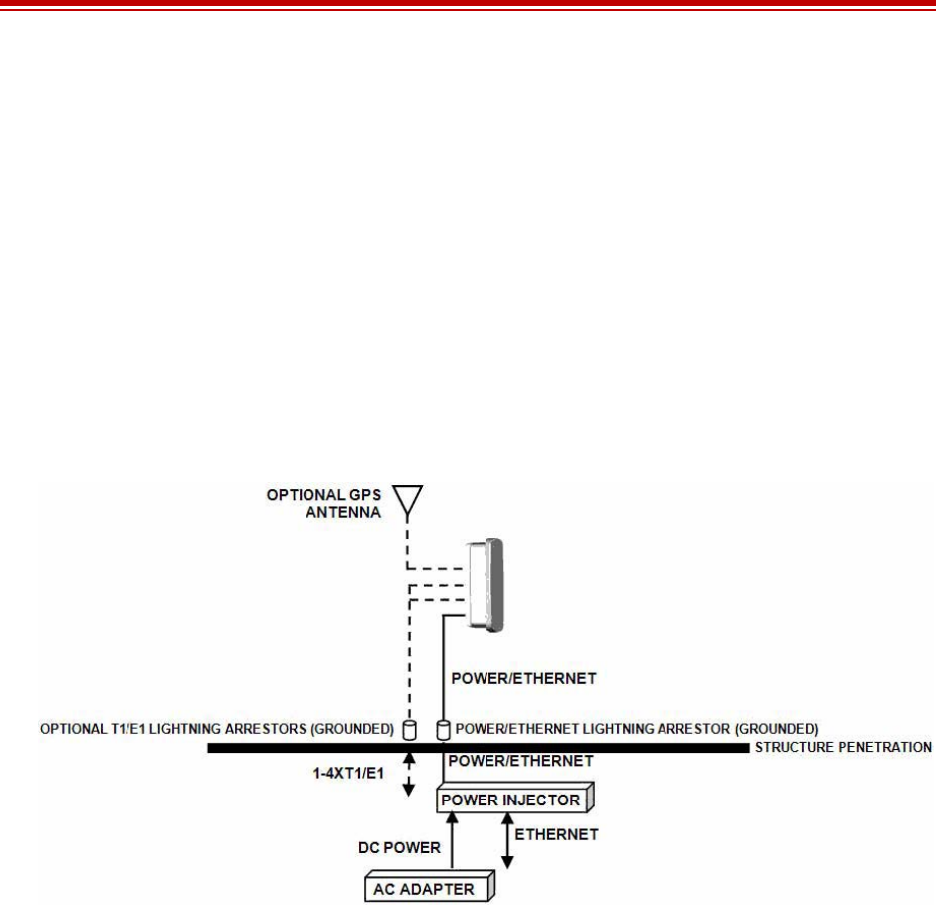
Exalt Installation and Management Guide
ExtendAir (TDD) Series Digital Microwave Radios
4203591-011
2013-02-22
Basic Features
The ExtendAir (TDD) Series Digital Microwave Radios are intended for all-outdoor mounting and
come with an indoor-mounted power injector. In some cases, the radio can be mounted indoors or in an
enclosure. Depending on the configuration purchased, the associated antenna is either integrated as
part of the unit or connected separately.
For the integrated antenna models, the entire unit is typically mounted on a tower or rooftop mast
structure, with Ethernet/Power and other optional interface cables running from the unit location,
through a structure penetration, and to the power injector and connected communications equipment.
For the external antenna models, the unit is typically mounted very close to the external antenna to
minimize RF cabling and associated losses. Alternatively, the unit can be mounted at an easily
accessible location with longer RF cabling to the antenna. Proper lightning or surge suppression
devices and associated grounding are required for all connections.
Figure 2 Mounting and cabling—integrated antenna model
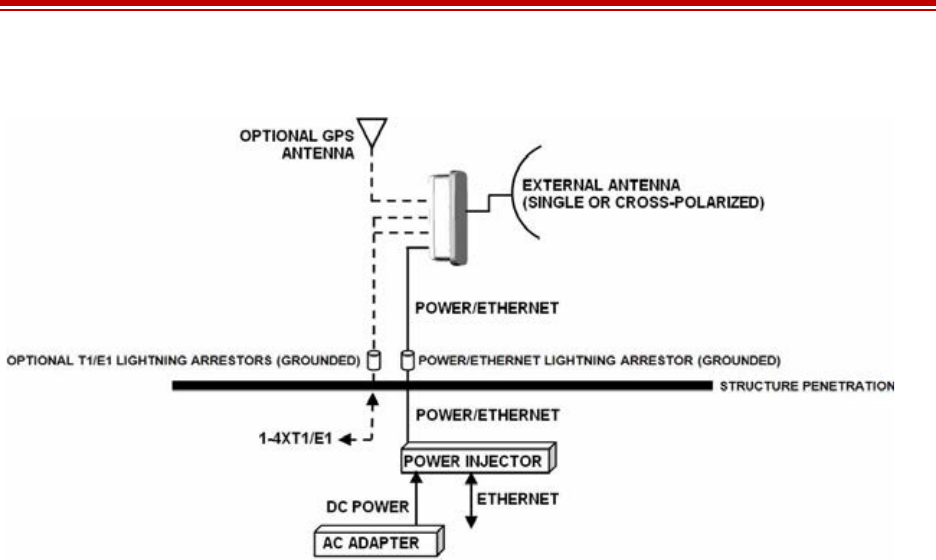
Exalt Installation and Management Guide
ExtendAir (TDD) Series Digital Microwave Radios
203591-011 5
2013-02-22
Figure 3 Cabling and mounting—external antenna model
For highest performance and reliability, it is advised to minimize the length of RF cable and associated
transmission system losses between the antenna and the radio’s antenna port.
The ExtendAir (TDD) Series radios provide connections for a combination of the following data
communication interfaces:
•10/100BaseT Ethernet (up to 3 ports, depending on model)
•Up to 4xT1/E1 interfaces for synchronous voice traffic (xx10 and xx15 models only)
The ExtendAir (TDD) Series radios are powered by a combined Power/Ethernet cable, and associated
power injector. The power injector provides 48VDC to the unit. The power injector and/or external
power supply are sold separately.
The ExtendAir (TDD) Series radios provide the following primary features and benefits:
•Low-latency optimization and control for voice and data connections
•Very high throughput and flexible interface configurations with voice+data combinations
•Encryption for extreme wireless security
•Easy-to-use management and configuration
•Flexible utilized channel bandwidth selection for interference avoidance and frequency
coordination
•Flexible center frequency tuning for interference avoidance and frequency coordination
•Flexible capacity to meet current connection requirements and future growth needs
•Carrier-class reliability and performance
•Connector covers (for weatherproofing unused connectors)

Exalt Installation and Management Guide
ExtendAir (TDD) Series Digital Microwave Radios
6203591-011
2013-02-22
Pre-installation Tasks
This section describes the steps necessary to prepare a site for the installation of the Exalt Digital
Microwave Radio.
Link Engineering and Site Planning
Design all terrestrial wireless links prior to purchase and installation. Generally, professional wireless
engineering personnel are engaged to determine the viability and requirements for a well-engineered
link to meet the users’ needs for performance and reliability.
Please use the ExaltCalc path calculator, which aids in the pre-planning and engineering required to
determine following attributes:
•Antenna type gain at each end of the link
•Antenna mounting height/location for proper path clearance
•Antenna polarization orientation
•RF cabling type, length, connectors, route, and mounting
•Antenna system grounding
•Lightning arrestor type(s), location(s), and grounding
•Radio mounting location and mechanisms
•Radio grounding
•Radio transmitter output power setting
•Anticipated received signal level (RSL) at each end
•Anticipated fade margin and availability performance at each end
•Radio settings for TDD frame length and occupied bandwidth
•Anticipated throughput performance (TDM circuit support and Ethernet)
•Anticipated system latency
With respect to radio path and site planning, these radios are generally identical to other microwave
terrestrial wireless systems. Engineering of these systems requires specific knowledge about the
radios, including:
•RF specifications (transmitter output power, receiver threshold, occupied channel bandwidth, and
carrier-to-interference)
•Regulatory limitations on transmitter output power setting and antenna type/gain
•Noise/interference profile for the intended location
Familiarization with the ExtendAir (TDD) Series Radios
The ExtendAir (TDD) Series radios utilize time division duplex (TDD) radio transmission. This means
that the transmitted signal in both directions uses the same center frequency and transmits in one
direction for a period of time, and then in the opposite direction for another period of time. This total
period of time is referred to as the frame length or TDD frame length, and is further discussed in Time
Division Duplex (TDD) Factors.

Exalt Installation and Management Guide
ExtendAir (TDD) Series Digital Microwave Radios
203591-011 7
2013-02-22
The two radio terminals are identical hardware, except for the TDD setting in software. When the
radios are in their default state, both radios are configured as Radio B. One end of the link must be
configured as Radio A before the two ends of the radio system can communicate.
It can be considered that Radio A is the primary radio in the link. Radio A provides the master clock
and control to Radio B. For most applications, it is not important how the radio link is oriented, only
that one end is configured for Radio A and the other for Radio B. For some applications (such as,
multi-radio hub sites or repeaters), the orientation of the radio systems may be more critical. See Link
Orientation and Synchronization for details.
There are two ways to configure the radios for Radio A/B determination:
•Use the Exalt browser-based graphical user interface (GUI) – preferred.
•Connect to the radio using Telnet.
Exalt recommends using the Exalt GUI for radio configuration. This interface requires a computer
with an Ethernet port and web browser software, such as Microsoft Internet Explorer 5.0 or above. See
Configuration and Management for details on how to connect to and use the browser-based GUI
interface.
Shipping Box Contents
Unless purchased as a spare terminal, the radios are shipped as a complete hop (that is, a radio link pair
consisting of two terminals). An outer box has labeling that indicates the contents of the box, with the
part number and serial number details for both radio terminals.
Inside the outer box are two identical boxes, each of these boxes is also marked with the part number
and serial number of the individual terminal contained inside the box. The terminal box contains the
following items:
•Radio terminal (configured as Radio B)
•Mounting kit (for pole or wall mounting)
•Accessory kit
– Grounding screw/washers
– Weather-sealing tape (required for RF connectors on the rc versions)
– RSL adapter cable
•Registration card
•Quick-start guide
The power solution for ExtendAir is sold separately. For customers requiring direct 48V DC power, a
power injector is available. For AC-powered applications, a POE/Adapter combination is available.
Inspect the outer packaging and the contents of the boxes upon receipt. If you suspect any shipping
damage or issues with the contents, contact Exalt Customer Care.
Outdoor-rated and shielded CAT5e cable, such as Beldon 1300A, with RJ-45 or RJ-48C connectors is
recommended for the Ethernet and/or TDM connections. For Ethernet connections, a maximum length
Note: Register your system as soon as possible. A 2-year Warranty period applies to
products registered within 90 days of purchase. The Warranty period is reduced to 1-year for
unregistered products and products registered after the first 90 days.

Exalt Installation and Management Guide
ExtendAir (TDD) Series Digital Microwave Radios
8203591-011
2013-02-22
of 100 meters applies to the total length of the cabling between the radio terminal and the first
network-aware connection (such as a switch or router).
Initial Configuration and Back-to-Back Bench Test
Every Exalt digital microwave radio goes through extensive quality testing and performance
evaluation over the full operating temperature range prior to shipment. However, before installation, it
is strongly advised to perform several tests and tasks that are much more difficult to perform once the
radio link endpoints are distant from one another. A back-to-back bench test and pre-configuration will
provide confidence that the radio link is operational and properly configured prior to installation, so
that if troubleshooting is necessary, the radio hardware and configuration settings are eliminated from
the troubleshooting process. Verify the following in the back-to-back testing:
•Confirm that the radio system is generally operational
– Radios power-up with planned power and wiring solutions
– Radio firmware version matches on each terminal (and is ideally the latest version)
– Upgrade license key entry successful
– RF link connects in both directions
– Traffic passes across the link
– Configure connected equipment and cabling
– Test Ethernet (CAT5e) cabling, and/or T1/E1 cabling, any auxiliary connector cabling and
configure all interfaces
– Configure IP settings for configuration and management
– Configure passwords and security modes
– Become familiar with the configuration and management interfaces through the Exalt GUI
interface
– Configure radio parameters
– Set transmitter output power to engineered or allowed level (see RF Output Power Setting)
– Set operating center frequency
– Set link distance, occupied channel bandwidth, and frame length
•Make detailed radio performance measurements
– Measure transmitter output power
– Measure receiver threshold performance
– Confirm unfaded error-free performance
Some of these tasks may not be possible or practical within a bench test environment due to the nature
of the remote connectivity of peripheral equipment. However, it is good practice to perform as much as
possible in this environment to minimize field/installation time and troubleshooting efforts.
Note: Some countries require Dynamic Frequency Selection (DFS), which delays the
transmitter turn-on time during the initial Channel Availability Check period of 1 minute. In
accordance with these regulations, the radios boot up, and then wait for 1 minute before
linking.
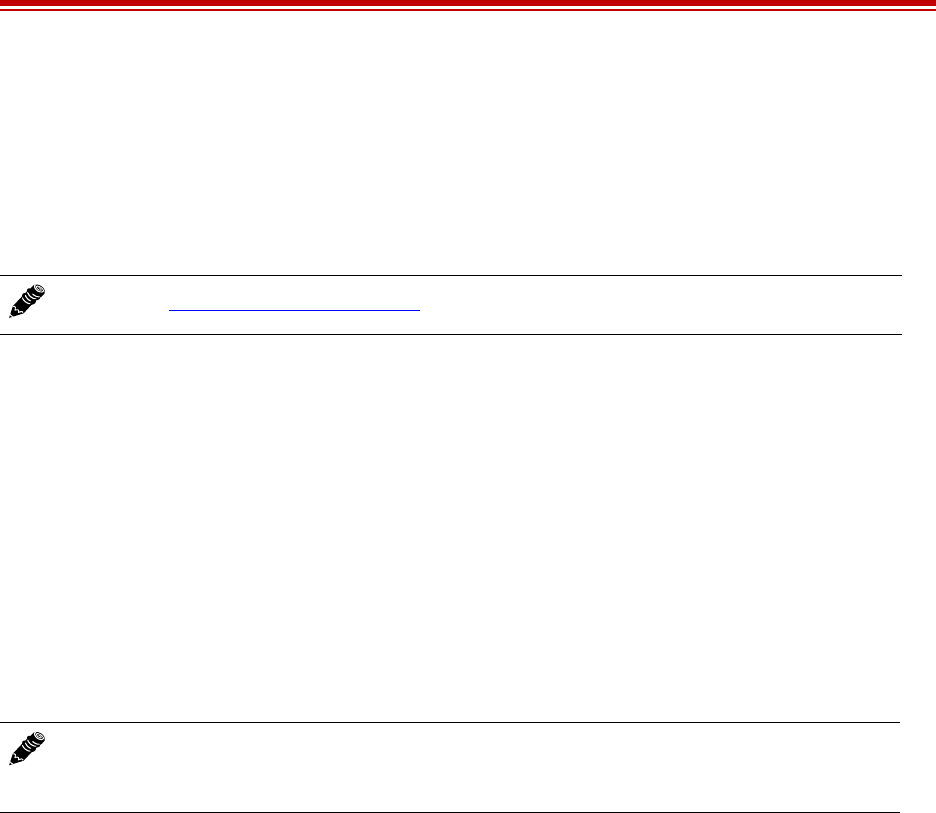
Exalt Installation and Management Guide
ExtendAir (TDD) Series Digital Microwave Radios
203591-011 9
2013-02-22
Detailed performance measurements are usually not required for pre-installation, but can be easily
performed at this stage and may be helpful for later troubleshooting efforts or for internal records.
During troubleshooting, there may often be a point at which a back-to-back bench test should be
performed to verify many or all of the above items, and in the case of a suspected faulty device, to help
confirm the fault and determine which end of the system is at fault and in need of repair or
replacement.
RF Output Power Setting
The maximum RF output power is bounded by one of the following criteria:
•Maximum RF output power setting capability of the radio device, including any software limits
that are applied to the use of integrated or external antennas, based on regulatory limits
•Maximum RF output power allowed/authorized by the local government regulations and for this
specific device
•Maximum effective isotropic radiated power (EIRP) of the transmission system allowed/
authorized by the local government regulations and for this specific device
•Desired RSL to not exceed the maximum RSL allowed by the device
•Desired RSL to minimize/eliminate interference into neighboring systems
Time Division Duplex (TDD) Factors
The ExtendAir (TDD) Series radios are very dynamic, allowing the installer to optimize and control
the performance of the radio system for the intended application. The following parameters must be
carefully determined during the link engineering phase:
•Link distance
•Bandwidth
•TDD frame size
•Mode (modulation)
•The setting of the above parameters determines the following performance factors:
•Number of supported T1/E1 channels (on applicable models)
•Ethernet throughput
•System latency (delay)
Use the ExaltCalc calculator to determine optimum settings for the above parameters to meet the needs
of your application.
The following generalizations can be made with regards to these factors:
•The shorter the TDD frame size, the lower the latency
Note: See Back-to-back Bench Testing for detailed instructions.
Note: In many cases the radio must be pre-configured for legal maximum output power
before connecting to the antenna and transmission system. Instructions for adjusting the
output power can also be found at the rear of this guide in the EIRP section for your region.

Exalt Installation and Management Guide
ExtendAir (TDD) Series Digital Microwave Radios
10 203591-011
2013-02-22
•The shorter the link distance, the lower the latency, the higher the throughput
•The longer the TDD frame size, the higher the throughput
•The higher the bandwidth, the higher the capacity
•The higher the mode, the higher the capacity
Link Orientation and Synchronization
Link orientation refers to the Radio A and Radio B placement in your network. Link synchronization
refers to using external or internal timing to coordinate multiple links.
For every link, one end of the radio link must be configured as Radio A, while the other end is
configured as Radio B. In single-link systems, it does not matter which end of the system is mounted at
which end of the link, and there is typically no requirement for any link synchronization.
Link orientation and synchronization are more important for networks with site(s) where there is more
than one link of the same type or for sites using the same type of radio that are very close to each
another at one or both ends.
Configure collocated radio terminals for the same link orientation. That is, configure all radios at the
same location as Radio A or Radio B.
It can be advantageous to utilize link synchronization for collocated links. The radios allow the use of
an optional GPS synchronization kit. This synchronization controls the transmitter and receiver frame
timing so that collocated radios are transmitting at the same time and receiving at the same time. This
can substantially reduce the opportunity for self-interference. Without synchronization, collocated
radios may be transmitting and receiving at the same time, incurring near-end interference.
When synchronization is required or desired, the following configurations are recommended:
•For a two-radio network without GPS, use Internal Sync and connect a single cable between the
SYNC/RSL ports on both radios (see RSL/Sync Connector for wiring instructions).
•For a two-radio network using GPS sync, use two GPS kits or one GPS kit and the ExaltSync
Collocation kit.
Note: Disable all T1/E1 ports if there are no T1/E1 interfaces connected. This shifts all available
throughput to the Ethernet interface.
Note: If a selected combination of the Link Distance, Frame Size, Bandwidth, and Mode
parameters cannot support all the desired T1 or E1 ports, the ports that cannot be supported are
automatically disabled. Priority is placed on the T1/E1 port number. That is, the first port to be
disabled, if necessary, is the highest port number, such as Port 4. See T1/E1 Configuration Pages
for more information.
Note: It is not always necessary to synchronize collocated radios. If antennas are substantially
separated or blocked from one another and/or frequency separation tuning is used, the
opportunity for near-end interference can be eliminated.
Note: Refer to the ExaltSync Collocation Expansion Kit Quick Start Guide for instructions.

Exalt Installation and Management Guide
ExtendAir (TDD) Series Digital Microwave Radios
203591-011 11
2013-02-22
•For a network of two or more radios using Internal Sync, connect using the ExaltSync Collocation
kit.
•For a network of two or more radios using GPS Sync, connect using one GPS kit and the
ExaltSync Collocation kit, or connect using one GPS kit per link.
Radio A/B Configuration
Use the Exalt GUI to configure the radio terminals for Radio A and Radio B orientation. Since many
other parameters also need to be set, and the Exalt GUI is needed for these configurations, this is the
best way to completely configure the radio terminals.
Radios arrive from manufacture in default configuration, orientated as Radio B and configured as
shown in Table 1.
Table 1 Factory default settings
Parameter ExtendAir (TDD) Series Radio Settings
Frequency 5GHz models: 5788 MHz (5600 or 5785 MHz if the regulatory domain does not
allow 5788 MHz)
4.9GHz models: 4965 MHz
Transmit Power +4dBm
Link Distance <10 miles
Bandwidth 8 MHz (10 MHz for some regulatory domains)
Mode Mode 1
TDD Frame Size 2ms
Link Security Key 000000000000
Administration
Password password
User Password password
IP Address 10.0.0.1
IP Mask 255.0.0.0
IP Gateway 0.0.0.0
Ethernet Interface Alarm Enabled, 100/Full
T1/E1 Enabling All Disabled

Exalt Installation and Management Guide
ExtendAir (TDD) Series Digital Microwave Radios
12 203591-011
2013-02-22
Radio Reset
Use the reset function if the IP address and/or passwords are lost. Use the following steps to perform a
critical parameter reset:
1Remove power from the radio by disconnecting the AC adapter from the power injector.
2Hold down RESET button on the power injector while applying power.
Hold the RESET button down through the entire power cycle and monitor the DATA+POWER
left LED on the power injector. Release the RESET button only after the LED is in the steady state
(45 to 60 seconds).
3Release the RESET button.
The following configurations are reset on the radio:
•IP address = 10.0.0.1
•IP mask = 255.0.0.0
•IP gateway = 0.0.0.0
•Administration password = password
•User password = password
•VLAN disabled
Radio Synchronization
The radio synchronization feature improves the performance of Exalt radios operating in the same
frequency band and that are collocated (such as in repeater and hub configurations). Radio
synchronization ties radio systems together to operate off of a common clock system, ensuring that all
radios simultaneously transmit and receive, and thus eliminating near-field interference issues and
related radio system coupling.
Synchronization Modes
Synchronization can be implemented using either one or multiple GPS sources, or using the radios
'Internal' clocking signal. The following general configurations can be accommodated:
•GPS sync, using one GPS source (sold separately) per link. Ideal for links where the radios are not
collocated on the same rooftop or tower.
•GPS sync, using one GPS source (sold separately) to drive timing to multiple collocated links,
using one or more sync distribution accessories (sold separately). The ideal solution for networks
that have multiple links at one location, but also have more nearby radio links that are not
collocated, including repeaters and multi-link backbones.
•Internal sync, using one radio to synchronize another collocated link. This can be accomplished
with a simple cable and proper radio configuration, and ideal when only 2 radios are collocated.
Note: In many cases, the system design will not be identical to the factory default
configuration, and in some cases, these differences prohibit the installation of the radio. If at
all possible, obtain a computer and configure the radio terminals using the browser-based
GUI. See Exalt Graphical User Interface (GUI) for details.
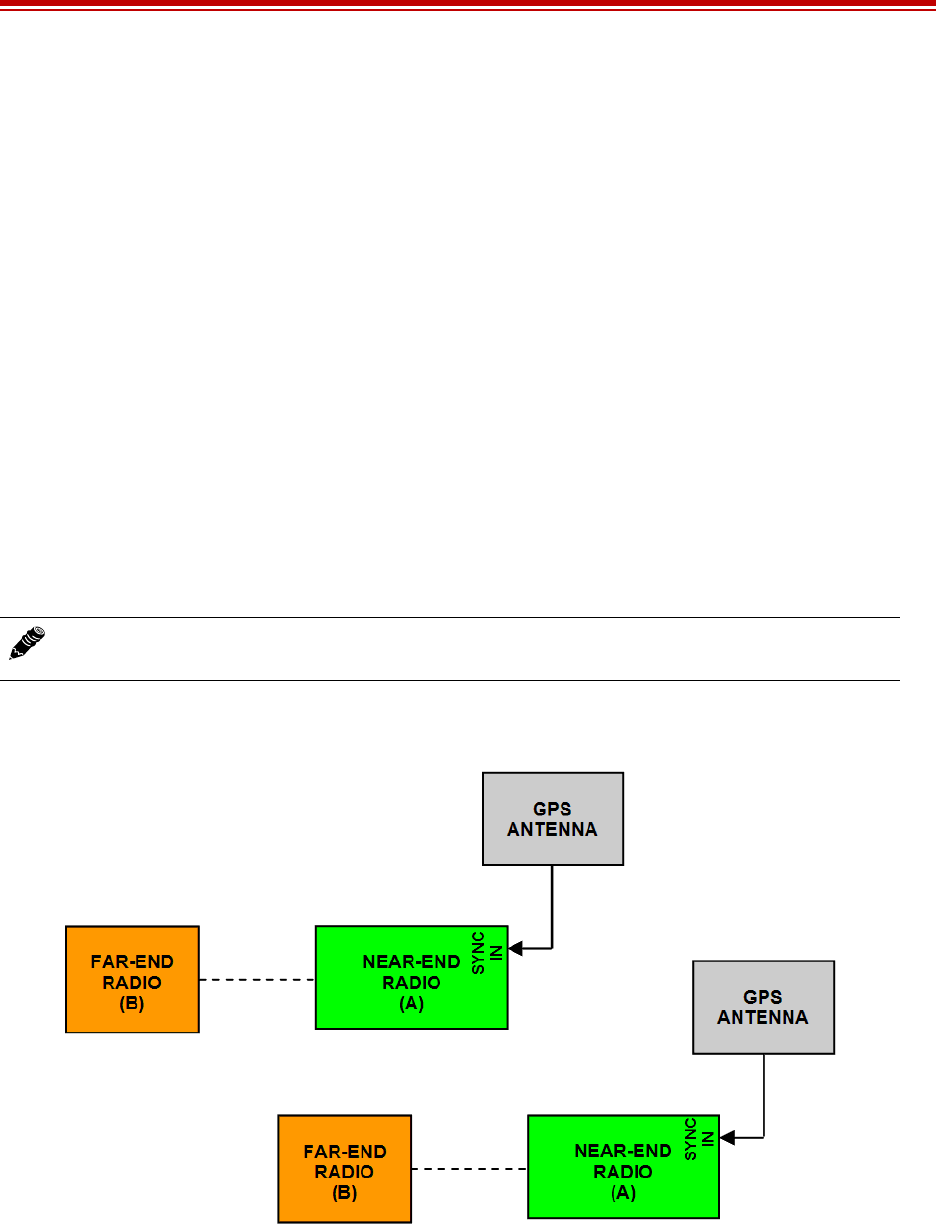
Exalt Installation and Management Guide
ExtendAir (TDD) Series Digital Microwave Radios
203591-011 13
2013-02-22
•Internal sync, using one radio to synchronize to multiple collocated links. This can be
accomplished with one or more sync distribution accessories (sold separately). The ideal solution
for networks that have multiple links at one location and do not have other nearby links or
repeaters and multi-link backbones.
Virtually any combination of hubs and repeater sites, star configurations, and/or backbones can be
implemented with synchronization. It is typically necessary or ideal in each configuration to match the
following parameters on every radio in the network:
•Link Distance – Match to the longest distance link in the network.
•Frame Length – Match to the lowest frame length to optimize total system latency (for example,
for TDM networks) or match to a highest frame length to optimize user throughput. Choose an
intermediate value to compromise between latency and throughput.
•Mode – It is desirable, but not always necessary, to match the mode for all collocated links.
•Bandwidth – It is desirable, but not always necessary, to match the bandwidth for all collocated
links.
For complex networks, an Exalt engineer should review multi-link networks before deployment as
several factors can optimize the network for desired performance.
Figure 4 illustrates two separate radios benefiting from synchronized GPS sources.
Figure 4 Synchronized GPS sources
Figure 5 illustrates the recommended synchronization method for two links that share a common site at
one end of each link. Using internal sync, a cable can be connected between the two radios to
accomplish sync. No GPS receiver is required. This approach cannot be used for more than two
collocated radios.
Note: When GPS Sync is enabled, link initiation typically takes 1 to 3 minutes to allow for
the radio to properly synchronize to the available GPS satellites.
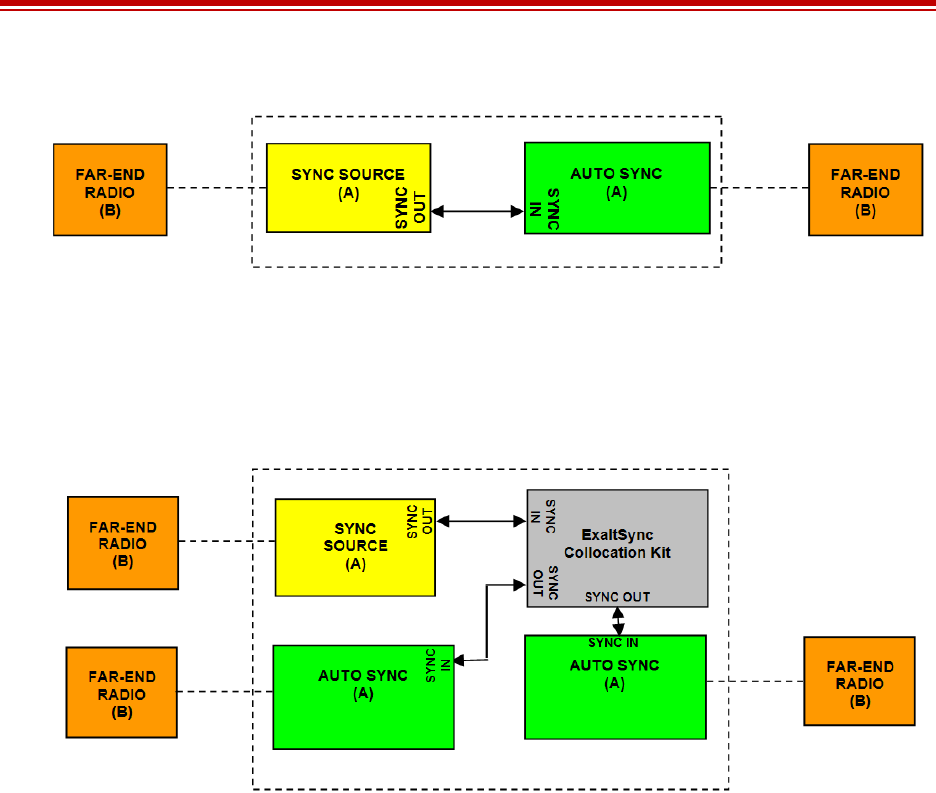
Exalt Installation and Management Guide
ExtendAir (TDD) Series Digital Microwave Radios
14 203591-011
2013-02-22
Figure 5 Internal Sync for two collocated radios
When more than two radio links terminate from the same site, use the sync distribution accessory,
ExaltSync Collocation Kit (sold separately) to connect more links to the Internal Sync source, as
shown in Figure 6. Use one kit to connect one Sync Source radio to up to three additional links. Each
additional kit expands up to three additional links.
Figure 6 Internal Sync for more than two collocated radios
This approach can also be used using an Exalt GPS source for synchronization, instead of Internal
Sync, as shown in Figure 7. This approach is recommended if there are other nearby sites that are not
collocated or part of the connected network that need to be synchronized. Using one kit, a single GPS
Antenna can synchronize up to 4 collocated links. This can be expanded 3 additional links per
additional kit.
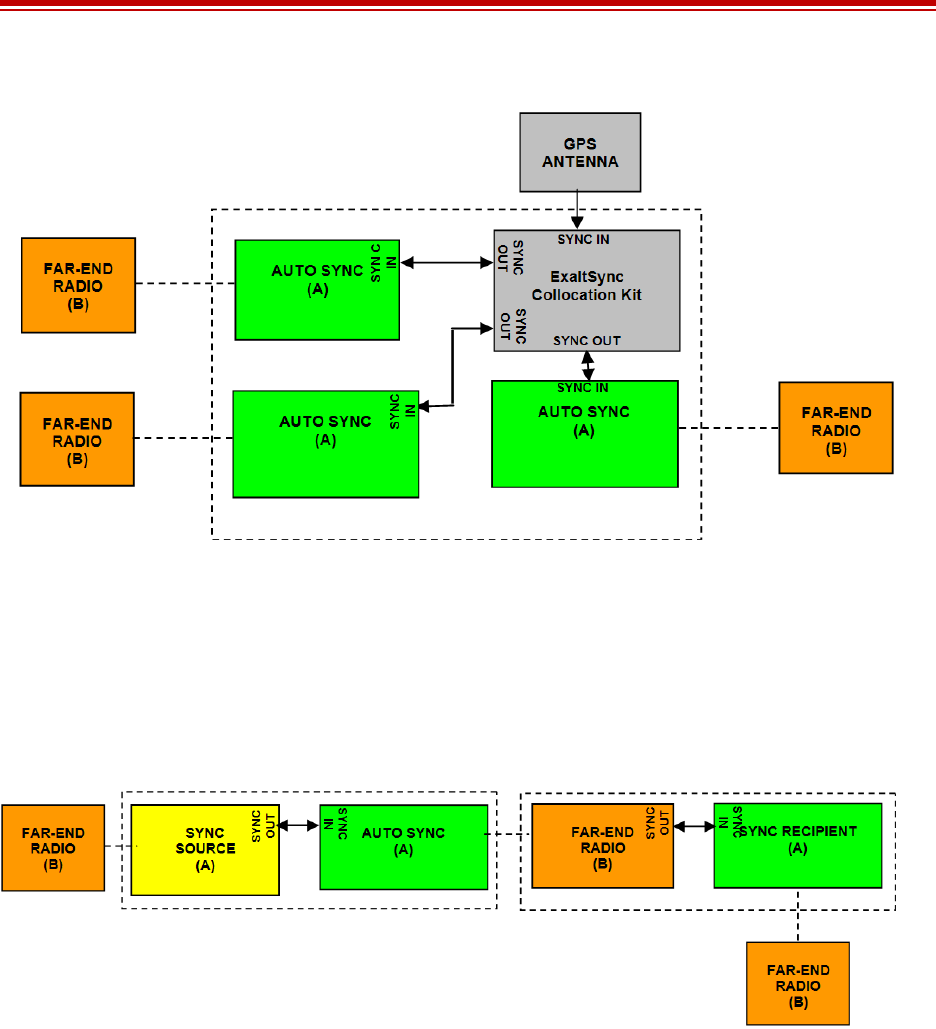
Exalt Installation and Management Guide
ExtendAir (TDD) Series Digital Microwave Radios
203591-011 15
2013-02-22
Figure 7 GPS Sync for more than one collocated radios
At the far end of a synchronized link, if there are additional links to synchronize, use the Sync Out port
of the Radio B to drive synchronization to the collocated radios. If there is only one additional radio,
connect a cable from Sync Out to the Sync In port of the next radio, which should be configured as
Radio A. Set this radio in the chain to Sync Recipient, as shown in Figure 8. If more than one radio is
located at the secondary location, to drive synchronization for multiple Radio A terminals connect a
ExaltSync Collocation Kit driven from the Radio B Sync Out port.
Figure 8 Synchronization for radios in a chain
Offset Timing
For GPS implementations, manual control of offset timing is also allowed. This provides a means to
delay the synchronization signal using a user-defined offset. This is helpful when Exalt radios are near
other devices operating in the same frequency band that also use a timing source, such as GPS. The
timing source to the Exalt radios can be adjusted to match the other radio system timing source
mechanism.
Offset timing can also optimize timing intervals for repeaters and backbones. As the distance of each
link results in a unique factor for speed-of-light transmission of the radio signal, a subsequent radio can
be delayed in timing so that the overall synchronization of radios is precisely maintained.
Offset timing can be adjusted in 1-ms intervals, from zero to the radio’s frame length setting. For
example, if using a 2-ms frame length, the offset timing can be set from zero up to 1999 ms.

Exalt Installation and Management Guide
ExtendAir (TDD) Series Digital Microwave Radios
16 203591-011
2013-02-22
When Sync is Lost
If the primary sync source (for example, the GPS source) signal is lost due to equipment failure, a
disconnected sync cable, loss of satellite link, or other condition, the radio is said to be flywheeling.
When flywheeling, the radio’s clock is free-running off internal clocking and is no longer
synchronized to any source. If the original sync source is restored to the flywheeling radio’s
configuration, it attempts to synchronize to this signal without causing transmission interruption.
When the flywheeling radio runs independently for long periods of time, the synchronization signal
may be too far outside the capture range of the synchronization loop, and portions of transmission
frames can be lost during this re-synchronization process. This condition is temporary and all
interconnected radios will re-synchronize to the sync source, as necessary.
If the flywheeling period is exceeded, the radio will stop transmitting. There is a setting for infinite
flywheeling; however, long periods of flywheeling can cause interference with collocated radios.
Virtual Local Area Network (VLAN)
VLAN segments information in a single connection and creates multiple separate connections to
secure information of one type or for one set of users from other information types or for other sets of
users. Exalt’s VLAN communications implementation adheres to the IEEE standard 802.1q.
In most cases, an Exalt radio acting as a Layer 2 bridge between two locations is only required to pass
traffic with VLAN tagging. Without additional configuration, all Exalt radios support frame sizes in
excess of 1900 bytes, which currently supports all defined VLAN packet sizes.
Some situations require Exalt radios to act upon VLAN traffic and perform any or all of the following
functions:
•Connect specific traffic, using VLAN tagging, to different purposes, such as management traffic to
the radio’s NMS system.
•Allow only traffic with specifically assigned VLANs to pass across the link, blocking all other
VLANs or any non-VLAN traffic.
•Allow management access only through a VLAN connection, leaving the main traffic transparent.
•Allow management access without a VLAN connection, but flowing only specific VLAN traffic
across the link.
Link Symmetry
The default configuration of ExtendAir (TDD) Series radios provides 50/50 symmetrical throughput.
The Tx/Rx Throughput Ratio setting enables programming different symmetry for applications where
significantly higher throughput in one direction is anticipated such as for video broadcast, video
aggregation, or remote server/storage WANs.
Exalt does not recommend placing two links with asymmetry back-to-back in a serial configuration
due to the TDD cycle of the radios. This configuration requires that one radio transmits in an
overlapping time period while another radio is receiving. Physical antenna isolation and/or frequency
channel spacing may accommodate this configuration. Asymmetry is, however, ideal for single-hop,
multi-link hub/spoke architectures, or simply single independent links.
Note: If an application only requires the transparent passing of VLAN traffic, disable the VLAN
function.

Exalt Installation and Management Guide
ExtendAir (TDD) Series Digital Microwave Radios
203591-011 17
2013-02-22
TDD frame sizes of 2ms and 5ms are supported. The 5ms configuration maximizes the aggregate
throughput of the radio for every situation. The 2ms configuration reduces latency to meet latency-
critical applications, especially for multi-link and TDM circuit support. The following RF BW/mode
combinations are supported for these two configurations:
•16MHz/Mode1 (called 20MHz/Mode1 for some regulatory domains)
•16MHz/Mode2 (called 20MHz/Mode 2 for some regulatory domains)
•16MHz/Mode 3 (called 20MHz/Mode 3 for some regulatory domains)
•32MHz/Mode1 (called 40MHz/Mode 1 for some regulatory domains)
•32MHz/Mode2 (called 40MHz/Mode 2 for some regulatory domains)
•32MHz/Mode 3 (called 40MHz/Mode 3 for some regulatory domains)
The following Tx/Rx ratios are supported for these two configurations:
•65/35 and 35/65
•80/20 and 20/80
For example, a radio configuration of 32MHz/Mode2 with a 5ms TDD frame size supports up to
110Mbps user capacity or 55Mbps full-duplex. By selecting 80/20 on one side of the link and 20/80 on
the other side, the radio allows up to 88Mbps in one direction, and 22Mbps in the opposite direction.
T1/E1 is supported with asymmetric settings. However, based on the BW/mode setting (and in some
cases, TDD frame size and distance), the direction with the limited throughput limits the number of T1
or E1 connections obtained. For example, the 16MHz/Mode1 setting typically supports up to 27Mbps
aggregate throughput. In the 80/20 ratio configuration, one direction is limited to 5.4Mbps, which is
less than 3xE1 and less than 4xT1. Since TDM connections must be symmetrical, this setting therefore
limits throughput to no more than 2xE1 or 3xT1.
Simple Network Management Protocol (SNMP)
The Exalt radios primarily use a browser-based graphical user interface (GUI) for radio configuration
and management, as described in Exalt Graphical User Interface (GUI). In addition, a command line
interface (CLI) is provided for serial and/or Telnet access, as described in Configuration and
Management. SNMP is often used for management of larger networks as described here. Use SNMP to
manage networked devices and execute the following functions:
•GET: Obtain information from the device, such as a configuration setting or parameter.
•SET: Change a configuration setting on the device.
•TRAP: The device proactively informs the management station of a change of state, usually used
for critical alarms or warnings.
Note: Asymmetry is only supported for a specific subset of system configurations that are
optimized for typical asymmetric applications.
Note: The 80/20 configuration is not supported for 32MHz/Mode3, because the capacity of
the 100BaseT interface is fully utilized at 65/35 configuration for this setting.
Note: GPS sync is supported with asymmetric settings, but in addition to the other
requirements for sync, all radios tied to sync must be set with matching ratios.

Exalt Installation and Management Guide
ExtendAir (TDD) Series Digital Microwave Radios
18 203591-011
2013-02-22
One feature of the SNMP implementation is that system configuration changes do not take effect using
the SET command. Instead, groups of configuration settings can be preconfigured for global change,
and a single ‘Save’ (Commit) command implements all changes.
When some parameters are changed, a link may drop and/or management control lost. MIB files allow
many parameters to be set at once, allowing only a temporarily dropped link or management control
issue. The opposite end radio can be quickly reconfigured, with little downtime for the link and
management control. The save (Commit) command is similar to the Update button.
Dropped links or management control issues do not occur with every parameter change. Many
configuration changes do not impact traffic or management access.
Exalt radios utilize SNMPv3, a high security version of SNMP, to ensure secure access to and storing
of management data. The SNMPv3 security string matches the admin and user passwords. Passwords
must be eight characters or longer. Some models also have legacy SNMP support for customers
requiring SNMPv1 and/or SNMPv2.
Note: MIB files can be downloaded on the File Transfer Page.
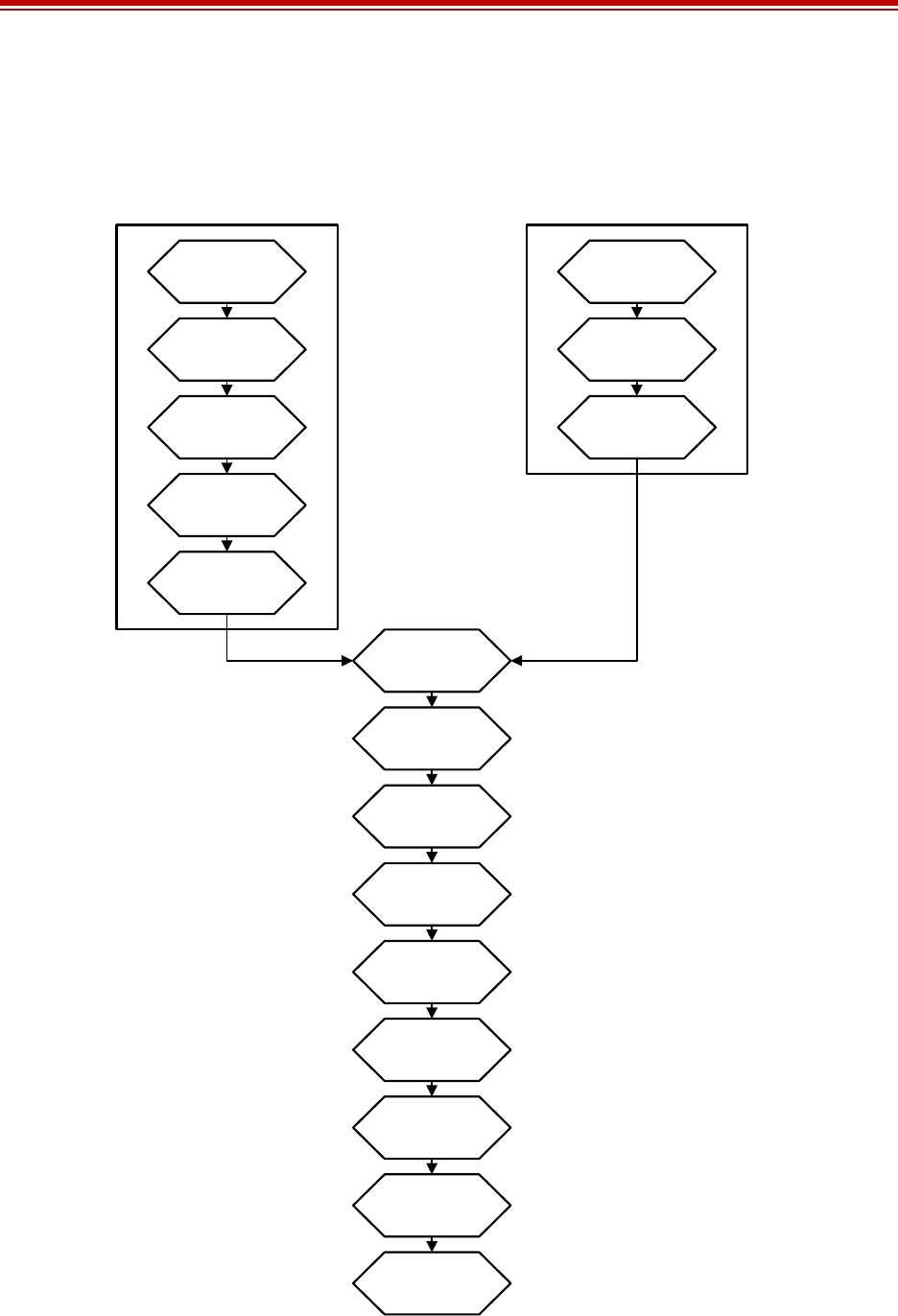
Exalt Installation and Management Guide
ExtendAir (TDD) Series Digital Microwave Radios
203591-011 19
2013-02-22
System Installation and Initiation Process
The tasks required for radio installation and initiation are outlined in the following figure.
Figure 9 Radio installation tasks
Path & Site
Analysis
Link Design
Build Antenna
Structures &
Egress
Mount
Antennas &
Transmission
Line
Install & Test
Network &
Power Wiring
Read This
Manual
Completely
Pre-configure
Radios
Perform
Back-to-Back
Test
Mount Radios
Connect
Transmission
Line
Connect
Power
Align
Antennas to
Planned RSL
Verify LEDs
for Good Link
Test Network
Connectivity
Connect &
Test Primary
Services
Test Network
Management
System
Both Transmission
System & Radio
Preparation Tasks
Must Be Complete
Transmission System Tasks Radio Preparation Tasks

Exalt Installation and Management Guide
ExtendAir (TDD) Series Digital Microwave Radios
20 203591-011
2013-02-22
Record Keeping
After installation, record the following items for ongoing maintenance and future troubleshooting.
Keep a record for each end of the radio link and store a copy of these records at the radio location, at
the opposite end radio location, and a central record storage location.
•GPS coordinates for antenna locations at each site
•Antenna heights above ground level (AGL), as mounted
•Antenna model numbers, serial numbers, and specifications
•Antenna polarization as mounted
•Length/type of primary transmission lines at each site
•Model number and serial number of RF lightning arrestors
•Length/type of secondary transmission line(s)
•Transmitter output power setting as installed at each site
•RSL as measured after antenna alignment at each site
•Designed RSL per original design at each site
•RSL reading with far-end power off (from each end)
•Spectrum analyzer plot with far end off at each site
•Voltage standing wave ratio (VSWR)/return loss at radio’s antenna connector at each site
•Radio’s network management IP address at each site
•Radio’s network management gateway address at each site
•Radio’s operating frequency, bandwidth setting, and mode of operation
•Optionally purchased extended warranty and/or emergency service contract details
In addition, certain information may be desired for central record-keeping only:
•Link security codes and log in passwords (stored in a secure place)
•Photographs of complete installation
•End-user sign-off/acceptance documentation (if any)
•Photo of product identification label (part number, serial number, MAC address information)
•Electronic copy of radio’s configuration file
•Electronic copy of radio’s installed software
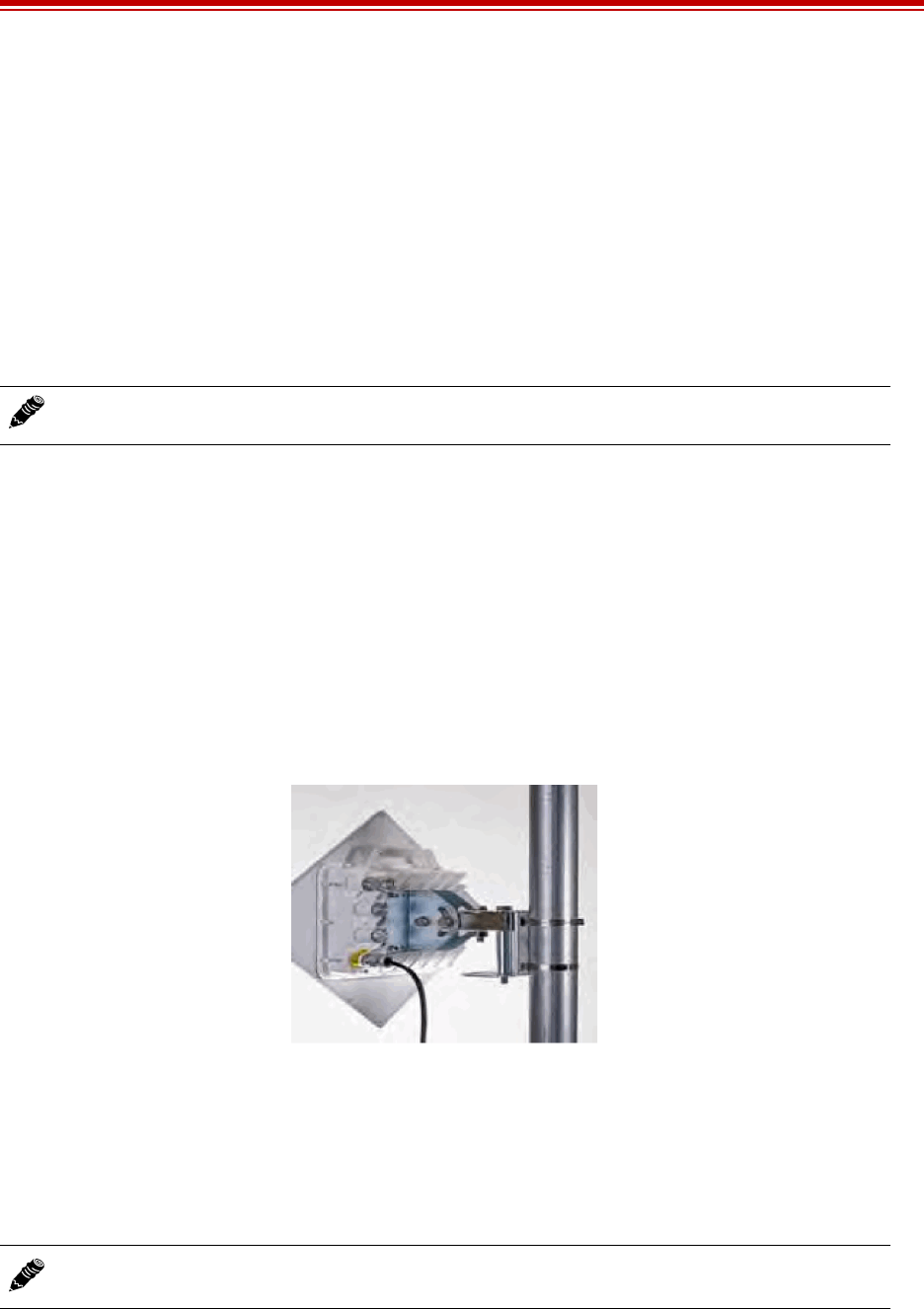
Exalt Installation and Management Guide
ExtendAir (TDD) Series Digital Microwave Radios
203591-011 21
2013-02-22
Installation
This section presents all tasks required to install the Exalt Digital Microwave Radio.
Mechanical Configuration and Mounting
The ExtendAir (TDD) Series radios are environmentally sealed units intended for deployment
outdoors. The device must be deployed within an ambient temperature range as specified, and with
non-restrictive airflow around the chassis. The rc models can also be mounted in an enclosure or
indoors. The same airflow and temperature conditions apply. All integrated antenna models can be
mounted behind a window if window losses are considered in the link budget calculation.
Provide proper clearance for all cables and connectors attached to the device.
Note that for the rc models, the RF cable connector may require significant clearance for the bend
radius of the coaxial cable assembly. All RF connectors, cables, and adapters must be rated for
operation within the radio’s frequency range. RF connector losses must be accounted for within the
link engineering design and output power settings.
Mounting the System
Use the mounting system supplied with each terminal for wall or pole mounting (Figure 10). The pole
mounting kit can accommodate a pole 2–5"/5–13cm in diameter. Install the mounting system first, and
then affix the radio to the mount. The radio can also be affixed to the mount, and the entire assembly
(including radio) mounted.
Figure 10 Pole-mount example (integrated antenna version)
For rc models, the mounting solution is a very simple single bracket, using the same pole-mounting
band clamps with the same specifications.
For the integrated antenna model, it is critical to mount the entire device at the predetermined location
for proper path clearance to the link end. Ensure that there is adequate space around the mounting
system and the radio to allow for antenna alignment for both azimuth and elevation adjustments.
Note: The power injector and power supply must be placed indoors or in an enclosure.
Note: Mount the rc models as close as possible to the antenna to minimize the length and
associated losses of RF cabling.
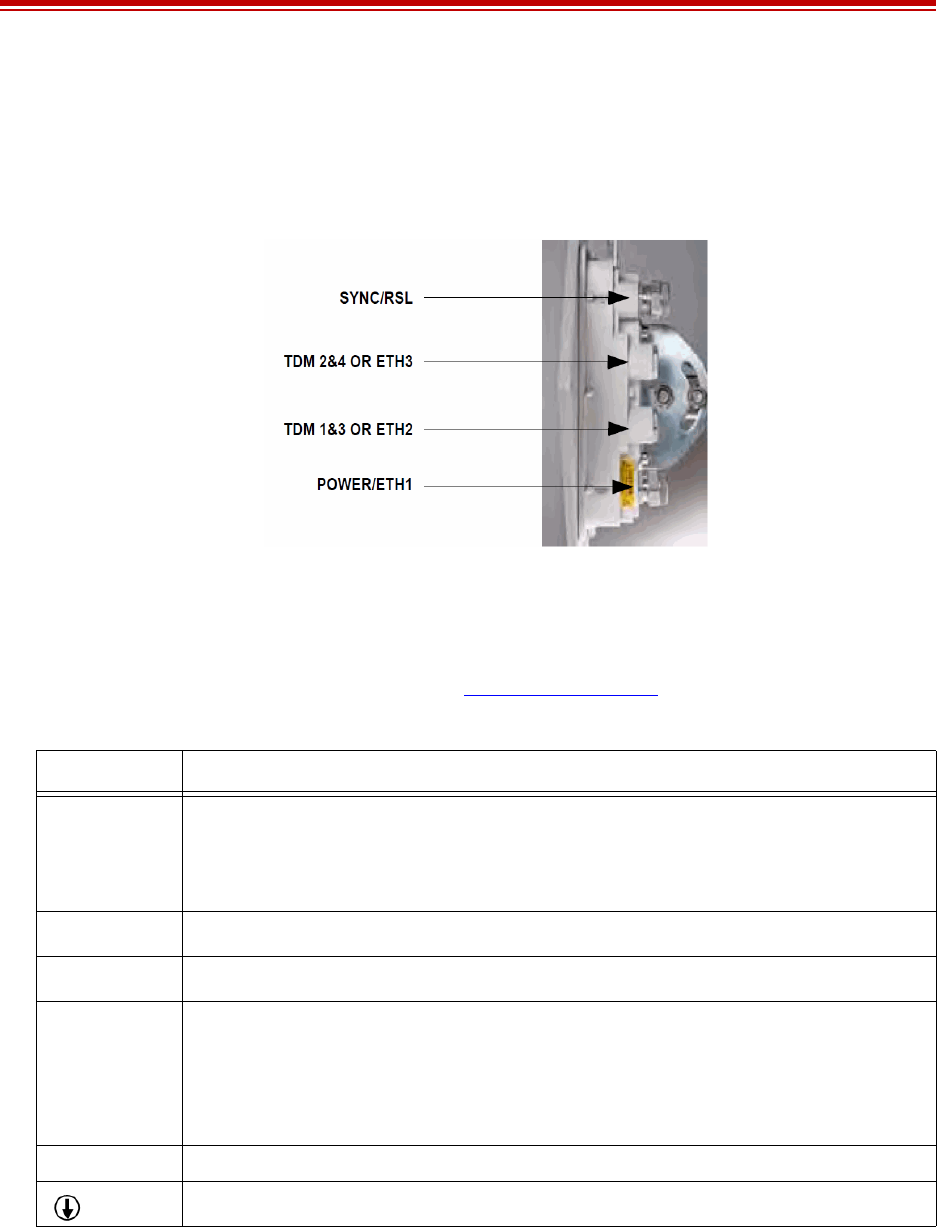
Exalt Installation and Management Guide
ExtendAir (TDD) Series Digital Microwave Radios
22 203591-011
2013-02-22
Radio Ports and Indicators
This section provides a brief overview of the connectors, controls, and indicators on the device. Details
about each item are in other sections of this document. Figure 11 shows the connectors on the
ExtendAir (TDD) Series radios.
Figure 11 ExtendAir (TDD) Series connectors (model r5000)
Connector Overview
The primary user interfaces are shown in Figure 12. Table 2 provides details of the connectors.
Detailed pin structures for each connector are in Interface Connections.
Table 2 Connectors
Connector Description
SYNC/RSL (1) Sync In for TDD Synchronization (from Exalt GPS or second radio or ExaltSync Collocation Kit).
(2) Sync Out for TDD Synchronization (to a second radio or through ExaltSync Collocation Kit to
multiple radios).
(3) Antenna alignment RSL voltage (during installation).
TDM 2&4 Ports for up to two user T1 or E1 circuits to traverse link, port numbers 2 and 4.
TDM 1&3 Ports for up to two user T1 or E1 circuits to traverse link, port numbers 1 and 3.
Power/ETH1 Connected cables traverse to the power injector (Data+Power side), and provide the following
functions:
• Primary ports for user Ethernet data (10BaseT or 100BaseT) to traverse link
• DC power from power injector
ETH2 and ETH3 Ports for additional Ethernet connections, management and/or traffic. (xx05 models only).
(Ground) Threaded (M5) receptacle.

Exalt Installation and Management Guide
ExtendAir (TDD) Series Digital Microwave Radios
203591-011 23
2013-02-22
LED Indicators
Table 3 provides details of the LED indicators on the ExtendAir (TDD) Series radios. Note that there
are two LEDs, labeled top and bottom, associated with each connector. See Alarms Page for
information on how the Exalt GUI displays LED status.
RESET Button
There is only one external control on the ExtendAir (TDD) Series radios system, a button labeled
“RESET” which is located on the Power Injector. This button performs two functions: critical system
parameter reset and summary alarm information.
Use the reset function if the IP address and/or passwords are lost. Use the following steps to perform a
critical parameter reset:
Use a connector cover on all unused connectors for weatherproofing. The connector covers
are included in the accessory kit. Use a safety ring on each connector to secure the connector
covers.
Table 3 LED indicators
Location Type Function
GPS/RSL
Top Green LED Solid when valid GPS connection is detected.
GPS/RSL
Bottom Green LED Unused
TDM 2&4
Top Green LED Solid when T1 clocking is present for input #2.
TDM 2&4
Bottom Green LED Solid when T1 clocking is present for input #4.
TDM 1&3
Top Green LED Solid when T1 clocking is present for input #1.
TDM 1&3
Bottom Green LED Solid when T1 clocking is present for input #3.
ETH2 or ETH3
Top Green LED Unused
ETH2 or ETH3
Bottom Green LED Solid when valid when Ethernet Link is present.
Blinking when Ethernet traffic is present.
Power/ETH1 Green LED Solid when proper power is applied.
Power/ETH1
Bottom Green LED Solid when Ethernet link is established.
Blinking when Ethernet traffic is present.
Power Injector
DATA+POWER
Left Green LED Solid when no alarm conditions are present.
Flashing when in alarm condition.
While RESET button is pressed:
Solid when in major alarm condition (traffic affecting).
Flashing when in minor alarm condition (not traffic affecting).
Off when no alarm conditions are present.
DATA+POWER
Right Green LED Solid when proper power is applied.

Exalt Installation and Management Guide
ExtendAir (TDD) Series Digital Microwave Radios
24 203591-011
2013-02-22
1Remove power from the radio by disconnecting the AC adapter from the power injector.
2Hold down RESET button on the power injector while applying power.
Hold the RESET button down through the whole power cycle and monitor the DATA+POWER
left LED on the power injector. Release the RESET button only after the LED is in the steady state
(1 to 3 minutes, depending on firmware installed).
3Release the RESET button.
The following configurations are reset on the radio:
•IP address = 10.0.0.1
•IP mask = 255.0.0.0
•IP gateway = 0.0.0.0
•Administration password = password
•User password = password
•VLAN = disabled
A flashing left DATA+POWER LED on the power injector indicates that alarm conditions exist on the
radio. To access summary alarm information during normal operation, press and hold the RESET
button. The following is status for the left the DATA+POWER LED while holding the RESET:
•Solid on is a link alarm (link is down or errored)
•Flashing indicates a minor alarm (does not affect traffic)
Power
The radio requires a DC power source within specifications. DC can be provided from a DC battery
source, central lab/rack supply, or from the supplied AC adapter.
Terminating the RF Connectors (rc models)
Before applying power, the RF connectors must be properly terminated into a 50-Ohm load. If this is
not performed, the radio may be damaged by simply applying power. Also, there are human safety
factors to consider regarding potentially harmful RF radiation.
The following lists a few simple ways to achieve proper termination:
•Connect a 50-Ohm coaxial termination device to the RF port of the radio. The termination must be
rated to 1W (or more). Example(s) include:
– Broadwave Technologies P/N 552-200-002, or similar
•Connect the complete transmission system. That is, the RF cabling including the antenna. The
cabled antenna provides a proper termination for the RF output.
•Connect a fixed (or a series of fixed) 50-Ohm attenuator(s) to the RF connector, either directly or
at the end of an RF transmission line. The attenuator must be at least 30dB as specified at the
operating frequency and rated for a minimum of 1W input power. Examples include:
– Broadwave Technologies P/N 352-103-xxx
Note: Read this section completely before applying power.

Exalt Installation and Management Guide
ExtendAir (TDD) Series Digital Microwave Radios
203591-011 25
2013-02-22
– Bird 2-A-MFN-xx
– JFW Industries 50FP-xxx-H6-N
Cover any unused connector with the connector cap and apply the weather-seal tape. Both cap and tape
are included in the accessory kit.
Optional AC Power
The optional AC power injector kit easily connects to the customer-supplied CAT5e PoE cable. Refer
to the input voltage requirements stated on the label affixed to the adapter to ensure that the adapter
can be used with the AC mains supply.
The AC plug outlet provided with the adapter may need to be replaced to match the country
configuration. The adapter cable uses a standard connector for this cable for use of a pre-wired cable
appropriate to the outlet configuration. If the appropriate cable is not available, the existing AC plug
end can be severed and a replacement plug affixed. Consult a qualified electrician for this activity.
Do not plug the adapter into the mains power. First, verify that the RF connector is properly terminated
(see Power), and then plug in the radio-side connector from the AC adapter to the radio. If the AC
mains can be turned off using a switch, disable the power, plug the AC side of the adapter into the AC
mains socket, and then enable power to the circuit. If the AC mains cannot be turned off, plug in to the
AC main socket to apply power.
Verify that the radio is active by observing LED activity on the injector and radio. All LEDs on the
radio flash at initial power cycle.
Exalt strongly recommends that the AC mains supply be fused or on a separate breaker to ensure
against over-voltage and/or over-current situations and to provide some form of protection to the radio
electronics and other devices connected to the same supply. In addition, if the AC power is subject to
significant spikes or variation, power conditioning is a worthwhile investment, as the quality of mains
power may have a direct impact on the device operation, performance and/or reliability. An
Uninterruptible Power Source (UPS) or other form of battery-backed system protects against brown-
out and black-out conditions, and condition the power presented to the adapter.
Evaluate the opportunity for lightning or other similar surges to be present on the powering system,
including the ability for surges to couple to the power wiring system. If an evaluation indicates that
there is a potential likelihood for these conditions to occur, additional surge protection is
recommended for the input power wiring, especially to protect the radio electronics between the
adapter and the radio’s DC input connector.
The above statement is similarly true for every wired connection to the device. While the configuration
for surge suppression or line conditioning is of a different type for each kind of signal interface, the
opportunity for damage to the device, loss of communications and property is significant. In some
cases, there can also be a risk to human life by not protecting against lightning entering a building
through wiring or improper grounding. If you do not have experience in this type of installation
practice, consult a qualified electrician and/or telecoms professional during the installation and wiring
of the equipment.
Optional DC Power Injector
The ExtendAir (TDD) Series radios use a power injector (sold separately) to send DC power to the
radio over the CAT5e cable, and including the Ethernet connections. Figure 12 shows the power
injector connectors that connect the AC adapter (included with the system) and the radio.
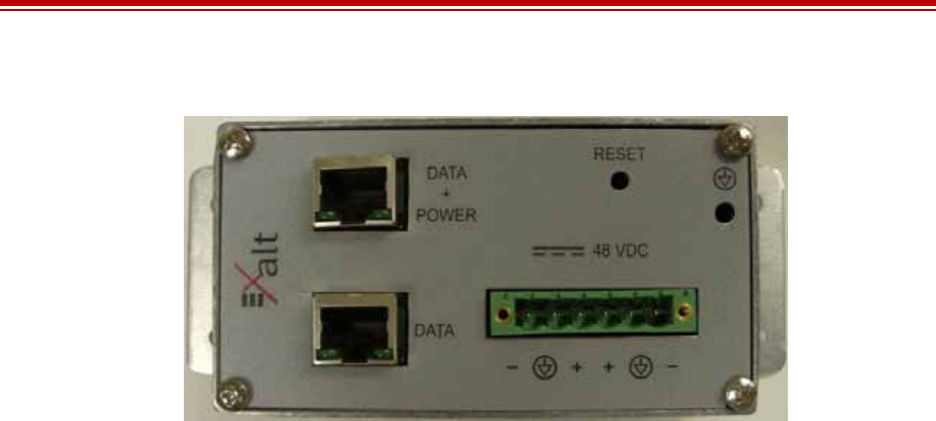
Exalt Installation and Management Guide
ExtendAir (TDD) Series Digital Microwave Radios
26 203591-011
2013-02-22
Figure 12 Power injector connectors
1Connect the network Ethernet connection to the DATA connection of the power injector.
2Connect the cable for the radio to the DATA+POWER connection of the power injector.
3Ground the power injector using the grounding receptacle. The injector can also be mount wall
using the bottom panel brackets.
CAT5e Lightning/Surge Protection
To provide for human safety and for the safety of connected network equipment, it is highly
recommended to place a weatherproof lightning suppression device at the egress point where the
CAT5e cable(s) enter the building, shelter, or cabinet.
To protect the radio equipment, install a weatherproof lightning suppression device near the radio for
all connected CAT5e cables.
For the Power/Ethernet cable, specific voltage requirements must be met. The following devices are
the only devices currently recommended:
•Polyphaser IXG-05
•Transtector ALPU 1101-959
•Transtector ALPU 1101-898
•Transtector ALPU-1000BT-R
•Transtector ALPU-EXLT
•Transtector ALPU-90v
Use a short CAT5e cable for the connection between the radio and the first arrestor. Use bulk outdoor-
rated CAT5e cable for the longer run between arrestors, and indoor- or outdoor-rated cable with a
standard CAT5e termination for the connection from the egress arrestor and power injector.
If the radio arrestor is deleted from the design, Exalt resellers can supply a longer cable with the proper
weatherproof connector for the connection from the radio to the egress arrestor.
Apply this same method for the TDM connections. There are no special requirements for lightning
arrestors. Vendors, such as Transtector and Polyphaser, offer single and multiple TDM weatherproof
arrestors. Note that each connector on the radio can carry up to 2 TDM (Time Division Multiplexing)
connections.
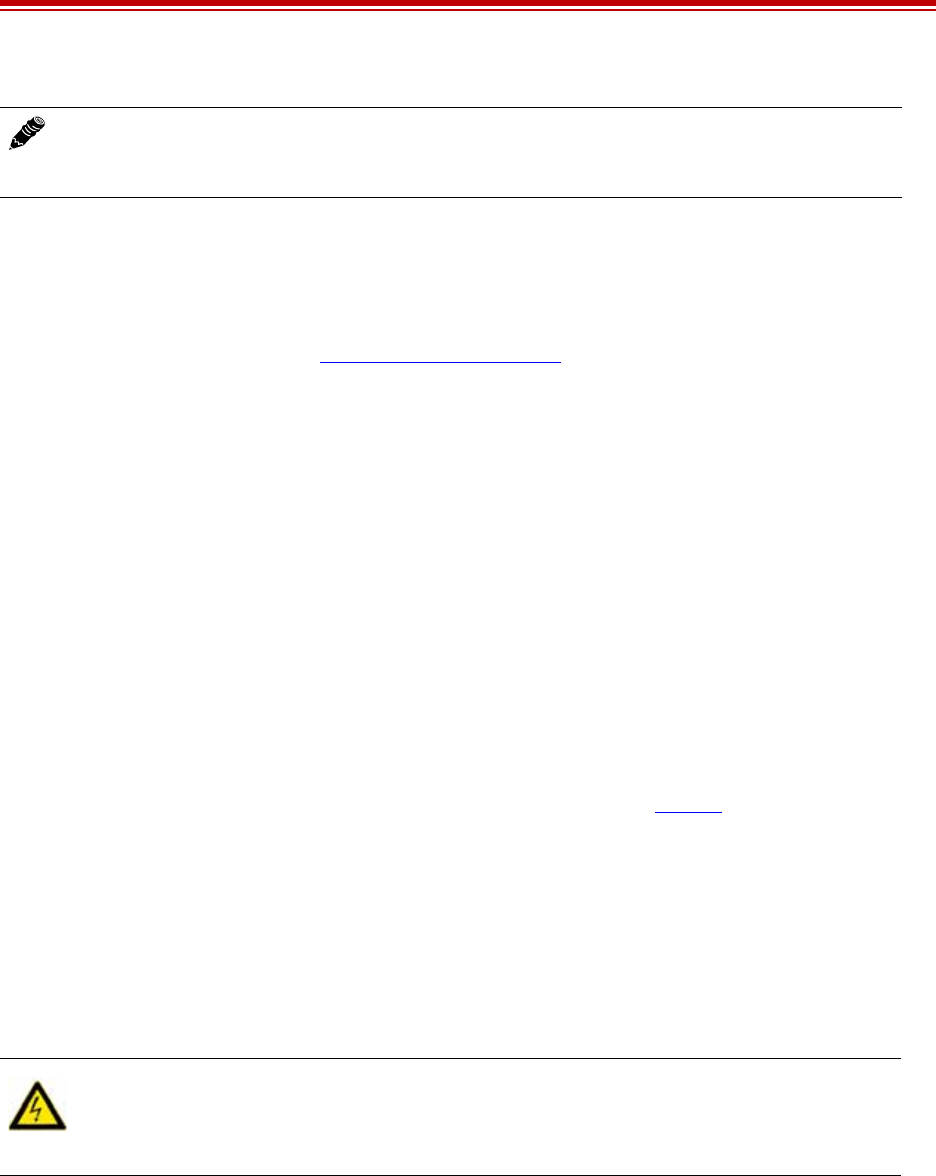
Exalt Installation and Management Guide
ExtendAir (TDD) Series Digital Microwave Radios
203591-011 27
2013-02-22
Reset to Critical Factory Settings
If necessary, the radio terminal may be reset to critical factory settings. This may be necessary if the IP
address and/or passwords for the system are not known. All other configurations are left at their
current settings. If a complete default factory configuration is desired, load the Default Configuration
File into the system, as described in System Configuration Page.
The following parameters are configured after a reset to critical factory settings:
•IP Address = 10.0.0.1
•IP Mask = 255.0.0.0
•IP Gateway = 0.0.0.0
•Administration password = password
•User password = password
•VLAN = disabled
Antenna/Transmission System
This section provides guidance to mounting and connecting the RF transmission system, which
consists of the antenna, RF cabling, and RF lightning arrestors. Consult the manufacturer’s instructions
for proper mounting, grounding, and wiring of these devices, and for definitive direction. These
manufacturer’s instructions supersede any information in this section. See Table 7 for a list of
supported antennas.
Initial Antenna Mounting (rc models)
The antenna must be an exact model recommended by the path and site planning engineer(s). Mount
the antenna at the proper height, mast/mounting location and polarization orientation as determined by
the path and site planning engineer(s). The model type, location, and orientation of the antenna is
critical with respect to achieving proper path clearance, as well as to mitigate external or self-
interference from nearby or collocated systems operating in or near the same frequency band.
The antenna structure must be secure and safe with respect to the mounting of the antenna,
transmission system weight, radio housing, and the combined weight of any personnel that may climb
or attach to the structure.
The combined weight of items and forces on the structure must be carefully considered in the design
and construction of the structure. This must include the weight bearing on the structure in the highest
wind conditions possible in the region, and with respect to all objects affixed to the structure.
If additional objects are affixed to the structure in the future, it may be important to evaluate both the
mechanical impact of these planned additions (with respect to wind and weight loading), as well as the
Note: Use only outdoor-rated UV-resistant CAT5e cable. This cable must have an outer
diameter between 0.25"/6.35 mm and 0.31"/7.87mm. Belden 1300A is recommended.
Securely hand-tighten all connectors on the ODU to ensure a weatherproof seal.
Warning! Mount the antenna in a restricted area and in a manner preventing long-term
human exposure to the transmitted RF energy. To comply with FCC and Industry Canada
regulations, the minimum safe distance from the antenna for continuous human exposure is
10'/3m.

Exalt Installation and Management Guide
ExtendAir (TDD) Series Digital Microwave Radios
28 203591-011
2013-02-22
potential impact to RF interference and frequency coordination (if additional radio equipment is
anticipated). This is especially important if future equipment is likely to operate within the same
frequency band.
Once the antenna is mounted, cabled, and aligned, your goal is to never require modification. This
prior planning is important in the path and site planning stages and in construction of the antenna
structure.
Follow the antenna manufacturer’s instructions for mechanical mounting of the antenna. Ensure that
there is enough room around the antenna for alignment activities (moving the antenna in vertical and
horizontal arcs), and for the RF transmission line to connect to the antenna connector unobstructed and
within the specified bend radius requirements of the transmission line.
At this point, the antenna mounts should be fully secure to the structure, the feed of the antenna
securely mounted to the antenna (if the feed is a separate assembly), and the azimuth and elevation
adjustments not completely tightened in preparation of the antenna alignment activity. It is a good
practice to connect the transmission line to the antenna connector as early in the process as possible, to
reduce the opportunity for debris or moisture to enter either the antenna connector or the transmission
line connector. Use a connector cover or other temporary measures to ensure that the connector is kept
clear. Take extra care if the antenna is installed during inclement weather to ensure that no moisture
gets inside the antenna connector at any time.
Now the antenna can be aimed in the general direction required for the link. Use a compass, a
reference bearing, binoculars or any other similar device to point the antenna in the direction
(generally) of the far end radio, and then slightly tighten the azimuth and elevation adjustments so that
the antenna maintains its general position and is safe to be left without additional securing. Refer to the
Exalt white paper, Antenna Alignment, for more information on antenna alignment techniques.
Transmission Line from Antenna to Radio (rc models)
Most installations use a very short length of coaxial transmission line for the connection between the
antenna and the radio device. Coaxial transmission line can either have a solid or braided shield. Solid-
shield cables are more resistant to external signal coupling and interference, but are generally stiffer
than braided cables. Consult the path or site engineer(s) to ensure that the proper materials are chosen
for the installation and that all factors were considered.
Generally, the larger the diameter of the transmission line, the lower the loss. So for longer runs of
transmission line, larger diameter cables are highly advised. However, at every frequency, there is a
maximum diameter cable that supports the operating frequency. Verify the specifications. This should
is determined in the path and site planning process.
Table 4 lists representative samples of transmission line types recommended for the Exalt Digital
Microwave Radio.
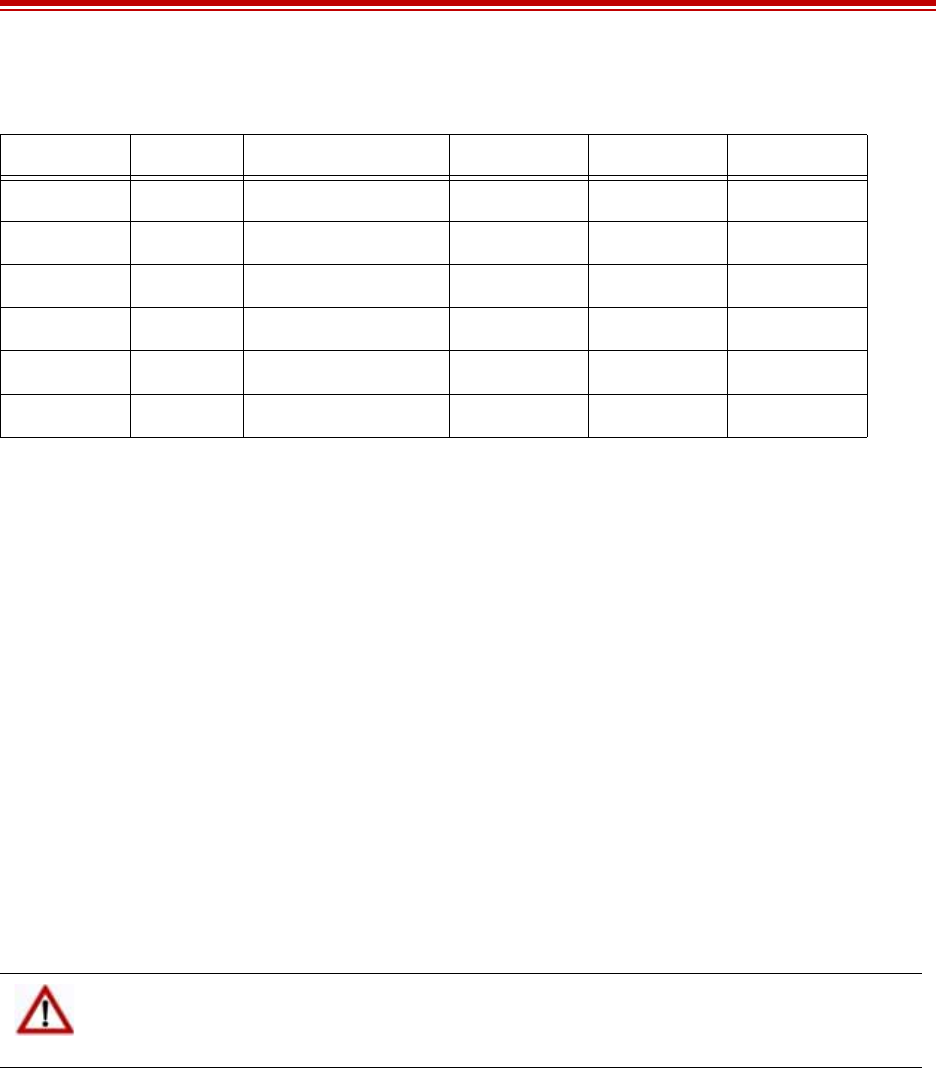
Exalt Installation and Management Guide
ExtendAir (TDD) Series Digital Microwave Radios
203591-011 29
2013-02-22
It is critical that the transmission line and antenna be capable of supporting the same type of connector,
or easily adapted. It can be important to minimize the number of connectors and adapters, and it is
ideal that they match directly without adaptation. In most cases, transmission line allows for N-type
male connectors and antennas have N-type female connectors.
If possible, connect the primary transmission line directly to the antenna. It is desired to have the
fewest possible pieces of transmission line in the system, to minimize losses and points of failure from
connectors. The antenna can typically accommodate a direct connection if planned in advance. Use a
90º adapter for the connection to the antenna, if necessary, but confirm that all connectors and
transmission lines are properly specified for the operating frequency with minimum loss, proper
impedance (50 Ohm) and proper VSWR characteristics.
Transmission line connector termination is a critical element of the installation. Many ‘factory built’
RF transmission lines do not provide the proper characteristics for proper transmission, despite their
published specifications, often due to the fully or semi-automated process of factory termination,
which may not have considered the frequency of your system. When buying pre-terminated
transmission line, it is strongly advised to obtain the documentation of test measurements on the
connected transmission line showing that the loss characteristics and VSWR are within the specified
limits specifically at your operating frequency. In addition to factory-built transmission line, self-
terminated transmission line can suffer the same issues.
The manufacturers of transmission line typically offer instruction and certification for transmission
line termination, and may also provide videos illustrating the process. There is no amount of extra care,
education, precision, and effort that can be overstated for this process.
There is often a need for a small excess of transmission line near the antenna to accommodate both the
need for extra slack as the antenna is loosened and moved for the alignment process, and to
accommodate a drip loop for the transmission line and the initial transmission line securing hardware
and grounding near the antenna. In addition, the transmission line is typically very stiff, and can
provide undue pulling force on the antenna or radio connector. Take care to align the cable with the
connector so that it does not provide any torque or strain on the connector.
Consult your transmission line manufacturer for the proper transportation, hoisting, securing, and
grounding process. Always be very mindful of the entire length of transmission line to ensure that the
transmission line is never twisted, kinked, or over-bent beyond the specified bend radius. Once a
Table 4 Recommended transmission line
Manufacturer Type Description Loss at 4.9GHz Loss at 5.3GHz Loss at 5.8GHz
Andrew LDF4-50 1/2-inch solid shield 5.6dB/100' 5.7dB/100' 6.0dB/100'
Andrew LDF4.5-50 5/8-inch solid shield N/A 4.4dB/100' 4.7dB/100'
Times LMR-600 1/2-inch braided shield 6.8dB/100' 6.9dB/100' 7.3dB/100'
Times LMR-900 5/8-inch braided shield N/A 4.6dB/100' 4.9dB/100'
RFS LCF12-50J 1/2-inch solid shield 5.5dB/100' 5.6dB/100' 5.9dB/100'
RFS LCF12-58J 5/8-inch solid shield N/A 4.5dB/100' 4.8dB/100'
Caution: Always follow the manufacturer’s termination process EXACTLY, and only use the
manufacturer’s authorized tools and connectors for a given transmission line type.

Exalt Installation and Management Guide
ExtendAir (TDD) Series Digital Microwave Radios
30 203591-011
2013-02-22
transmission line is over-bent or kinked, it will likely never recover its specified characteristics, even
after straightening, and will often be completely unusable.
The opposite end of this primary transmission line typically terminates at the radio connector. If using
a long transmission line (in excess of 3'/1m), an RF lightning arrestor is recommended to protect the
radio equipment.
As soon as practical, weatherproof the connected ends of the transmission line to the antenna and
lightning arrestor and radio. This process should be delayed as long as possible to ensure that all
systems are working properly before applying the weatherproofing. Once weatherproofing is applied,
it may have to be removed for testing or installation modification. With this in mind, if the installation
is occurring during inclement weather, take extra care at all times to ensure that no moisture enters any
connector at any time. If moisture is suspected to have compromised the antenna or transmission line,
it may render those devices useless without any means for remedy except for full replacement.
Cap and weatherproof the second antenna connector on the radio if using a single-polarity antenna.
Indoor Mounting
On rare occasions the antenna can be mounted indoors behind a window. In these cases, there would
not be a need for drip loops or an RF lightning arrestor. Use a very short transmission line connected
directly between the antenna and the radio mounted nearby. The weatherproofing process can also be
omitted.
RF Lightning Arrestor
RF lightning arrestors provide a direct path to ground for lightning strikes that may couple to or
directly hit the outdoor transmission system or antenna structure. The RF lightning arrestor prevents
any associated voltage and current from entering the radio equipment, other equipment, or humans.
The following lightning arrestors are examples of proper devices for Exalt Digital Microwave Radios:
•Polyphaser AL-LSXM
•Citel PRC5800
Mount and ground the RF lightning arrestor in accordance to the manufacturer’s recommendations.
Place it as close as possible to the radio equipment. Minimize the distance to the radio to lessen the
opportunity for lightning to couple to or strike the unprotected section of transmission line (if any).
Consult a qualified electrician or installer in all cases of grounding and lightning arrestor
implementation.
Antenna Alignment
Antennas must be installed at both ends of the planned link to commence precision alignment. Refer to
the Exalt white paper, Antenna Alignment. The ExtendAir (TDD) Series radios have an integrated
antenna.
Antennas are typically aligned using the radio hardware for precise alignment. However, there are
many very useful tools available to aid in this process, inclusive of devices specifically designed for
the purpose of aligning antennas. Some examples are:
•XL Microwave Path Align-R
•Teletronics 17-402
Use of these devices may be extremely advantageous as compared to using the radio, because they
employ many unique facilities to aid in this process. Using these tools also makes it possible to align
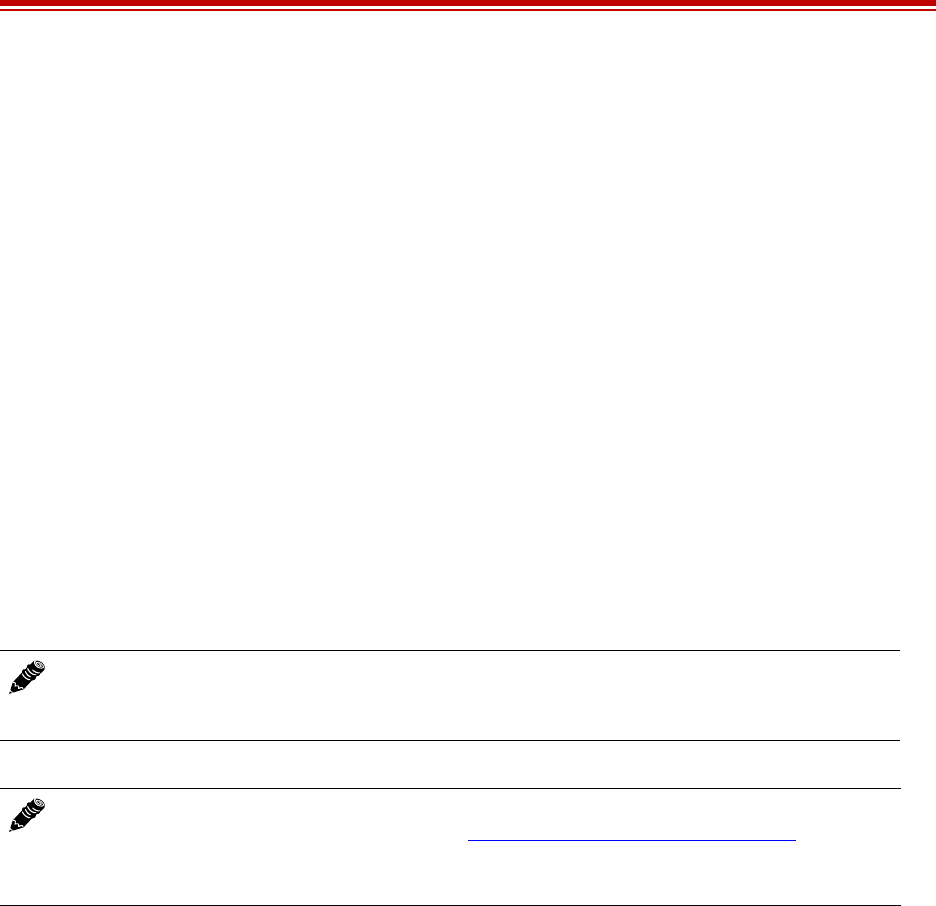
Exalt Installation and Management Guide
ExtendAir (TDD) Series Digital Microwave Radios
203591-011 31
2013-02-22
the antennas before the radio equipment is delivered. However, many installers successfully use the
radios as the means for antenna alignment.
The following are the primary facilities when using the radio to align the antenna:
•RSL voltage connection using a volt meter (recommended)
Insert the included adapter into the GPS connector on the radio housing and the opposite end
connected to a volt meter.
The RSL test point DC voltage is inversely proportional and numerically calibrated to the received
signal level. The voltage rises as the antennas are less in alignment, and falls as antennas are more
in alignment. The voltage measurement corresponds to the received signal level in measurements
of dBm (a negative number for RSL measurements). For example, an RSL of -60dBm yields an
RSL voltage measurement of 0.60VDC; an RSL of –45dBm measures 0.45VDC.
•Audio alignment buzzer
Enable the audio alignment buzzer through the Exalt GUI. When enabled, the radio enclosure
emits a sound. The pitch rises when higher (better) levels of RSL are achieved. Align the antennas
until the highest pitch is accomplished. The tone is continuous when the two ends of the radio
system are in communication. Otherwise, the buzzer beeps.
•Exalt GUI RSL reading indicates the current RSL in dBm.
Note: There is a slight delay in RSL readings in the GUI as the RSL levels change. In this
case, fine alignment can be done in small adjustments allowing a small gap of time so that the
impact of the adjustment on the GUI display catches up to real time.
Note: Only use the browser-based GUI for antenna alignment if there are no other means
available. If this method is required, refer to Exalt Graphical User Interface (GUI). The RSL
reading can be read on a PC or any handheld computing device that supports an HTML
browser and Ethernet connectivity.
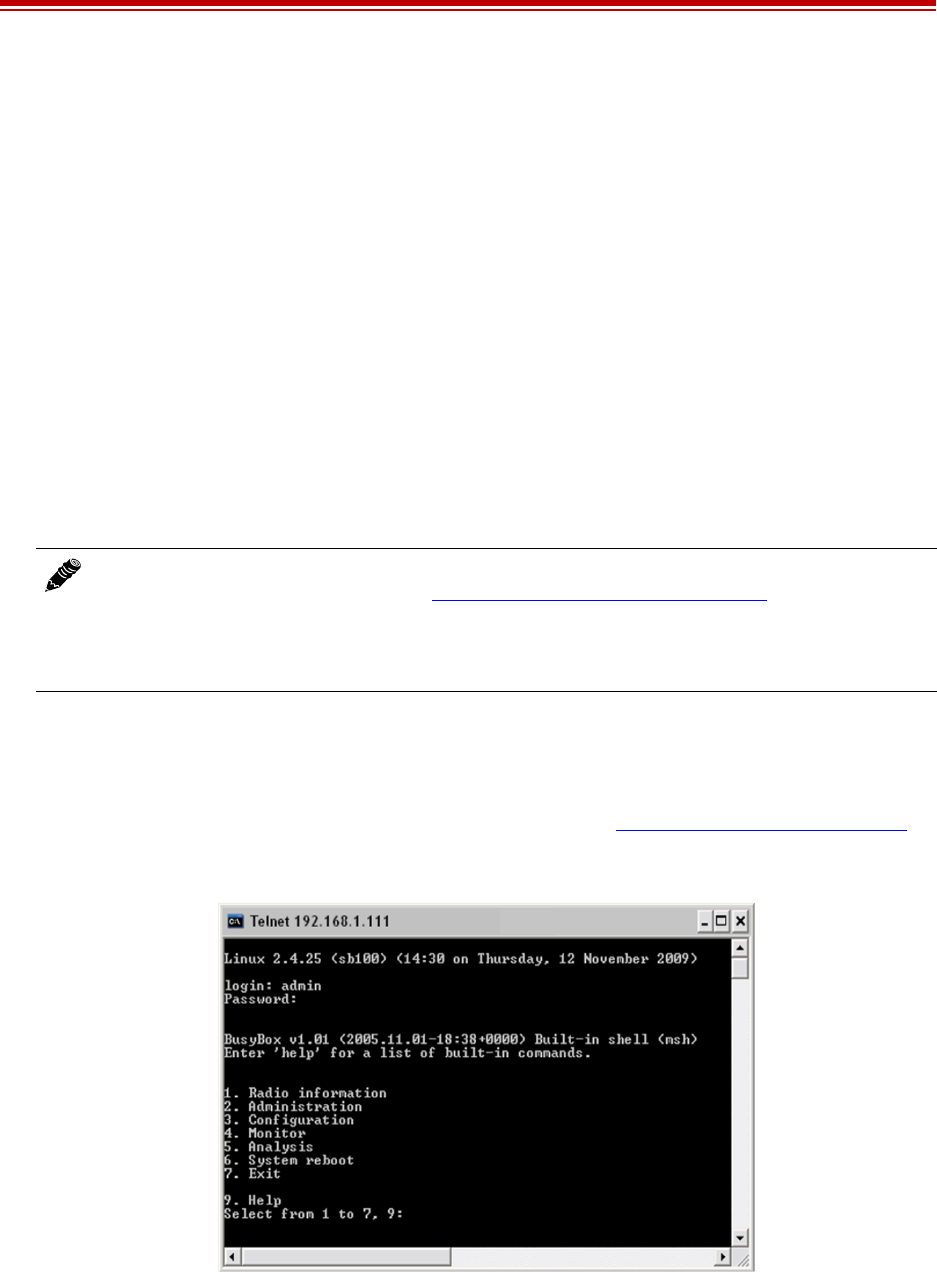
Exalt Installation and Management Guide
ExtendAir (TDD) Series Digital Microwave Radios
32 203591-011
2013-02-22
Configuration and Management
This section describes the command line interface (CLI) and Exalt graphical user interface (GUI).
Telnet into the Command Line Interface (CLI)
Use a Telnet connection to access the CLI in the Exalt Digital Microwave Radios. Use the CLI to set
key parameters on the system.
Connect to the Radio in a Telnet Session
Make the Telnet connection to the radio through the Ethernet port. Use Windows and perform the
following steps:
1Open a command prompt or MS-DOS prompt (Start>Run).
2Type C:\>Telnet <IP Address> at the command line:
The default IP address is 10.0.0.1
Telnet
Use Telnet when prompted to enter the administration level login and password. The default
administration login is admin and password is password. It is recommended that the default
administration password be reset by performing a radio reset (see Reset to Critical Factory Settings).
Figure 13 shows the three menu choices available after log in.
Figure 13 CLI main menu
The following selections can be made on all screens:
•0 = back to previous screen
Note: The accessing computer must be on the same IP subnet as the radio. If the radio has
DHCP enabled on the PoE port (see Ethernet Interface Configuration Page), which is the
default setting for a radio shipped from Exalt, and your computer's Ethernet port is set for
DHCP addressing, the radio will configure your computer to 10.0.0.2, and no manual IP
configuration is required for your computer.

Exalt Installation and Management Guide
ExtendAir (TDD) Series Digital Microwave Radios
203591-011 33
2013-02-22
•9 = help
•Ctrl+\ (control and backslash keys) = exit session
Exalt Graphical User Interface (GUI)
The Exalt GUI is the primary user interface for configuring and troubleshooting the radio and radio
system. A computer or hand-held device with a conventional HTML browser and Ethernet port is
required. Microsoft Internet Explorer is the preferred browser. Firefox, Chrome and Safari are also
supported.
Preparing to Connect
If the radios are new, both radios are preconfigured as Radio B, and have the same IP address. The
initial priority is to configure one radio to Radio A and assign different IP addresses, unique to each
radio. There are two ways to change the IP address:
1Reset the radio to the critical default factory settings (see Radio Reset).
2Connect to the GUI using the default IP address (10.0.0.1), and change the IP address through the
GUI interface.
To configure a radio as Radio A, connect to the GUI and change the configuration, as discussed in this
section.
Make Connections
It is recommended that one radio at a time be configured, on a bench, before taking the radios to the
field for installation:
•(rc models only) Terminate the RF connector with a 50-Ohm termination or a fixed attenuator of at
least 20dB (see Power).
Once connected to the radio using Ethernet, log in to the Exalt GUI.
Note: To connect to the radio’s Ethernet port and use the GUI interface, the accessing
computer must match the radio’s IP address subnet. It is therefore necessary to either change
the radio’s IP address through the CLI to match the subnet of the computer, or change the
computer’s IP address to match the subnet of the radio (such as, a computer IP address of
10.0.0.10 if trying to connect to a radio set to the factory default IP address of 10.0.0.1).
If the radio has DHCP enabled on the PoE port (see Ethernet Interface Configuration Page),
which is the default setting for a radio shipped from Exalt, and your computer's Ethernet port is
set for DHCP addressing, the radio will configure your computer to 10.0.0.3, and no manual IP
configuration is required for your computer.
Note: Do not connect the radios in a back-to-back configuration. If the radios are set to their
factory default settings, both radios are configured as Radio B and cannot communicate. Both
radios also have the same IP address, which causes IP address conflicts
Note: The IP address subnet of the accessing computer must match the radio’s IP address
subnet to connect using Ethernet.
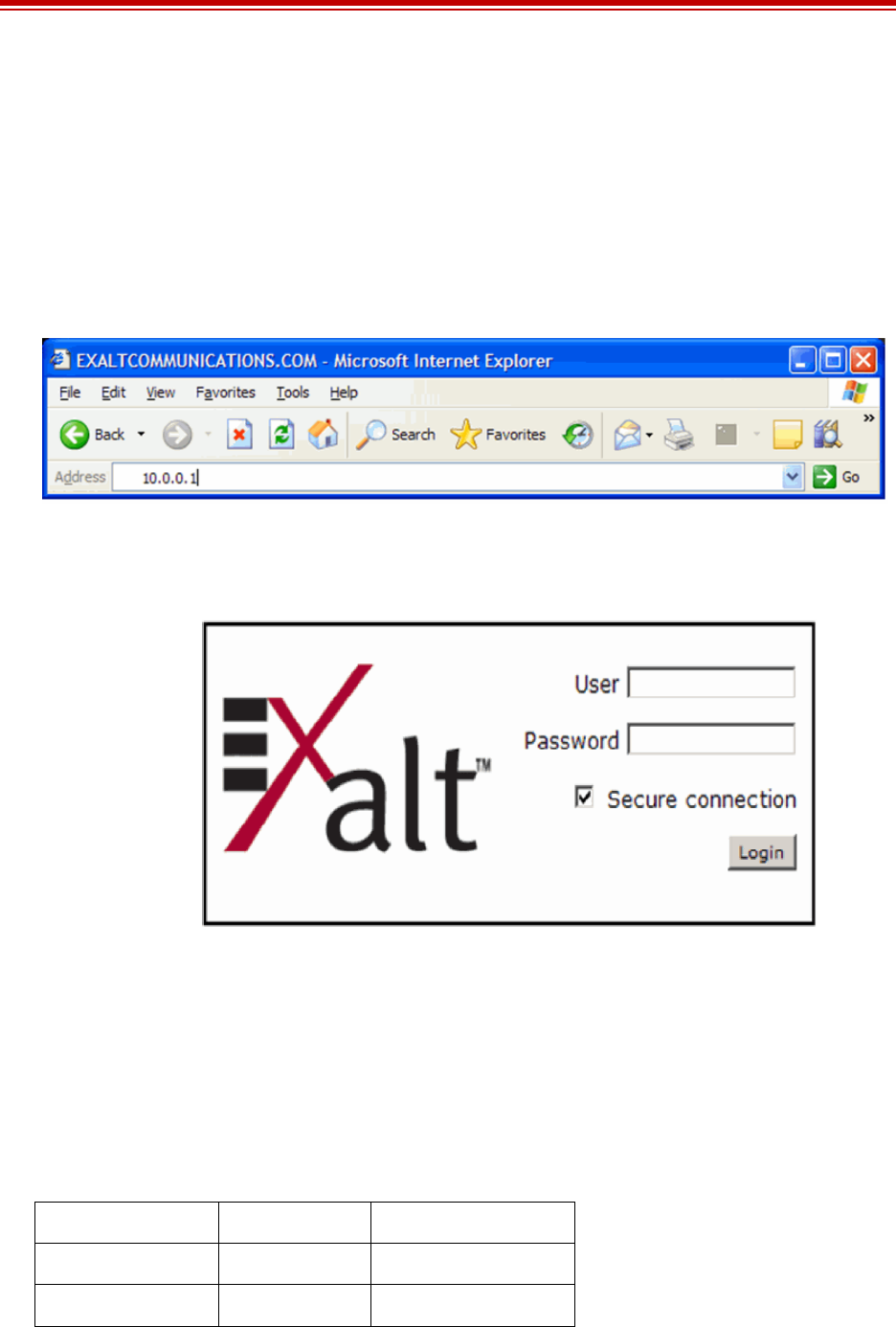
Exalt Installation and Management Guide
ExtendAir (TDD) Series Digital Microwave Radios
34 203591-011
2013-02-22
Log In
Use the following steps to log in to the Exalt GUI.
1Open a browser window.
Microsoft Internet Explorer is the recommended browser. Netscape, Mozilla, and Firefox are also
supported. If there are issues with your browser, please report it to Exalt Customer Care. You may
be required to use a different browser to immediately overcome issues.
2Type the IP address of the radio in the address bar.
Figure 14 Initiating the browser connection
The following window displays after pressing the Enter key or clicking the Go button in the
browser window.
Figure 15 Browser Login screen
Login Privileges
There are two levels of login privileges:
•Administrator (admin) – assigned complete permissions to view, edit, and configure
•User (user) – assigned limited, view-only permissions with no edit or configuration rights
The default login names and passwords are as follows:
Table 5 Default login information
Privilege level User name Default password
Administrator admin password
User user password
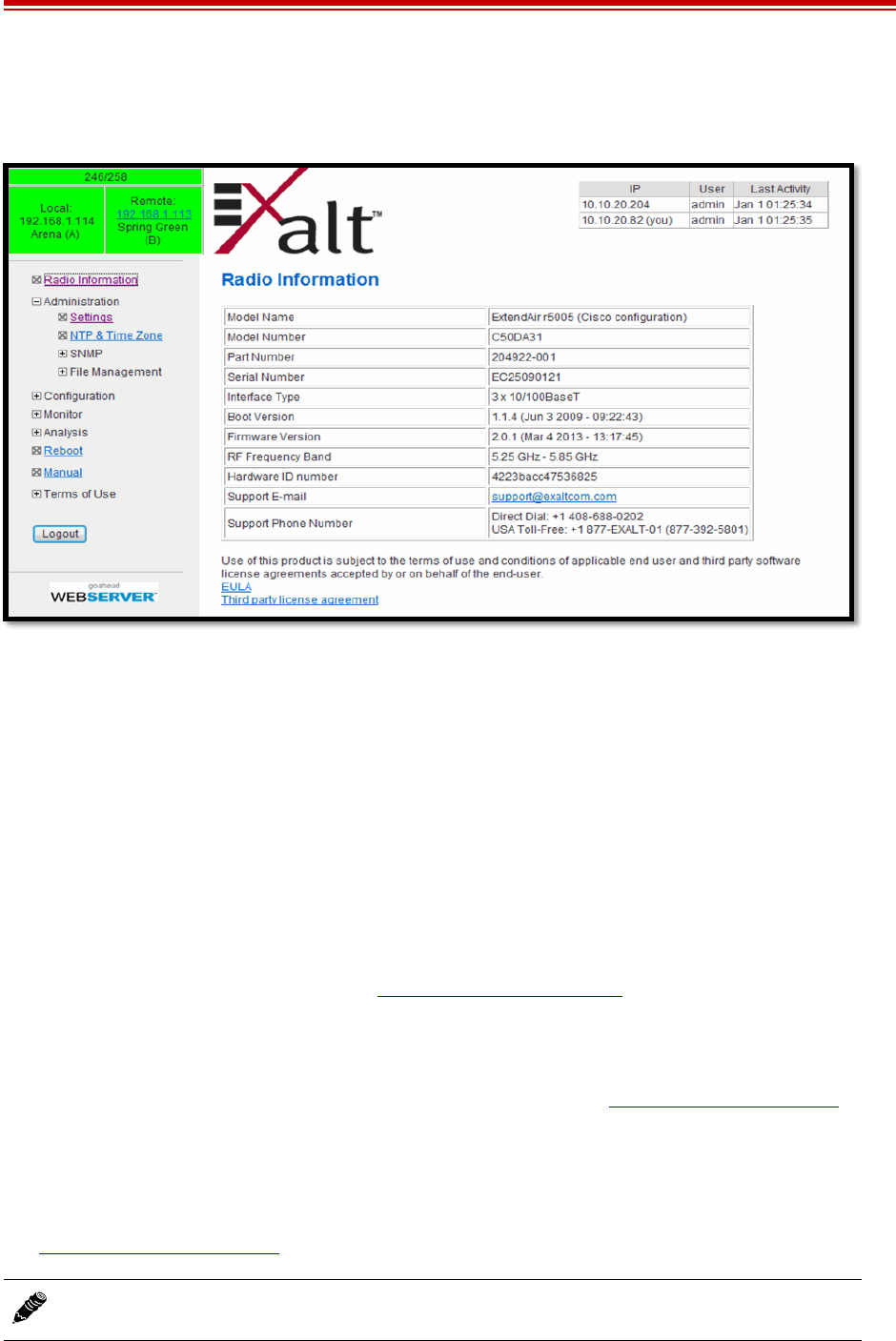
Exalt Installation and Management Guide
ExtendAir (TDD) Series Digital Microwave Radios
203591-011 35
2013-02-22
Administrator login credentials are required for configuration purposes. Type the user name and
passwords for Administrator level and click OK. The following screen displays.
Figure 16 Radio Information page
Quick Start
To establish a link on the bench, apply the following basic configurations to the radio terminal. Use the
steps in the Quick Start Guide included with the radio. A summary of the items that need to be
configured are:
•Radio IP address for each end.
– Each end must have a different IP address and cannot match the accessing computer’s IP
address or any address assigned if radios are part of a larger network.
– It may be required to change the IP address of the accessing computer after changing the IP
address of the radio so that the IP subnet matches.
– The radio IP address is listed on the Administration Settings Page.
•Set one radio as Radio A.
– The radio selected as Radio A must be configured.
– Radio A/B selection is the Endpoint Identifier parameter on the System Configuration Page.
– Even though both radios are set as Radio B by default, confirm this configuration on the radio
intended to be Radio B.
If all other parameters are still configured at their factory default settings, the radios can now be
connected back-to-back to verify that the link is communicating and perform any other desired tests.
See Back-to-back Bench Testing for test information.
Note: Click the Update button to save changes on any page. Also on all pages until saved,
changed fields display with an orange background.
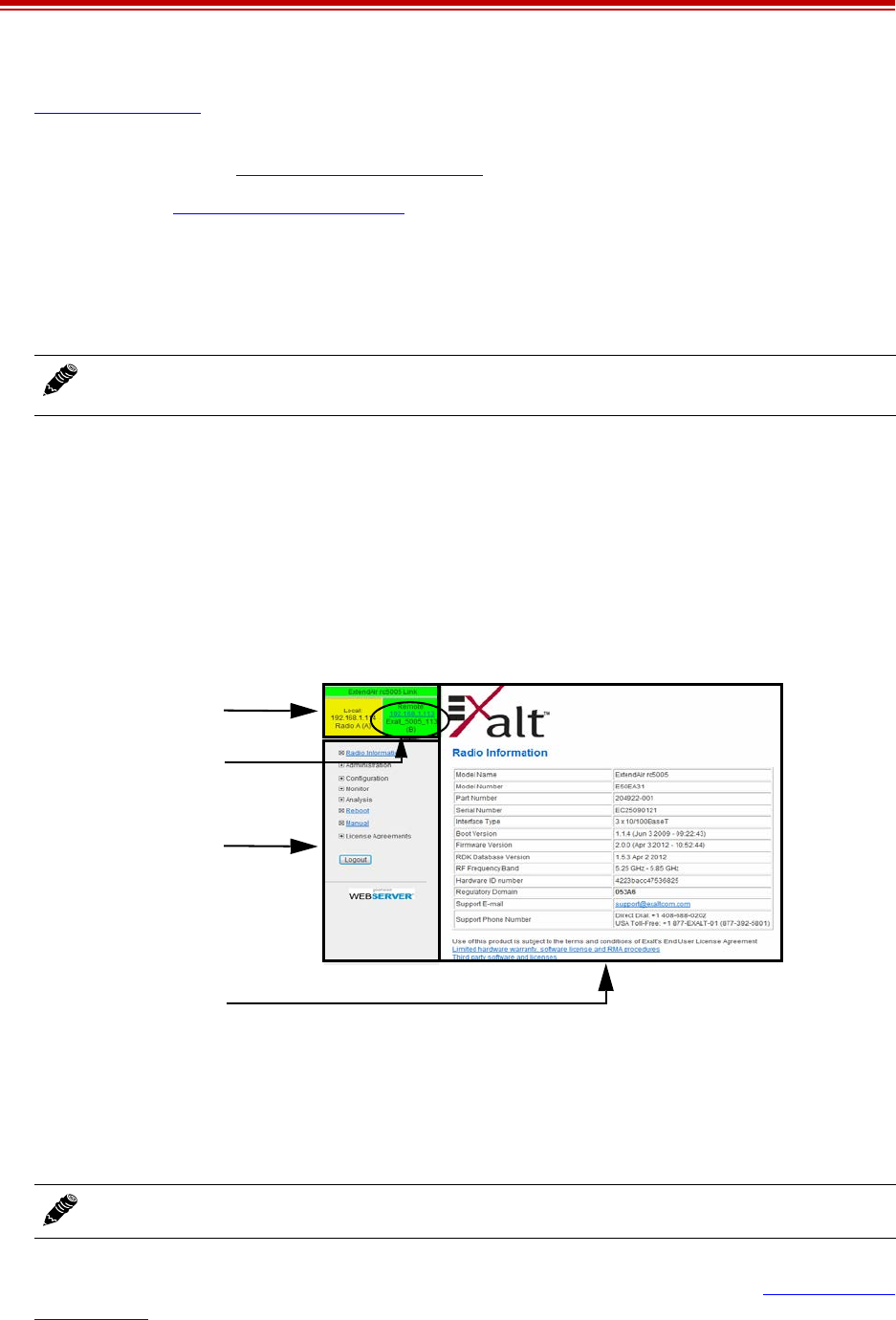
Exalt Installation and Management Guide
ExtendAir (TDD) Series Digital Microwave Radios
36 203591-011
2013-02-22
Navigating the GUI describes each page of the GUI. Most configuration parameter settings are
intuitive. The following link parameters must match at both ends for the link to communicate:
•Link Security Key (Administration Settings Page)
•Bandwidth (System Configuration Page)
•RF Frequency (System Configuration page)
•Link Distance (System Configuration page)
•TDD Frame Size (System Configuration page)
Navigating the GUI
The GUI provides the primary interface for all configuration and management. There are three sections
of the main GUI window:
•Summary status information section (upper-left corner)
•Navigation panel
•Main window
Figure 17 Exalt GUI window description
Summary Status Section
This section of the Exalt GUI provides a review of the system status.
In the screens in Figure 17, the top bar illustrates the alarm condition of the link. The information
inside the bar is equivalent to the entry of the Link Name set by the administrator in the Administration
Settings Page.
The color of the panel indicates alarm status:
Note: Changing any of these parameters causes a temporary loss of link. The GUI displays a
warning and provides an opportunity to cancel changes.
Click the radio IP address link to access that radio for management.
SUMMARY STATUS
NAVIGATION PANE
MAIN WINDOW
LINK TO
REMOTE RADIO
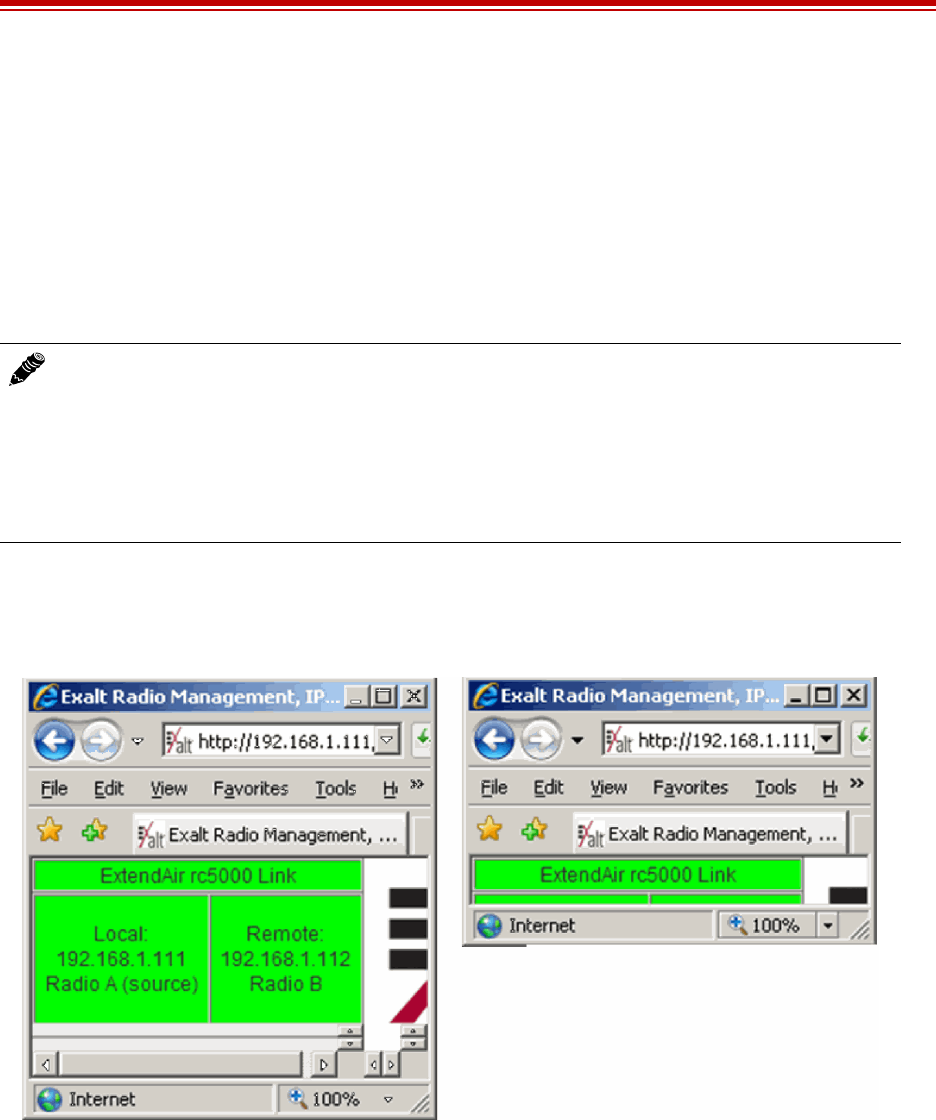
Exalt Installation and Management Guide
ExtendAir (TDD) Series Digital Microwave Radios
203591-011 37
2013-02-22
•Green indicates the system is communicating and all functions are normal
•Yellow indicates a minor non-traffic affecting alarm condition
•Red indicates a major traffic affecting alarm condition
The left panel summarizes the alarm conditions of the local radio (the radio that matches the IP
address). The information displayed is the IP address and the endpoint identifier (Radio A or Radio B).
The right panel summarizes the alarm conditions of the remote radio (the radio linked to the local
radio).
The Summary Status Section allows the Exalt GUI to be a rudimentary management system. Minimize
the browser window to display just the top bar or the top bar and radio information, and open several
browsers on the desktop. When a window status changes to yellow or red, you can quickly maximize
that window to determine the issues.
Figure 18 Summary status information
Navigation Panel
In the navigation panel, pages with sub-pages have a plus (+) to the left of the page link. Click the plus
sign or page name title to view sub-page titles. The pages can be collapsed to hide the sub-pages when
a minus (–) sign appears to the left of the page link.
Management pages are indicated with an X to the left of the page name. Click the X or page name to
display the page within the main window.
Note: The ‘local’ radio might be the near-end or the far-end radio, depending on
the management interface connection. The terms local and remote refer to the orientation of
the radio terminals relative to the IP address you are managing. When making certain changes
to a near-end radio without first making changes to the far-end radio, the link may become
disconnected unless configuration changes are reverted to their original settings. When
making changes that may disrupt the link, always change the far-end radio first, and
then the near-end radio to match.

Exalt Installation and Management Guide
ExtendAir (TDD) Series Digital Microwave Radios
38 203591-011
2013-02-22
Note: The ‘local’ radio might be the near-end or the far-end radio, depending on the
management interface connection. The terms local and remote refer to the orientation of the
radio terminals relative to the IP address you are managing. When making certain changes to
a near-end radio without first making changes to the far-end radio, the link may become
disconnected unless configuration changes are reverted to their original settings. When
making changes that may disrupt the link, always change the far-end radio first, and
then the near-end radio to match.
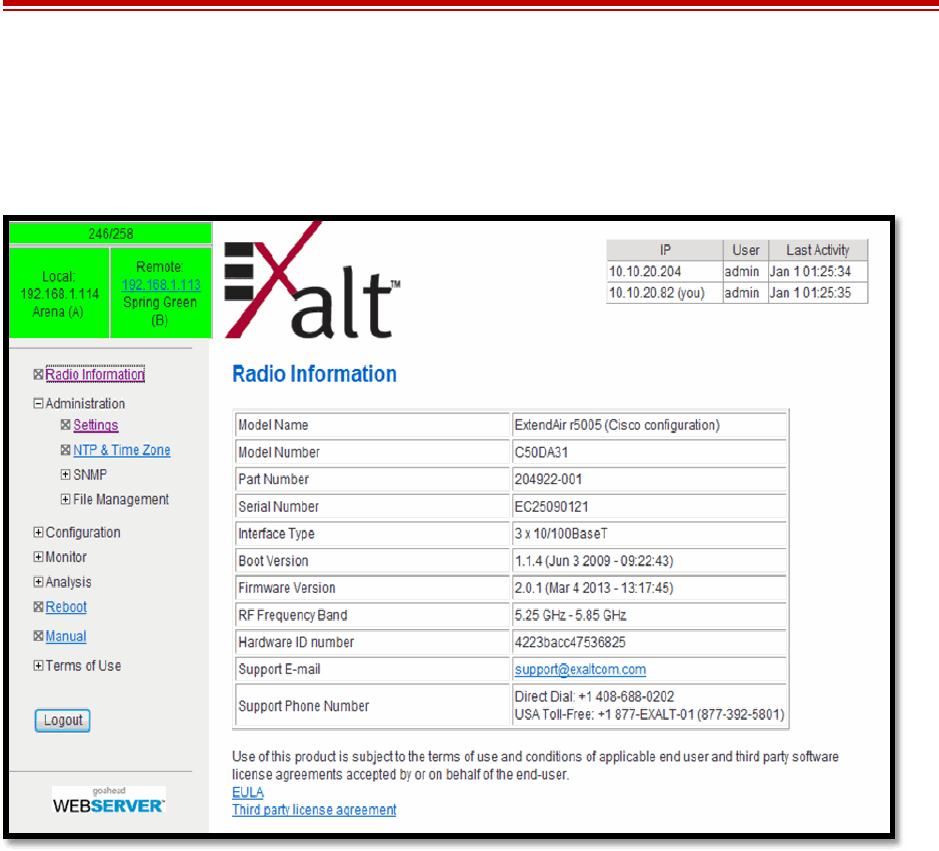
Exalt Installation and Management Guide
ExtendAir (TDD) Series Digital Microwave Radios
203591-011 39
2013-02-22
Radio Information Page
This page provides general information about the local radio terminal. This information is helpful for
troubleshooting and for record keeping.
Figure 19 Radio Information page
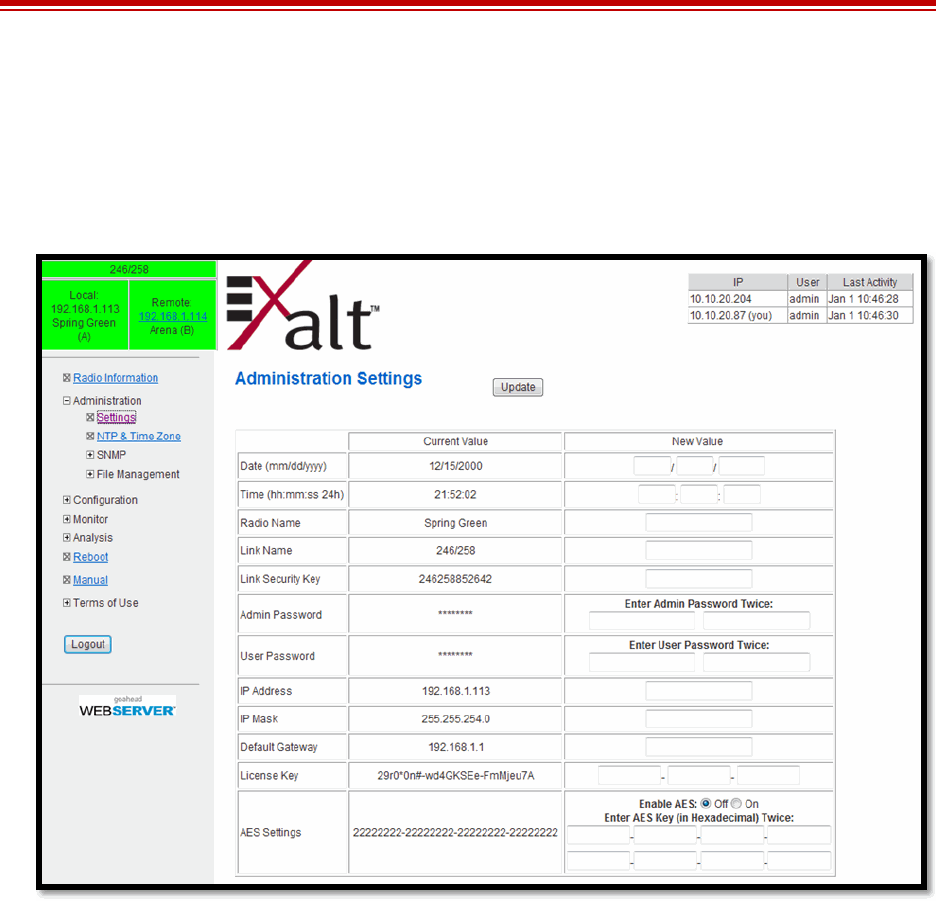
Exalt Installation and Management Guide
ExtendAir (TDD) Series Digital Microwave Radios
40 203591-011
2013-02-22
Administration Settings Page
This page allows contains general parameters for the radio system. The Current Value column lists
entries actual settings. Desired changes are entered in the New Value column.
After all desired changes are entered, click the Update button to accept and enable changes.
Figure 20 Administration Settings page
Most entries on this page are self-explanatory. The following lists unique or important parameters.
•Fill in the date and time fields as soon as practical. Events are captured with time/date stamps,
which is valuable information for troubleshooting.
•Set the Link Security Key to something other than the factory default setting (12 characters, all
zeros) at each end. The link security key must match at both sides of the link. If the security key
remains at the factory setting, the radio link is open to sabotage by a party with the same radio
model. Each link should have a unique security key. If using the same security key for every link
in the network, the radio could link to any other radio with the same security key. This is
problematic in multi-radio networks.
– Note that the security key must be exactly 12 characters. Any printable ASCII character can be
used. The link security key is case sensitive.

Exalt Installation and Management Guide
ExtendAir (TDD) Series Digital Microwave Radios
203591-011 41
2013-02-22
– Reset the admin and user passwords. These passwords should not match. If the admin
password remains at the factory default setting, it provides an opportunity for random
reassignment by a network-connected user.
– The new password must be entered twice. If the passwords do not match and the Update
button clicked, the password is not changed and remains set to the previous password.
•Enter the license key provided by Exalt to access extended features or diagnostic capabilities.
Click Update to accept the changes and enable the new features. License keys are issued by radio
serial number, so ensure that the license key used was issued for this particular radio.
•AES Advance Encryption Standard) can be implemented to provide additional data security for the
wireless link. This function requires an upgrade license key (purchased separately). Both radios in
the link must have a valid AES upgrade license key to implement AES. Different bit-length
encryption license keys (for example, 128-bit and 256-bit) are also available, depending on model
type. If the required upgrade license key is present, simply insert a matching ASCII string on both
terminals and select the Enable AES On option for AES encryption. Note that similar to the
administration and user passwords, the AES string must be entered twice for each terminal.
Note: Changing the link security key interrupts transmission until the opposite end is changed
to match. Always change the far-end radio first, and then change the near-end
radio.
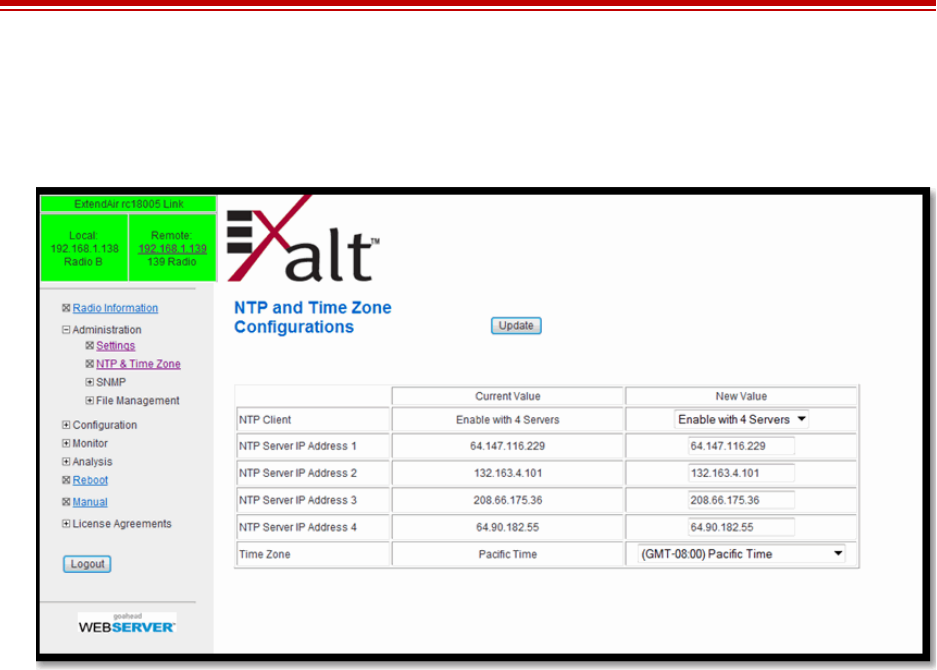
Exalt Installation and Management Guide
ExtendAir (TDD) Series Digital Microwave Radios
42 203591-011
2013-02-22
NTP and Time Zones Configurations Page
Use this page to set the Network Time Protocol (NTP), number of NTP client(s), and local time zone.
Figure 21 NTP and Time Zones Configurations page
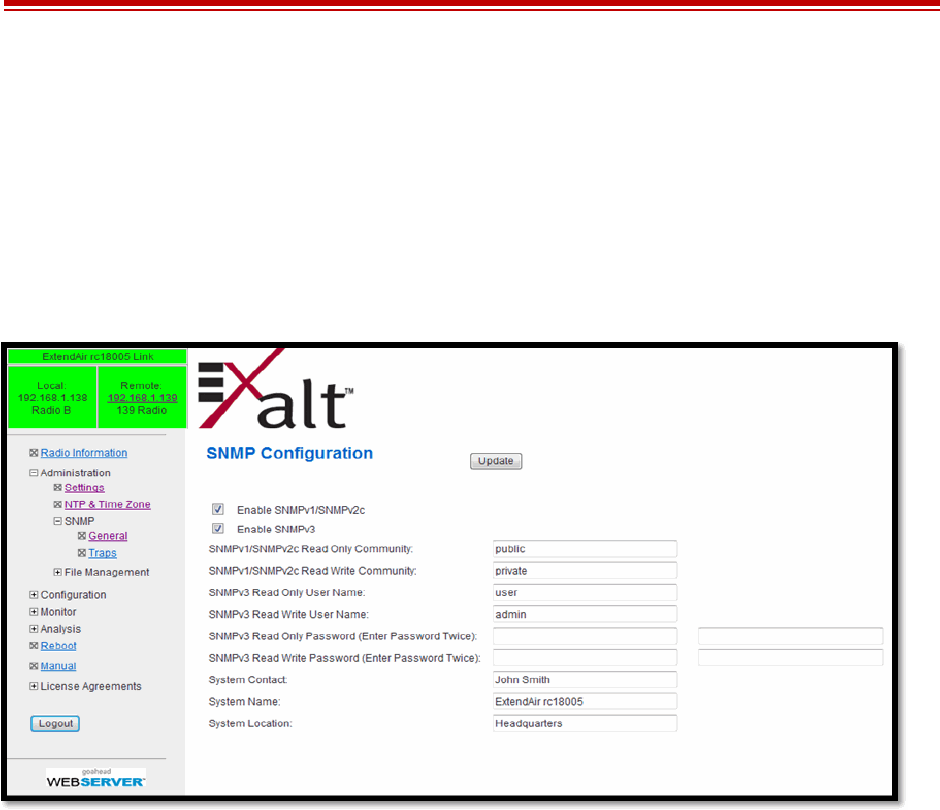
Exalt Installation and Management Guide
ExtendAir (TDD) Series Digital Microwave Radios
203591-011 43
2013-02-22
Simple Network Management Protocol (SNMP) Configuration
Use SNMP to manage networked devices and execute the following functions:
•GET: Obtain information from the device, such as a configuration setting or parameter.
•SET: Change a configuration setting on the device.
•TRAP: The device proactively informs the management station of a change of state, usually used
for critical alarms or warnings.
Figure 22 SNMP Configuration page
One feature of the SNMP implementation is that system configuration changes do not take effect using
the SET command. Instead, groups of configuration settings can be preconfigured for global change,
and a single ‘Save’ (Commit) command implements all changes.
When some parameters are changed, a link may drop and/or management control lost. MIB files allow
many parameters to be set at once, allowing only a temporarily dropped link or management control
issue. The opposite end radio can be quickly reconfigured, with little downtime for the link and
management control. The save (Commit) command is similar to the Update button.
Dropped links or management control issues do not occur with every parameter change. Many
configuration changes do not impact traffic or management access.
ExtendAir radios utilize SNMPv3, a high security version of SNMP, to ensure secure access to and
storing of management data. The SNMPv3 security string matches the admin and user passwords.
Passwords must be eight characters or longer.
The SNMP MIBs are organized similar to the GUI. Become familiar with the GUI before using the
SNMP function.
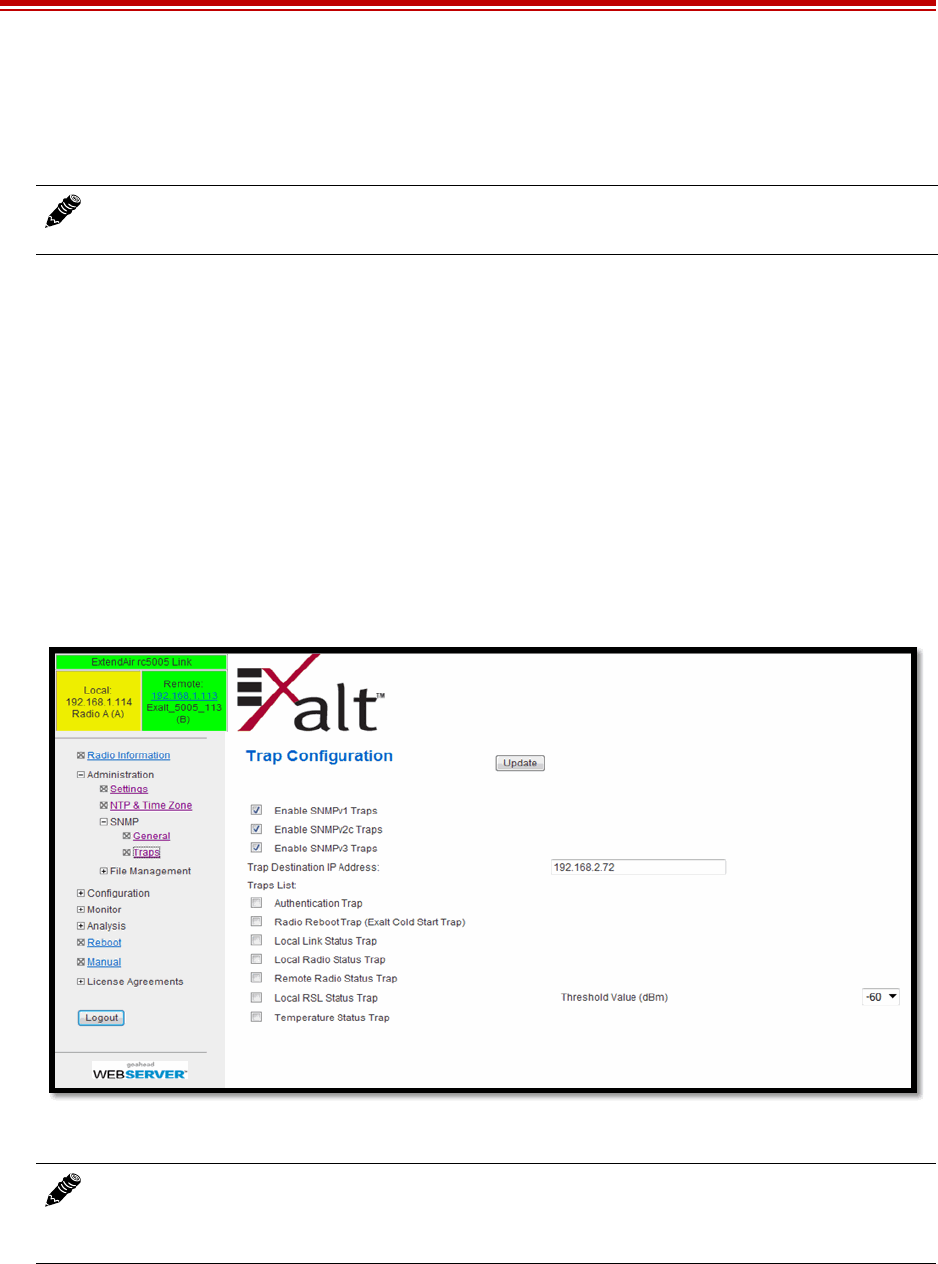
Exalt Installation and Management Guide
ExtendAir (TDD) Series Digital Microwave Radios
44 203591-011
2013-02-22
SNMP v1/v2c/v3 Support Options
Enable the SNMPv1/v2c options to allow entering read and read/write community strings.
Enable the SNMPv3 options to allow entering read and read/write user names and passwords. These
entries are de-coupled from the standard radio user names and passwords. SNMPv3 provides full
management security.
SNMP Traps
SNMP traps alert the central network management system with important issues about the radio
system. Trap filters are set on the Traps Configuration page (). Not all i-Series radios support SNMP
traps. Consult the release notes for more information.
Trap support for all versions of SNMP are provided and can be independently enabled. Enter the IP
address to which the traps are directed in the Trap Destination IP Address field. The AUX port (or the
MAIN port when using in-band management) must be connected to the network to allow trap
information to reach the designated IP address. In a bridged network, this may not require special
network settings. In a routed network, the connected router must have a defined path for the IP address.
Figure 23 Trap Configuration page
The following traps are available:
•Authentication Trap: This is an SNMP standard trap when password information for SNMP is
incorrect. This can help identify unwanted intrusions into the management system and for
diagnosis of SNMP issues for valid users.
Note: Users are encouraged to avoid enabling SNMPv1/V2c support due to known security
loopholes in these protocols.
Note: The Update button must be clicked to save any changes to this page.

Exalt Installation and Management Guide
ExtendAir (TDD) Series Digital Microwave Radios
203591-011 45
2013-02-22
•Radio Reboot Trap: This trap is sent after any radio reboot to inform the manager of the reboot
status.
•Local/Remote Link Status Trap: This trap is sent when Link is in errored state (equivalent to the
Link LED on the radio front panel or the Link status bar in the upper-left of the Exalt GUI
window).
•Local/Remote Status Trap: This trap is sent when Status is in errored state (equivalent to the Status
LED on the front panel or the radio status box in the upper-left of the Exalt GUI window).
•Local RSL Status Trap: This trap is sent when the local RSL drops below the value set in the
Threshold Value (dBm) field. Buffers are provided so that continuous traps are not sent if the RSL
is bouncing near the set threshold value. This trap is reset only if the RSL rises to 3dBm above the
set threshold value and then drops below that value. Exalt recommends that this trap be set to a
value 5dBm or 10dBm above the threshold as a warning that the system has faded and may be
approaching an outage.
•Temperature Status Trap: This trap is sent when the internal temperature reaches the warning
point. This conveys that the external temperature control is in a fault state. Buffers are applied to
this trap to avoid multiple traps when the temperature remains near the warning point.
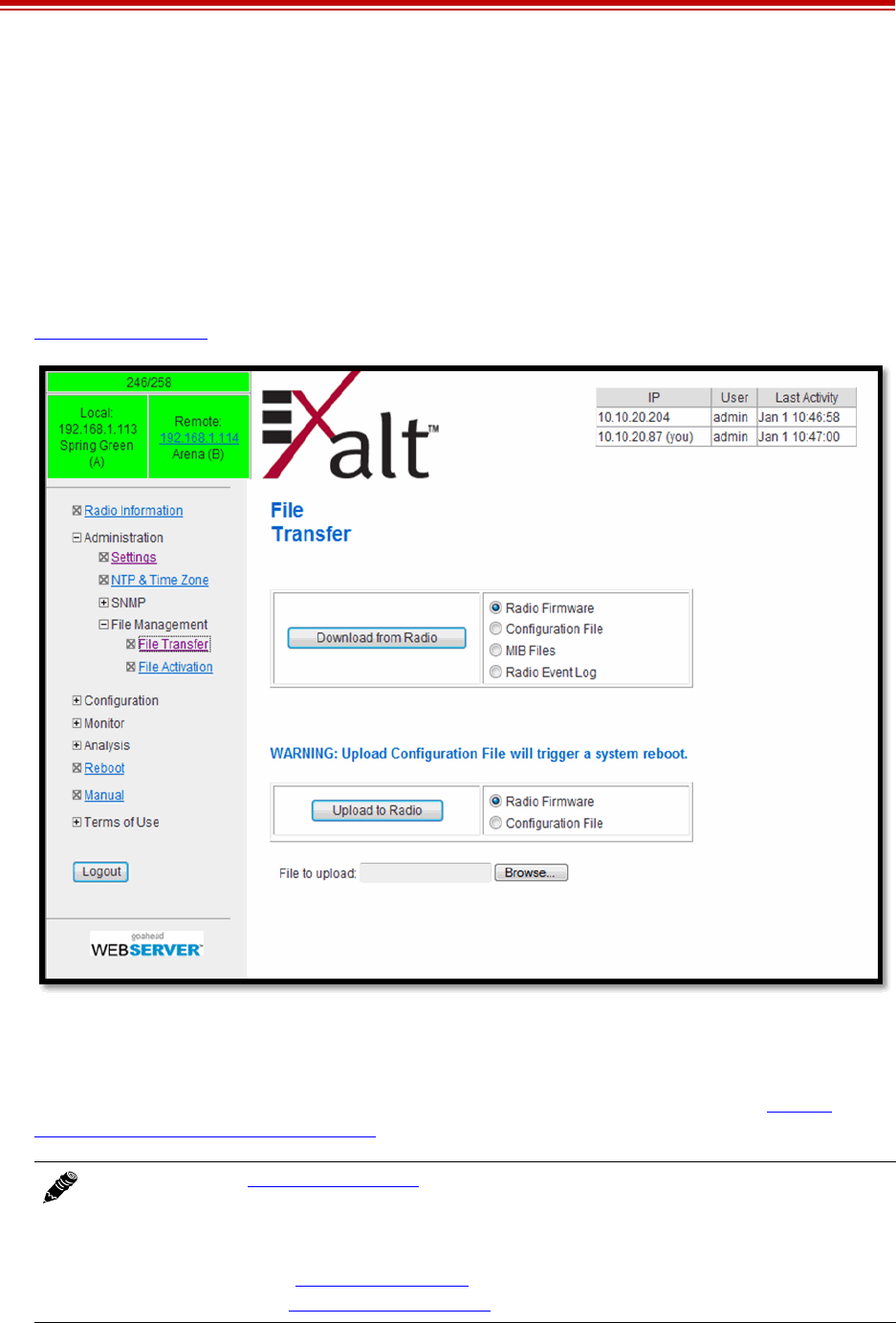
Exalt Installation and Management Guide
ExtendAir (TDD) Series Digital Microwave Radios
46 203591-011
2013-02-22
File Management Pages
File Transfer Page
This page allows the administrator to upload and download files to and from the radio. Two types of
files can be uploaded: configuration and radio firmware. When uploading Configuration Files,
current configuration parameters are immediately overwritten, and the unit
automatically reboots. When uploading radio firmware files, the file is placed into reserve memory
space. After the new radio firmware file uploads, use the File Activation page to enable the files (see
File Activation Page).
Figure 24 File Transfer page
Up to four types of files can be downloaded: configuration, radio firmware, radio event log, and MIB.
The MIB file refers to the Management Information Base related to the Simple Network Management
Protocol (SNMP) function, and is only available on models which support SNMP. See Simple
Network Management Protocol (SNMP) for more information.
Use the following steps to download a file.
Note: Check the File Activation Page before uploading radio firmware files. New file uploads
overwrite the secondary file location. If important files reside in the primary or secondary file
location, download them before uploading the new files. Only the active radio firmware file
can be downloaded. Therefore, to download the reserve file, it must first be activated (using
the Swap button). See File Activation Page. The current radio firmware and RDD versions
can be viewed on the Radio Information Page.
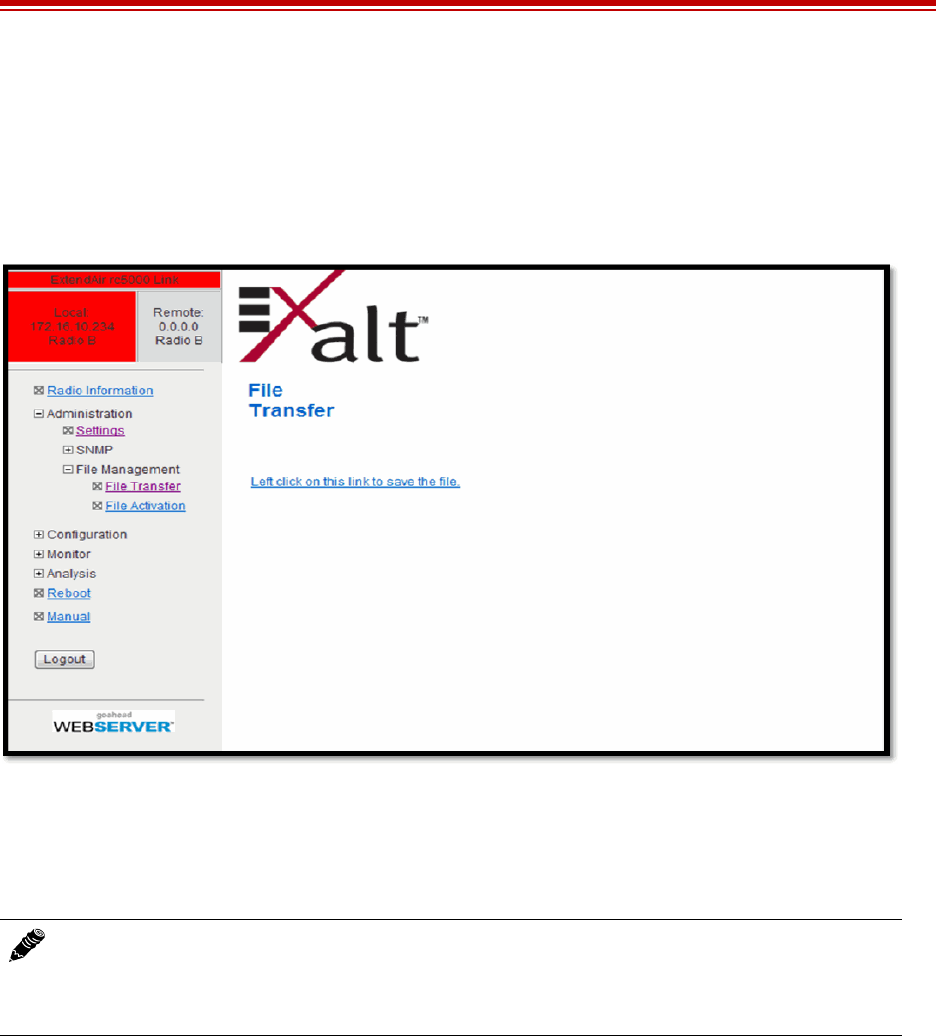
Exalt Installation and Management Guide
ExtendAir (TDD) Series Digital Microwave Radios
203591-011 47
2013-02-22
1Select the type of file to download (configuration or radio firmware).
2Click the Download button and wait for the radio to prepare the file for download.
For the MIB file download, a second page/link appears (Figure 25).
3Left-click the link on the page to download the file to a desired location.
Figure 25 File Transfer page—download file link
File download and upload is useful when configuring several radios with similar settings. A copy of
the configuration file can also help restore radio settings. In addition, a copy of the Exalt default
configuration file is helpful to restore the radio to factory settings.
If copying the same configuration file into multiple radios, some parameters will match and that may
be undesirable. However, it may be easier to change just a subset of parameters rather than every
parameter. The following parameters can cause problems or confusion if they match at each of a link:
•Radio Name
•Endpoint Identifier
•IP Address
•IP Subnet Mask
•Default Gateway
The following parameters can match at both ends of the link:
•Link Name
Note: Do not change the name of any download file. The configuration file must be named
config.nv. To keep track of multiple configuration files, use a folder naming system or
temporarily rename the file, however, it must be named config.nv before it can be uploaded to
a radio. Never change radio firmware file names under any circumstances.

Exalt Installation and Management Guide
ExtendAir (TDD) Series Digital Microwave Radios
48 203591-011
2013-02-22
•Link Security Key (although each link should be different)
•Admin and User passwords
•Bandwidth
•RF Frequency
•Link Distance
•TDD Frame Size
•T1/E1 configurations
•Ethernet configurations
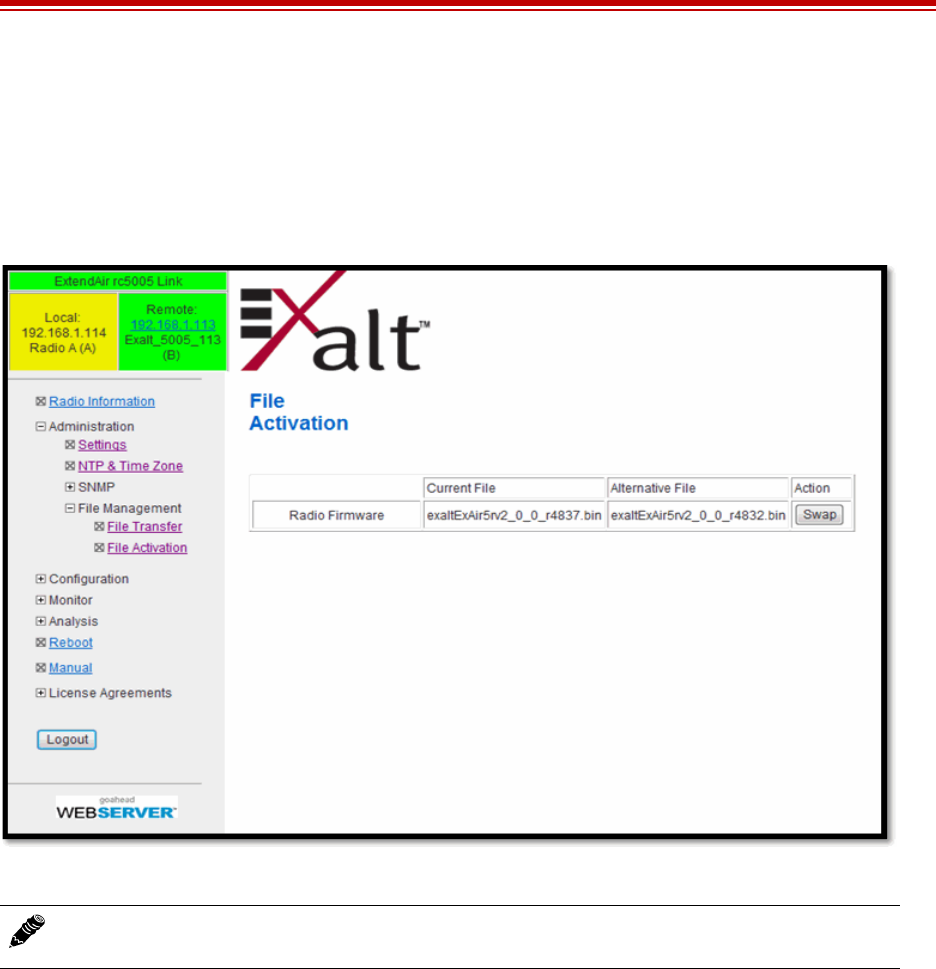
Exalt Installation and Management Guide
ExtendAir (TDD) Series Digital Microwave Radios
203591-011 49
2013-02-22
File Activation Page
Use this page to move stored or uploaded files for use on the radio. The page indicates which file is
currently in use, and which file is available for use. Click the Swap button to place the file in the
Alternative File column into the active state and move the file in the Current File column to the
Alternative File column.
Figure 26 File Activation page
Note: In all cases, the radio reboots after a new file is selected using the Swap function. This
places the radio out of service for a short time.
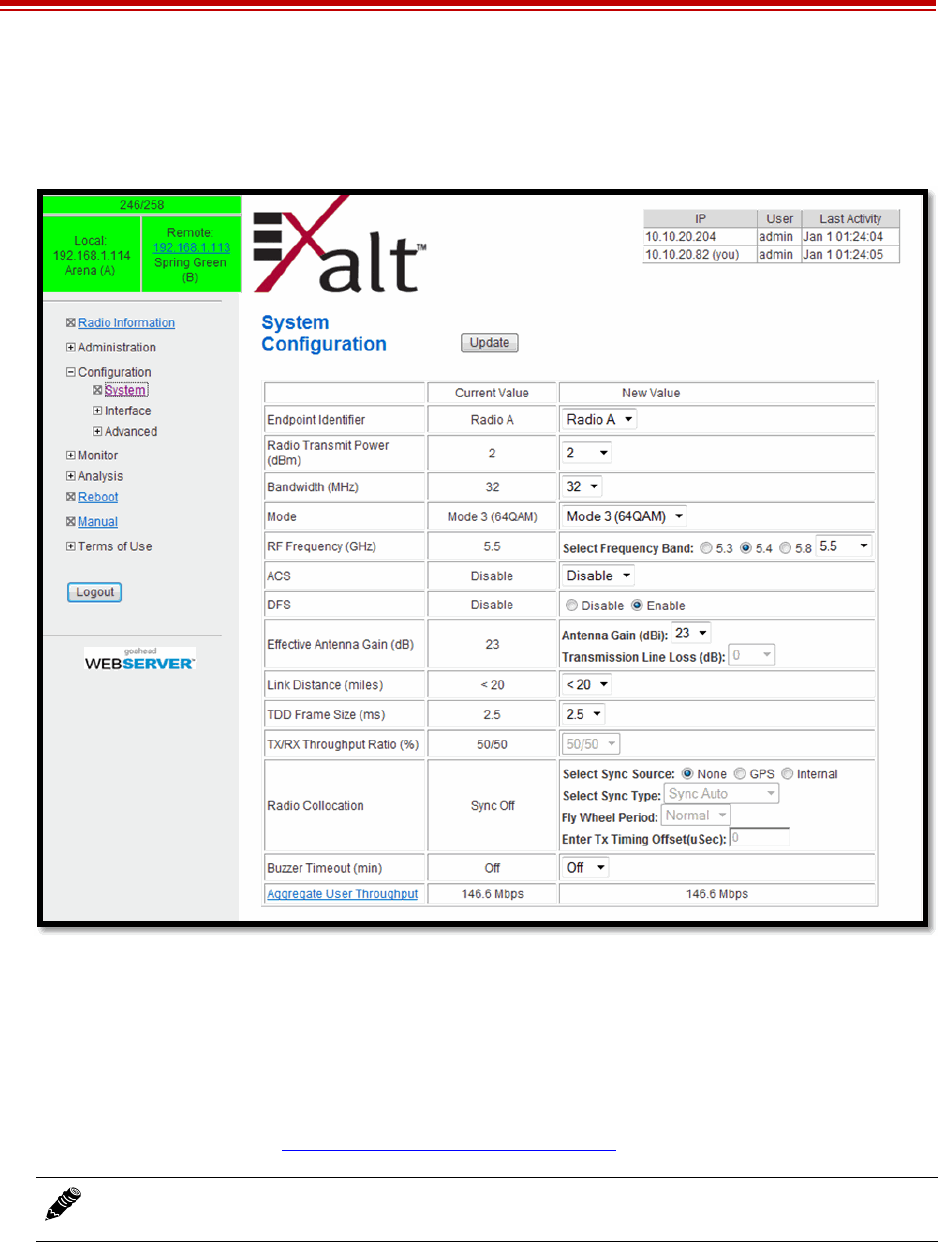
Exalt Installation and Management Guide
ExtendAir (TDD) Series Digital Microwave Radios
50 203591-011
2013-02-22
System Configuration Page
This page contains several critical system parameters.
Figure 27 System Configuration page
Most entries on this page are self-explanatory. The following lists unique or important parameters.
•Set the Endpoint Identifier so that one end of the link is set to Radio A and the opposite end set to
Radio B. In single-link networks, it is unimportant which end is designated A or B. In multi-link
networks, however, it may be important to orient the links so that at any collocation site (where
there are multiple radios of the same type at the same site), all radios are set to the same Endpoint
Identifier (A or B). See Link Orientation and Synchronization.
•Set the Radio Transmit Power (dBm) parameter to the designed level. The professional installer
sets this value or dictates the value of this setting to the system administrator following the system
design and local regulations. In many cases, this value must be set to a proper value to comply
with legal restrictions. Improper values can result in liability to the user and/or installer.
Note: Changing the Endpoint Identifier parameter requires a reboot of the radio to take effect.
The reboot temporarily interrupts traffic.

Exalt Installation and Management Guide
ExtendAir (TDD) Series Digital Microwave Radios
203591-011 51
2013-02-22
– Do not adjust the Radio Transmit Power parameter to a value higher than is legally allowed.
– Do not adjust the Radio Transmit Power parameter lower than the link budget and fade margin
can afford.
•Set the Bandwidth (MHz) parameter to the designed level. The value of this is determined in the
design/engineering stage. The Bandwidth parameter must also match at both ends of the link. In
conjunction with the Mode parameter, the Bandwidth parameter directly relates to the capacity,
latency, and the number of TDM circuits supported. The transmitter and receiver bandwidth are
modified using this parameter, making it critical that it be set with respect to the local RF noise and
interference profile, and/or in relation to any multi-link network design.
•Set the Mode parameter to the designed selection. The value of this setting is determined in the
design/engineering stage. The Mode parameter must match at both ends of the link. In conjunction
with the Bandwidth parameter, the Mode parameter setting directly relates to the capacity of the
system, as well as critical RF parameters, including receiver threshold, carrier-to-interference
ratio, and in some cases, maximum radio transmit power.
•Set the RF Frequency (GHz) parameter to the designed point. The value of this setting is
determined in the design/engineering stage. RF Frequency must match at both ends of the link. It
may be critical to set RF Frequency with respect to the local RF noise and interference profiles,
and/or in relation to any multi-link network design.
Note: Changing Radio Transmit Power may temporarily interrupt traffic. Small changes
in output power do not normally interrupt traffic, but larger changes may.
Note: The link may be lost and unrecoverable through GUI control. If the link is lost due to
reduction of Radio Transmit Power, travel to the radio location(s) may be required to reset the
value.
Note: Changing Bandwidth will temporarily interrupt traffic. The Bandwidth
parameter must match at each end. Adjust the far-end radio first, and then the near-end
radio. Changing Bandwidth changes the radio’s threshold. A narrower bandwidth has better
threshold performance and improved interference immunity, therefore if changing to a wider
bandwidth, there is an opportunity that the link may be lost and unrecoverable through GUI
control. Check the available fade margin and interference profile to determine if the impact to
threshold and increased bandwidth is acceptable to maintain the link and the desired
performance. If the link is lost due to increasing the Bandwidth parameter, travel to the radio
location(s) may be required to reset the value.
Note: Changing Mode will temporarily interrupt traffic. The Mode setting must match
at each end. Adjust the far-end radio first, and then the near-end radio. Changing Mode
changes the radio’s threshold, carrier-to-interference ratio, and also may have impact on the
Radio Transmit Power. A lower mode has better threshold performance and carrier-to-
interference ratio, and in some cases, higher output power, therefore if changing to a higher
mode (for example, from Mode 1 to Mode 2), there is an opportunity that the link may be
lost and unrecoverable through GUI control. Check the available fade margin and
interference profile, and determine if the impact to RF performance is sufficient to maintain
the link and desired performance. If the link is lost due to increasing the Mode parameter,
travel to the radio location(s) may be required to reset the value.

Exalt Installation and Management Guide
ExtendAir (TDD) Series Digital Microwave Radios
52 203591-011
2013-02-22
The frequency selection section includes the ability to select from either the complete list of
frequencies (“All”) that can be tuned for the selected band and bandwidth, or, in some cases, a pre-
selected list of non-overlapping center frequencies (“Preferred”) that Exalt determined provides
the most flexible collocation opportunities for large networks of Exalt radios
The frequency selection section includes a band selection button that must be enabled for the
frequency band of operation for which the link was engineered. In some cases, some bands may
not be selectable due to regulatory constraints. Some bands also require Dynamic Frequency
Selection (DFS). DFS is automatically enabled for these bands and is selectable for all other bands.
•Enable the ACS (automatic channel switching) option to allow the radio to re-tune the operating
frequency when radar or high noise interference is detected. This can reduce the opportunity for
interference in other radios in the network. See Automatic Channel Selection (ACS) Page. To
prevent losing the link, ACS must be enabled on both Radio A and Radio B.
•DFS is automatically enabled for any band where required based on regulation. For bands where
DFS is not required, it can still be selected. For DFS to operate properly, set the antenna gain
figure to match the installed transmission system gain (that is, the gain of the antenna minus all
losses between the radio and the antenna).
•Set the Link Distance (miles) parameter to the range that is equal to or greater than the actual link
distance. The value of this setting is determined in the design/engineering stage.
•Set the TDD Frame Size (ms) parameter to the designed level. The value of this setting is
determined in the design/engineering stage. The TDD Frame Size parameter must match at both
ends of the link. The TDD Frame Size parameter setting directly relates to the capacity, latency,
and number of TDM circuits that can be supported over the given link distance. In multi-link
networks, especially where there are collocated links, it is also important to set all radios to the
Note: Changing RF Frequency will temporarily interrupt traffic. The RF
Frequency parameter setting must match at each end. Adjust the far-end radio first,
and then the near-end radio. If the RF Frequency parameter is changed to a frequency with
interference, the link may be lost and unrecoverable through GUI control. If the link is lost
due to changing the RF Frequency parameter, travel to the radio location(s) may be required
to reset the value.
Note: When DFS is enabled, the radio temporarily stops transmitting for at least 60 seconds to
ensure that no radar interference is present. This is called Channel Availability Check (CAC).
The DFS status displays on the Alarms Page. Once CAC passes, the radio resumes normal
operation. If at any time during CAC or regular operation a qualifying radar signature is
detected, the radio shuts down communications for a minimum of 30 minutes. This is the
Non-Occupancy Period (NOP). Transmission only resumes after the NOP completes and then
only after a successful CAC.
Note: Changing the Link Distance parameter will temporarily interrupt traffic.
The Link Distance setting must match at each end and must not be less than the actual link
distance. Adjust the far-end radio first, and then the near-end radio. If the Link Distance
parameter is changed to a setting less than the actual distance, the link may be lost and
unrecoverable through GUI control. If the link is lost due to this situation, travel to the radio
location(s) may be required to reset the value. If the Link Distance parameter setting is set to a
distance unnecessarily higher than the actual link distance, the radio may have substantially
reduced performance with respect to throughput and latency.
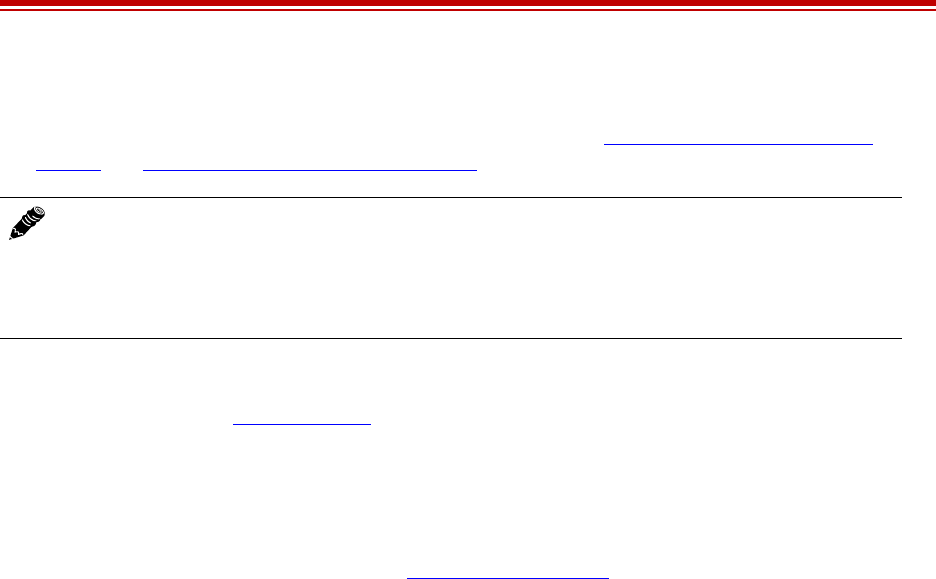
Exalt Installation and Management Guide
ExtendAir (TDD) Series Digital Microwave Radios
203591-011 53
2013-02-22
same TDD Frame Size setting to avoid self-interference. Future enhancement: The GPS or
internal sync function may be necessary for these networks. See Time Division Duplex (TDD)
Factors and Link Orientation and Synchronization for more information.
•Set the TX/RX Throughput Ratio (%) parameter to program radio symmetry. The default setting is
50/50 for symmetrical, full-duplex throughput. Other throughput ratio options are 20/80, 80/20,
and 65/35, 35/65. See Link Symmetry.
– For asymmetric throughput, only TDD frame size settings of 2ms and 5ms and RF Bandwidth
settings of 16MHz and higher are supported.
– The 64MHz/Mode2 configuration does not support asymmetry due to capacity limitations of
the 100BaseT interface. Set the Radio Collocation parameter to control parameters related to
the GPS Synchronization feature (see Radio Synchronization).
•Radio Collocation parameters can be enabled when an Exalt GPS receiver is connected to Radio A
or when using internal sync between two collocated radios or when using the ExaltSync
Collocation kit to synchronize multiple radio links at one location. There are two additional
features:
– Set the Flywheel Period parameter to ‘Normal’ (default) or ‘Infinite.’ This is the period of time
that the radio will run on the internal timing signal if the synchronization timing signal is lost.
–The Normal parameter is a time period that allows the timing signal to be recovered. The
default time to wait is set between 5 and 10 min. The system then resynchronizes to the
timing signal without impact to traffic. If Normal is selected and timing is not recovered
within the set time period, the system stops transmitting (loss of link) until timing is
recovered. This prevents self-interference to local systems, but loses the link.
–The Infinite parameter allows the radio to run on the internal clock source with no limit
and attempts to resynchronize with the timing source when the timing source is detected.
This allows the link to continue to operate, however, if a timing signal is not detected
within approximately 10 minutes, the radio may start to cause interference to other
collocated systems, and other collocated systems may start to cause interference with it. If
after this interval timing is restored, a temporary outage due to the resynchronization
requirement may occur.
– Set the Tx Timing Offset (µSec) parameter to allow the administrator to delay transmitter
timing from the GPS timing pulse by a fixed time, in microseconds. This is useful if multiple
GPS-synchronized Exalt radio systems are present, separated by distance, such as when using
a repeater. This delay is required to offset the difference in speed-of-light between the two
locations. It is recommended to add a 5uSec delay for every mile of difference in path length.
For example, if there is one link with no delay, delay the link within the field-of-view of the
first link on the same or overlapping frequency channel accordingly so that it is synchronized,
including the speed-of-light delay between the two sites.
– When using Internal timing, select the radio to be the Sync Source (master) for the other
collocated radios, Sync Auto for a radio to receive sync and run indefinitely if sync is lost (this
Note: Changing the TDD Frame Size parameter will temporarily interrupt traffic. TDD
Frame Size parameters must match at each end. Adjust the far-end radio first, and then the
near-end radio. If the TDD Frame Size parameter is set to a value that cannot be supported for
the link distance, the link may be lost and unrecoverable through GUI control. If the link is
lost due to this situation, travel to the radio location(s) may be required to reset the value.

Exalt Installation and Management Guide
ExtendAir (TDD) Series Digital Microwave Radios
54 203591-011
2013-02-22
provides the same results as infinite flywheel parameter), or Sync Recipient, which disables a
radio if sync is lost, but eliminates the opportunity of self-interference.
•Buzzer Timeout (minutes) parameter creates an audio signal for antenna alignment. Turn on the
buzzer continuously during antenna alignment or preset a period of time that the buzzer will
sound. If the buzzer stops before alignment activities are complete, change the selection and press
the Update button or select the ON option until alignment activities are complete.
•Aggregate User Throughput parameter provides information about user capacity of the wireless
link, in the current configuration. The ‘new value’ column reflects throughput if changes are made
to Bandwidth, Mode, Link Distance, and/or TDD Frame Size. Click the “Aggregate User
Throughput” link for details on aggregate capacity.
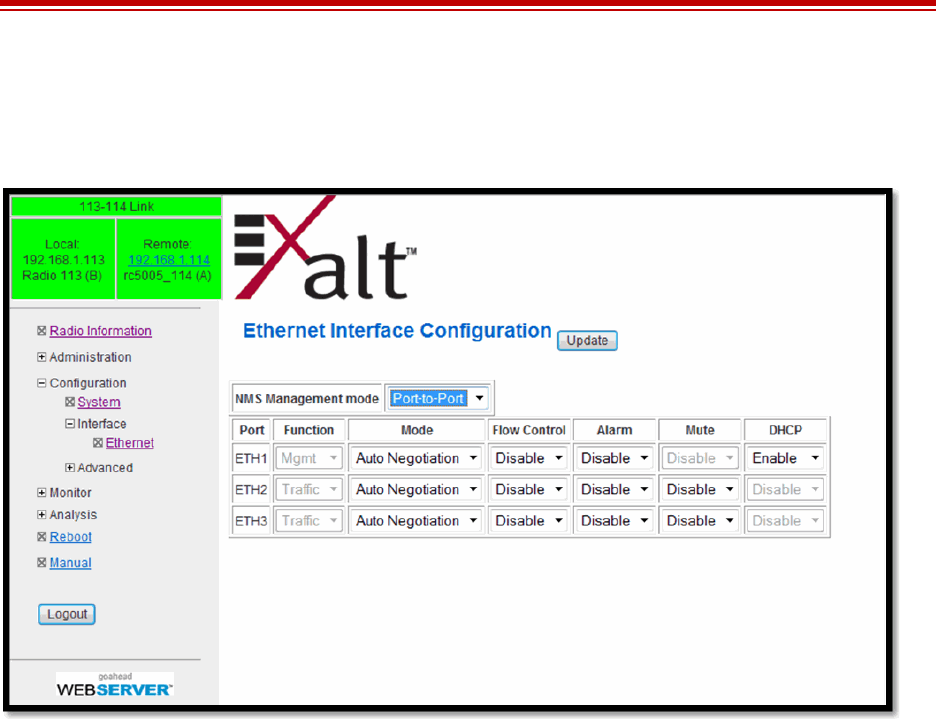
Exalt Installation and Management Guide
ExtendAir (TDD) Series Digital Microwave Radios
203591-011 55
2013-02-22
Ethernet Interface Configuration Page
This page allows administrators to set the alarm, and duplex settings of the Ethernet connection.
Figure 28 Ethernet Interface Configuration page (multiple Ethernet ports model)
•For models with multiple Ethernet ports, NMS Management allows determination of the
management information using the following management modes:
– In-band: Management traffic is carried over the air and is available from all connectors on
either end of the link.
– Out-of-band: Management traffic is not carried over the air and is only available from the
port(s) configured for Management.
– Port-to-Port: Management traffic remains separate from data traffic without requiring out-of-
band management or VLAN configuration. This allows any Ethernet port on the link to be
logically mapped to the same port at the other end of the link without requiring VLANs to be
configured. The traffic passing through these mapped ports is not accessible from any of the
other available Ethernet ports on either side of the link.
•Set the Ethernet ports on the radio and connected equipment to 100/full-duplex for best
performance. If the Ethernet ports are set to auto-negotiation, poor throughput performance may
be a result, as well as intermittent disconnections of the Ethernet connection.
•The Flow Control setting allows the enabling of 802.3 Ethernet flow control, useful for systems
implementing QoS or other traffic flow control implementations.
•The Alarm function can be enabled or disabled for each port. Generally, all constantly connected
port alarms should be enabled, and unused or maintenance-only ports should have alarms disabled.
•For models with multiple Ethernet ports, the Mute setting allows signalling to connected network
devices when the radio link is down such as for spanning tree protocol.

Exalt Installation and Management Guide
ExtendAir (TDD) Series Digital Microwave Radios
56 203591-011
2013-02-22
•When enabled, the DHCP feature provides a basic DHCP function to ease interfacing with a
computer. DHCP is enabled by default. If the Ethernet port on the computer is set for DHCP
addressing, on radio bootup (for up to 10 minutes) or when an Ethernet link is sensed for a
management port, the radio provides an IP address to the computer that is two digits higher than
the radio’s IP address (for example, if the radio’s IP address is 10.0.0.1, the computer’s IP address
will be 10.0.0.3). The radio also senses any DHCP server on the network and if detected, mutes its
own internal DHCP function.

Exalt Installation and Management Guide
ExtendAir (TDD) Series Digital Microwave Radios
203591-011 57
2013-02-22
T1/E1 Configuration Pages
These pages allow the administrator to selectively enable or disable the T1 or E1 circuits, one at a time.
For enabled T1/E1 circuits, additional configuration, including loopback functions, are available.
Disable the unused T1 or E1 so that the alarms are turned off and more throughput is allocated to the
Ethernet interface. Every enabled T1 or E1 input, even if there is no T1 or E1 signal present, reduces
the aggregate throughput of the Ethernet interface by roughly 3Mbps (for T1) or 4Mbps (for E1).
This page toggles between T1 and E1, as required, by clicking the Set to T1 or Set to E1 button. A
warning displays that a reboot is necessary, and the radio reboots if the administrator continues. This
will interrupt traffic. It may be necessary to re-login to the radio after the reboot completes. T1/E1
mode self-coordinates across the link if the link is active. This means that it only needs to be set while
connected at one end. In addition, enabling and disabling T1/E1 circuits also self-coordinates across
the link if the link is active. If a link is not active and T1/E1 enabling is a mismatch when a link is first
created, the Radio A configuration for T1/E1 enabling supersedes the settings on the Radio B
configuration, and changes the settings on Radio B.
T1 Interface Configuration Page
This page allows the administrator to enable/disable each individual T1 channel, set the Line Build Out
(LBO), Line Code (either AMI or B8ZS), and AIS enabling/disabling for each input. If enabled, the
radio places an AIS code on the output of the associated interface if and when the link fails or when
there is no T1 signal available from the far end to provide the user at the local end. Loopback controls
are also provided (see T1/E1 Loopback).
Note: Certain combinations of the TDD Frame Size, Link Distance, Mode, and Bandwidth
parameter settings limit the number of T1/E1 circuits that can be carried by the radio. In these
cases, certain fields on the T1/E1 Interface Configuration pages are not available, starting
with the highest port number. For example, for a 4x T1/E1 radio version, if only three (3)
circuits can be carried, port 4 is not available for configuration and is disabled. If only two
circuits can be carried, both ports 3 and 4 are not available. Increasing the TDD frame size and
Mode parameters, and/or increasing the Bandwidth parameter results in an increase in the
supported number of T1/E1 circuits.
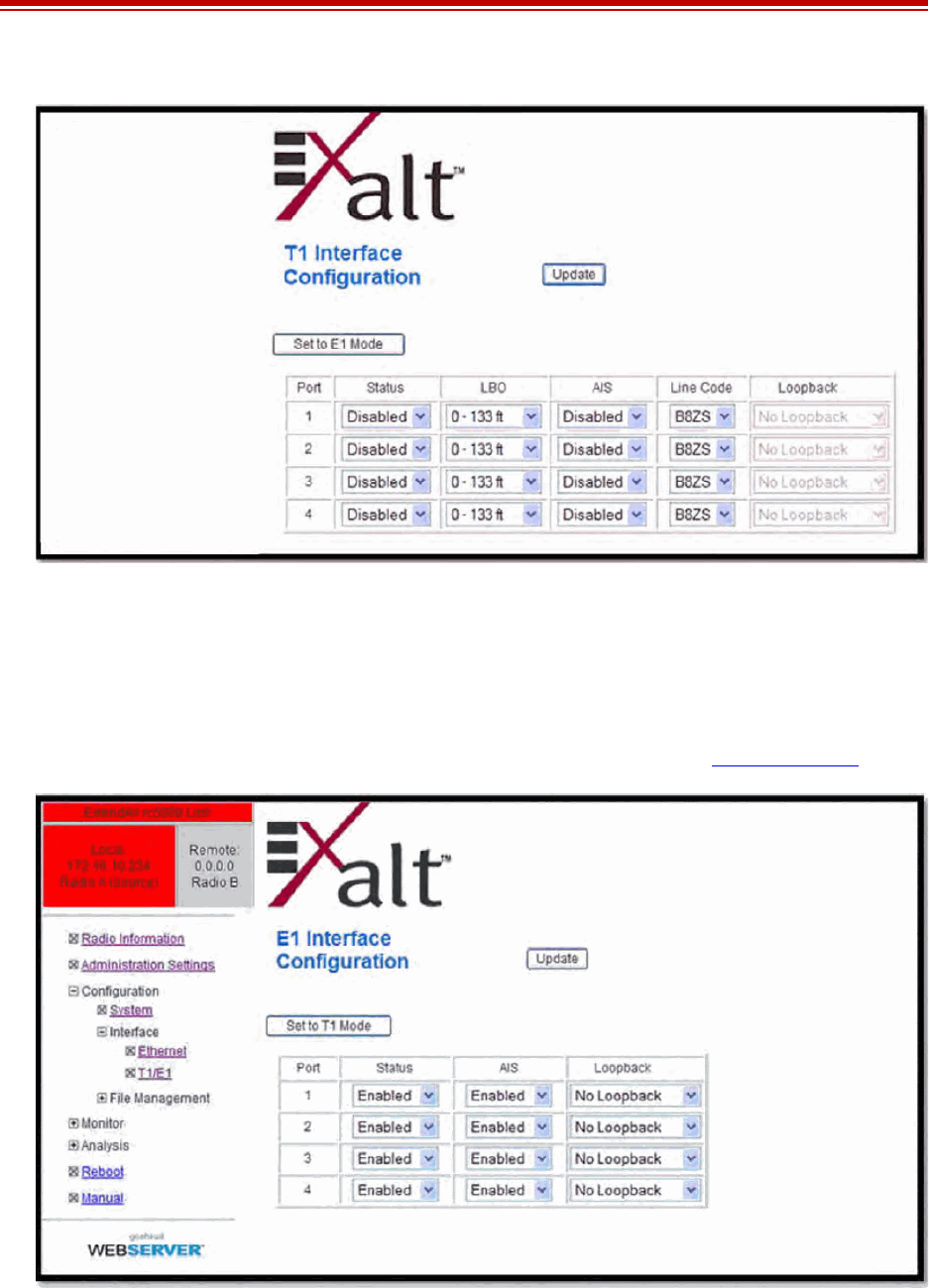
Exalt Installation and Management Guide
ExtendAir (TDD) Series Digital Microwave Radios
58 203591-011
2013-02-22
Figure 29 T1 Interface Configuration page
E1 Interface Configuration Page
This page allows the administrator to enable/disable each individual E1 channel. The AIS can also be
enabled and disabled for each input. If enabled, the radio places an AIS code on the output of the
associated interface if and when the link fails or when there is no E1 signal available from the far end
to provide the user at the local end. Loopback controls are also provided (see T1/E1 Loopback).
Figure 30 E1 Interface Configuration page
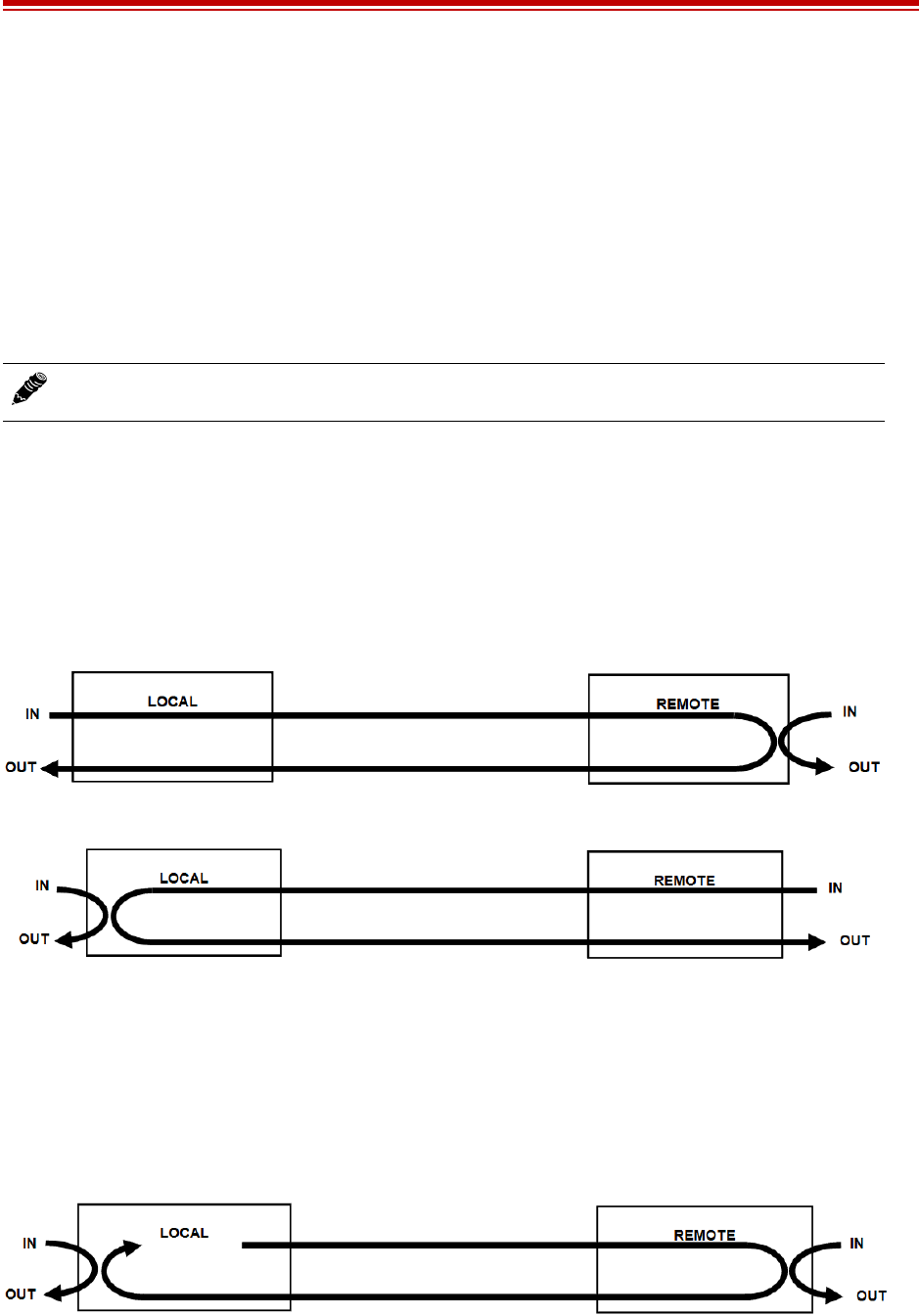
Exalt Installation and Management Guide
ExtendAir (TDD) Series Digital Microwave Radios
203591-011 59
2013-02-22
T1/E1 Loopback
Loopback is provided for any enabled T1 or E1 port. As shown in Figure 29 and Figure 30, the choices
are:
•No Loopback (default)
•External (local)
•External (remote)
•Internal
All loopback configurations control the loop at the Line Interface integrated circuit, which is the
device wired directly to the front panel ports.
External loopback modes are used in conjunction with an external test source. The designation of
‘local’ or ‘remote’ refers to where the loopback is occurring relative to the location where the loopback
is implemented. That is, on the radio being accessed, if External (remote) is selected, this loops the
signal back at the remote radio interface back towards the local radio. Likewise, if External (local) is
selected, the signal loops back at the local interface towards the remote radio (Figure 31 and Figure
32).
Figure 31 External (remote) loopback
Figure 32 External (local) loopback
When a local T1/E1 port is configured for External (remote) loopback, it is the same as configuring the
remote radio for External (local) loopback.
Internal loopback uses an internal test source, and sends the test source signal across the link, looped at
the remote radio’s interface, returned to the local radio, and looped at the local radio’s interface back to
the source. The inputs at both ends are looped back at the line level. Figure 33 illustrates the internal
loopback function.
Figure 33 Internal loopback
Note: Only one Internal loopback can be enabled at any time.
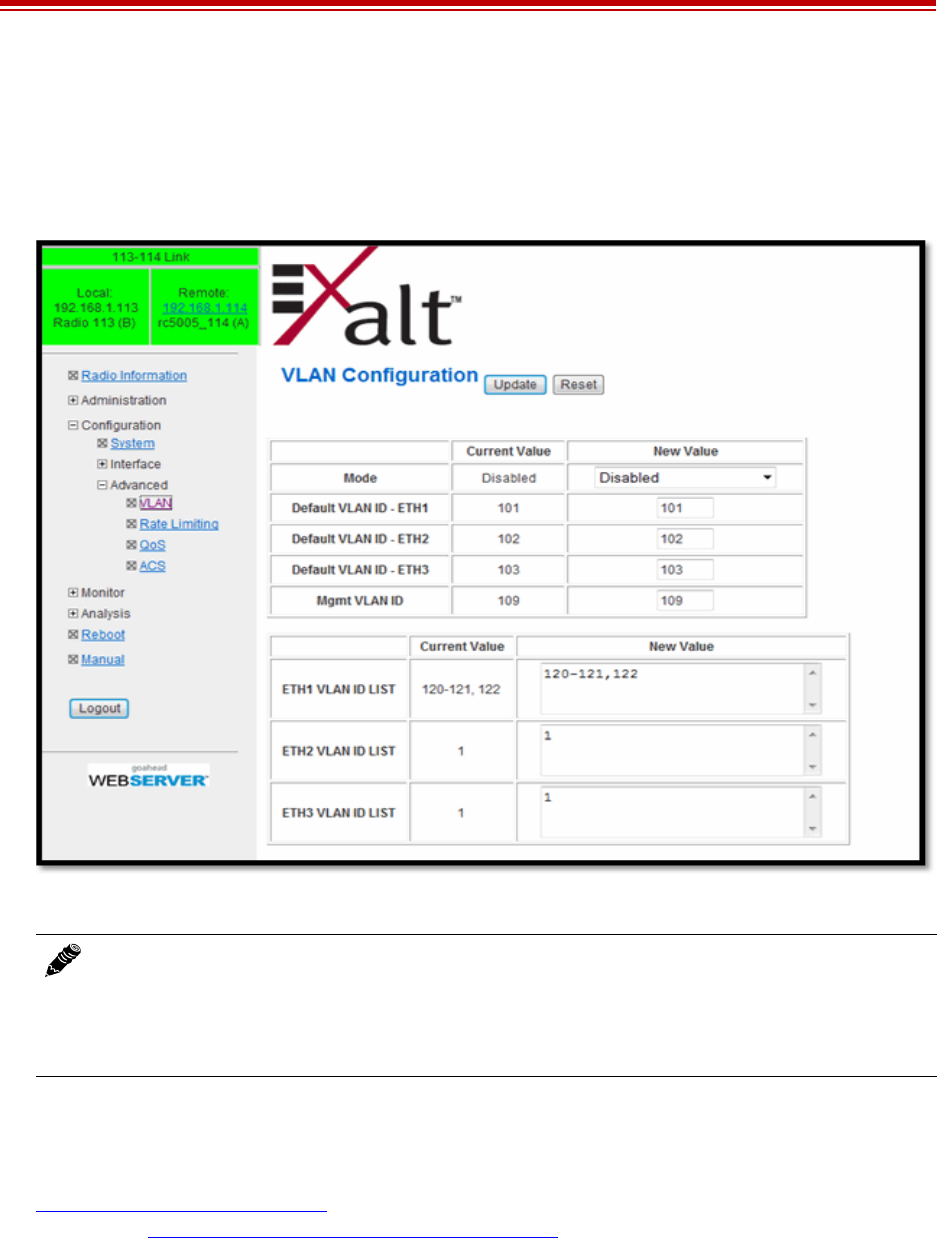
Exalt Installation and Management Guide
ExtendAir (TDD) Series Digital Microwave Radios
60 203591-011
2013-02-22
VLAN Configuration Page
VLAN is disabled as the default setting for Exalt radios. The Exalt radios still pass VLAN and non-
VLAN traffic across the link, but do not examine the VLAN traffic or act upon it. Enable VLAN using
the Exalt GUI for expanded VLAN support.
Figure 34 VLAN Configuration page
VLAN configurations are maintained even when VLAN is disabled. That is, the VLANs can be
configured and the configuration saved, even though they are not active until VLAN is enabled. Use
the following methods to restore the management connection if a mistake was made assigning the
management VLAN and access cannot be restored: Reset the radio to the critical factory defaults (see
Reset to Critical Factory Settings). Connect to the Console port using a serial interface and the CLI, as
described in Telnet into the Command Line Interface (CLI), and reconfigure the VLAN settings.
Four VLAN configurations are provided:
•802.1q Block Untagged: To pass desired VLANs across the radio, they must be listed in the lower
tables per their respective interfaces. All other traffic, including untagged traffic, is not passed
across the link. The radio must be managed on a VLAN whose ID is set in the upper table. This
management VLAN ID is available to any interface IDs listed in this lower table.
Note: Once a management VLAN is configured or modified and the Update button clicked,
the management connection will likely be lost. The management connection to the radio must
follow the configuration to the assigned VLAN. After configuring and enabling the
management VLAN on the radio, reconfigure your network’s management access to match
the settings on the radio.

Exalt Installation and Management Guide
ExtendAir (TDD) Series Digital Microwave Radios
203591-011 61
2013-02-22
•802.1q Pass Untagged: To pass desired VLANs across the radio, they must be listed in the lower
tables per their respective interfaces. All other VLAN traffic is not passed across the link, and
untagged traffic is passed across the link with no changes. The radio must be managed on a VLAN
whose ID is set in the upper table. This management VLAN ID is available to any interface IDs
listed in this lower table.
•802.1q Tag Untagged: To pass desired VLANs across the radio, they must be listed in the lower
tables per their respective interfaces. All other VLAN traffic is not passed across the link, and
untagged traffic is tagged with the programmed Default VLAN, per interface, as set in the upper
table. Any interface requiring the default VLAN ID to pass must have the Default VLAN ID listed
in the table below. The radio must be managed on a VLAN whose ID is set in the upper table. This
management VLAN ID is available to any interface IDs listed in the lower table.
•Management only: All traffic is passed transparently, except the radio is managed on an assigned
Management VLAN ID, as programmed in the upper table.
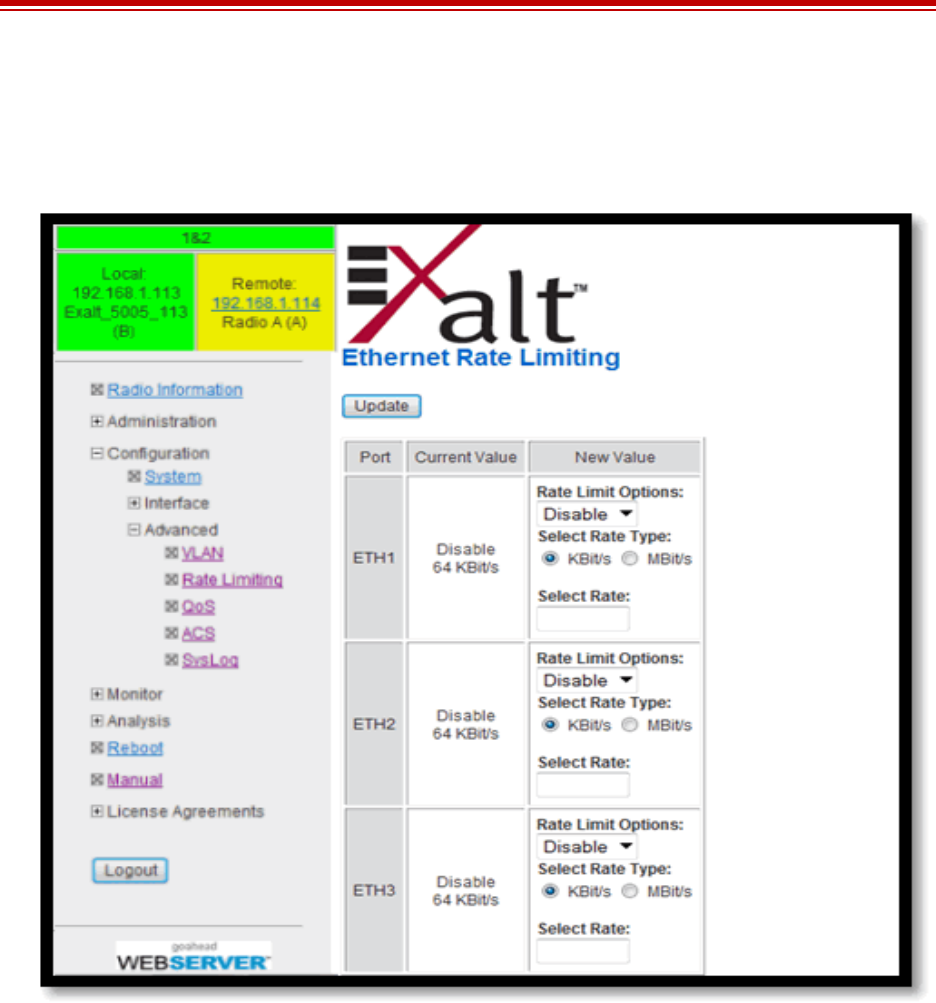
Exalt Installation and Management Guide
ExtendAir (TDD) Series Digital Microwave Radios
62 203591-011
2013-02-22
Ethernet Rate Limiting
This page enables radio Ethernet port rate limiting. Enable this to limit the output information rate to at
or below downstream networking equipment capabilities. The rate is in Mbps or kbps, as specified.
Figure 35 Ethernet Rate Limiting page
For models with more than one Ethernet port, each port can have rate limiting enabled or disabled. The
default setting is disabled.
Use the Update button to save changes.
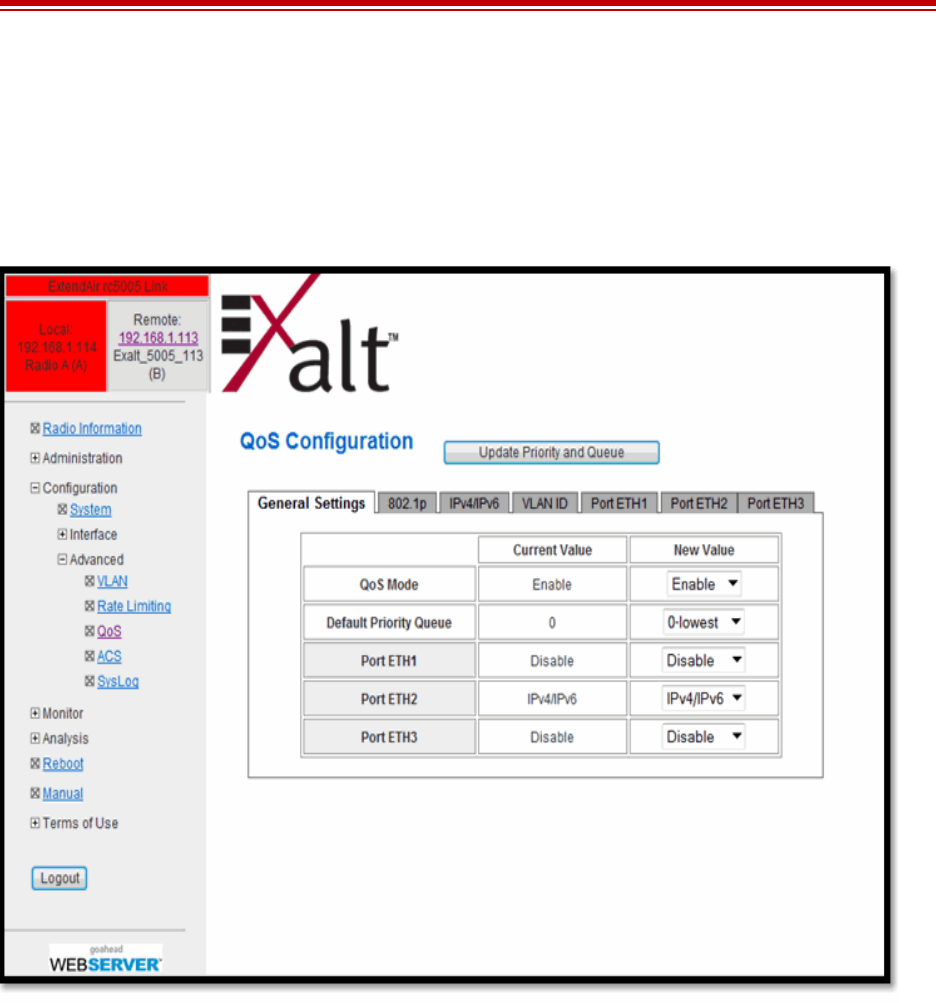
Exalt Installation and Management Guide
ExtendAir (TDD) Series Digital Microwave Radios
203591-011 63
2013-02-22
QoS Configuration Page
This page provides configuration for the Quality of Service (QoS) feature (not available on all
models). QoS is a network prioritizing feature that ensures high-priority traffic transfers during peak
capacity demands. The priority hierarchy is adhered to when capacity demand is higher than the link
can provide; highest priority traffic is allowed to transfer, while lowest priority traffic may be dropped.
Figure 36 QoS Configuration page (multiple Ethernet interface model)
These systems follow a ‘round robin’ QoS algorithm, ensuring a distribution of priority traffic. Some
percentage of all priority classifications is carried across the link, with the largest percentage applied to
the highest priority, and next largest percentage to the next highest priority, and so on. Thus low-
priority traffic is not ignored when there is a high capacity high-priority traffic stream.
The following QoS Mode options are available (choose one per port):
•MAC DA (Media Access Control Destination Address): Prioritizes traffic based on the MAC
destination address (recipient of the traffic) in the packet header.
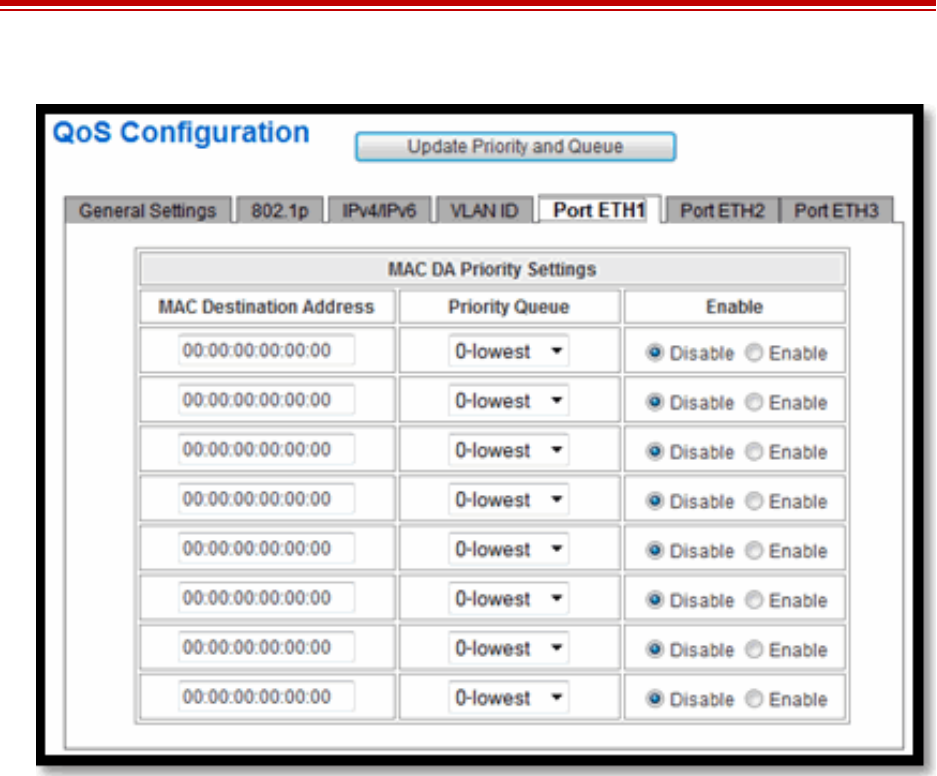
Exalt Installation and Management Guide
ExtendAir (TDD) Series Digital Microwave Radios
64 203591-011
2013-02-22
Figure 37 MAC DA based QoS
Up to 8 MAC destination addresses can be programmed per port for priority queuing, as shown in
Figure 37.
•MAC SA (Media Access Control Source Address): As with MAC DA, prioritizes traffic based on
the MAC source address (sender of the traffic) in the packet header. Up to 8 MAC source
addresses can be programmed per port for priority queuing.
•VLAN ID (Virtual Local Area Network Identifier): Prioritizes traffic based on the VLAN ID tag in
the packet header.
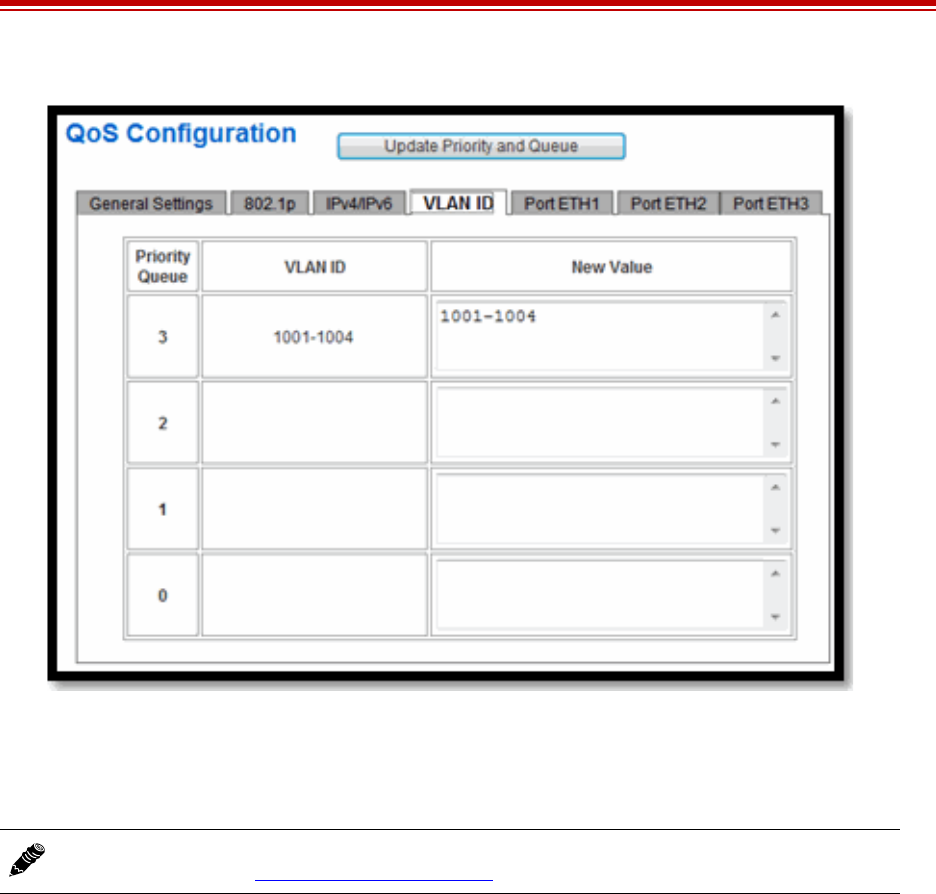
Exalt Installation and Management Guide
ExtendAir (TDD) Series Digital Microwave Radios
203591-011 65
2013-02-22
Figure 38 VLAN ID based QoS
A maximum of 64 VLAN IDs can be programmed across all ports for priority queuing, as shown
in Figure 38. If the radio has multiple Ethernet ports and any port is set for VLAN ID based QoS,
all VLAN ID based QoS ports share the VLAN ID programming for QoS.
•802.1p: Prioritizes traffic based on the 802.1p tag in the packet header.
802.1p based QoS supports the tag range 0–7 (Figure 39), each tag can be assigned to the priority
queues (0–3).
If VLAN filtering and VLAN ID based QoS are enabled, all VLAN IDs listed for QoS must
also be listed on the VLAN Configuration Page.
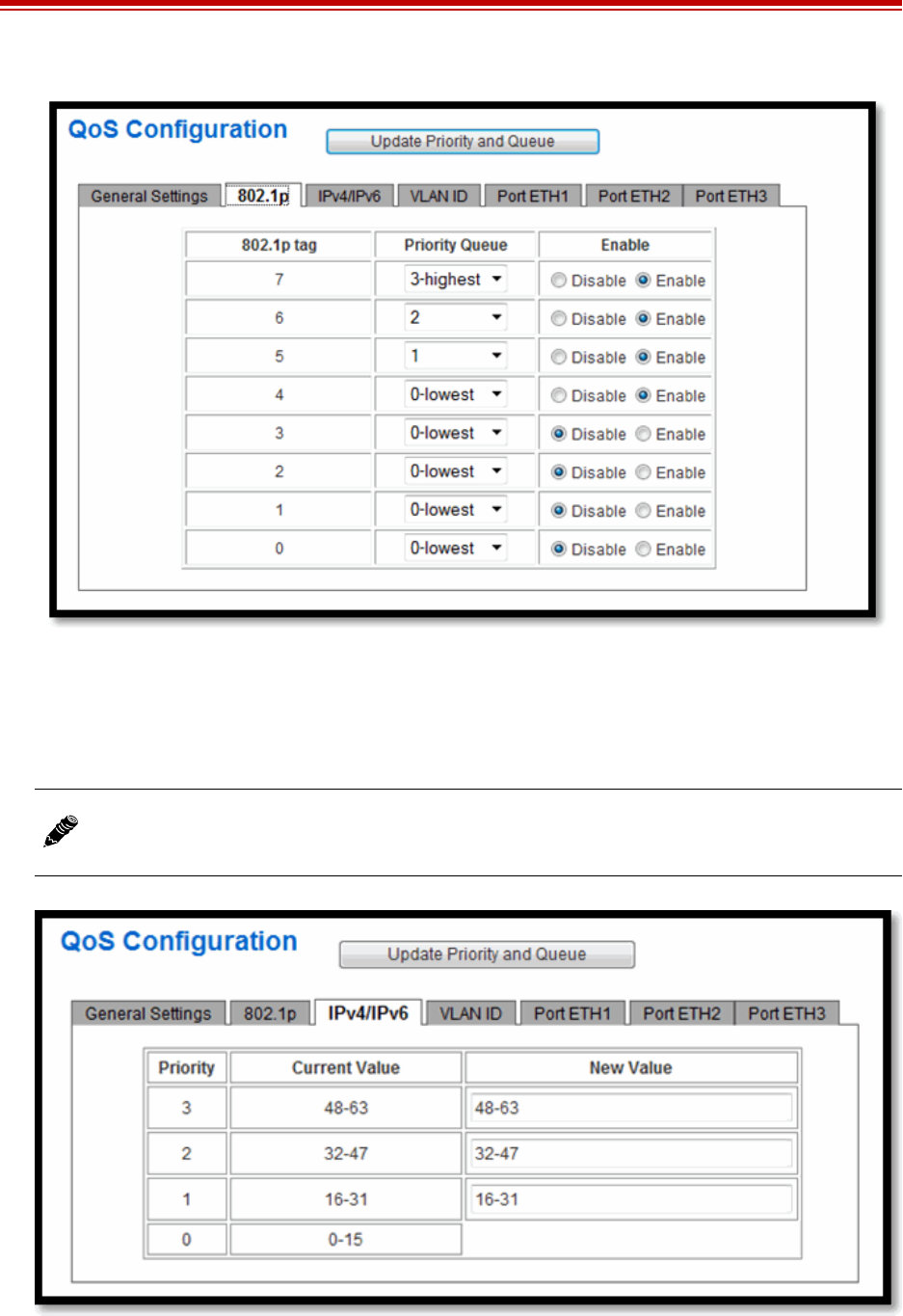
Exalt Installation and Management Guide
ExtendAir (TDD) Series Digital Microwave Radios
66 203591-011
2013-02-22
Figure 39 802.1p based QoS mode
•IPv4/IPv6: Prioritizes traffic based on the IP tag in the packet header.
IPv4/IPv6 based QoS supports the tag range 0–63 (Figure 40), each tag can be assigned to the
priority queues (0–3).
Figure 40 IPv4/IPv6 based QoS
For radios with multiple Ethernet ports, different QoS modes can be set for each port.
However, if more than one port is assigned the same VLAN ID, 802.1p, or IPv4/IPv6 QoS
mode, those ports share those settings and they cannot be altered within that port.
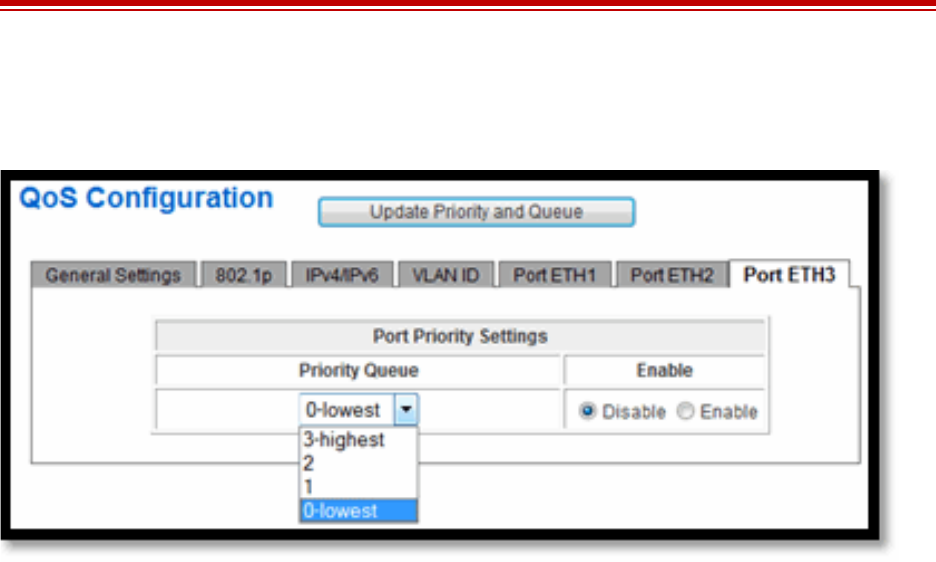
Exalt Installation and Management Guide
ExtendAir (TDD) Series Digital Microwave Radios
203591-011 67
2013-02-22
•Port (models with multiple Ethernet ports only): Prioritizes traffic based on the Ethernet port
(Figure 41); all traffic connected to the port is assigned to that priority queue.
Figure 41 Port based QoS mode
Priority 3 is the highest priority traffic; priority 0 is the lowest. The default priority queue is assigned
to any traffic that does not comply to the selected priorities. For example, if MAC DA or MAC SA is
selected and a packet comes in that does not match any of the up to eight programmed addresses, it is
assigned to the queue selected as default, as are packets that do not have a VLAN ID, 802.1p, or IPv4/
IPv6 tag, or those tags do not match any tags listed (in the case of VLAN).
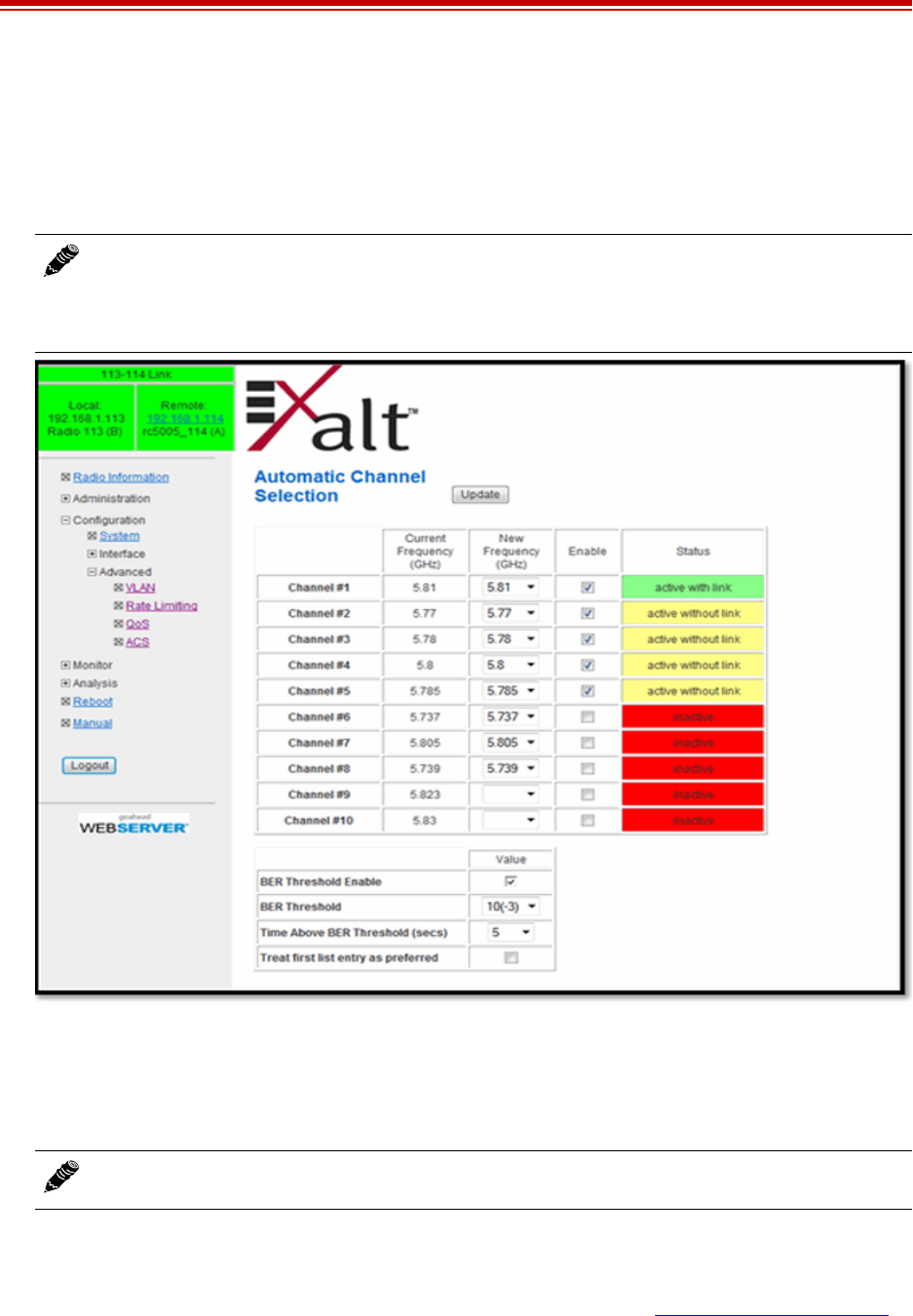
Exalt Installation and Management Guide
ExtendAir (TDD) Series Digital Microwave Radios
68 203591-011
2013-02-22
Automatic Channel Selection (ACS) Page
Use this page to configure alternate channels that the radio uses to automatically re-establish the link in
the event of qualified radar detection (for DFS enabled radios) or if the trigger parameters are
exceeded. Define up to ten alternate channels. Up to five channels can be enabled at the same time.
Figure 42 Automatic Channel Selection page
ACS is disabled by default to prevent accidental interference to other systems in the vicinity or impact
multi-site frequency planning in the event of a channel switch, particularly in collocated environments
designed to operate on the same channel or predefined traffic asymmetry configurations.
Enable ACS to configure alternate channels. Enter the desired frequency for up to ten alternate
channels. Only up to five channels can be enabled at any time. Clicking Update saves the settings and
pushes the configuration to the other radio on the link if the link is currently operating in both
directions. ACS configuration is not enabled until the ACS option on the System Configuration Page is
selected and Update selected.
Note: To preserve the link, both Radio A and Radio B must have ACS enabled
and the channel frequency settings must match. If only one radio has ACS enabled
and an ACS event is detected, that radio will switch channels and the other radio will not, and
the link will be lost.
Note: If an event is detected that triggers ACS, traffic is interrupted.
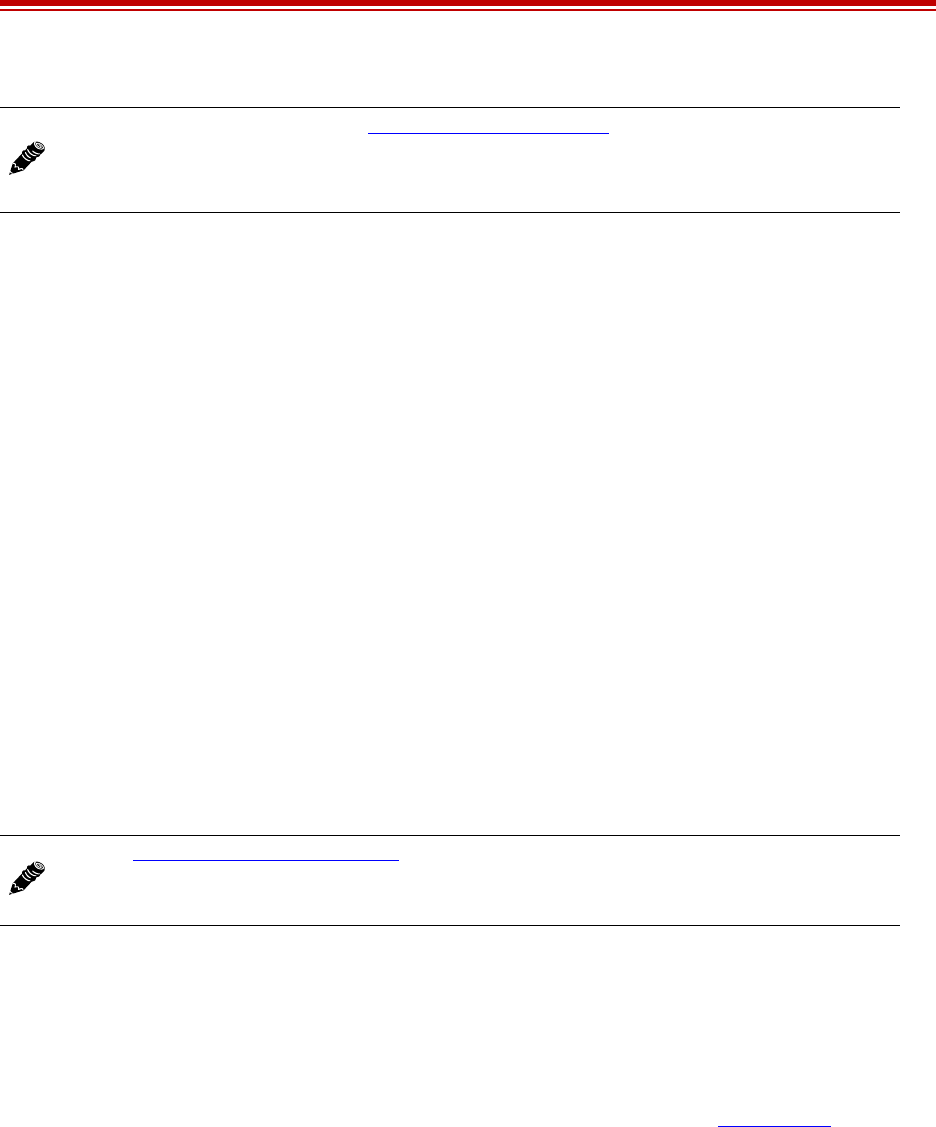
Exalt Installation and Management Guide
ExtendAir (TDD) Series Digital Microwave Radios
203591-011 69
2013-02-22
The status fields have the following color indicators:
•Red/Inactive: The channel is configured, but is not currently in use by the system. The radio is not
currently tuned to this channel.
•Yellow/Active without Link: The channel is configured and the radio is tuned to that channel, but
has not established a link with the other end.
•Green/Active with Link: The channel is configured, and the radio is tuned to that channel and has
established a link with the other end.
•Black/Temporarily inactive: DFS is enabled and the system detected a qualified DFS radar in this
channel, the channel is disabled for 30 minutes.
The system selects alternate channels sequentially. If the radio is operating on Channel #1, it selects
Channel #2 first, then Channel #3, and so on, until a link is re-established with the far-end. If the radio
is operating a channel other than Channel #1 and the Treat first entry as preferred option is selected,
the search always starts with Channel #1. Otherwise the search is sequential starting from the channel
of the operating frequency.
Radio A wait times are approximately 35 seconds per channel switch. Radio B channel switch wait
times are approximately 7 seconds. Radio B is listening for Radio A on each frequency, and may cycle
through the channel list multiple times before Radio A is detected and the link re-established. Wait
times are affected by this, and can be as long as 3 minutes, assuming that a link can be established on
at least one frequency on the enabled list. Adjusting BER thresholds to a higher BER value such as
10(-3) can improve wait times.
The BER threshold and time above BER threshold options trigger channel switching when ACS is
enabled. Available BER threshold options are from 10(–3) to 10(–7). The time above BER options are
in increments from 1 to 200 seconds. The defaults are 10(–5) and 10 seconds, respectively. Adjusting
BER thresholds to a higher BER level and/or increasing the timer length for BER, reduces ACS
activity.
All ACS events are captured in the event log and can be accessed in real time for troubleshooting.
Corresponding status alarms are also captured in the event log and display on the Alarms Page.
•ACS must be enabled on the System Configuration Page on both radios or the link may
be permanently lost.
•To avoid link loss, include a setting for the current frequency before enabling ACS.
When Dynamic Frequency Selection (DFS) is enabled due to regulations, expect an
additional one minute wait time per channel switch. For some regulatory domains, the wait
time is increased to 6 minutes per channel switch for certain frequencies.
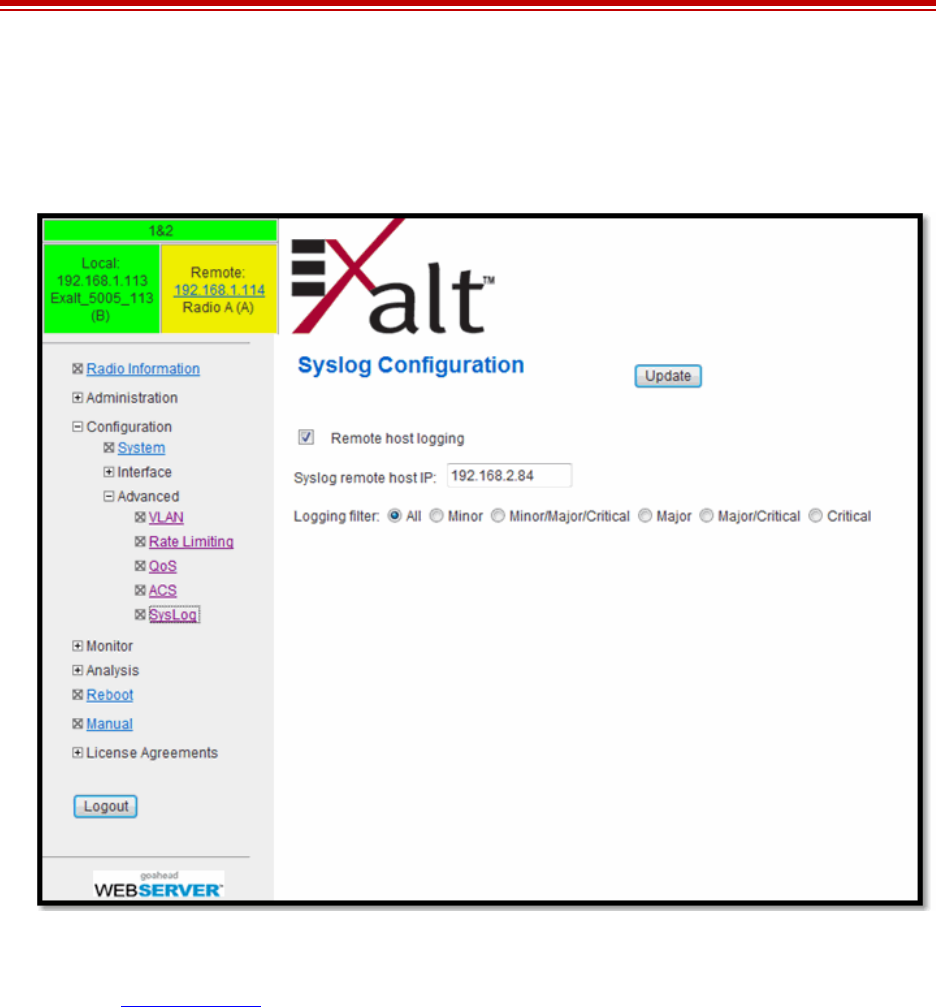
Exalt Installation and Management Guide
ExtendAir (TDD) Series Digital Microwave Radios
70 203591-011
2013-02-22
Syslog Configuration Page
Syslog serves as a remote means to receive event log messages (configuration and alarm state changes)
for network management and/or record keeping.
Figure 43 Syslog Configuration page
To enable the syslog, check the Remote host logging option and input the IP address for the remote
host. See Event Log Page for filter descriptions.
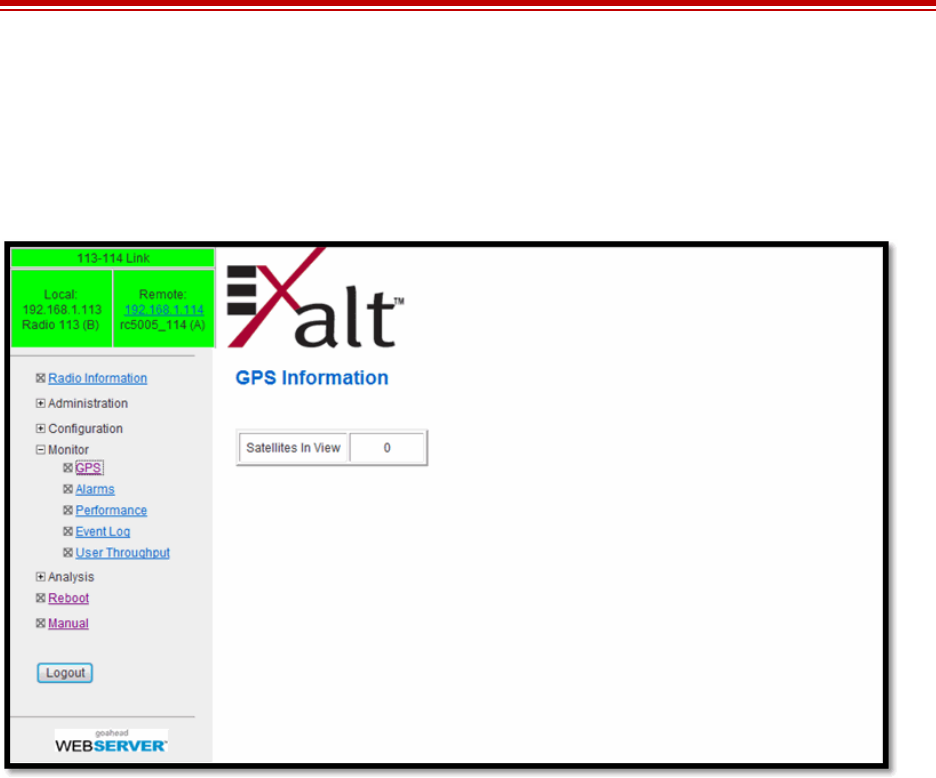
Exalt Installation and Management Guide
ExtendAir (TDD) Series Digital Microwave Radios
203591-011 71
2013-02-22
GPS Information Page
This page provides information on how many GPS satellites are within the view of the Exalt GPS
receiver. This page is active for implementations that include the GPS receiver connection for
synchronization. This information can be helpful for troubleshooting GPS issues.
Figure 44 GPS Information page
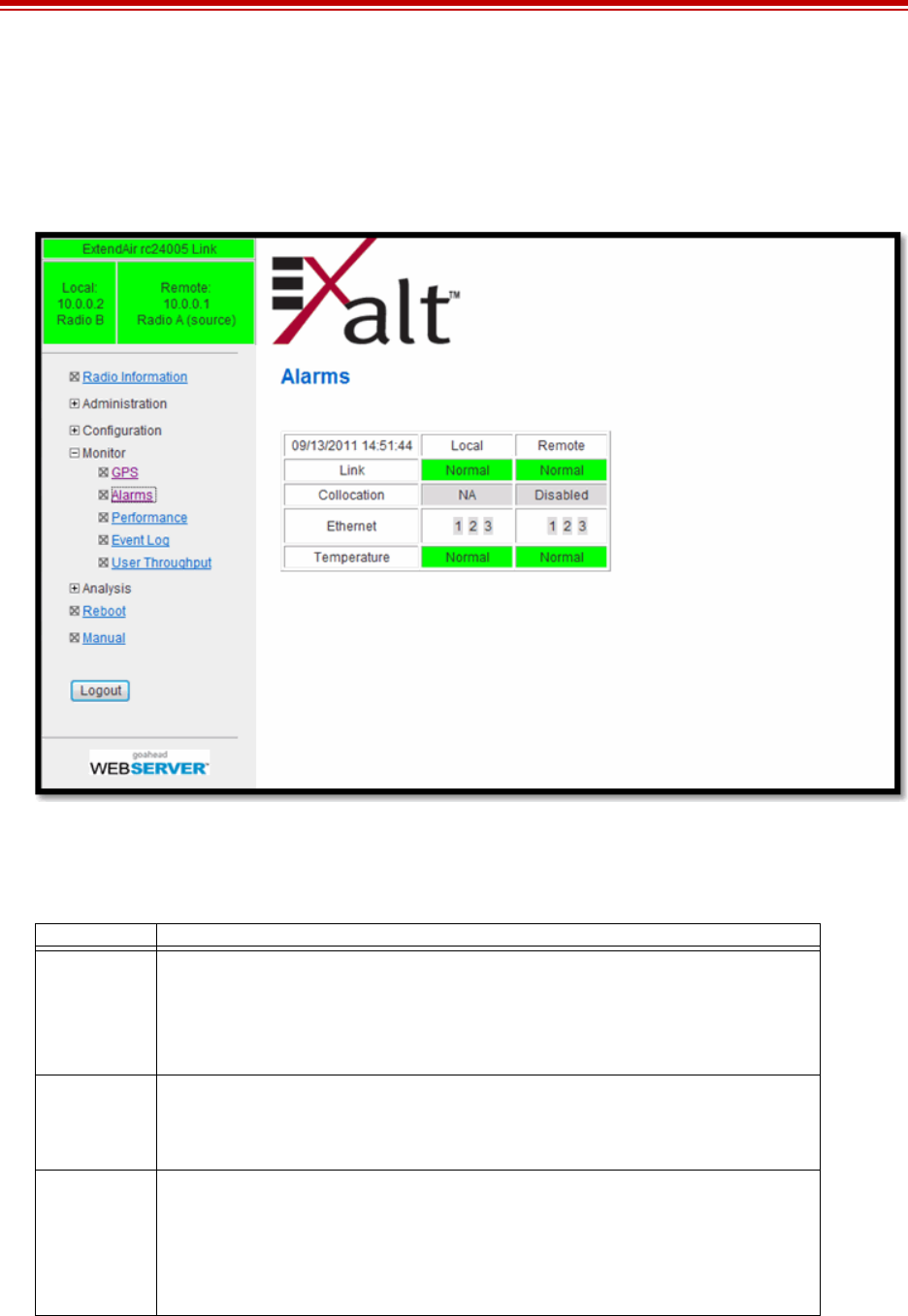
Exalt Installation and Management Guide
ExtendAir (TDD) Series Digital Microwave Radios
72 203591-011
2013-02-22
Alarms Page
This page provides an easy-to-read summary of the alarm status of both local and remote radios. The
colors on this page reflect the color of the alarms displayed on the radio front panel. However,
additional detail displays on this page to aid in quick assessment of issues and status.
Figure 45 Alarms page
Table 6 lists alarm status conditions that appear on this page.
Table 6 Alarm status indicators
Label Status
Link Indicates RF link status:
• Green Solid = Error-free connection (BER<10e-6)
• Yellow Solid = Errored connection (10e-3>BER >10e-6)
• Red Solid = No link (BER>10e-3)
DFS (enabled models only) Indicates the status of the Dynamic Frequency Selection (DFS).
• Green = No DFS activity, normal transmission
• Red = Either CAC or NOP is in progress.
Collocation Indicates the enabled/disabled status with Internal or GPS sync and current alarm status.
• Green Solid = Sync enabled and sync input present
• Yellow Solid = Sync enabled and missing proper sync input in flywheel operation period
• Red Solid = Sync enabled and missing proper sync input signal and flywheel period
expired

Exalt Installation and Management Guide
ExtendAir (TDD) Series Digital Microwave Radios
203591-011 73
2013-02-22
The Temperature alarm monitors the internal temperature of the unit based on specific points inside
the radio chassis. It is normal for the internal temperature to be above the ambient temperature, so the
temperature reading may be higher than the highest specified ambient temperature. When the internal
electronics reach a point that is higher than the normal temperature rise at the highest ambient
temperature, the temperature alarm turns yellow. Power down the radio as soon as possible, and
investigate the cause of the temperature rise before the radio is put back into service. In almost all
cases, a temperature alarm is due to an external cause.
Ethernet • Green Solid = Alarm Enabled and Ethernet Link present
• Red = Alarm Enabled and Ethernet Link not present
• Grey = Alarm Disabled
T1/E1 Input • Green = Enabled and connection present (clocking confirmed)
• Red = Enabled and no connection present
• Grey = Disabled and no connection present
Temperature • Green Solid = Normal temperature range
• Yellow Solid = Exceeding normal temperature range
Table 6 Alarm status indicators (Continued)
Label Status
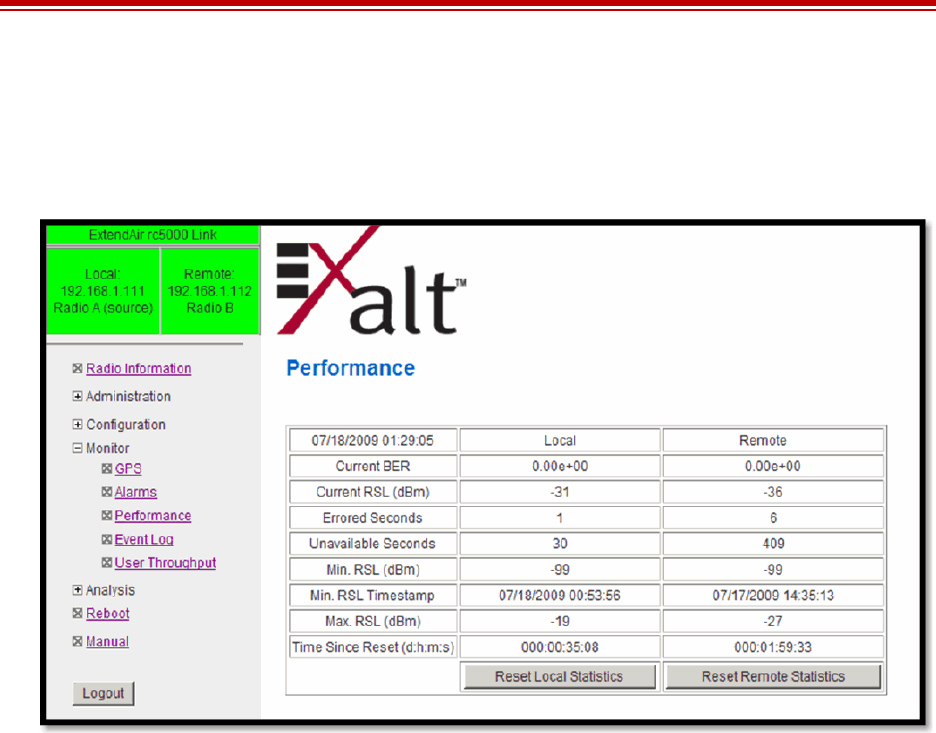
Exalt Installation and Management Guide
ExtendAir (TDD) Series Digital Microwave Radios
74 203591-011
2013-02-22
Performance Page
This page provides statistical information about the performance of the system in relation to the
integrity of the user data and the RF link.
Figure 46 Performance page
•The Current BER field indicates the current bit error rate of the link. If the link is operating
perfectly, this should indicate zero. Generally, the link should remain at a BER less than 1x10-6 (1
bit out of every million bits errored). This is the threshold performance specification and the
standard to which the link was engineered. However, radio links can and are affected by weather,
interference, and other external sources and will occasionally have a higher error rate. A link
remains operational unless the BER exceeds 1x10-3 (1 bit out of every hundred bits errored).
Consult the link design engineer for an understanding of the predicted error rate of the radio link as
it has been designed.
Many applications are unaffected by bit errors, but TDM circuits (for example, T1 or E1) are more
sensitive. Also, if the link operator is providing a service guarantee, this value may need to be
monitored or examined in cases of service issues. The behavior of BER in relation to other alarms
or measurements and external events can be very helpful in troubleshooting activities.
•Current RSL is the measurement of the received signal level at the radio antenna port. This is the
measured level of the RF signal coming from the opposite end of the radio link. The link was
engineered to a specific RSL by the link design engineer, and this RSL should be obtained during
installation and remain relatively stable during the operation of the link. RSL can and will vary as
a result of weather changes and other external sources, such as path obstructions. Once again, this
variation was part of the original design to achieve a certain level of performance over time. Bit
errors occur when the RSL falls to a level within roughly 3dB of the threshold specification. When
the RSL falls below the threshold specification, the link disconnects and will not reconnect until
the RSL is above the threshold specification. The behavior of RSL in relation to other alarms or
measurements and external events can be very helpful in troubleshooting activities.

Exalt Installation and Management Guide
ExtendAir (TDD) Series Digital Microwave Radios
203591-011 75
2013-02-22
•Errored Seconds (ES) indicates the total number of seconds that occurred where there was at least
one bit error since the last time that the radio statistics counter was reset. Generally, ES are not a
significant concern, so long as they are not continuous or above the anticipated performance based
on the original link engineering goals. If ES are continuous or at a high rate, this is normally an
indication of poor link performance due to poor RSL or interference, or severe impact by weather
or other environmental factors. However, similar to the performance factors previously listed, ES
can and will occur in any radio link. Once again, consult the link engineer to determine the original
design goals, and compare actual performance to these expectations to determine if any
improvements are necessary or if other problems may be causing excessive ES.
•Unavailable Seconds (also called UAS) are similar to ES, but this counter keeps track of every
second where the bit error rate equals or exceeds 1x10-3, as well as any seconds where there is a
complete loss of radio communication, over the period since the last counter reset. If Unavailable
Seconds are continuous or at a high rate, this is normally an indication of poor link performance
due to poor RSL or interference, or severe impact by weather or other environmental factors.
However, similar to the performance factors listed above, Unavailable Seconds can and do occur
in any radio link. Consult the link engineer to determine the original design goals, and compare
actual performance to these expectations to determine if any improvements are necessary or if
other problems may be causing excessive Unavailable Seconds.
•Minimum RSL indicates the worst (lowest) received signal level that occurred since the last
counter reset. It is helpful to know if the RSL dropped significantly from the normal level, or has
reached a level near or below threshold.
•Minimum RSL Timestamp indicates the date and time when the Minimum RSL occurred. This is
helpful for general troubleshooting, and especially comparing to items in the event log or
diagnostic charts from the same time period.
•Maximum RSL indicates the best (highest) RSL that occurred since the last counter reset. This
indicates the best performance of the radio link, which is normally equal to the installed value, and
is usually the designed value.
•Time Since Reset indicates the amount of time passed since the last counter reset. This helps to
quantify the seriousness of other statistics, such as ES and Unavailable Seconds, if there have been
high numbers of ES and/or Unavailable Seconds over a relatively short period of time.
All end-of-link statistics can be independently reset using the respective reset statistics button. It is
good practice to reset the statistics during link commissioning (after all antenna alignment is complete
and stable RSL at designed levels is achieved, and no more system reboots are anticipated). Regularly
review this page to note performance and reset the statistics so that the counters can more precisely
pinpoint issues.
Note: Unavailable Seconds do not register as ES. In other words, the ES counter counts all
seconds that are errored NOT INCLUDING the seconds that were classified as unavailable.
The total number of seconds with errors or outages is the sum of ES and Unavailable Seconds.
Note: Resetting statistics from one end also resets the statistics for the same radio at the
opposite end. That is, if the Local statistics are reset, logging into the remote end shows the
Remote statistics on that end (which is the local radio in the first condition) as being reset at
the same time.
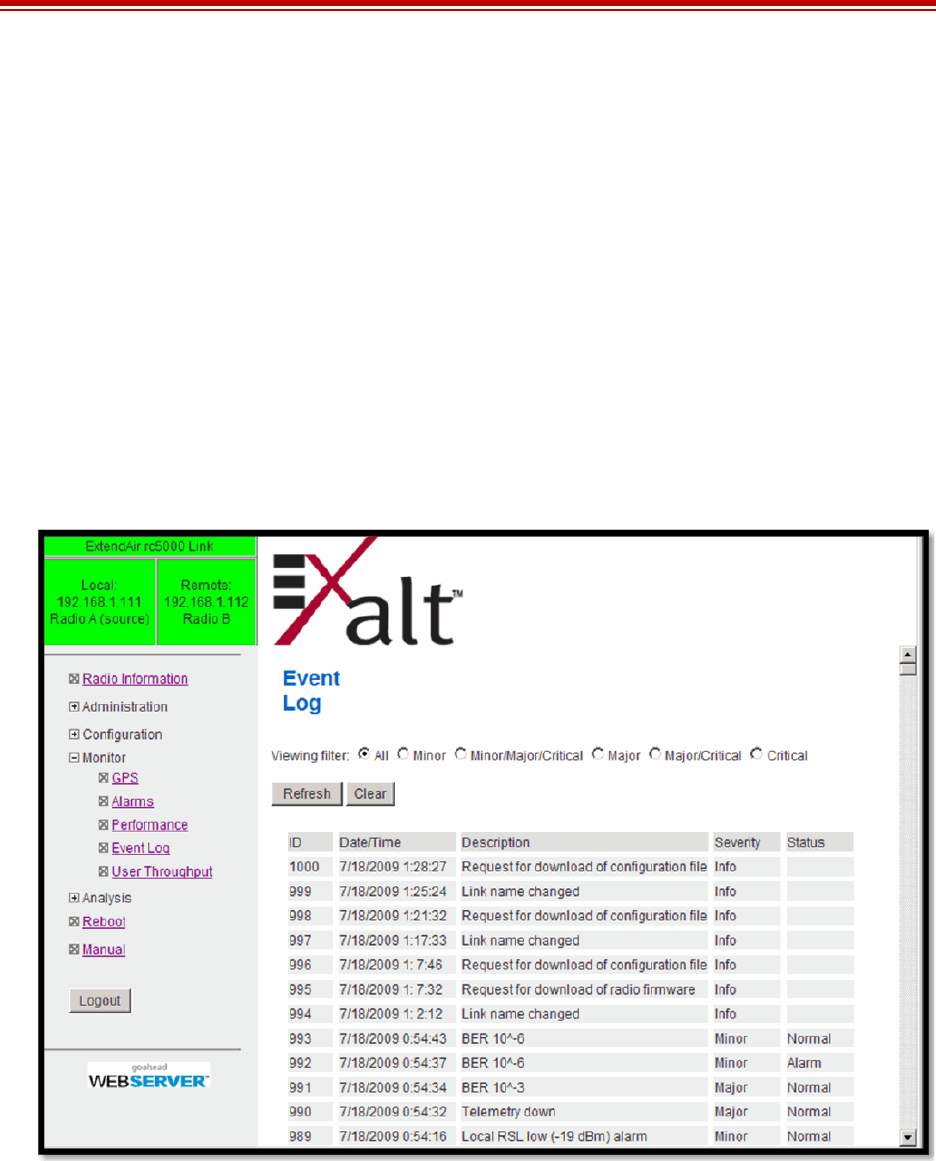
Exalt Installation and Management Guide
ExtendAir (TDD) Series Digital Microwave Radios
76 203591-011
2013-02-22
Event Log Page
Use this page to review a list of the events logged by the radio. The following items are listed in the
event log:
•Alarms
•Alarms clearing (Normal)
•Radio Reboots
Every event is tagged with the time that the event occurred, and a severity and type. The event log also
allows filtering to limit the view of the log to the lowest level of desired information. For example, a
filter level of Minor displays Minor, Major, and Critical severity events.
The log contains the last 1000 events. Events are deleted on a FIFO basis.
The event log can be cleared and be downloaded from the radio (some models may require a software
upgrade to enable this feature). A screen capture of the browser window can serve as a useful record.
Figure 47 Event Log page
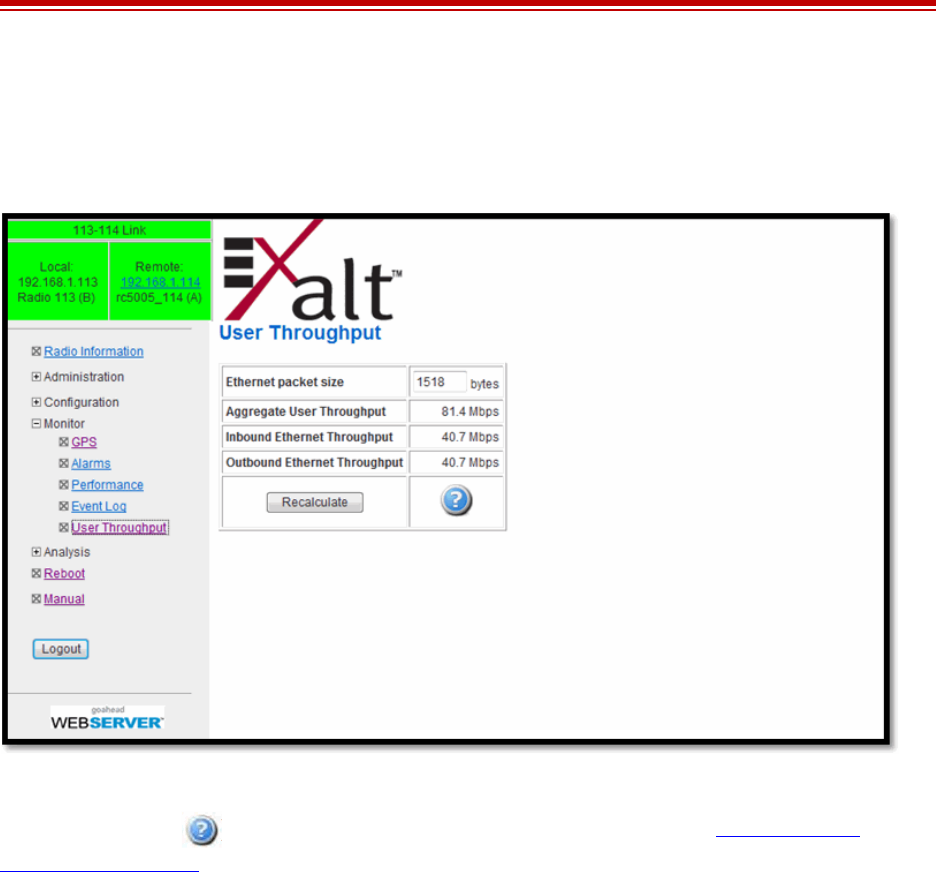
Exalt Installation and Management Guide
ExtendAir (TDD) Series Digital Microwave Radios
203591-011 77
2013-02-22
User Throughput Page
This page illustrates the user throughput of the radio, as configured. Figure 35 illustrates the
information provided.
Figure 48 User Throughput page
Click the help icon ( ) to open a page on how this information is determined Aggregate User
Throughput Help page(Figure 49).
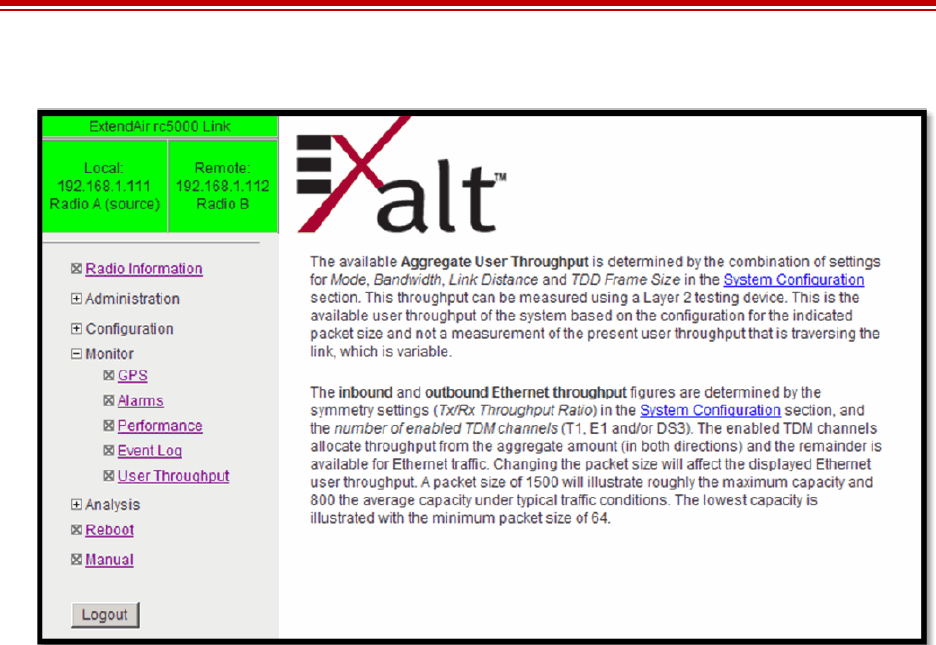
Exalt Installation and Management Guide
ExtendAir (TDD) Series Digital Microwave Radios
78 203591-011
2013-02-22
Figure 49 Aggregate User Throughput Help page
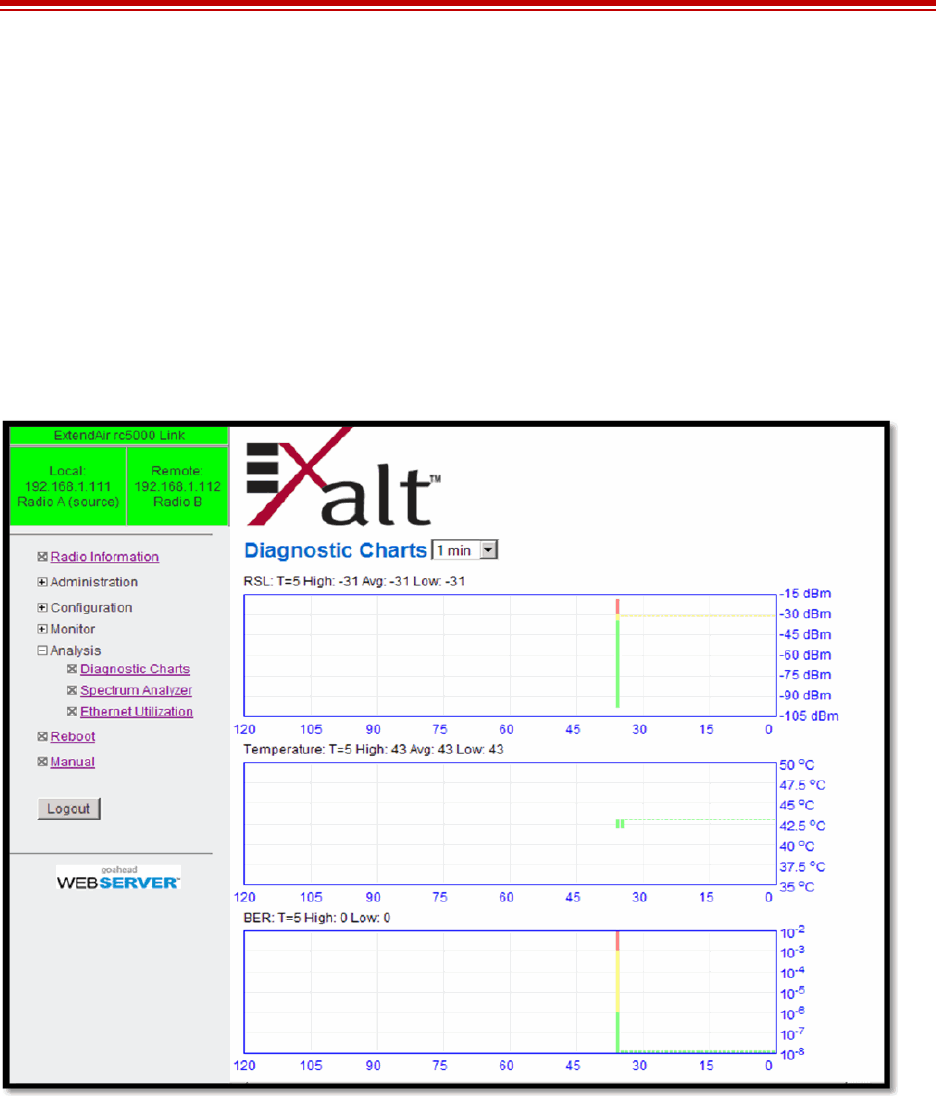
Exalt Installation and Management Guide
ExtendAir (TDD) Series Digital Microwave Radios
203591-011 79
2013-02-22
Diagnostic Charts Page
Use this page as an aid in troubleshooting. This page illustrates the historical (and current)
performance for three parameters: RSL, Radio Temperature, and BER.
The horizontal scale illustrates 120 points of time measurement and is synchronized on all three
graphs. The scale displays in minutes, hours, or days from the last two hours (120 minutes), five days
(120 hours), or four months (120 days). All information is stored, so all of these periods are available
for short- and long-term performance analysis. The right side of a graph represents the most recent
measurement, and data ‘marches’ from the right-to-left at every interval.
The vertical scale of each chart independently scales to show the maximum resolution based on the
maximum variation of the data over the selected time measurement.
Figure 50 Diagnostic Charts page
Use the cursor to point to any spot on any of the three charts, and all three charts illustrate the
measurements taken for that time interval in the upper-left corner of each chart. The time interval is
indicated by T=(value). This is followed by the value of the measurement, listing the highest value,
lowest value and average value measured over that time interval.
For example, in Figure 50 the displayed time interval is minutes, and the cursor is held at the T=17
mark on the horizontal axis. The measurements shown indicate performance from 17 minutes ago. The
high/low/average values shown on each chart are measurements made across that specific one-hour
interval.
Changes in RSL often have an impact on BER, and this can be confirmed by looking for synchronized
events. When BER events occur without corresponding changes in RSL, this normally indicates

Exalt Installation and Management Guide
ExtendAir (TDD) Series Digital Microwave Radios
80 203591-011
2013-02-22
interference, atmospheric changes, transmission system issues (such as problems with cables,
connectors or antennas), or possibly radio hardware problems.
It is also useful to help determine if changes in radio temperature are occurring, and if they are having
any impact on RSL or BER. If the radio is mounted in an environmentally controlled location, this has
less relevance. However, temperature monitoring can be helpful to ensure that the radio is operating
within specifications.
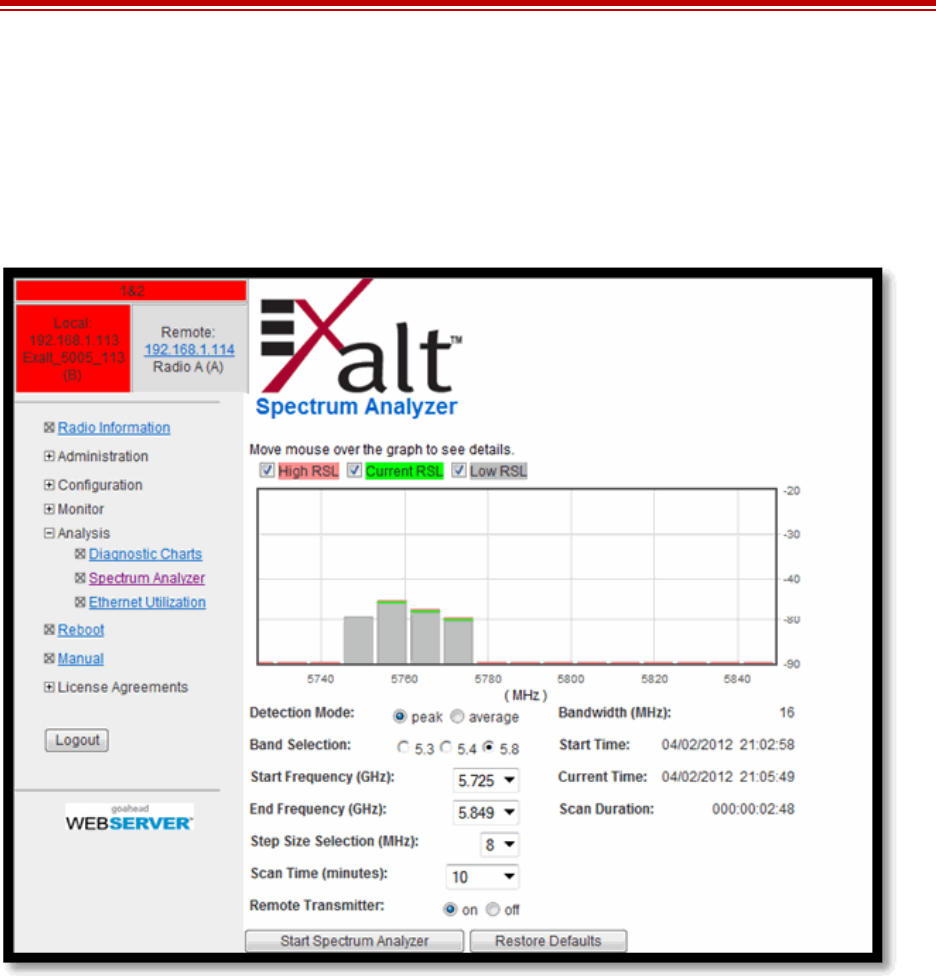
Exalt Installation and Management Guide
ExtendAir (TDD) Series Digital Microwave Radios
203591-011 81
2013-02-22
Spectrum Analyzer Page
The spectrum analyzer feature provides a useful pre-planning and troubleshooting tool. This feature is
only available on radios with firmware supporting the spectrum analyzer. Perform a spectrum analysis
after deployment and just before commissioning to maintain a record of the spectrum at the time of
deployment. Figure 51 shows the Spectrum Analyzer page.
Figure 51 Spectrum Analyzer page
While a professional spectrum analyzer provides higher levels of control and precision for pre-
planning, the Spectrum Analyzer page allows evaluation of the RF spectrum as seen at the radio’s RF
input port prior to deployment. This is useful for pre-planning the center frequency and occupied
bandwidth, and to determine polarization and antenna type and mounting locations.
For troubleshooting, enable the spectrum analyzer to scan the desired segment or full band of the
frequency range. Select the step size and set the remote radio transmitter ON or OFF. This allows
viewing of the clean spectrum without the remote transmitter on and a comparison of the remote
transmitter in the midst of other signals.
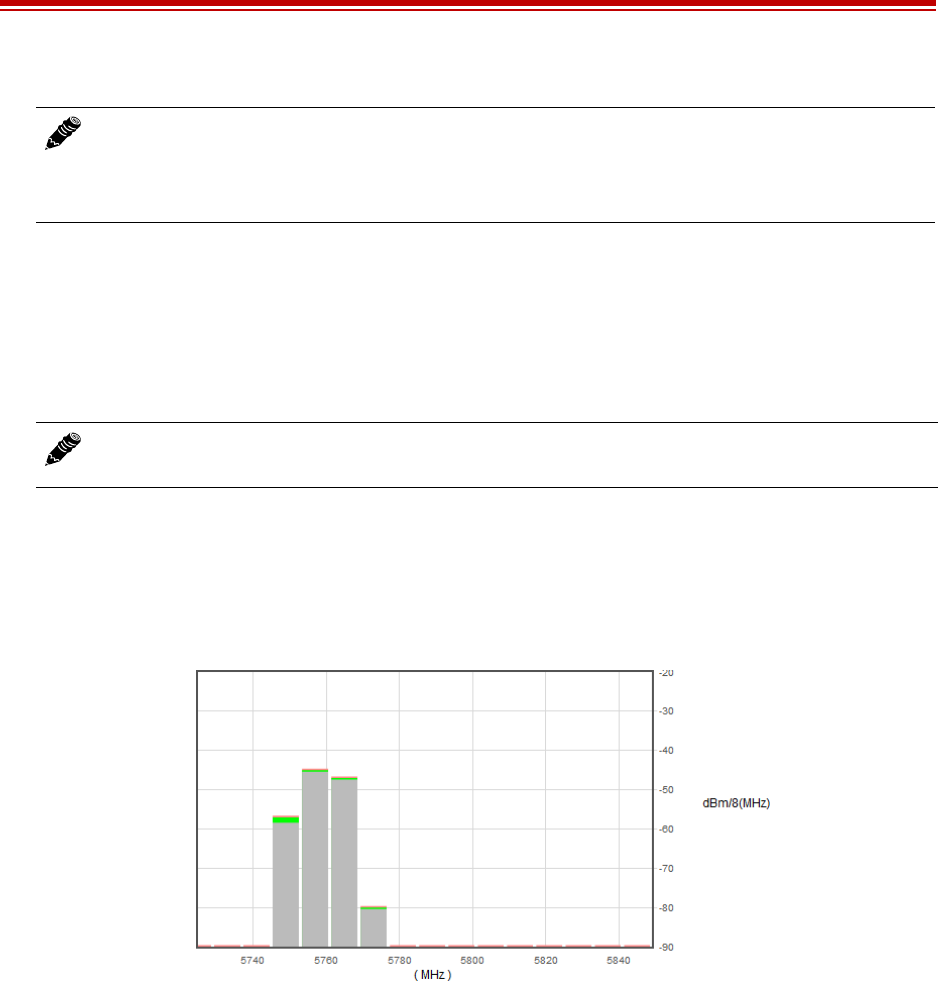
Exalt Installation and Management Guide
ExtendAir (TDD) Series Digital Microwave Radios
82 203591-011
2013-02-22
Use the smallest step size to obtain the finest view of the spectrum. The spectrum analyzer can be set
to match the start and stop frequency for a dwell mode. Peak and average detection modes are also
available. Peak detection is helpful for capturing intermittent events such as pulsed emissions.
It is best to set the Scan Time option to a time value as opposed to using the ‘infinity’ setting. If your
management computer is connected to the radio through the radio link, access to the GUI is interrupted
during the duration of the analysis.
The spectrum analyzer graph displays received signals in red, green or grey (Figure 52), normalized in
dBm to the resolution bandwidth of the analyzer. Red indicates a peak hold function. This is the
highest level detected during the entire scan. Green indicates the last value measured at that frequency.
Grey indicates the lowest value detected during the entire scan. Mouse over an area to view the details
above the graph.
Figure 52 Spectrum analyzer graph example
A completely grey vertical box indicates that the signal maintained a steady level for the entire scan. A
mostly green box indicates that the last scan measured at a strong or stronger level than the rest of the
analysis. A completely red vertical box indicates that there was a signal at some point during the scan,
but that the signal was not detected at the last scan. A graph displaying green on the lower part and red
at the upper part indicates that at some time during the scan, a signal was detected at a higher level than
was detected during the last scan.
The last spectrum analyzer scan performed displays in this page until the radio is rebooted. You can do
a screen capture for record keeping and for comparison to future analyses. The time and date of the
analysis displays on the page, which is handy as a reference in a screen capture.
Note: Enabling the spectrum analyzer interrupts all radio traffic for the duration of the
analysis. In addition, access to the radio’s GUI may also be interrupted, depending on the
location of the interfaced computer relative to the radio where the spectrum analysis is
occurring. The GUI is available at the completion of the spectrum analysis.
Note: The result of selecting infinity may be complete loss of contact to that radio and may
require a physical visit to the radio location to disable the spectrum analyzer.
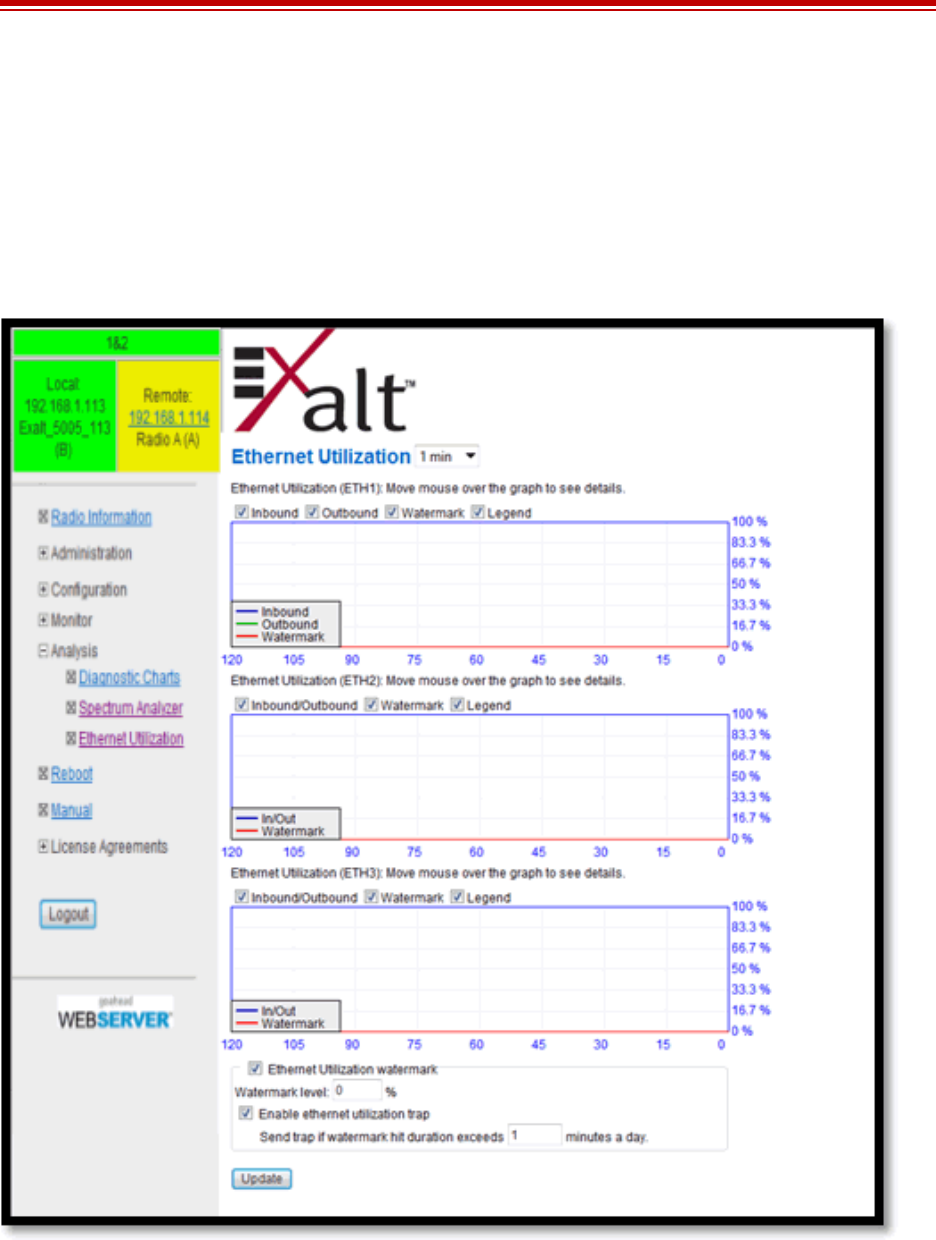
Exalt Installation and Management Guide
ExtendAir (TDD) Series Digital Microwave Radios
203591-011 83
2013-02-22
Ethernet Utilization Page
This page shows a chart for each Ethernet interface to illustrate inbound and outbound packet
utilization. This is shown as a percentage of the interface configuration (that is, if your interface is set
for 100BaseT, then 100% represents 100Mbps. Compare offered load (inbound) to delivered load
(outbound) to determine if radio capacity is a bottleneck for the data transfer. This chart can illustrate
inbound and/or outbound utilization, and uses different colors for data entry. The legend can be
hidden.
Figure 53 Ethernet Utilization page
Note that the outbound utilization never exceeds the rate where a radio is configured. For example, if
the radio is configured for a 55 Mbps capacity, outbound utilization will never exceed 55 Mbps at
100BaseT.

Exalt Installation and Management Guide
ExtendAir (TDD) Series Digital Microwave Radios
84 203591-011
2013-02-22
The watermark level function allows administrators to receive an SNMP trap when watermark
conditions are exceeded. For example, if a radio is configured for 55 Mbps capacity, the administrator
may wish to be warned if the radio exceeds 50 Mbps for more than 1 hour per day. In this case, set the
watermark level to 50% and the trap duration to 60 minutes. Traps must be enabled for this function to
be active.
When the watermark level function is enabled, a line on the chart appears for data comparison to the
watermark.
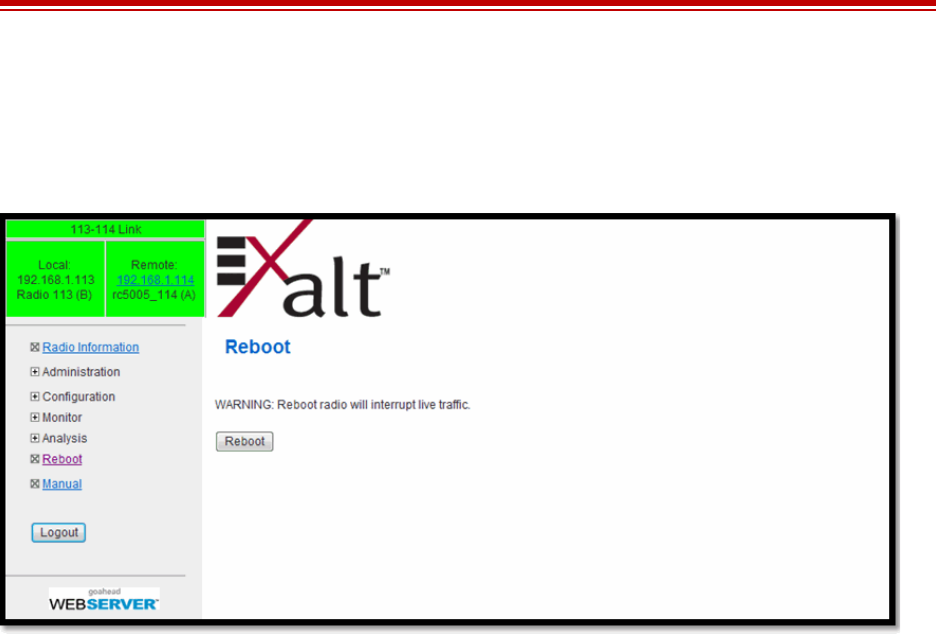
Exalt Installation and Management Guide
ExtendAir (TDD) Series Digital Microwave Radios
203591-011 85
2013-02-22
Reboot Page
Use this page to reboot the radio. The function may never be required, but can be used in emergencies.
All configurations that require a reboot automatically reboot on administrator confirmation.
Figure 54 Reboot page
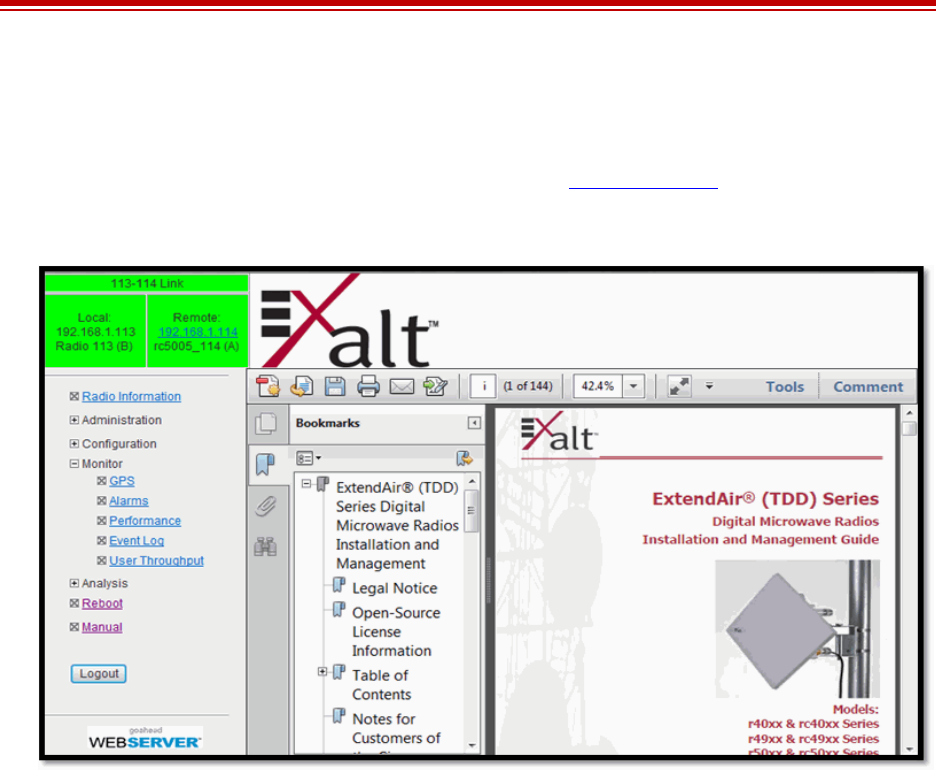
Exalt Installation and Management Guide
ExtendAir (TDD) Series Digital Microwave Radios
86 203591-011
2013-02-22
Manual Page
The manual (this document or the version that matches the installed firmware) is available within the
GUI. Adobe Acrobat Reader 5.5 or higher is required (go to www.adobe.com to download Acrobat
Reader). Click the Manual link to display the manual within the browser window. Once the manual
displays, click the save button on the PDF toolbar to download the manual locally.
Figure 55 Manual page

Exalt Installation and Management Guide
ExtendAir (TDD) Series Digital Microwave Radios
203591-011 87
2013-02-22
Specifications
This section presents specifications for the ExtendAir (TDD) Series digital microwave radios.
Physical Specifications
Integrated Antenna Models
Connectorized Antenna Mode (rc models)
Physical Configuration Outdoor unit (ODU)
Dimensions (H x W x D) 13.3 x 13.3 x 4.5 inches / 33.8 x 33.8 x 11.4 cm
Weight 7 lbs., 3.18 kg
Operating Temperature –40 to +149°F /–40 to +65°C;
Altitude 15,000'/4.6 km
Humidity 100% condensing
Environmental NEMA4/IP66
Physical Configuration Outdoor unit (ODU)
Dimensions (H x W x D) 9.4 x 9.4 x 5.25 inches / 23.9 x 23.9 x 13.34 cm
Weight 6 lbs. 2.72 kg
Operating Temperature –40 to +149°F /–40 to +65°C;
Altitude 15,000'/4.6 km
Humidity 100% condensing
Environmental NEMA4/IP66

Exalt Installation and Management Guide
ExtendAir (TDD) Series Digital Microwave Radios
88 203591-011
2013-02-22
Common System Specifications
Tuning Resolution 1MHz; 5MHz for some regulatory domains
Power Control Step Size 0.5dB
Selectable Modulation Modes Mode 1 (QPSK); Mode 2 (16QAM), Mode 3 (64QAM)
Selectable Frame Lengths (ms) 0.5, 1, 2, 2.5, 4, 5
Maximum Aggregate User Capacity
Error Floor 10-12
Frequency Stability +7 ppm
Link Security 96-bit Security Code, optional NIST FIPS-197 compliant
128-bit or 256-bit AES encryption
Mbps Mode 1 Mode 2 Mode 3
8/10MHz 13 26 38
16/20MHz 27 55 81
32/40 MHz 55 109 162

Exalt Installation and Management Guide
ExtendAir (TDD) Series Digital Microwave Radios
203591-011 89
2013-02-22
System Specifications, 4.9GHz Band
Frequency Band 4.940–4.990 GHz
Output Power (at full power) +24dBm, Mode 1
+21dBm, Mode 2
+19dBm, Mode 3
Output Power (at minimum power) 0dBm
Selectable Channel Bandwidths 10MHz, 20MHz, 40MHz
Receiver Threshold (BER=10–6)
Maximum RSL 0dBm no damage
Mode 1: –25dBm error-free
Mode 2 & Mode 3: –30dBm error-free
dBm Mode 1 Mode 2 Mode 3
10MHz –86 –79 –73
20MHz –83 –77 –71
40MHz –80 –74 –68

Exalt Installation and Management Guide
ExtendAir (TDD) Series Digital Microwave Radios
90 203591-011
2013-02-22
System Specifications, 4.9GHz Band
Frequency Band 4940–4990MHz
Tunable Range 4945–4985MHz
Output Power (at full power) +21dBm, Mode 1
+18dBm, Mode 2
+16dBm, Mode 3
Output Power (at minimum power) 0dBm
Selectable Channel Bandwidths 10MHz, 20MHz, and 40MHza
a. Consult your country’s regulations or Exalt Communications to determine if 40MHz is allowed for
your application.
Receiver Threshold (BER=10–6)
Maximum RSL 0dBm no damage
Mode 1: –25dBm error-free
Mode 2 and Mode 3: –30dBm error-free
Non-overlapping channels 10MHz: 5; 20MHz: 2; 40MHz: 1
dBm Mode 1 Mode 2 Mode 3
10MHz –86 –79 –73
20MHz –83 –76 –70
40MHz –80 –73 –67

Exalt Installation and Management Guide
ExtendAir (TDD) Series Digital Microwave Radios
203591-011 91
2013-02-22
System Specifications, 5.3GHz Band
Frequency Band 5250–5350MHz
Tunable Range 5260–5332MHz
Output Power (at full power) +22dBm, Mode 1 (QPSK); +20dBm 8/10MHz BW
+22dBm, Mode 2 (16 QAM)
+20dBm, Mode 3 (64 QAM)
Output Power (at minimum power) 0dBm
Selectable Channel Bandwidths 8/10MHz, 16/20MHz, 32/40MHz
Receiver Threshold (BER=10–6)
Maximum RSL 0dBm no damage
Mode 1: –25dBm error-free
Mode 2 and Mode 3: –30dBm error-free
Non-overlapping channels 8/10MHz: 10; 16/20MHz: 5; 32/40MHz: 2
dBm Mode 1 Mode 2 Mode 3
8/10MHz –86 –79 –73
16/20MHz –83 –76 –70
32/40MHz –80 –73 –67

Exalt Installation and Management Guide
ExtendAir (TDD) Series Digital Microwave Radios
92 203591-011
2013-02-22
System Specifications, 5.4GHz Band
Frequency Band 5470–5725 MHz
Tunable Range 5488–5715 MHz
Output Power (at full power) +22dBm, Mode 1 (QPSK); +20dBm 8/10MHz BW
+22dBm, Mode 2 (16 QAM)
+20dBm, Mode 3 (64 QAM)
Output Power (at minimum power) 0dBm
Selectable Channel Bandwidths 8/10MHz, 16/20MHz, 32/40MHz
Receiver Threshold (BER=10–6)
Maximum RSL 0dBm no damage
Mode 1: –25dBm
Mode 2 and Mode 3: –30dBm
Non-overlapping channels 8/10MHz: 29; 16/20MHz: 14; 32/40MHz: 7
dBm Mode 1 Mode 2 Mode 3
8/10MHz –86 –79 –73
16/20MHz –83 –75 –70
32/40MHz –80 –72 –67

Exalt Installation and Management Guide
ExtendAir (TDD) Series Digital Microwave Radios
203591-011 93
2013-02-22
System Specifications, 5.8GHz Band
Frequency Band 5725–5850 MHz
Tunable Range 5731–5844 MHz
Output Power (at full power) +24dBm, Mode 1 (QPSK); +20dBm 8/10MHz BW
+22dBm, Mode 2 (16 QAM)
+20dBm, Mode 3 (64 QAM)
Output Power (at minimum power) 0dBm
Selectable Channel Bandwidths 8/10MHz, 16/20MHz, 32/40MHz
Receiver Threshold (BER=10–6)
Maximum RSL 0dBm no damage
Mode 1: –25dBm
Mode 2 and Mode 3: –30dBm
(dBm) Mode 1 Mode 2 Mode 3
8/10MHz –86 –79 –73
16/20MHz –83 –76 –70
32/40MHz –80 –73 –67

Exalt Installation and Management Guide
ExtendAir (TDD) Series Digital Microwave Radios
94 203591-011
2013-02-22
Interfaces
RF
TDM (TDM models only)
Ethernet (1 interface on xx00 models, 3 interfaces on xx05 models)
Sync-In Sync-Out
Power — DC Power Injector (sold separately)
Power — AC adapter/injector (sold separately)
Integrated Antenna (r models only)
Connector N-type female
Impedance 50 Ohms
Connector RJ-45 (RJ48C), female
T1 Impedance 100 Ohms, balanced
T1 Line Codes AMI, B8ZS, selectable
T1 LBO Settings (in ft.) 0–133, 133–266, 266–399, 399–533, 533–655
T1 Clocking Speed 1.544 Mbps
T1 Compliance ANSI T1.102-1987; ITU-T; G.823; GR-49T-CORE
E1 Impedance 120 Ohms, balanced
E1 Line Codes HDB3
E1 Clocking Speed 2.048 Mbps
E1 Compliance CEPT-1; G.703; ITU-T-G703
Connectors RJ-45, female, auto-MDIX
Interface Speed 10 or 100 Mbps
Duplex Half, full, auto, selectable
Compliance 802.3
Connector RJ-45, female
Signal 1pps (GPS or Internal Sync signal)
Connector 6-pin barrier strip
Input Voltage 48VDC
Consumption <25 W (0.6A)
Input 100–240VAC, 0.5A
Output 40W, 56VDC
Gain (midband) 23dBi
3dB Beamwidth 10 degrees
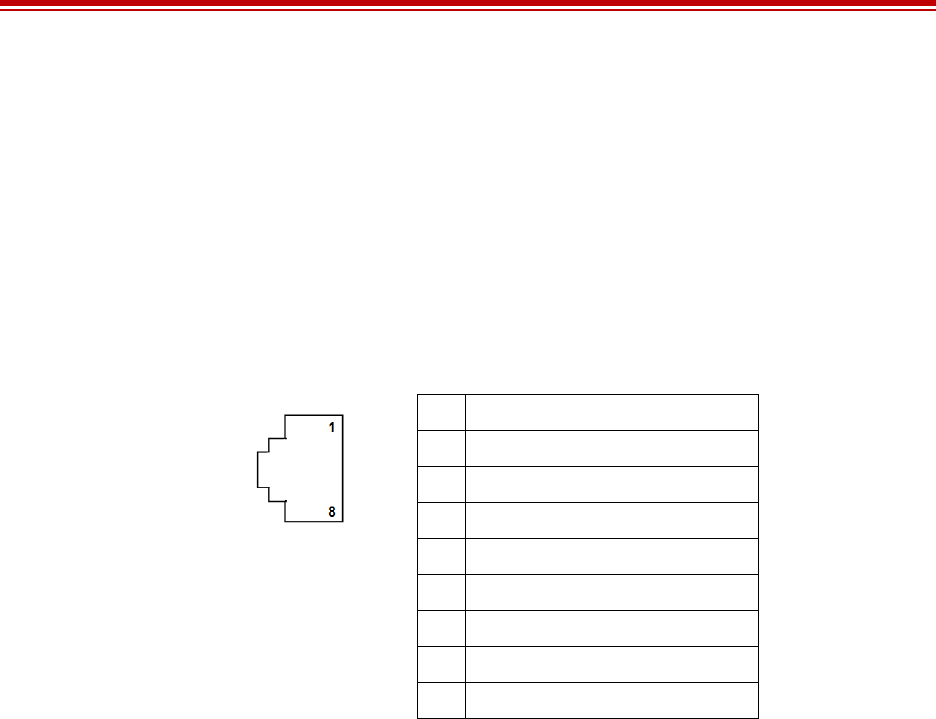
Exalt Installation and Management Guide
ExtendAir (TDD) Series Digital Microwave Radios
203591-011 95
2013-02-22
Interface Connections
This section provides the pin number assignment and wiring information for the connectors on the
ExtendAir (TDD) Series radios. All connectors are shown as viewed from the radio rear panel,
oriented with the PoE connector at the lower left corner.
TDM Connections
There are two connectors for TDM; each connector has two TDM circuits available. Figure 56
illustrates the pin orientation and functionality of these connectors. These connectors are disabled on
the IP version radios.
Figure 56 TDM connectors
RSL/Sync Connector
This connector can be used during the antenna alignment process, to provide a received signal level
(RSL) voltage to a voltmeter. The connector is also used for connection to an optional Exalt GPS
antenna for the purposes of GPS synchronization, or used to send or receive sync signals to a
collocated radio, or to an ExaltSync Collocation Kit, for multiple radio sync. Figure 57 illustrates the
pin orientation and functionality for this connector.
Pin Function
1 Tip Out (from radio) – Ch.1 & 2
2 Ring Out (from radio) – Ch.1 & 2
3 Tip Out (from radio) – Ch.3 & 4
4 Tip In (to radio) – Ch.1 & 2
5 Ring In (to radio) – Ch.1 & 2
6 Ring Out (from radio) – Ch.3 & 4
7 Tip In (to radio) – Ch.3 & 4
8 Ring In (to radio) – Ch.3 & 4
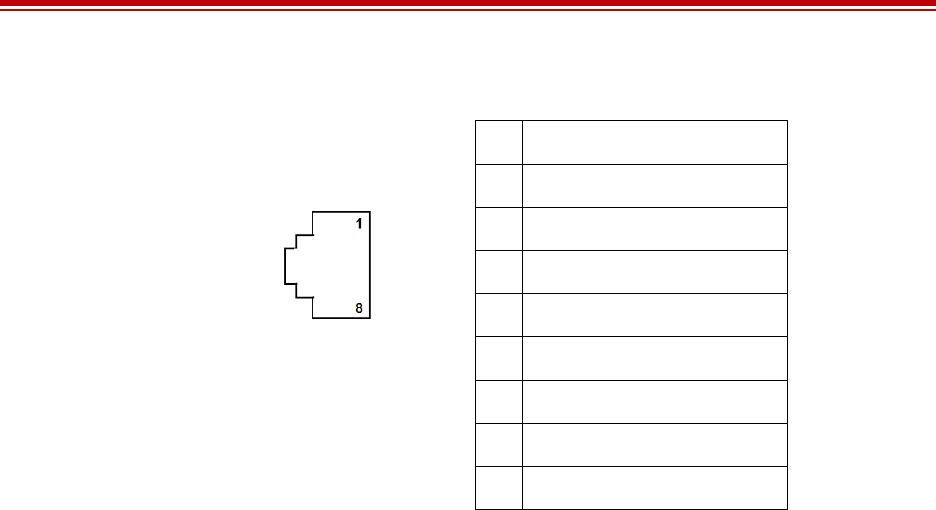
Exalt Installation and Management Guide
ExtendAir (TDD) Series Digital Microwave Radios
96 203591-011
2013-02-22
Figure 57 RSL & Sync In/Sync Out connector
Two Radio Internal Sync Out/In
If using the Internal Sync Out/In function between two radios only, connect Pin 8 from the Sync Out
radio to Pin 6 of the Sync In radio and use a straight connection for Pin 2. Connect no other pins. To
ease the need to keep track of which end of the cable is for In and Out, consider cross-connecting Pins
6 and 8, with a straight connection for Pin 2. Connect no other pins.
Sync Distribution Accessory
If using a sync distribution accessory (sold separately), connect CAT5e cabling straight from the radio
Sync connector(s) to the accessory.
Power/Ethernet Connector
This connector is the primary connector on the radio, and must be connected to provide power to the
radio, and primary Ethernet communications for traffic and Ethernet. Figure 58 illustrates the pin
orientation and functionality for this connector.
The Ethernet cable between the PoE injector (or integrated AC/injector) must be wired as a straight
connection. The wiring follows typical wiring for Power-over-Ethernet (PoE), however the power
consumption requirement for the ExtendAir (TDD) Series radio does not allow for ‘standard’ (802.3af)
PoE, and only the Exalt power injector shall be used. In addition, the Exalt power injector provides
critical reset and alarm capability that would not be available from a generic PoE injector, even if the
power consumption requirement is met.
Pin Function
1 +5V out to GPS antenna
2Ground
3 Tx Data to GPS antenna
4 Enable signal to GPS antenna
5 Rx Data from GPS antenna
6 Sync input signal
7 Received Signal Level (RSL)
8 Sync output signal
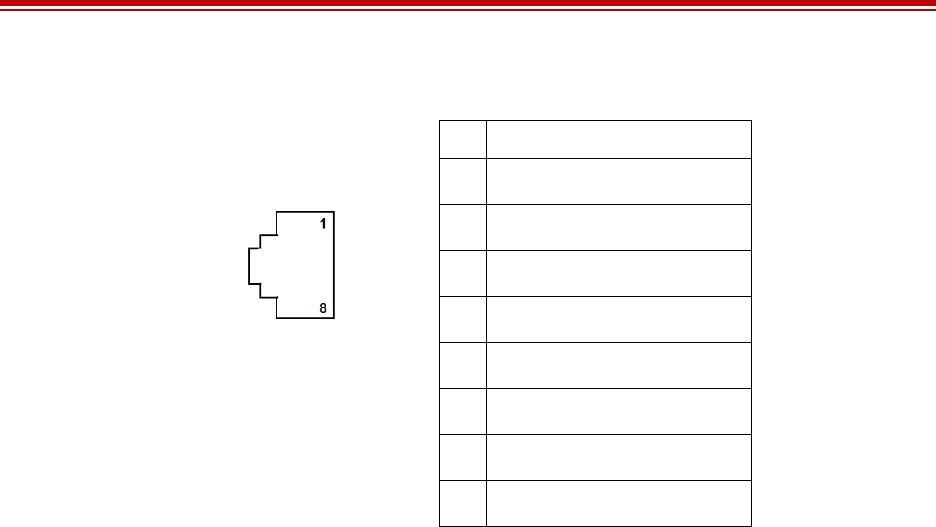
Exalt Installation and Management Guide
ExtendAir (TDD) Series Digital Microwave Radios
203591-011 97
2013-02-22
Figure 58 Power/Ethernet connector
Pin Function
1 Paired with Pin 2
2 Paired with Pin 1
3 Paired with Pin 6
4 +DC Power (48V) In
5 +DC Power (48V) In
6 Paired with Pin 3
7 -DC Power (48V) In
8 -DC Power (48V) In

Exalt Installation and Management Guide
ExtendAir (TDD) Series Digital Microwave Radios
98 203591-011
2013-02-22
Antennas
Table 7 lists antennas supported by the ExtendAir (TDD) Series for use in the USA. In some countries,
antennas exceeding a certain level of gain may be unlawful. Refer to RF Output Power Setting for
details on regulatory limits.
Table 7 5GHz Antennas
Manufacturer Model Number Type Size/Diameter Polarization Gain (dBi)
MTI MT-485049/NVH Panel 1 ft Dual 23
MTI MT-485025/ND Panel 1 ft Dual 23
General Dynamics EPD1-52 Panel 1 ft Single 23
Mars MA-WA58-1XMNTB Panel 1 ft Single 23
MTI MA-WA56-DP25N Panel 1 ft Dual 23.5
RadioWaves FPD1-5-24 Panel 1 ft Dual 23.8
ARC PD5823B88 Panel 1 ft Dual 24
Laird PA58-24 Panel 1 ft Single 24
Laird R2T58-24 Panel 1 ft Single 24
RadioWaves FP1-5-24 Panel 1 ft Single 24.2
Mars MA-WA56-DP25NB Panel 1 ft Dual 25
Mars MA-WA55-27B Panel 1 ft Single 26
CommScope UBP600-4-1 Panel 2 ft Single 27.5
MTI MT-466010/NVH Panel 2 ft Dual 28
General Dynamics EPD2-52 Panel 2 ft Single 28
RadioWaves FP2-5-28 Panel 2 ft Single 28
MTI MA-QA56-DP28NB Panel 2 ft Dual 28.5
MTI MT-486013/NVH Panel 2 ft Dual 29
Laird GD5W-25P Grid Parabolic Dish 2 ft Single 25
Laird GD53-25 Grid Parabolic Dish 2 ft Single 25
Laird GD57-25 Grid Parabolic Dish 2 ft Single 25
Laird HDGD58-26 Grid Parabolic Dish 2 ft Single 26
Laird GD58-26 Grid Parabolic Dish 2 ft Single 26
Commscope 28T-5801-1 Grid Parabolic Dish 3 ft Single 27

Exalt Installation and Management Guide
ExtendAir (TDD) Series Digital Microwave Radios
203591-011 99
2013-02-22
Laird GD53-28 Grid Parabolic Dish 3 ft Single 28
Laird GD57-28 Grid Parabolic Dish 3 ft Single 28
Laird GD5W-28P Grid Parabolic Dish 3 ft Single 28
CommScope UBG600-4-1 Grid Parabolic Dish 3 ft Single 28.5
Laird GD58-29 Grid Parabolic Dish 3 ft Single 29
Laird HDGD58-29 Grid Parabolic Dish 3 ft Single 29
RadioWaves G3-5.2 Grid Parabolic Dish 3 ft Single 31.1
Wireless Beehive 5.8DP-26 Solid Parabolic 1.5 ft Dual 26
PC Tel MPRC2449 Solid Parabolic 2 ft Single 27.7
L-Com HG4958DP-30D Solid Parabolic 2 ft Dual 28
General Dynamics HQFD2-52 Solid Parabolic 2 ft Dual 28.1
PC Tel MPRD2449 Solid Parabolic 2 ft Dual 28.1
General Dynamics QFD2-52 Solid Parabolic 2 ft Dual 28.4
General Dynamics HQF2-52 Solid Parabolic 2 ft Single 28.5
General Dynamics QF2-52 Solid Parabolic 2 ft Single 28.5
L-Com HG5158DP-29D Solid Parabolic 2 ft Dual 28.5
RadioWaves HPD2-5.2 Solid Parabolic 2 ft Dual 28.6
CommScope HPX2F-52 Solid Parabolic 2 ft Dual 29
Laird HDDA5W-29-DP Solid Parabolic 2 ft Dual 29
Laird HDDA5W-29-SP Solid Parabolic 2 ft Single 29
RadioWaves SPD2-5.2 Solid Parabolic 2 ft Dual 29
RadioWaves SP2-5.2 Solid Parabolic 2 ft Single 29
Wireless Beehive 5.8DP-29 Solid Parabolic 2 ft Dual 29
CommScope P2F-57W Solid Parabolic 2 ft Single 29.3
CommScope P2F-52 Solid Parabolic 2 ft Single 29.4
CommScope PX2F-52 Solid Parabolic 2 ft Dual 29.4
ARC Wireless DA5830SD1 Solid Parabolic 2 ft Dual 30
Table 7 5GHz Antennas
Manufacturer Model Number Type Size/Diameter Polarization Gain (dBi)

Exalt Installation and Management Guide
ExtendAir (TDD) Series Digital Microwave Radios
100 203591-011
2013-02-22
PC Tel MPRC3649 Solid Parabolic 3 ft Single 30.4
L-Com HG4958DP-34D Solid Parabolic 3 ft Dual 31
PC Tel MPRD3649 Solid Parabolic 3 ft Dual 31
Wireless Beehive 5.8DP-31 Solid Parabolic 3 ft Dual 31
General Dynamics QFD2.5-52 Solid Parabolic 2.5 ft Dual 31.1
General Dynamics QF2.5-52 Solid Parabolic 2.5 ft Single 31.1
RadioWaves HPD3-5.2 Solid Parabolic 3 ft Dual 31.1
General Dynamics HQFD2.5-52 Solid Parabolic 2.5 ft Dual 31.2
RadioWaves HP2-5.2 Solid Parabolic 2 ft Single 31.4
RFS Cablewave SPF3-52CN1S Solid Parabolic 3 ft Single 31.4
Laird HDDA5W-32 Solid Parabolic 3 ft Single 32
Laird HDDA5W-32-DP Solid Parabolic 3 ft Dual 32
L-Com HG5158DP-32D Solid Parabolic 3 ft Dual 32
RadioWaves SPD3-5.2 Solid Parabolic 3 ft Dual 32.5
RadioWaves HP3-5.2 Solid Parabolic 3 ft Single 32.5
RadioWaves SP3-5.2 Solid Parabolic 3 ft Single 32.5
CommScope PX3F-52 Solid Parabolic 3 ft Dual 33.4
CommScope P3F-52 Solid Parabolic 3 ft Single 33.5
RFS Cablewave SDF4-52BN1S1 Solid Parabolic 4 ft Single 33.9
General Dynamics QFD4-52 Solid Parabolic 4 ft Dual 34.1
General Dynamics SSP4-2357A Solid Parabolic 4 ft Single 34.4
RFS Cablewave SPF4-52CN1S1R Solid Parabolic 4 ft Single 34.4
CommScope HPX4F-52 Solid Parabolic 4 ft Dual 34.5
General Dynamics HQF4-52 Solid Parabolic 4 ft Single 34.7
General Dynamics HQFD4-52 Solid Parabolic 4 ft Dual 34.8
General Dynamics QF4-52 Solid Parabolic 4 ft Single 34.8
RadioWaves HPD4-5.2 Solid Parabolic 4 ft Dual 34.8
Table 7 5GHz Antennas
Manufacturer Model Number Type Size/Diameter Polarization Gain (dBi)

Exalt Installation and Management Guide
ExtendAir (TDD) Series Digital Microwave Radios
203591-011 101
2013-02-22
CommScope P4F-52 Solid Parabolic 4 ft Single 34.9
CommScope PX4F-52 Solid Parabolic 4 ft Dual 34.9
RadioWaves SP4-5.2 Solid Parabolic 4 ft Single 34.9
RadioWaves SPD4-5.2 Solid Parabolic 4 ft Dual 34.9
RadioWaves HP4-5.2 Solid Parabolic 4 ft Single 34.9
RFS Cablewave DA4-W57BC1S1 Solid Parabolic 4 ft Single 35.5
RadioWaves SP6-57 Solid Parabolic 6 ft Single 35.8
General Dynamics QFD6-52 Solid Parabolic 6 ft Dual 37.4
CommScope P6F-52 Solid Parabolic 6 ft Single 37.6
CommScope PX6F-52 Solid Parabolic 6 ft Dual 37.6
General Dynamics HQFD6-52 Solid Parabolic 6 ft Dual 37.8
General Dynamics QF6-52 Solid Parabolic 6 ft Single 37.8
CommScope PARX6-59 Solid Parabolic 6 ft Dual 37.9
RadioWaves HP6-5.2 Solid Parabolic 6 ft Single 37.9
RadioWaves HPD6-5.2 Solid Parabolic 6 ft Dual 37.9
RadioWaves SP6-5.2 Solid Parabolic 6 ft Single 37.9
RadioWaves SPD6-5.2 Solid Parabolic 6 ft Dual 37.9
Table 7 5GHz Antennas
Manufacturer Model Number Type Size/Diameter Polarization Gain (dBi)

Exalt Installation and Management Guide
ExtendAir (TDD) Series Digital Microwave Radios
102 203591-011
2013-02-22
Troubleshooting
This section provides information regarding troubleshooting of common issues and alarms on these
radios. Exalt Digital Microwave Radio systems are designed by Exalt’s expert engineers with
extensive experience through multiple generations of microwave radio design. These new-generation
systems contain extensive diagnostic tools, alarm indications, and troubleshooting aids. And, as
compared to other systems in their class, are easier to install, maintain, and troubleshoot. The GUI
provides information to aid in troubleshooting (see Diagnostic Charts Page).
Contact Exalt Customer Care for further assistance with issues with your Exalt radio and with
suggestions on how the radio and documentation can be improved.
General Practices
Troubleshooting a microwave radio link can be a complex task. Approach troubleshooting as a process
of elimination, and first determine which portions of the system are operating properly.
In a vast majority of cases, failures or poor performance of microwave links is attributed to something
other than the microwave radio hardware. In this respect, the back-to-back bench test (see Back-to-
back Bench Testing) is very important to determine if radio hardware is operating properly and
eliminate many variables in the troubleshooting process.
If a back-to-back bench test fails, then the radio hardware is either broken or the radios are improperly
configured. Upgrade the radio to the most current release of firmware, and/or reset the radio to its
critical factory settings, following the quick start guide instructions and those in Configuration and
Management, helps to confirm if configuration issues cause failure. The most common issues with
microwave radio links are:
•An improperly terminated RF cable
•Multipath propagation
•RF interference
•Path obstruction
•Misaligned antenna
•Faulty antenna
•Improper grounding
•Insufficient link margin in the design/implementation
•Moisture in the transmission system (antenna feed and/or RF cable)
If the radio link has been operating without issues and is exhibiting new poor performance behavior or
becomes completely inoperative, the troubleshooting process should pay close attention to any
conditions that may have changed between the time when the system was working without issue and
the time when the issues started.
Also, it can be helpful to compare some performance parameters of the system before and after the
presence of issues. Often the source of the issues can be determined by thoughtful consideration of
changes, such as:
•Changes in weather, including high winds
•Changes made to the radio equipment, transmission system, or connected equipment
•New radio systems or electronic equipment the nearby radio or transmission system

Exalt Installation and Management Guide
ExtendAir (TDD) Series Digital Microwave Radios
203591-011 103
2013-02-22
•New construction nearby either end of the link, or along the path
•Tree growth, flooded fields, or changes in rivers/lakes along the path
Verify that configurations are set as follows:
•RF matches at each end of the link
•Bandwidth matches at each end of the link
•Link distance matches at each end of the link
•TDD Frame Length matches at each end of the link
•Endpoint Identifier is different at each end of the link (one end Radio A, one end Radio B)
•Ethernet interfaces are enabled, as desired
•AUX Ethernet is set for in-band or out-of-band NMS, as desired
•T1/E1 enabling matches at each end of the link
•Link security key matches at each end of the link
Also, use the ExaltCalc tool in the design phase to determine the optimum setting for the Bandwidth
and TDD Frame Length parameters for the given link distance, and provides guidance to the expected
RF link performance, as well as throughput, latency, and number of supported T1/E1 circuits.
Typical Indications of Issues
In many cases, microwave radio users do not notice changes or degradation to the radio system until
the radio system fails completely or becomes highly errored or significantly intermittent. However,
regular management of the radio system can help indicate changes in performance that have not yet
impacted user performance, but may impact performance at a later date if left unchecked or
unaddressed. The administrator can use this as an opportunity to be proactive and monitor the radio
link performance regularly, watching for unexplained or unexpected changes in performance and
trends in performance changes.
Most importantly, monitoring radio system RSL over time indicates the performance of the radio
system. Address any long-term drop in RSL and erratic or unsteady RSL. Some RSL changes are
expected and weather patterns and the related multipath can cause dramatic RSL changes resulting in
system outage. However, that outage should not occur at a significantly greater rate than the designed
long-term performance. Consult the path design engineer for more information about link reliability
expectations and anticipated RSL deviation.
In addition, regular inspection of the transmission system (RF cables and antennas) and paying close
attention to changes along the path, such as construction or tree height, or new microwave radio
installations nearby, can be extremely helpful and proactive.
When link performance is very poor, alarms on the radio front panel and within the radio’s
management system indicates particular failures. Consult this manual for more information on the
specific alarms and diagnostics, or contact Exalt Customer Care for assistance.
Exalt Customer Care is primarily motivated to determine if the radio hardware is faulty and require
return for repair, and to help execute an effective and efficient repair and return process for radio
terminals believed to be faulty. However, Exalt Customer Care provides advice regarding the total
radio system and RF path engineering and environment, and advises on troubleshooting.
End users should first contact the installer and/or designer of the system. In many cases, an in-depth
understanding of RF design is required, and on-site analysis and special test equipment, may be

Exalt Installation and Management Guide
ExtendAir (TDD) Series Digital Microwave Radios
104 203591-011
2013-02-22
necessary. Compared to phone support from Exalt Customer Care, troubleshooting is much more
expeditious if the professional installer and/or link designer examines the system and reviews the
management information in the GUI. In turn, if the professional installer and/or link designer contacts
Exalt Customer Care, the process to rectify the system is much more expedient due to the in-depth
knowledge related to the implementation and the RF environment.
Improper RF Cable Termination
Improper RF cable termination is a very common problem. In many cases, this is a problem that occurs
during installation and is not a problem that suddenly appears. However, if cables are moved or flexed,
especially near the termination points, and radio errors, changes in RSL, or other performance issues
occur, this is a certain sign of this issue.
Another relatively easy method to test for this condition is to decrease the output power of the radio
system (at each end, one end at a time). A poor RF cable termination may be reflecting too much RF
energy back into the radio system, and reducing output power reduces the reflected energy at a faster
rate than the transmitted energy towards the far end. Be careful not to reduce the output power to the
point where the radio’s threshold is reached. Typically, a reduction of just 3 to 6dB is enough to
determine if this is the issue. If the reduction of output power clears the error condition, this is the
likely cause.
Use a reflectometer or meter that can read VSWR at the operating frequency to identify poor
terminations as well as poor antenna feeds.
Multipath Propagation
Multipath propagation is a term that encompasses changes to the RF path, such as reflections and/or
refraction, causing partial or complete destruction of the radio signal, and thus excessive bit errors and/
or system outages.
Rapid changes in temperature, inversion layers, humidity, air pressure, water evaporation, as well as
standing water or moisture on objects along the path are all examples of changes that can cause
multipath propagation. New building construction near either end of the path or along the path can
cause new reflection characteristics.
If your system has been operating without issue and is suddenly experiencing issues that are
symptomatic of a certain time of day or related to change in climatic events or some of the external
factors listed above, this is likely the cause. Consult a professional RF path engineer in these cases.
Often, minor repositioning of the antennas at either or both ends can reduce or eliminate these
problems.
RF Interference
RF interference is usually indicative of another radio system nearby either end of your radio system or
aimed towards one or both ends of your radio system – usually at or near the same frequency and
usually with a similar signal level.
Other forms of RF interference also exist, such as electronic equipment placed close to the radio
chassis or transmitters that couple onto the cabling or grounding system of the radio. Microwave ovens
and wireless communication devices used near the equipment or cabling are examples of electronic
equipment interference.
Note: The Praxsym VSWR meter is an excellent tool for this purpose.

Exalt Installation and Management Guide
ExtendAir (TDD) Series Digital Microwave Radios
203591-011 105
2013-02-22
RF interference, like most other causes of problems, is indicated by significant bit errors and/or system
outages.
One means to determine presence of interference is the use of a spectrum analyzer that covers the same
range as the radio system. A professional RF engineer can use a spectrum analyzer to locate sources of
interference, measure these sources, and determine potential remedies to take to operate in the
presence of interference.
If a spectrum analyzer is not available, the radio’s RSL port can help determine RSL levels of
interfering signals. By turning the far-end radio off, the residual RSL measured by the radio indicates
the level of interference seen by the radio. It is possible that interference levels below that which can
be measured still have an impact on the radio system – especially if the radio system has low fade
margin or is using a high order modulation.
Exalt Digital Microwave Radios provides considerable flexibility to tune to different frequencies
across the bands within which they operate. This is the easiest method to use to try to avoid existing
interference. In addition, the occupied bandwidth of the radio can be reduced. This, along with re-
tuning, can be very effective, however throughput is reduced.
Repositioning the antenna and/or changing polarization, or upgrading the antenna to a higher gain,
and/or using a high-performance antenna, are all secondary means that can be used. It may be
necessary to perform combinations of both radio changes (retuning, occupied bandwidth reduction)
and antenna system changes (position, polarization, upgrade).
Path Obstruction
A path obstruction is defined as an object, such as a building or tree, impeding the proper path of the
radio system. If the system design was proper at the time of installation and issues arise at a later date,
an updated path profile and survey may be necessary to identify changes in path clearance.
Misaligned Antenna
At the time of initial installation, it is critical that the antennas at each end are properly aligned and that
the designed RSL is achieved. However, antennas may become misaligned due to high winds, changes
in the guy-wiring systems keeping the antenna mast stable, or loosening of the antenna mounting
hardware. A reduction in the RSL of the link is symptomatic of this condition, but this condition is not
the only condition that results in a reduction of RSL. However, if conditions occur where the antenna
alignment may be suspected, the mechanics must be inspected and the antennas realigned.
Faulty Antenna (connectorized antenna rc-models only)
A faulty antenna is rare, but is still a possibility. In some cases, the mechanics of the antenna feed can
get moisture inside, or a bad or weak connection in the pin and connector structure of the antenna may
occur. A VSWR measurement of the antenna connection can be made to verify this condition.
Improper Grounding
In addition to being a potential human safety issue, improper system grounding is a somewhat
common condition that can cause continuous bit errors or bit errors when metal objects come in
Note: Exalt Digital Microwave Radios operate in license-exempt bands. Microwave ovens,
wireless Internet devices and cordless phone technology may also use this frequency band. It
may be necessary to separate the radio chassis, cabling system and antenna from these
devices.

Exalt Installation and Management Guide
ExtendAir (TDD) Series Digital Microwave Radios
106 203591-011
2013-02-22
contact with the radio, transmission system, or racking system. If touching the radio causes errors,
grounding is the cause. It can be difficult to identify grounding problems, but a professional electrician
can normally inspect a system and identify if there are deficiencies in the grounding system.
Insufficient Link Margin
Ideally, the link was designed with enough link margin (fade margin) to allow for multipath
propagation and atmospheric fading and still remain reliable. In some cases, link margin is
compromised by economic factors, such as using low-cost RF cabling or lower-cost antennas that have
less gain or deficient performance compared to higher cost transmission system components. In some
cases, there may be antenna size restrictions that forced the design to not have the desired amount of
link margin.
If the link was designed with poor link margin, there are likely many cases of bit errors and outages.
The antenna system and transmission line can be upgraded to help reduce this. If the link design was
installed with sufficient margin, but RSL is reduced, the remaining link margin may no longer be
enough to maintain a reliable link. The causes of RSL reduction were previously described, but are
usually due to new path obstruction(s) or antenna misalignment due to wind or mechanical factors. The
antenna height or location can be changed to overcome new obstructions. Realignment of the antenna,
and/or improvement to mechanical structures can help overcome antenna misalignment.
Moisture in the Transmission System
If the connectors on cables and antennas and egress junctions are not properly weatherproofed,
moisture can get into the transmission system and cause significant error conditions and erratic
performance. In many cases, the transmission system must be replaced. A VSWR meter is one means
to identify such issues. Conduct physical inspections often. If changes to the weatherproofing (such as
cracking) are noticed, replace the weatherproofing before leakage occurs.
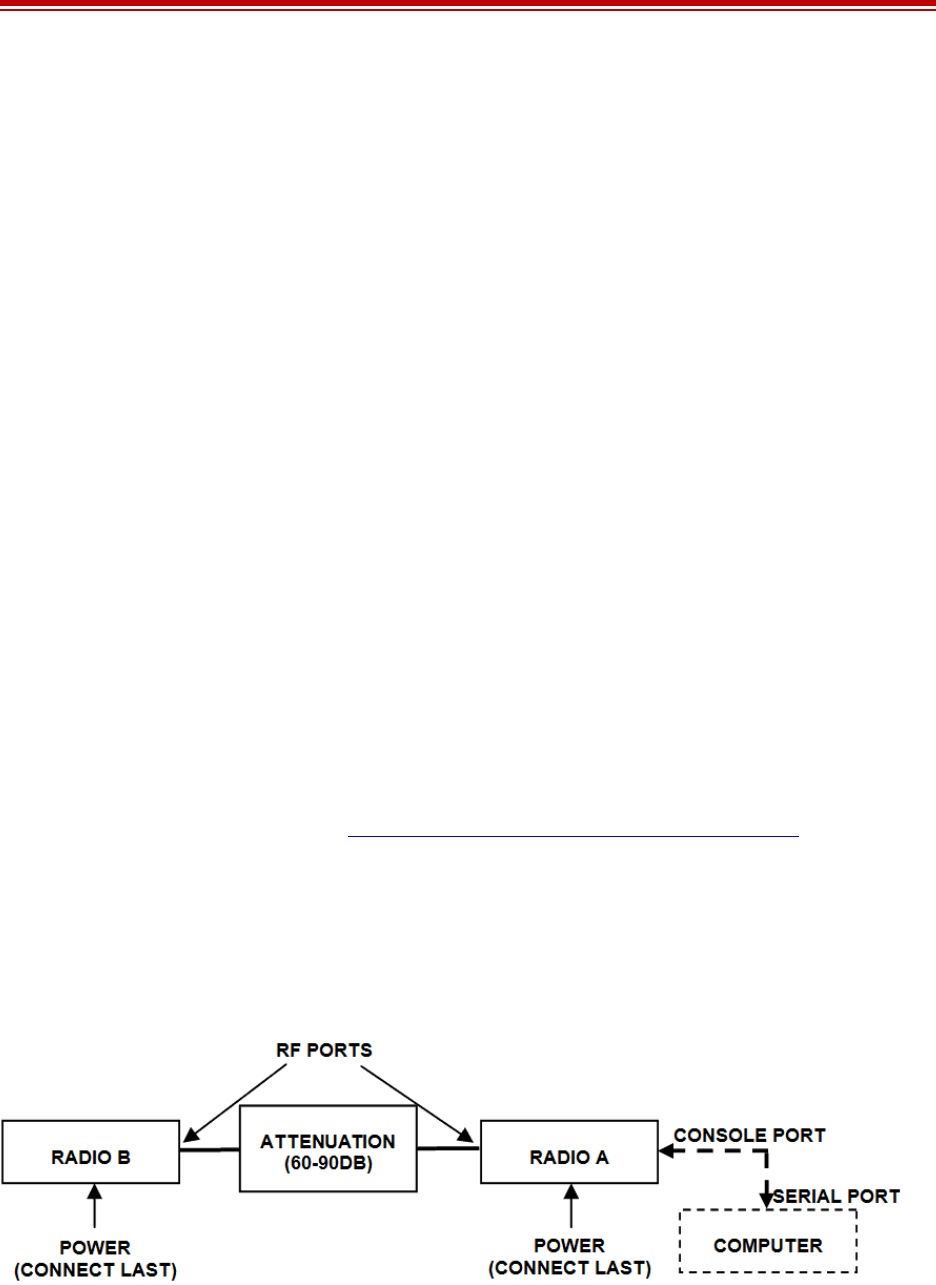
Exalt Installation and Management Guide
ExtendAir (TDD) Series Digital Microwave Radios
203591-011 107
2013-02-22
Back-to-back Bench Testing
Use back-to-back bench testing to test the radio before installation, pre-configure the radio and
connected equipment before installation, or in the troubleshooting process to identify if the radio
hardware is the source of a system issue. It is a critical process, and often required or highly desirable
for any installation or troubleshooting exercise. This section describes how to properly configure the
radio hardware and accessories for a proper back-to-back bench test.
For radio testing, there are two types of back-to-back configurations:
1Basic test (test general operation)
2Specification performance verification
Basic Test
The basic test is a simple test of radio functionality. It verifies that the radios are properly configured to
communicate to one another, and verifies general radio performance as operational.
For the basic test, the following items are needed:
•Radio pair
•Powering source
•RF interconnect cable(s) (any length – short is best)
•Fixed or variable attenuation, between 60 and 90dB (note: attenuation for basic test does not to be
calibrated or precise)
•Computer/terminal with either serial or Ethernet port (helpful, but not necessary)
– If no computer is available, use the temporary hardware configuration key or DIP switch,
depending on radio model (see Initial Configuration and Back-to-Back Bench Test)
Connect the items as follows:
1Connect attenuation and (known-good) RF cable(s) between radio pair, shown in Figure 59.
2Configure one radio as Radio A; the other as Radio B
3Power on radio pair
Figure 59 Basic back-to-back bench test configuration
After connecting and powering on, observe the front panel LEDs to verify that the LINK and STATUS
LEDs are green. If so, the radios are communicating and all radio-related alarm conditions are normal.

Exalt Installation and Management Guide
ExtendAir (TDD) Series Digital Microwave Radios
108 203591-011
2013-02-22
It can be beneficial to have a computer to verify configuration in case of red LEDs or to pre-configure
the radio as desired for operation. Follow the instructions in Configuration and Management.
Specification Performance Verification
The specification performance verification is a more detailed test that allows you to verify that the
radio’s output power and threshold specifications are being met. This is typically a test that would only
be performed in a troubleshooting scenario, but can be performed before installation to provide a
detailed record or ensure radio performance before installation.
This test is identical to the basic test, but in place of the fixed attenuation, it requires the use of
calibrated variable attenuation, or a set of calibrated fixed attenuators, or a combination of both, adding
to a total attenuation value of 120dB, as measured at the operating frequency of the radio. In addition,
a volt meter or computer is also required.
Connect the system as shown in Figure 59, using the combination of fixed and variable attenuation
between the radio’s RF ports. Connect the volt meter to either radio’s RSL test point and associated
reference ground connection.
In this test, it is desirable to use pre-tested RF cables, known to be good, and the insertion loss is
known at the operating frequency. If the cables are short (6'/2m or less), you can estimate the loss,
including connectors, to be less than 1dB each. The estimate of cable loss is critical to the overall
confidence of the measurements made in this test.
There are two critical specifications that can be tested in this configuration:
•RF output power
•Radio receiver threshold
To measure transmitter output power, simply insert any value of attenuation between the radios
between 60 and 90dB. Ensure that both RF output power settings are at maximum. Use the volt meter
to measure RSL in both directions. The RSL measured value should match the appropriate value
according to the inserted attenuation, such as:
RSL = RF Output Power – cabling losses – total attenuation
Verify output power by adjusting output power using the Exalt GUI (in administration mode) and
evaluate the corresponding change to the RSL measurement.
For threshold testing, the key is to insert a measured amount of loss that is close to, but not exceeding
the radio’s specified system gain. System gain is the difference between RF output power and receiver
threshold. At your selected modulation and bandwidth settings, determine the specified threshold
performance, and choose a value of attenuation (including cable losses) that adds to roughly 5 to 15dB
less than the system gain.
For example, if the threshold for your measurement is -85dBm, the output power is +27dBm, so the
system gain is 112dB. Choose a value of total attenuation in the range of roughly 100–105dB. Once
this attenuation is inserted, verify RSL readings as in the first step, and then, using the GUI, reduce
radio output power in 1dB steps until the receiving radio (the one whose output power not being
adjusted) Link LED turns from green to yellow. This indicates that threshold has been reached. At this
point, verify the equation for system gain using the new output power level setting and verify that the
threshold performance is meeting or exceeding the published specification.
Note: Due to the variation of measurements and accuracies involved in this test, you may
read a measurement that is 1dB to as much as 2dB off of the expected value. It should be of
no concern unless the value is more than 3dB worse than expected.

Exalt Installation and Management Guide
ExtendAir (TDD) Series Digital Microwave Radios
203591-011 109
2013-02-22
General Compliance and Safety
The usage of radio transmission devices is subject to specific regulatory requirements governed by
regional legislation. In most cases, the specific device must be authorized for use in a given country
and must be installed and adjusted in accordance with specific radio-frequency settings and in a
manner that has been authorized specific to the device itself in accordance with the specific location of
the device. Some users may be completely or partially restricted from use of the device. Please consult
local governmental agency/agencies for regulatory requirements before use, or contact Exalt or your
Exalt authorized dealer for assistance.
Do not modify this device in any way without the express written consent of Exalt. Modification voids
the manufacturer warranty, and may also be illegal in accordance to government regulations. In
addition, there are no user-serviceable parts or assemblies inside the product housing. There may also
be voltages, signals, and mechanisms within the device that could be harmful to human safety.
The mounting of this device and associated peripherals and connections (inclusive of antenna mast,
antenna, cabling, egress, lightning protection devices, grounding, power, and so on) may be subject to
regional requirements for health and human safety. A qualified professional installer and an electrician
are highly recommended, and may be required by law.

Exalt Installation and Management Guide
ExtendAir (TDD) Series Digital Microwave Radios
110 203591-011
2013-02-22
Dynamic Frequency Selection
Dynamic Frequency Selection (DFS) may be required by regional regulation in some frequency bands
to avoid causing interference to radar systems. Prior to the start of any transmission, devices equipped
with DFS monitor the spectrum and are not permitted to transmit on any frequency in use for radar
transmissions for a period of 30 minutes, during which time the frequency will not be available and the
link will be dropped.
During operation of the device, the spectrum is continually monitored by DFS to detect radar
transmissions on the operating frequency. If radar transmissions are detected, the device must drop the
channel within a specified time period so as not to cause interference with the radar transmission.
Devices equipped with DFS are required to stay off that part of the spectrum for a minimum of 30
minutes, after which time the device may then re-check the spectrum for radar transmissions and begin
transmitting if no radar is detected.
Enable Automatic Channel Switching to automate a search for frequencies without radar interference.
Note that DFS adds a one-minute wait time per channel switch. See Automatic Channel Selection
(ACS) Page.
The FCC (the Commission), NTIA, FAA, and industry are working to resolve interference to Terminal
Doppler Weather Radar (TDWR) systems used near airports that occurs from some outdoor wireless
systems operating in the 5470–5725 MHz band. These wireless devices are subject to Section 15.407
of FCC rules: When operating as a master device they must implement radar detection and DFS
functions. The Commission is continuing to develop long-term equipment authorization test
procedures to ensure that the devices comply, including protecting TDWR operations. In the interim,
the Commission now allows wireless master-device certification with radar detection function and
with DFS capability when meeting the following conditions:
•Devices must not transmit on channels overlapping the 5600–5650 MHz band.1
•Devices intended for outdoor use must be further restricted, as follows:
– Must be professionally installed when operating in the 5470–5725 MHz band.2
– Grantees must provide owners, operators, and all such installers with specific instructions in
their user’s manual on requirements to avoid interference to TDWRs, and information that
meets the following instructions:
–Any installation of either a master or a client device within 35km of a TDWR location
shall be separated by at least 30 MHz (center-to-center) from the TDWR operating
frequency (a table of locations can be obtained from the FCC on page 3 of document
443999) 3, 4, 5, and
–Procedures for installers and operators on how to register the devices in the industry-
sponsored database with the appropriate information regarding the location and operation
of the device and installer information is included.6
Note: When DFS is enabled, the radio temporarily stops transmitting for at least 60 seconds to
ensure that no radar interference is present. This is called Channel Availability Check (CAC).
The DFS status displays on the Alarms Page. Once CAC passes, the radio resumes normal
operation. If at any time during CAC or regular operation a qualifying radar signature is
detected, the radio shuts down communications for a minimum of 30 minutes. This is the
Non-Occupancy Period (NOP). Transmission only resumes after the NOP completes and then
only after a successful CAC.

Exalt Installation and Management Guide
ExtendAir (TDD) Series Digital Microwave Radios
203591-011 111
2013-02-22
Notes:
1The devices subject to these requirements can select the initial channel for operation to avoid
TDWRs and apply the Uniform Channel Spreading requirements (see FCC 06-96 in ET Docket
03-122 released June 30, 2006) on the remaining available frequency band of operation. All the
other test procedures including the test radar patterns remain the same at the present time. A
revision to the measurement procedure with modification to the Uniform Channel Spreading
requirement and other changes will be released in the future. The Commission will also address
the issue of any field upgrade option at that time.
2The grantee must identify the specific expertise and the training required by the installers for
installing these types of devices.
3In some instances it is possible that a device may be within 35km of multiple TDWRs. In this case
the device must ensure that it avoids operation within 30 MHz for each of the TDWRs. This
requirement applies even if the master is outside the 35km radius but communicates with outdoor
clients which may be within the 35km radius of the TDWRs.
4The requirement for ensuring 30 MHz frequency separation is based on the best information
available to date. If interference is not eliminated, a distance limitation based on line-of-sight from
TDWR must be used. In addition, devices with bandwidths greater than 20 MHz may require
greater frequency separation.
5Devices may be optionally designed not to transmit on channels which overlap 5570–5680 MHz
instead of requiring installers to perform site-by-site adjustments. In that case it is still required
that the devices should be installed professionally and the procedures for registering the device in
the industry database should be included in the users manual.
6A voluntary WISPA-sponsored database allows operators and installers to register the location
information of the UNII devices operating outdoors in the 5470–5725 MHz band within 35km of
any TDWR location (see http://www.spectrumbridge.com/udia/home.aspx). This database may be
used by government agencies to expedite resolution of any interference to TDWRs.

Exalt Installation and Management Guide
ExtendAir (TDD) Series Digital Microwave Radios
112 203591-011
2013-02-22
Safety Notices
1Review this entire guide for important installation instructions BEFORE attempting to install this
product.
2This product is intended to be installed, used, and maintained by experienced telecommunications
personnel only.
3Employ a properly licensed or authorized electrician to install or evaluate/certify the installation of
all power and grounding related to the use of this equipment and all connected devices.
4The device(s) shall only be connected to AC power sources provided by the supplier or to DC
sources within the device specifications. Use a separate breaker circuit at the power source.
5Lightning, surge protection devices, and earth grounding are required for most installations to
ensure human safety. Consult a qualified electrician.
6Servicing of this device should be performed by authorized personnel only. Do not disassemble
this device. By opening or removing any covers you may expose yourself to hazardous energy
parts. Incorrect reassembly of this product can cause a malfunction, and/or electrical shock, when
the unit is subsequently used.
7Do not connect or disconnect the power connection to the device when the power supply is
plugged into an AC outlet. To connect, first connect the power connection to the device, and then
apply power (or plug in) at the outlet. To disconnect, disengage power at the outlet or unplug, and
then disconnect the direct connection to the device.
8Do not insert any object of any shape or size inside this product at any time, whether powered or
not. Objects may contact hazardous energy components that could result in a risk of fire or
personal injury.
9Liquids shall not come in contact with, or enter the inside of the device at any time.
10 Proper ventilation and/or airflow shall be provided surrounding the equipment. Items shall not
come in contact with heat-sinking materials. Ensure that ambient operational and storage
temperature specifications are maintained at all times.
11 Equipment is suitable for mounting on noncombustible surfaces only.
12 Do not move or alter the marking labels.
13 A CSU or similar isolating device is necessary between the equipment and the public
telecommunications network. The equipment has not been evaluated for direct connection to the
public telecommunications network.

Exalt Installation and Management Guide
ExtendAir (TDD) Series Digital Microwave Radios
203591-011 113
2013-02-22
Regulatory Notices
49xx Models
The ExtendAir (TDD) 49xx models are licensed-band products operating within Part 90 of the FCC
regulations and RSS-111 of Industry Canada. These bands are specifically reserved for Public Safety
applications and related agencies, in accordance with these regulations.
Transmitter power reduction may be required, depending on transmission system gains and losses, in
accordance with instructions found in this appendix.
The transmitter power of the device must be reduced by 1 dB for every 1 dB that the antenna gain
exceeds 26 dBi (inclusive of transmission system losses).
United States Compliance
The ExtendAir (TDD) Series 50xx models operate under FCC Rule Parts 15.247 and/or 15.407 as a
license-exempt device. They may only be used as a point-to-point transmission device for fixed or
temporary-fixed (non-mobile) installations. The devices are subject to the following restrictions:
•Do not use external amplifiers to boost the power or overcome transmission system losses, unless
the specific amplifier/cable/antenna combination has expressly been authorized by the FCC. The
output power must never exceed +30 dBm.
•Cross-border transmissions are expressly prohibited, except with written permission from both the
FCC and the governing body of the neighboring country (Cofetel for Mexico; Industry Canada for
Canada).
•Use only parabolic dish antennas or directional flat-panel antennas. No other types of antennas
(omni-directional, yagi, and so on) are authorized. Parabolic dishes of either grid or solid type are
allowed. Maximum mid-band gain of each type of antenna certified is:
– Parabolic dish: 37.9 dBi (6'/1.8m diameter)
– Directional flat panel: 28 dBi (~2'/61cm square)
Federal Communications Commission (FCC), United States
The device is allowed to be used provided it does not cause interference to other devices. It is not
guaranteed to provide protection against interference from other electronic and radio devices.
The system has been tested and found to comply with the limits of a class B digital device, pursuant to
Part 15 of the FCC Rules. These limits are designed to provide reasonable protection against harmful
interference in a residential installation. This equipment generates and can radiate radio frequency
energy and, if not installed and used in accordance with the instructions, may cause harmful
interference to radio communications. However, there is no guarantee that interference will not occur
in a particular installation. If this equipment does cause harmful interference to radio or television
reception, which can be determined by turning the equipment off and on, the user is encouraged to try
to correct the interference by one of more of the following measures:
•Reorient or relocate the receiving antenna.
•Increase the separation between the equipment and receiver.
•Connect the equipment into an outlet on a circuit different from that to which the receiver is
connected.
•Consult the dealer or an experienced radio/TV technician for help.

Exalt Installation and Management Guide
ExtendAir (TDD) Series Digital Microwave Radios
114 203591-011
2013-02-22
Shielded cables and I/O cords must be used for this equipment to comply with the relevant FCC
regulations.
Changes or modifications not expressly approved in writing by Exalt may void the user’s authority to
operate this equipment.
This device must be professionally installed.
To comply with regulations, the output power of this device may need to be adjusted in accordance to
the associated transmission system. See RF Output Power Setting for details.
The antenna associated with this device shall be mounted in a location that is at least 10.5'/3.2m away
from humans that may be subject to long-term or continuous exposure.
Canada Compliance
The ExtendAir (TDD) Series 50xx models operate under RSS-210 of Industry Canada regulations.
Operation is subject to the following conditions, unless express permission is granted by Industry
Canada to operate in a different manner:
•External amplifiers cannot be used to boost the power or to overcome transmission system losses,
unless the specific amplifier/cable/antenna combination is expressly authorized by Industry
Canada.
•Cross-border transmissions are expressly prohibited, except with written permission from both
Industry Canada and the governing body of the neighboring country (FCC for USA)
•Only parabolic dish antennas or directional flat-panel antennas may be used. No other types of
antennas (omni-directional, yagi, and so on) are authorized. Parabolic dishes of either grid or solid
type are allowed. Maximum gain of each type of antenna allowed is:
– Parabolic dish: 37.9 dBi (6'/1.8m diameter)
– Directional flat panel: 28 dBi (~2'/61cm square)
Industry Canada (IC), Canada
This Class B Digital apparatus meets all the requirements of the Canadian Interference-Causing
Equipment Regulations.
Cet appareil numerique de la classe B respecte les exigences du Reglement sur le material broilleur du
Canada.
This device complies with RSS-210 of Industry Canada. Operation is subject to the following two
conditions:
1this device may not cause interference, and
2this device must accept any interference, including interference that may cause undesired
operation of the device.
Antennas Supported in Canada
The ExtendAir (TDD) Series 50xx models are designed to operate with the antennas listed in Table 7,
which have a maximum gain of 37.5dBi. Antennas not included in the list or having a gain greater than
37.5dBi are strictly prohibited for use with this device. The required antenna impedance is 50 Ohms.
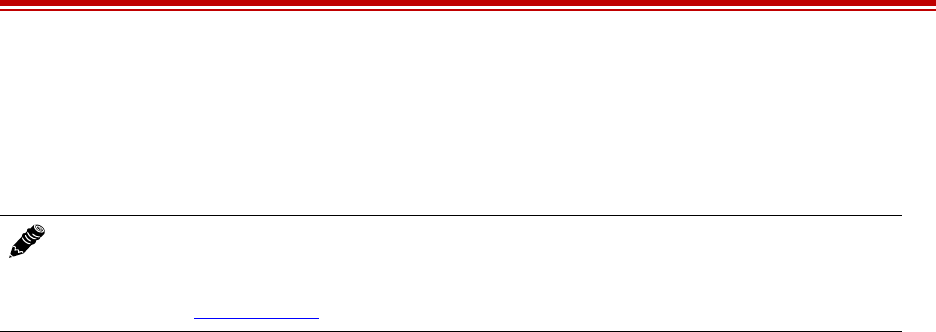
Exalt Installation and Management Guide
ExtendAir (TDD) Series Digital Microwave Radios
203591-011 115
2013-02-22
Europe and ITU Country Compliance
All of these permitted devices must be professionally installed. They can only be used as a point-to-
point transmission device for fixed or temporary-fixed (non-mobile) installations.
The ExtendAir (TDD) Series 50xx models operate under EN 301 893 and EN 302 502 rules as a
license-exempt device.
The ExtendAir (TDD) Series 50xx models comply with ETS 301 893 for the 5.3 and 5.47 GHz bands
for license-exempt use for most countries recognizing ETSI or ITU band assignments. This band is not
yet harmonized for all countries recognizing ETSI or ITU band assignments. These bands require
Dynamic Frequency Selection (DFS) and Transmitter Power Control (TPC) for radar-detection and
avoidance. There is a +30dBm EIRP limit applied to this band. Transmitter power must be adjusted
accordingly with respect to the RF cabling losses and antenna gains associated with each terminal.
The ExtendAir (TDD) Series 50xx models comply with ETS 302 502 for the 5.8 GHz band. This band
is not yet harmonized for all countries recognizing ETSI or ITU band assignments. Consult the
individual country regulations or your Exalt Communications representative for details. This band
requires DFS and TPC for radar-detection and avoidance. There is a +33dBm EIRP limit for use of the
10 MHz BW setting, and a +36dBm EIRP limit for use of the 20 MHz BW setting. Some countries
limit the EIRP to +5dBm for all bandwidths in this band.
All models comply with the requirements for CE Mark (EN 60950-1 and IEC 60950-1) and EMC (EN
301 489-17). No substitutions shall be made, and all wiring and grounding instructions contained in
this manual must be followed to ensure safety in accordance to the standards and local rules.
Note: Do not use external amplifiers to boost the power or overcome transmission system
losses, unless the specific amplifier/cable/antenna combination has expressly been
authorized by the specific country regulations. The output power must never exceed that
specified in Specifications.

Exalt Installation and Management Guide
ExtendAir (TDD) Series Digital Microwave Radios
116 203591-011
2013-02-22
Regulatory Compliance
As of this printing, Exalt Communications, Inc. has approvals for the products that are covered by this
manual, as indicated in Table 8. If your application or country is not listed, check with your Sales
Representative for the current status.
Notations are as follows: indicates approved; () indicates in-process; * indicates consult Exalt
Communications for availability.
Table 8 Product Approvals (Exalt)
Country 4.9GHz 5.3GHz 5.4GHz 5.8GHz
Austria *
Australia
Belgium
Brazil
Bulgaria *
Canada ()()
Cyprus * *
Czech Republic * *
Denmark * *
Estonia * *
Finland *
France *
Germany * *
Great Britain * *
Greece * *
Hungary *
Iceland * *
Ireland * *
Italy * *
Latvia *
Liechtenstein *
Lithuania * *
Luxembourg
Malta *
Mexico *

Exalt Installation and Management Guide
ExtendAir (TDD) Series Digital Microwave Radios
203591-011 117
2013-02-22
Netherlands * *
Norway * *
Philippines * * *
Poland * *
Portugal * *
Romania * *
Slovak Republic * *
Slovenia * *
Spain * *
Sweden * *
Switzerland *
Thailand * * *
UAE * * *
United States ()()
Table 8 Product Approvals (Exalt) (Continued)
Country 4.9GHz 5.3GHz 5.4GHz 5.8GHz

Exalt Installation and Management Guide
ExtendAir (TDD) Series Digital Microwave Radios
118 203591-011
2013-02-22
EIRP Limits for the United States and Canada
EIRP for the USA and Canada
4940–4990 MHz Band
For the ExtendAir (TDD) Series 4.9xx models, within the 4940–4990 MHz band, the maximum EIRP
allowed is +50dBm. The maximum output power of the radio shall never exceed +24dBm.
The transmit power must be reduced from maximum (+24dBm for 20MHz BW; +22dBm for 10MHz)
by 1 dB for every 1dB that the antenna gain exceeds 26dBi (including transmission system losses)
5250–5350 MHz and 5470–5725 MHz Bands
For 5250–5350 MHz and 5470–5725 MHz bands, the maximum EIRP is based on the bandwidth
selection of the radio. The maximum output of the radio is +22 dBm.
P
≤
EIRP – G + L
where:
5725–5850 MHz Band
For all models within the 5725–5850 MHz band, the maximum output power of the radio is +22 dBm.
The radio may operate at full power into the maximum gain antenna specified, which is 37.9dBi.
Note: The professional installer is responsible to ensure that RF output power is properly
adjusted to not exceed the regulatory limit.
P = Maximum transmitter output power of radio, in dBm.
EIRP = 26.38 (for 8MHz BW selection), 29.41 (for 16MHz BW selection), or 30 (for 32MHz
BW selection)
G = Specified gain of antenna, in dBi, at the operating frequency.
L = Total transmission system losses of all elements between the radio’s RF connector and
the antenna’s RF connector (all cables, connectors, lightning suppressors), in dB, as
specified or measured between at the operating frequency.
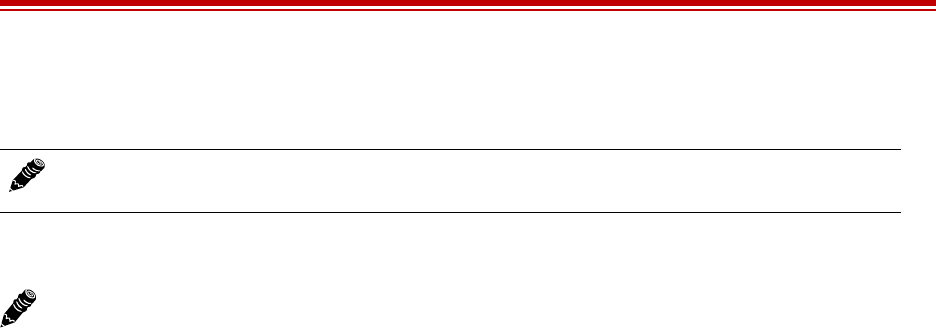
Exalt Installation and Management Guide
ExtendAir (TDD) Series Digital Microwave Radios
203591-011 119
2013-02-22
EIRP Limits for Australia
5470–5725 MHz Band
For ExtendAir (TDD) Series 50xx models within the 5470–5725 MHz band, the maximum EIRP
allowed is 30 dBm. The maximum output power of the radio is +22 dBm.
P = 30 – G + L
where:
5725–5850 MHz Band
For ExtendAir (TDD) Series 50xx models within the 5725–5850 MHz band, the maximum EIRP
allowed is 36 dBm. The maximum output power of the radio is +22 dBm.
P = 36 – G + L
where:
Note: The professional installer is responsible to ensure that RF output power is properly
adjusted to not exceed the regulatory limit.
Note: Australian regulations have a no-transmit band from 5600–5650 MHz, adjust the
transmitter to avoid this range.
P = Maximum transmitter output power of radio, in dBm.
G = Specified gain of antenna, in dBi, from 5470 to 5725 MHz.
L = Total transmission system losses of all elements between the radio’s RF connector and the
antenna’s RF connector (all cables, connectors, lightning suppressors), in dB, as specified
or measured between 5470 and 5725 MHz.
P = Maximum transmitter output power of radio, in dBm.
G = Specified gain of antenna, in dBi, from 5725 to 5850 MHz.
L = Total transmission system losses of all elements between the radio’s RF connector and the
antenna’s RF connector (all cables, connectors, lightning suppressors), in dB, as specified
or measured between 5725 and 5850 MHz.

Exalt Installation and Management Guide
ExtendAir (TDD) Series Digital Microwave Radios
120 203591-011
2013-02-22
EIRP Limits for the European Union and ITU Countries
The countries that are covered by this Regulatory Domain are: Austria, Belgium, Cyprus, Czech
Republic, Denmark, Estonia, Finland, France, Germany, Ghana, Great Britain, Greece, Hungary,
Iceland, Ireland, Italy, Latvia, Liechtenstein, Lithuania, Luxembourg, Malta, Norway, Poland,
Portugal, Slovak Republic, Slovenia, Spain, Sweden, Netherlands, Switzerland, and Turkey.
•Use only parabolic dish antennas or directional flat-panel antennas. No other types of antennas
(omni-directional, yagi, and so on) are authorized. Parabolic dishes of either grid or solid type are
allowed. Maximum mid-band gain of each type of antenna certified is:
– Parabolic dish: 37.9 dBi (6'/1.8m diameter)
– Directional flat panel: 28 dBi (~2'/61cm square)
50xx Series EIRP
Table 9 summarizes the maximum power by band and country for ExtendAir (TDD) Series radios.
5250–5350 MHz band
For all models within the 5250–5350 MHz band, the maximum EIRP is specified in Table 9. The
maximum output of the radio is +22 dBm.
P = ME – G + L
where:
5470–5725 MHz band
For all models within the 5470–5725 MHz band, the maximum EIRP allowed is specified in Table 9.
The maximum output power of the radio is +22 dBm.
P = ME – G + L
where:
Note: The professional installer is responsible to ensure that RF output power is properly
adjusted to not exceed the regulatory limit.
P = Maximum transmitter output power of radio, in dBm.
ME = Maximum EIRP, as specified in Table 9.
G = Specified gain of antenna, in dBi, from 5250 to 5350 MHz.
L = Total transmission system losses of all elements between the radio’s RF connector and
the antenna’s RF connector (all cables, connectors, lightning suppressors), in dB, as
specified or measured between 5250 and 5350 MHz.
P = Maximum transmitter output power of radio, in dBm.
ME = Maximum EIRP, as specified in Table 9.
G = Specified gain of antenna, in dBi, from 5470 to 5725 MHz.
L = Total transmission system losses of all elements between the radio’s RF connector and the
antenna’s RF connector (all cables, connectors, lightning suppressors), in dB, as specified
or measured between 5470 and 5725 MHz.

Exalt Installation and Management Guide
ExtendAir (TDD) Series Digital Microwave Radios
203591-011 121
2013-02-22
5725–5850 MHz band
For all models within the 5725–5850 MHz band, the maximum transmit power with respect to specific
country EIRP regulations is determined based on the channel bandwidth. The EIRP power limit is
specified in Table 9. The ExtendAir (TDD) Series radios maximum transmitter conducted power is
+22 dBm. Use the following equation to determine the maximum transmitter power for the radio:
P = ME – G + L
where:
P = Maximum transmitter output power of radio, in dBm.
ME = Maximum EIRP, as specified in Table 9.
G = Specified gain of antenna, in dBi, from 5725 to 5850 MHz.
L = Total transmission system losses of all elements between the radio’s RF connector and
the antenna’s RF connector (all cables, connectors, lightning suppressors), in dB, as
specified or measured between 5725 and 5850 MHz.

Exalt Installation and Management Guide
ExtendAir (TDD) Series Digital Microwave Radios
122 203591-011
2013-02-22
Table 9 EU and ITU Country Specific EIRP Levels
Country Maximum EIRP
5.3 GHz band Maximum EIRP
5.4 GHz band
Maximum EIRP
5.8 GHz band
(BW dependent)a
a. If the output power is designated as 33/36 dBm, the EIRP is limited to 33 dBm for 10 MHz bandwidth
transmissions and 36 dBm for 20 MHz bandwidth transmissions.
Austria 23 dBm 30 dBm 5 dBm
Belgium 30 dBm
Cyprus 23 dBm 30 dBm
Czech Republic 23 dBm 30 dBm 33/36 dBm
Denmark 23 dBm 30 dBm 33/36 dBm
Estonia 23 dBm 30 dBm
Finland 23 dBm 30 dBm
France 23 dBm 30 dBm 33/36 dBm
Germany 23 dBm 30 dBm 33/36 dBm
Ghana 23 dBm 30 dBm 33/36 dBm
Great Britain 23 dBm 30 dBm 33/36 dBm
Hungary 23 dBm 30 dBm 33/36 dBm
Iceland 23 dBm 30 dBm 33/36 dBm
Ireland 23 dBm 30 dBm 33/36 dBm
Italy 23 dBm 30 dBm 33/36 dBm
Liechtenstein 23 dBm 30 dBm 5 dBm
Lithuania 23 dBm 30 dBm 33/36 dBm
Luxembourg 23 dBm 30 dBm
Netherlands 23 dBm 30 dBm 33/36 dBm
Norway 23 dBm 30 dBm 33/36 dBm
Poland 23 dBm 30 dBm 33/36 dBm
Portugal 23 dBm 30 dBm 5 dBm
Romania 23 dBm 30 dBm 33/36 dBm
Slovak Republic 23 dBm 30 dBm 5 dBm
Slovenia 23 dBm 30 dBm
Spain 23 dBm 30 dBm 33/36 dBm
Sweden 23 dBm 30 dBm 33/36 dBm
Switzerland 23 dBm 30 dBm 5 dBm
Turkey 23 dBm 30 dBm 33/36 dBm
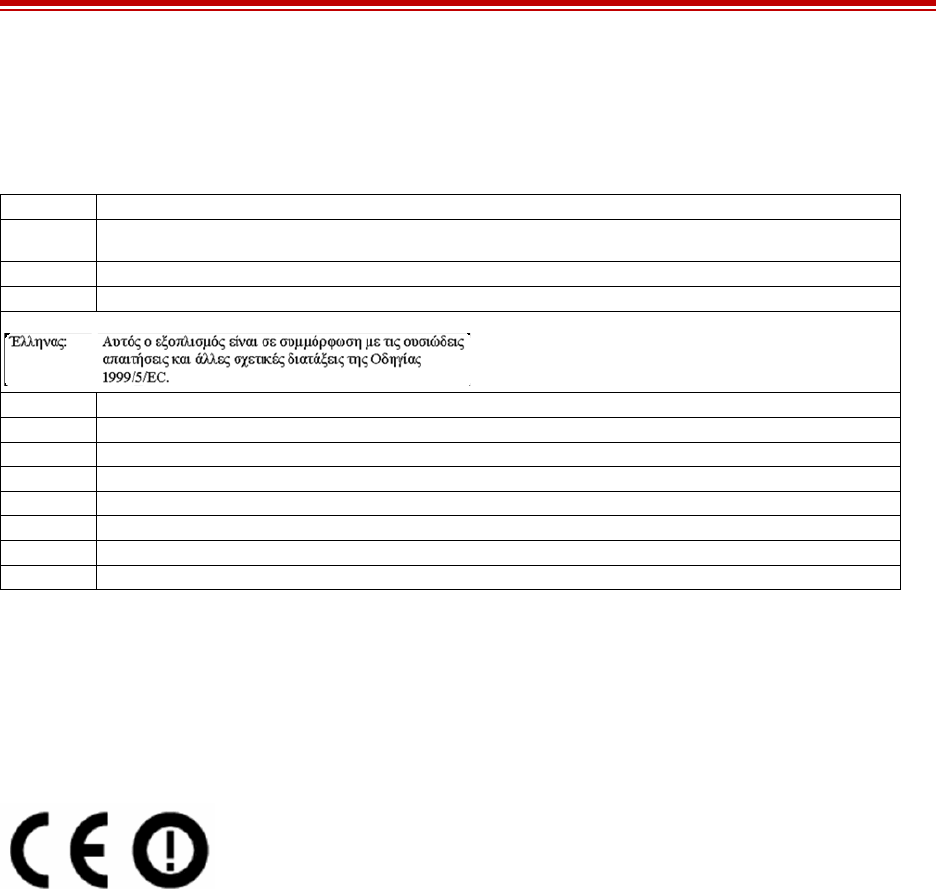
Exalt Installation and Management Guide
ExtendAir (TDD) Series Digital Microwave Radios
203591-011 123
2013-02-22
Declaration of Conformity to the R&TTE Directive
1999/5/EC
For 5 GHz radios, the following standards were applied:
•Radio: EN 301 893, EN 302 502
•EMC: EN 301 489-1, EN 301 489-17
•Safety: EN 60950-1, IEC 60950-1
The following CE mark is affixed to the product:
EU WEEE
Exalt is committed to meeting the requirements of the European Union’s Waste Electrical and
Electronic Equipment (WEEE) Directive. The Directives require producers of electrical and electronic
equipment to finance the take-back for re-use or recycling of their products placed on the EU market
after 13 August 2005.
Exalt products that are within the scope of the Directives are labeled with a crossed-out "wheelie-bin"
symbol as required by the Directives. This indicates that the product was placed on the market after 13
August 2005 and that end-users should segregate the product from other wastes at end-of-life.
The WEEE Directives are being implemented in each of the 28 EU and European Economic Area
(EAA) countries through national legislation. This has resulted in considerable variation in the detailed
requirements across the EU, many of which require presence in the EU. As a result, Exalt’s WEEE
compliance approach is to require the distributors and/or resellers in the EU to comply with each
country’s national legislation by registration of the distributor or reseller as the producer and for the
reseller/distributor to carry out and fulfill the legislative requirements of each national compliance
scheme.
Below is the crossed out wheelie bin symbol as required by the WEEE Directive.
English: This equipment is in compliance with the essential requirements and other relevant provisions of Directive 1999/5/EC.
Deutsch: Dieses Gerät entspricht den grundlegenden Anforderungen und den weiteren entsprecheneden Vorgaben der Richtlinie
1999/5/EU.
Dansk: Dette udstyr er i overensstemmelse med de væsentlige krav og andre relevante bestemmelser i Directiv 1999/5/EF.
Español: Este equipo cumple con los requisitos esenciales asi como con otras disposiciones de la Directive 1999/5/EC.
Français: Cet appareil est conforme aux exigencies essentialles et aux autres dispositions pertinantes de la Directive 1999/5/EC.
Íslenska: Þessi búnaður samrýmist lögboðnum kröfum og öðrum ákvæðum tilskipunar 1999/5/ESB.
Italiano: Questo apparato é conforme ai requisiti essenziali ed agli altri principi sanciti dalla Direttiva 1999/5/EC.
Nederlands: Deze apparatuur voldoet aan de belangrijkste eisen en andere voorzieningen van richtlijn 1999/5/EC.
Norsk: Dette utstyret er i samsvar med de grunnleggende krav og andre relevante bestemmelser i EU-directiv 1999/5/EC.
Português: Este equipamento satisfaz os requisitos essenciais e outras provisões da Directiva 1999/5/EC.
Suomalainen: Tämä laite täyttää direktiivin 1999/5/EY oleelliset vaatimukset ja on siinä asetettujen muidenkin ehtojen mukainen.
Svenska: Denna utrustning är i överensstämmelse med de väsentliga kraven och andra relevanta bestämmelser i Direktiv 1999/5/EC.

Exalt Installation and Management Guide
ExtendAir (TDD) Series Digital Microwave Radios
124 203591-011
2013-02-22
EU RoHS
RoHS is the acronym used to refer to the European Union (EU) Directive 2002/95/EC on the
Restriction of the use of certain hazardous substances in electrical and electronic equipment.
Hazardous materials are those chemicals and substances that are legislatively, market, or customer
banned or restricted for use in products and/or manufacturing. There are six (6) RoHS substances:
lead (Pb), cadmium (Cd), mercury (Hg), hexavalent chromium (Cr+6), polybrominated biphenyls
(PBB) and polybrominated diphenylethers (PBDE). Other countries may be introducing legislation
that results in similar restrictions of hazardous substances. Many Exalt products will continue to use
lead-based solder under the exemption allowed for network infrastructure equipment. Small amounts
of lead, cadmium, mercury, hexavalent chromium, PBB, and PBDE can also be found in a few
electrical and electrical components.

Exalt Installation and Management Guide
ExtendAir (TDD) Series Digital Microwave Radios
203591-011 125
2013-02-22
Exalt Limited Hardware Warranty Software License and
RMA Procedures Agreement
THIS IS AN AGREEMENT BETWEEN YOU AND EXALT COMMUNICATIONS, INC.
("EXALT"). BY EXECUTING OR OTHERWISE ACCEPTING THIS AGREEMENT OR BY
USING THE EXALT PRODUCT WITH OR FOR WHICH THIS AGREEMENT IS
PROVIDED ("PRODUCT"), YOU ARE AGREEING TO ALL OF THE BELOW TERMS
AND CONDITIONS. IF YOU DO NOT AGREE WITH THESE TERMS AND CONDITIONS,
YOU SHOULD NOT USE THE PRODUCT AND RETURN IT TO YOUR PLACE OF
PURCHASE. "YOU" MEANS THE LEGAL (END USER) ENTITY THAT PURCHASED
THE PRODUCT.
1Exalt Limited Hardware Warranty
a. Exalt warrants solely to the original purchaser ("Purchaser") that the Exalt hardware product
that this Agreement is provided with or for (the "Hardware Product") will substantially
conform in all material respects to the relevant Exalt published specifications that apply at the
time of manufacture of such Hardware Product for one (1) year from the date of purchase of
Hardware Product by Purchaser (the "Warranty Period"). Purchaser may elect to extend the
Warranty Period by one additional year as set forth below. Proof-of-purchase in the form of
an invoice, payment of invoice, or delivery waybill must be supplied, if requested by Exalt, in
case of any dispute of warranty start date.
b. In the event Purchaser notifies Exalt during the Warranty Period of a defective Hardware
Product (material nonconformance with the published specifications), Exalt shall within the
Warranty Period, at its own option either: (A) use reasonable efforts to remedy any
reproducible Hardware Product defect covered by this limited warranty within a reasonable
period of time; (B) replace the defective Hardware Product with a functionally equivalent
product (repair parts and products may be either reconditioned or new, but, if reconditioned,
shall be of the same quality as new parts or products); or (C) if Exalt determines that it is
unable to repair or replace such Hardware Product, Exalt (or its applicable reseller) will refund
to Purchaser the amount actually paid by Purchaser for the applicable Hardware Product.
c. All replaced parts become the property of Exalt. Exalt may, at its sole option, refuse to accept
as defective any Hardware Product that (i) is subject to the exclusions set forth below; or (ii)
cannot be demonstrated to be defective by Exalt and Purchaser is unable to provide adequate
information describing how the Hardware Product failed. Such Hardware Product will, at
Purchaser's option and expense, either be: (a) returned to Purchaser in the state received, or (b)
repaired and returned to Purchaser. Repaired or replaced Hardware Product will be warranted
for the remainder of the original Warranty Period, but not less than ninety (90) days.
2Timely Registration May Extend Limited Hardware Warranty Period
Purchaser may elect to extend the one (1) year Warranty Period to a two (2) year Warranty Period
by registering the Hardware Product with Exalt within ninety (90) days of Hardware Product
purchase (all requested registration information must be provided in clear and accurate form
within such 90 day period). [Product registration may be performed by completing and submitting
the product registration form on www.exaltcom.com/ProductRegistration ]
3Limited Hardware Warranty Exclusions
This limited warranty will not apply to: (A) any Hardware Product that: (i) has been modified or
altered by any party other than Exalt; (ii) has been subject to accident, misuse, abnormal wear and
tear, neglect, or mistreatment; (iii) has been damaged during installation of the Hardware Product;

Exalt Installation and Management Guide
ExtendAir (TDD) Series Digital Microwave Radios
126 203591-011
2013-02-22
(iv) has been damaged by the equipment or system with which the Hardware Product is used; (v)
has sustained damage to the Hardware Products' interface or power connectors; (vi) is determined
to be stolen; or (vii) has been damaged by fire, power changes, other hazards, or acts of God
(including without limitation lightning); or (B) any Software included in any such Hardware
Product (see Software License below). The warranty applies only to Hardware Products that can
be identified by the Exalt trademark, trade name, serial number or logo affixed to them. Exalt does
not warrant any Hardware Product that is not manufactured by, for, or with permission from Exalt.
The Hardware Products covered by this warranty are not consumer products and are not intended
for personal, family, or household purposes, nor are they intended for high-risk activities as
described in Section 5 below.
4Hardware Product RMA Procedures
A return material authorization (RMA) is required prior to returning Hardware Product to Exalt for
warranty or out-of-warranty repair/evaluation. As such, Purchaser must use the following
procedure:
a. Contact Exalt Customer Care, by phone at +1 408-688-0202 or USA Toll-Free at +1 877-
EXALT-01 (392-5801), or by e-mail at support@exaltcom.com, and request an RMA number.
Please be prepared to provide the serial number of the Hardware Product, the date of purchase,
and a description of the failure that is as complete as possible.
b. Pack the Hardware Product in its original container and packing or an equivalent.
c. Write the RMA number CLEARLY on the outside of the shipping box.
d. Cost of shipment to Exalt's authorized service center, taxes, duty, tariffs, risk of loss and
insurance charges to Exalt shall be borne by the Purchaser. During the Warranty Period, for
service of defects covered by this limited warranty, cost of return shipment and insurance
charges shall be borne by Exalt. For return shipment outside of the U.S., Purchaser shall be
responsible for duty, tariffs and any other re-importation costs. Exalt will select the carrier
and method/schedule of shipment. Purchaser may expedite return shipments, upon request, at
its own expense.
PRODUCTS RETURNED WITHOUT A DULY ISSUED RMA NUMBER WILL BE
RETURNED TO PURCHASER AT PURCHASER'S EXPENSE.
5PRODUCT WARRANTY DISCLAIMER AND LIMITATION OF LIABILITY
a. THE ABOVE EXPRESS LIMITED WARRANTY FOR THE HARDWARE PRODUCT,
THE CONDITIONS AND OTHER TERMS SET FORTH IN THIS AGREEMENT ARE IN
LIEU OF ALL OTHER WARRANTIES, CONDITIONS AND OTHER TERMS WHETHER
EXPRESS, IMPLIED OR STATUTORY, REGARDING THE PRODUCT (HARDWARE
PRODUCT AND SOFTWARE) AND ANY SERVICES PROVIDED BY EXALT, AND
EXALT, ITS SUPPLIERS AND LICENSORS HEREBY EXPRESSLY DISCLAIM, TO
THE EXTENT ALLOWED BY APPLICABLE LAW, ANY AND ALL SUCH EXPRESS,
IMPLIED AND STATUTORY WARRANTIES, CONDITIONS AND OTHER TERMS,
INCLUDING WITHOUT LIMITATION ANY AND ALL IMPLIED WARRANTIES OF
FITNESS FOR A PARTICULAR PURPOSE, TITLE, INTERFERENCE WITH QUIET
ENJOYMENT, NON-INFRINGEMENT OF THIRD-PARTY RIGHTS AND
MERCHANTABILITY. FURTHER, EXALT DOES NOT WARRANT RESULTS OF USE
OR THAT YOUR USE OF THE PRODUCT WILL BE UNINTERRUPTED OR ERROR
FREE. NO WARRANTIES ARE MADE BY EXALT'S SUPPLIERS OR LICENSORS.
EXCEPT FOR THE ABOVE EXPRESS LIMITED WARRANTY FOR THE HARDWARE
PRODUCT, THE CONDITIONS AND OTHER TERMS STATED HEREIN, THE

Exalt Installation and Management Guide
ExtendAir (TDD) Series Digital Microwave Radios
203591-011 127
2013-02-22
PRODUCT IS PROVIDED "AS IS" AND WITH ALL FAULTS. THE ENTIRE RISK AS TO
SATISFACTORY QUALITY, ACCURACY, AND EFFORT IS WITH YOU.
b. THE PRODUCT IS NOT FAULT-TOLERANT AND IS NOT DESIGNED,
MANUFACTURED OR INTENDED FOR USE OR RESALE AS ONLINE CONTROL
EQUIPMENT IN HAZARDOUS ENVIRONMENTS REQUIRING FAIL-SAFE
PERFORMANCE, SUCH AS IN THE OPERATION OF NUCLEAR FACILITIES,
AIRCRAFT NAVIGATION OR COMMUNICATION SYSTEMS, AIR TRAFFIC
CONTROL, DIRECT LIFE SUPPORT MACHINES OR WEAPONS SYSTEMS, IN
WHICH THE FAILURE OF THE PRODUCT COULD LEAD DIRECTLY TO DEATH,
PERSONAL INJURY, OR SEVERE PHYSICAL OR ENVIRONMENTAL DAMAGE.
EXALT AND ITS SUPPLIERS AND LICENSORS SPECIFICALLY DISCLAIM ANY
EXPRESS OR IMPLIED WARRANTY OF FITNESS FOR ANY HIGH-RISK USES
LISTED ABOVE.
c. REGARDLESS OF WHETHER ANY REMEDY SET FORTH HEREIN FAILS OF ITS
ESSENTIAL PURPOSE OR OTHERWISE, AND TO THE EXTENT ALLOWED BY
APPLICABLE LAW, IN NO EVENT WILL EXALT, ITS SUPPLIERS OR LICENSORS BE
LIABLE TO YOU OR TO ANY THIRD PARTY UNDER ANY TORT, CONTRACT,
NEGLIGENCE, STRICT LIABILITY OR OTHER LEGAL OR EQUITABLE THEORY
FOR ANY LOST PROFITS, LOST OR CORRUPTED DATA, COMPUTER FAILURE OR
MALFUNCTION, INTERRUPTION OF BUSINESS, OR OTHER SPECIAL, INDIRECT,
INCIDENTAL OR CONSEQUENTIAL DAMAGES OF ANY KIND ARISING OUT OF (1)
THE USE OR INABILITY TO USE THE PRODUCT OR (2) PRODUCT RELATED
SERVICE OR SUPPORT, EVEN IF EXALT HAS BEEN ADVISED OF THE
POSSIBILITY OF SUCH LOSS OR DAMAGES AND WHETHER OR NOT SUCH LOSS
OR DAMAGES ARE FORESEEABLE.
d. IN NO EVENT SHALL EXALT'S AND ITS SUPPLIERS'/LICENSORS' AGGREGATE
LIABILITY EXCEED AN AMOUNT EQUAL TO THE PURCHASE PRICE PAID BY
PURCHASER FOR THE PRODUCT OR SERVICE THAT IS THE SUBJECT OF A
CLAIM. ANY CLAIM ARISING OUT OF OR RELATING TO THIS AGREEMENT
MUST BE BROUGHT WITHIN ONE (1) YEAR AFTER THE OCCURRENCE OF THE
EVENT GIVING RISE TO SUCH CLAIM. IN ADDITION, EXALT DISCLAIMS ALL
LIABILITY OF ANY KIND OF EXALT'S SUPPLIERS/LICENSORS.
6SOFTWARE LICENSE
a. Subject to the terms and conditions of this Agreement, Exalt hereby grants You a non-
exclusive, non-transferable, non-sublicensable license to use the Software that comes with the
Product, if any is provided as part of the Product, only as part of the normal operation, use and
maintenance of the Hardware Product for which the Software was provided. You may make
back-up copies of such Software. You shall not otherwise copy, distribute or alter the
Software. Furthermore, except to the extent allowed by applicable law if located in the
European Union, and then only with prior written notice to Exalt, You shall not disassemble or
reverse engineer the Software in whole or in part or authorize others to do so. No rights to
distribute or sublicense the Software are granted herein.
b. There may be certain third party owned software provided along with, or incorporated within
the Product ("Third Party Software"), and which Third Party Software has a separate license
agreement and which is governed exclusively by such separate license agreement ("Third
Party License") and not this Agreement. Such Third Party Software and applicable Third
Party Licenses are listed in the document "EXALT COMMUNICATIONS, INC. THIRD
PARTY SOFTWARE AND THIRD PARTY LICENSES USED WITH CERTAIN EXALT

Exalt Installation and Management Guide
ExtendAir (TDD) Series Digital Microwave Radios
128 203591-011
2013-02-22
PRODUCTS" available through the Web user interface application provided with this product.
Except as Exalt may otherwise inform You in writing, the Third Party License gives You at
least the license rights granted above in Section 6(a), and may provide additional license rights
as to the Third Party Software, but only with respect to the particular Third Party Software to
which the Third Party License applies. SUCH THIRD PARTY SOFTWARE IS PROVIDED
WITHOUT ANY WARRANTY FROM EXALT AND ITS LICENSORS, INCLUDING BUT
NOT LIMITED TO WARRANTIES OF MERCHANTABILITY, FITNESS FOR A
PARTICULAR PURPOSE AND NON-INFRINGEMENT.
c. Exalt and its licensors are the sole and exclusive owners of the Software, and all underlying
intellectual property rights in the Software and Hardware Product. All rights not expressly
granted to You relating to the Software are reserved by Exalt and its licensors. You take
unencumbered title to the Hardware Product, subject to Exalt's and its licensors' ownership in
the underlying intellectual property, upon payment in full to Exalt or the Exalt reseller for the
Product(s).
d. All licenses to the Software hereunder shall terminate if You fail to comply with any of the
provisions of this Agreement and do not remedy such breach within thirty (30) days after
receiving written notice from Exalt. You agree upon termination to immediately cease using
the Software and to destroy all copies of the Software which may have been provided or
created hereunder.
7GOVERNMENT RESTRICTIONS
a. You agree that you will not export or re-export the Products without Exalt's prior written
consent, and then only in compliance with all requirements of applicable law, including but
not limited to U.S. export control regulations. You have the responsibility to obtain any
required licenses to export, re-export or import the Products. You shall defend, indemnify and
hold Exalt and its suppliers/licensors harmless from any claims arising out of Your violation
of any export control laws relating to any exporting of the Products. By accepting this
Agreement and receiving the Products, You confirm that You are not listed on any
governmental export exclusion lists and will not export or re-export the Products to any
country embargoed by the U.S. Applicable export restrictions and exclusions are available at
the official web site of the U.S. Department of Commerce Bureau of Industry and Security
(www.bis.doc.gov).
b. For purchase by or on behalf of governmental entities (including federal, state or provincial,
and local), the governmental entity's rights in any technical data and software in the Products
include only those rights customarily provided to the public as defined in Exalt's standard
Agreement. In connection with any purchase by or on behalf of a U.S. governmental entity,
Exalt's customary commercial license in technical data and software is provided in accordance
with FAR 12.211 (Technical Data) and FAR 12.212 (Software) and, for Department of
Defense transactions, DFAR 252.227-7015 (Technical Data - Commercial Items) and DFAR
227.7202-3 (Rights in Commercial Computer Software or Computer Software
Documentation). If a governmental entity has a need for rights not conveyed under these
terms, it must negotiate a mutually acceptable written agreement with Exalt specifying and
specifically conveying such rights. Any use, modification, reproduction, release, performing,
displaying or disclosing of the Exalt Software by a governmental entity shall be governed
solely by the terms of this Agreement.
8CONFIDENTIALITY
Purchaser acknowledges and agrees that information supplied by Exalt in connection with the
Product or this Agreement and designated by Exalt as confidential is the confidential information

Exalt Installation and Management Guide
ExtendAir (TDD) Series Digital Microwave Radios
203591-011 129
2013-02-22
of Exalt, which confidential information includes the Software. Purchaser agrees: (i) to hold the
confidential information in confidence using the same degree of care that it uses to protect its own
confidential information of similar importance, but not less than a reasonable degree of care, (ii)
not to make use of confidential information other than as contemplated by this Agreement, and
(iii) not to reproduce confidential information except as expressly authorized by this Agreement.
Purchaser's obligations with respect to confidentiality do not apply to information which: (i)
becomes generally available to the public other than as a result of unauthorized disclosure by
Purchaser, or (ii) was in Purchaser's possession prior to disclosure by Exalt.
9MISCELLANEOUS
You shall not sell, transfer or assign this Agreement without the prior written consent of Exalt.
Any act in derogation of the foregoing shall be null and void, and You will remain obligated under
this Agreement. This Agreement shall benefit and be binding upon the parties to this Agreement
and their respective permitted successors and assigns. The waiver or failure of either party to
exercise in any respect any right provided for in this Agreement shall not be deemed a waiver of
any further right under this Agreement. If any provision of this Agreement is held by a court of
competent jurisdiction to be contrary to law, the remaining provisions of this Agreement will
remain in full force and effect. This Agreement and any disputes arising out of, or related to, this
Agreement, its termination or the relationship of the parties will be governed by and construed in
accordance with the laws of the State of California, excluding its conflict of laws principles and
excluding the United Nations Convention on Contracts for the International Sale of Goods. All
disputes arising in connection with this Agreement, the Products or Services shall be administered
by the American Arbitration Association under its commercial arbitration rules by a single
arbitrator appointed in accordance with the rules. Both parties consent that the arbitration shall
take place in Santa Clara County, California. The award rendered by the arbitrator shall be final
and binding on the parties and judgment on the award may be entered in any court having
jurisdiction thereof. Any litigation relating to this Agreement or the arbitration shall take place in
the state courts of Santa Clara County or in the federal courts of the Northern District of
California. The foregoing notwithstanding, Exalt may obtain preliminary and/or permanent
injunctive relief in any court of competent jurisdiction worldwide to enforce the terms of Sections
6, 7 and 8. Purchaser hereby consents and submits to the jurisdiction and venue of these courts
and agrees that process may be served in the manner provided or allowed by California or federal
law. In any action or proceeding to enforce rights under this Agreement, the prevailing party shall
be entitled to recover costs and attorneys' fees. This Agreement represents the complete agreement
and understanding of the parties with respect to the subject matter herein. This Agreement may be
modified only through a written instrument signed or otherwise agreed to by both parties.
Rev 4-6-2012PT

Exalt Installation and Management Guide
ExtendAir (TDD) Series Digital Microwave Radios
130 203591-011
2013-02-22
Copyright Notices
This section presents copyright notices for third-party software licensed to Exalt Communications, Inc.
Net-SNMP
The following copyright notice applies to the open-source licensing agreement for Net-SNMP.
Copyright 1989, 1991, 1992 by Carnegie Mellon University
Derivative Work - 1996, 1998-2000
Copyright 1996, 1998-2000 The Regents of the University of California
All Rights Reserved
Permission to use, copy, modify and distribute this software and its documentation for any purpose and
without fee is hereby granted, provided that the above copyright notice appears in all copies and that
both that copyright notice and this permission notice appear in supporting documentation, and that the
name of CMU and The Regents of the University of California not be used in advertising or publicity
pertaining to distribution of the software without specific written permission.
CMU AND THE REGENTS OF THE UNIVERSITY OF CALIFORNIA DISCLAIM ALL
WARRANTIES WITH REGARD TO THIS SOFTWARE, INCLUDING ALL IMPLIED
WARRANTIES OF MERCHANTABILITY AND FITNESS. IN NO EVENT SHALL CMU OR
THE REGENTS OF THE UNIVERSITY OF CALIFORNIA BE LIABLE FOR ANY SPECIAL,
INDIRECT OR CONSEQUENTIAL DAMAGES OR ANY DAMAGES WHATSOEVER
RESULTING FROM THE LOSS OF USE, DATA OR PROFITS, WHETHER IN AN ACTION OF
CONTRACT, NEGLIGENCE OR OTHER TORTIOUS ACTION, ARISING OUT OF OR IN
CONNECTION WITH THE USE OR PERFORMANCE OF THIS SOFTWARE.
Network Associates Technology, Inc.
Copyright (c) 2001-2003, Networks Associates Technology, Inc
All rights reserved.
Redistribution and use in source and binary forms, with or without modification, are permitted
provided that the following conditions are met:
* Redistributions of source code must retain the above copyright notice, this list of conditions and the
following disclaimer.
* Redistributions in binary form must reproduce the above copyright notice, this list of conditions and
the following disclaimer in the documentation and/or other materials provided with the distribution.
* Neither the name of the Networks Associates Technology, Inc nor the names of its contributors may
be used to endorse or promote products derived from this software without specific prior written
permission.
THIS SOFTWARE IS PROVIDED BY THE COPYRIGHT HOLDERS AND CONTRIBUTORS ''AS
IS'' AND ANY EXPRESS OR IMPLIED WARRANTIES, INCLUDING, BUT NOT LIMITED TO,
THE IMPLIED WARRANTIES OF MERCHANTABILITY AND FITNESS FOR A PARTICULAR
PURPOSE ARE DISCLAIMED. IN NO EVENT SHALL THE COPYRIGHT HOLDERS OR
CONTRIBUTORS BE LIABLE FOR ANY DIRECT, INDIRECT, INCIDENTAL, SPECIAL,
EXEMPLARY, OR CONSEQUENTIAL DAMAGES (INCLUDING, BUT NOT LIMITED TO,
PROCUREMENT OF SUBSTITUTE GOODS OR SERVICES; LOSS OF USE, DATA, OR
PROFITS; OR BUSINESS INTERRUPTION) HOWEVER CAUSED AND ON ANY THEORY OF
LIABILITY, WHETHER IN CONTRACT, STRICT LIABILITY, OR TORT (INCLUDING

Exalt Installation and Management Guide
ExtendAir (TDD) Series Digital Microwave Radios
203591-011 131
2013-02-22
NEGLIGENCE OR OTHERWISE) ARISING IN ANY WAY OUT OF THE USE OF THIS
SOFTWARE, EVEN IF ADVISED OF THE POSSIBILITY OF SUCH DAMAGE.
Cambridge Broadband, Ltd.
Portions of this code are copyright (c) 2001-2003, Cambridge Broadband Ltd.
All rights reserved.
Redistribution and use in source and binary forms, with or without modification, are permitted
provided that the following conditions are met:
* Redistributions of source code must retain the above copyright notice, this list of conditions and the
following disclaimer.
* Redistributions in binary form must reproduce the above copyright notice, this list of conditions and
the following disclaimer in the documentation and/or other materials provided with the distribution.
* The name of Cambridge Broadband Ltd. may not be used to endorse or promote products derived
from this software without specific prior written permission.
THIS SOFTWARE IS PROVIDED BY THE COPYRIGHT HOLDER ``AS IS'' AND ANY
EXPRESS OR IMPLIED WARRANTIES, INCLUDING, BUT NOT LIMITED TO, THE IMPLIED
WARRANTIES OF MERCHANTABILITY AND FITNESS FOR A PARTICULAR PURPOSE ARE
DISCLAIMED. IN NO EVENT SHALL THE COPYRIGHT HOLDER BE LIABLE FOR ANY
DIRECT, INDIRECT, INCIDENTAL, SPECIAL, EXEMPLARY, OR CONSEQUENTIAL
DAMAGES (INCLUDING, BUT NOT LIMITED TO, PROCUREMENT OF SUBSTITUTE
GOODS OR SERVICES; LOSS OF USE, DATA, OR PROFITS; OR BUSINESS INTERRUPTION)
HOWEVER CAUSED AND ON ANY THEORY OF LIABILITY, WHETHER IN CONTRACT,
STRICT LIABILITY, OR TORT (INCLUDING NEGLIGENCE OR OTHERWISE) ARISING IN
ANY WAY OUT OF THE USE OF THIS SOFTWARE, EVEN IF ADVISED OF THE
POSSIBILITY OF SUCH DAMAGE.
Sun Microsystems, Inc.
Copyright © 2003 Sun Microsystems, Inc., 4150 Network Circle, Santa Clara,
California 95054, U.S.A. All rights reserved.
Use is subject to license terms below.
This distribution may include materials developed by third parties.
Sun, Sun Microsystems, the Sun logo and Solaris are trademarks or registered trademarks of Sun
Microsystems, Inc. in the U.S. and other countries.
Redistribution and use in source and binary forms, with or without modification, are permitted
provided that the following conditions are met:
* Redistributions of source code must retain the above copyright notice, this list of conditions and the
following disclaimer.
* Redistributions in binary form must reproduce the above copyright notice, this list of conditions and
the following disclaimer in the documentation and/or other materials provided with the distribution.
* Neither the name of the Sun Microsystems, Inc. nor the names of its contributors may be used to
endorse or promote products derived from this software without specific prior written permission.
THIS SOFTWARE IS PROVIDED BY THE COPYRIGHT HOLDERS AND CONTRIBUTORS ''AS
IS'' AND ANY EXPRESS OR IMPLIED WARRANTIES, INCLUDING, BUT NOT LIMITED TO,
THE IMPLIED WARRANTIES OF MERCHANTABILITY AND FITNESS FOR A PARTICULAR

Exalt Installation and Management Guide
ExtendAir (TDD) Series Digital Microwave Radios
132 203591-011
2013-02-22
PURPOSE ARE DISCLAIMED. IN NO EVENT SHALL THE COPYRIGHT HOLDERS OR
CONTRIBUTORS BE LIABLE FOR ANY DIRECT, INDIRECT, INCIDENTAL, SPECIAL,
EXEMPLARY, OR CONSEQUENTIAL DAMAGES (INCLUDING, BUT NOT LIMITED TO,
PROCUREMENT OF SUBSTITUTE GOODS OR SERVICES; LOSS OF USE, DATA, OR
PROFITS; OR BUSINESS INTERRUPTION) HOWEVER CAUSED AND ON ANY THEORY OF
LIABILITY, WHETHER IN CONTRACT, STRICT LIABILITY, OR TORT (INCLUDING
NEGLIGENCE OR OTHERWISE) ARISING IN ANY WAY OUT OF THE USE OF THIS
SOFTWARE, EVEN IF ADVISED OF THE POSSIBILITY OF SUCH DAMAGE.
Sparta, Inc.
Copyright (c) 2003-2005, Sparta, Inc
All rights reserved.
Redistribution and use in source and binary forms, with or without modification, are permitted
provided that the following conditions are met:
* Redistributions of source code must retain the above copyright notice, this list of conditions and the
following disclaimer.
* Redistributions in binary form must reproduce the above copyright notice, this list of conditions and
the following disclaimer in the documentation and/or other materials provided with the distribution.
* Neither the name of Sparta, Inc nor the names of its contributors may be used to endorse or promote
products derived from this software without specific prior written permission.
THIS SOFTWARE IS PROVIDED BY THE COPYRIGHT HOLDERS AND CONTRIBUTORS ''AS
IS'' AND ANY EXPRESS OR IMPLIED WARRANTIES, INCLUDING, BUT NOT LIMITED TO,
THE IMPLIED WARRANTIES OF MERCHANTABILITY AND FITNESS FOR A PARTICULAR
PURPOSE ARE DISCLAIMED. IN NO EVENT SHALL THE COPYRIGHT HOLDERS OR
CONTRIBUTORS BE LIABLE FOR ANY DIRECT, INDIRECT, INCIDENTAL, SPECIAL,
EXEMPLARY, OR CONSEQUENTIAL DAMAGES (INCLUDING, BUT NOT LIMITED TO,
PROCUREMENT OF SUBSTITUTE GOODS OR SERVICES; LOSS OF USE, DATA, OR
PROFITS; OR BUSINESS INTERRUPTION) HOWEVER CAUSED AND ON ANY THEORY OF
LIABILITY, WHETHER IN CONTRACT, STRICT LIABILITY, OR TORT (INCLUDING
NEGLIGENCE OR OTHERWISE) ARISING IN ANY WAY OUT OF THE USE OF THIS
SOFTWARE, EVEN IF ADVISED OF THE POSSIBILITY OF SUCH DAMAGE.
Cisco, Inc.
Copyright (c) 2004, Cisco, Inc and Information Network
Center of Beijing University of Posts and Telecommunications.
All rights reserved.
Redistribution and use in source and binary forms, with or without modification, are permitted
provided that the following conditions are met:
* Redistributions of source code must retain the above copyright notice, this list of conditions and the
following disclaimer.
* Redistributions in binary form must reproduce the above copyright notice, this list of conditions and
the following disclaimer in the documentation and/or other materials provided with the distribution.
* Neither the name of Cisco, Inc, Beijing University of Posts and Telecommunications, nor the names
of their contributors may be used to endorse or promote products derived from this software without
specific prior written permission.

Exalt Installation and Management Guide
ExtendAir (TDD) Series Digital Microwave Radios
203591-011 133
2013-02-22
THIS SOFTWARE IS PROVIDED BY THE COPYRIGHT HOLDERS AND CONTRIBUTORS ''AS
IS'' AND ANY EXPRESS OR IMPLIED WARRANTIES, INCLUDING, BUT NOT LIMITED TO,
THE IMPLIED WARRANTIES OF MERCHANTABILITY AND FITNESS FOR A PARTICULAR
PURPOSE ARE DISCLAIMED. IN NO EVENT SHALL THE COPYRIGHT HOLDERS OR
CONTRIBUTORS BE LIABLE FOR ANY DIRECT, INDIRECT, INCIDENTAL, SPECIAL,
EXEMPLARY, OR CONSEQUENTIAL DAMAGES (INCLUDING, BUT NOT LIMITED TO,
PROCUREMENT OF SUBSTITUTE GOODS OR SERVICES; LOSS OF USE, DATA, OR
PROFITS; OR BUSINESS INTERRUPTION) HOWEVER CAUSED AND ON ANY THEORY OF
LIABILITY, WHETHER IN CONTRACT, STRICT LIABILITY, OR TORT (INCLUDING
NEGLIGENCE OR OTHERWISE) ARISING IN ANY WAY OUT OF THE USE OF THIS
SOFTWARE, EVEN IF ADVISED OF THE POSSIBILITY OF SUCH DAMAGE.
Fabasoft R&D Software GmbH & Co.
Copyright (c) Fabasoft R&D Software GmbH & Co KG, 2003
oss@fabasoft.com
Author: Bernhard Penz
Redistribution and use in source and binary forms, with or without modification, are permitted
provided that the following conditions are met:
* Redistributions of source code must retain the above copyright notice, this list of conditions and the
following disclaimer.
* Redistributions in binary form must reproduce the above copyright notice, this list of conditions and
the following disclaimer in the documentation and/or other materials provided with the distribution.

Exalt Installation and Management Guide
ExtendAir (TDD) Series Digital Microwave Radios
134 203591-011
2013-02-22
Index
A
AC adapter 24
Administration Settings page 40
administrator privileges 34
Advance Encryption Standard 41
AES 41
AIS enabling//disabling 57
alarm conditions 37
alarms 55, 72
clearing 76
Alarms page 72
AMI 57
antennas
alignment 30, 105
Canada 114
mounting 27
indoor 30
mounting height 6
site preparation considerations 6
transmission line 28
troubleshooting 105
B
B8ZS 57
back-to-back bench test 8, 107
back-to-back bench test configuration 107
Bandwidth parameter 51
battery source 24
BER 79
browsers 33
buzzer timeout selection parameter 54
C
cables
Ethernet (CAT5e) 8
RF 6
T1/E1 8
troubleshooting
improper RF cable termination 104
CLI 32
main menu 32
configuration file 46
connections
RSL Sync 95
sync distribution accessory 96
TDM 95
Two-radio pin Internal Sync Out/In 96
connectors 22
GPS/RSL 22
Power/Ethernet 22, 96
T1/E1 1&3 22
T1/E1 2&4 22
TDM 95
Current BER field 74
Current RSL field 74
D
date and time 40
DC power source 24
Diagnostic Charts page 79
dimensions 87
duplex settings 55
Dynamic Frequency Selection (DFS) 52, 110
E
E1 channels 58
E1 Interface Configuration page 58
effective isotropic radiated power (EIRP) 9
Endpoint Identifier 35, 50
Errored Seconds (ES) field 75
Ethernet configuration parameters 58
Ethernet connectors 96
Ethernet interface 94
throughput settings 57
Ethernet Interface Configuration page 55
Event Log page 76
ExaltCalc tool 9, 103
external loopback modes 59
F
factory default settings 27, 47
fade margin 6, 106
File Activation page 46, 49
File Transfer page 46
file transfers 46
files
activating stored 49
default configuration file 47
flywheeling 16
frame length See TDD frame
frequency
center 6
G
gateway (default) 47
GPS Information page 71
GPS synchronization 53, 71
GPS/RSL connector 22

Exalt Installation and Management Guide
ExtendAir (TDD) Series Digital Microwave Radios
203591-011 135
2013-02-22
GPS/RSL LED 23
grounding 105
GUI
ACS (Automatic Channel Selection)
page 68
Administration Settings page 40
Alarms page 72
browsers supported 33
description 33
Diagnostic Charts page 79
E1 Interface Configuration page 58
Ethernet Interface Configuration page 55
Event Log page 76
File Activation page 46, 49
File Transfer page 46
GPS Information page 71
IP address (default) 33
log in 34
login privileges 34
navigation panel 37
NTP and Time Zones Configurations 42
Performance page 74
QoS configuration 63
Radio A configuration 33
Radio Information page 39
Reboot page 85
Spectrum Analyzer page 81
summary status information 36
Syslog configuration 70
System Configuration page 50
T1 Interface Configuration page 57
T1/E1 Configuration page 57
VLAN page 60
H
hop 7
hub 13
I
interfaces
Ethernet 94
power 94
RF 94
T1/E1 94
interference 75
interference profile 6
Internal Sync Out/In (two-radio pin connec-
tion) 96
IP address conflicts 33
IP address subnet 33
IP settings 8
L
LEDs
DATA + POWER 23
ETH2 or ETH3 23
GPS/RSL 23
Power/ETH1 23
T1/E1 1&3 23
License Key 41
lightning arrestor 6
lightning arrestors 30
Line Build Out (LBO) 57
Line Code 57
link 6
orientation 10
RF link testing 8
synchronization 10
Link Distance parameter 52
link margin 106
link parameters 36
Link Security Key 40
Link Security Key parameter 48
login names 34
login privileges 34
loopback 57, 58, 59
external (local) 59
external (remote) 59
internal 59
M
Maximum RSL field 75
MIB files 46
Minimum RSL field 75
Minimum RSL Timestamp field 75
Mode parameter 51
mounting
hardware 21
multi-link network 13
multipath 103
multipath propagation 104
muting 55
N
noise profile 6
O
offset timing 15
P
parameters

Exalt Installation and Management Guide
ExtendAir (TDD) Series Digital Microwave Radios
136 203591-011
2013-02-22
buzzer timeout selection 54
passwords 8, 34
path obstruction 105
performance degradation 103
Performance page 74
power
system LEDs 25
Power connector 96
power interface 94
Power/Ethernet connector 22
Q
QoS configuration
802.1p based 65
IPv4/IPv6 based 66
MAC DA based 63
MAC SA based 64
VLAN ID based 64
R
radio
default settings 11
grounding 105
initiation tasks 19
installation tasks 19
maximum transmit power setting 51
mounting 6, 21
rebooting 76, 85
Radio A 11
Radio A configuration 7
radio configuration 7
radio firmware files 46
Radio Information page 39
Radio Transmit Power parameter 50
Reboot page 85
receiver threshold 6
record keeping 20
Regulatory Domain Database (RDD) 46
regulatory requirements
EIRP 118
USA 113
repeater 13
RESET button 23
RF connector termination 24
RF Frequency parameter 51
RF interface 94
RF interference 104
RF lightning arrestor 30
RF output power 9
RSL 9
current RSL readings 74
diagnostics 79
Maximum RSL field 75
Minimum RSL Timestamp field 75
monitor for performance 103
RSL Sync 95
RSL voltage 31
S
safety 109
Set to E1 button 57
Set to T1 button 57
shipping box contents 7
site preparation 6
SNMP 17, 43
SNMP Traps 44
specifications 87
Spectrum Analyzer page 81
Swap button 46, 49
sync distribution accessory 96
sync source 16
synchronization 12
System Configuration page 50
system latency 6
system parameters
default settings 27
system performance 74
system reboot 76
system settings
Current BER field 74
Errored Seconds (ES) field 75
grounding 105
Maximum RSL 75
Minimum RSL field 75
Time Since Reset field 75
Unavailable Seconds field 75
system specifications 88
T
T1 Interface Configuration page 57
T1/E1 1&3 connector 22
T1/E1 2&4 connector 22
T1/E1 2&4 LED 23
T1/E1 circuits 57
T1/E1 Configuration page 57
T1/E1 interfaces 94
T1/E1 loopback 59
TDD factors 9

Exalt Installation and Management Guide
ExtendAir (TDD) Series Digital Microwave Radios
203591-011 137
2013-02-22
TDD frame length 6
TDD Frame Size parameter 52
TDM circuits 51
TDM connections 95
TDM connectors 95
Telnet menu 32
Telnet session 32
temperature 79
testing 107
back-to-back bench 8
threshold 108
threshold testing 108
time division duplex (TDD) SeeTDD frame
Time Since Reset 75
timing, offset 15
transmission line
coaxial 28
transmitter
output power 8
traps 44
troubleshooting 79, 102
U
Unavailable Seconds (UAS) 75
unfaded error-free performance 8
Update button 40
user privileges 34
V
VLAN 16
tagging 16
VLAN page 60
voltage test 31
VSWR 104

Exalt Installation and Management Guide
ExtendAir (TDD) Series Digital Microwave Radios
138 203591-011
2013-02-22

Exalt Installation and Management Guide
ExtendAir (TDD) Series Digital Microwave Radios
203591-011 139
2013-02-22

203591-011
2013-02-22